Travel Guide Malaysia
Book your individual trip , stress-free with local travel experts
- roughguides.com
- Travel guide
- Itineraries
- Local Experts
- Travel Advice
- Accommodation
Plan your tailor-made trip with a local expert
Book securely with money-back guarantee
Travel stress-free with local assistance and 24/7 support
Populated by a blend of Malays, Chinese, Indians and indigenous groups, Malaysia boasts a rich cultural heritage, from a huge variety of annual festivals and wonderful cuisines, to traditional architecture and rural crafts. There’s astonishing natural beauty to take in too, including gorgeous beaches and some of the world’s oldest tropical rainforest, much of which is surprisingly accessible. Malaysia’s national parks are superb for trekking and wildlife-watching, and sometimes for cave exploration and river rafting.

Facts about Malaysia
Where to go in malaysia, outdoor activities in malaysia, wildlife in malaysia, tailor-made travel itineraries for malaysia, created by local experts.

12 days / from 2350 USD
Uniquely Rustic Malaysia
Malaysia has it all: great beaches, fascinating history, natural habitats and remarkable wildlife. Bustling KL offers the perfect city break; while further afield hiking trails, pristine jungles and fascinating ecosystems will keep the more adventurous visitors entertained.

7 days / from 1200 USD
Hidden UNESCO Sites of Malaysia
Steeped in historical significance and natural beauty, Malaysia is home to several emotionally moving UNESCO World Heritage Sites. It seems fitting, given the country's cultural touchstones and awe-inspiring parks—from solitude amidst the mangroves to history walks among colonial buildings.

3 days / from 450 USD
The Cameron Highlands in a Nutshell
Experience Malaysia's largest and most impressive hill station, the Cameron Highlands, in all their glory, with this compact trip. Let your picturesque surroundings soak in as you visit the famous Batu Caves, the Lata Iskandar Waterfalls and a local tea plantation.
As part of the Malay archipelago, which stretches from Indonesia to the Philippines , Malaysia became an important port of call on the trade route between India and China, the two great markets of the early world, and later became important entrepôts for the Portuguese, Dutch and British empires. Malaysia has only existed in its present form since 1963, when the federation of the eleven Peninsula states was joined by Singapore and the two Bornean territories of Sarawak and Sabah . Singapore left the union to become an independent country in 1965.
Today, the dominant cultural force in the country is undoubtedly Islam , adopted by the Malays in the fourteenth century. But it’s the religious plurality – there are also sizeable Christian and Hindu minorities – that is so attractive, often providing surprising juxtapositions of mosques, temples and churches. Add the colour and verve of Chinese temples and street fairs, Indian festival days and everyday life in Malay kampungs (villages), and the indigenous traditions of Borneo, and it’s easy to see why visitors are drawn into this celebration of ethnic diversity; indeed, despite some issues, Malaysia has something to teach the rest of the world when it comes to building successful multicultural societies.
- With 28 million inhabitants, Malaysia is divided into two distinct regions. Peninsular Malaysia, where the capital, Kuala Lumpur, is situated, is separated by more than 600km of the South China Sea from East Malaysia, comprising the states of Sabah and Sarawak on the island of Borneo.
- Malaysia is a British-style parliamentary democracy, with a ceremonial head of state known as the Yang di-Pertuan Agung (the post rotates among the sultans from each state of the federation).
- The world’s largest flower, Rafflesia, is a Malaysian rainforest plant measuring a metre across and smelling of rotten meat. It’s named after the naturalist and founder of Singapore, Sir Stamford Raffles.
- Malaysia’s economy, historically dominated by agriculture and mining, now features a healthy manufacturing sector.
Malaysia’s capital, Kuala Lumpur (usually referred to as KL), is the social and economic driving force of a nation eager to better itself, a fact reflected in the relentless proliferation of air-conditioned shopping malls, designer bars and restaurants in the city, and in the continuing sprawl of suburbia and industry around it. But KL is also firmly rooted in tradition, where the same Malay executives who wear suits to work dress in traditional clothes at festival times, and markets and food stalls are crowded in among high-rise hotels and bank towers, especially in older areas such as Chinatown and Little India.

Just a couple of hours’ drive south of the capital lies the birthplace of Malay civilization, Melaka, its historical architecture and mellow atmosphere making it a must on anybody’s itinerary. Much further up the west coast, the island of Penang was the site of the first British settlement in Malaysia. Its capital, Georgetown, still features beautifully restored colonial buildings and a vibrant Chinatown district, and is, together with Melaka, recognized for its cultural and architectural diversity as a UNESCO World Heritage Site. For a taste of Old England , head for the hill stations of Fraser’s Hill and the Cameron Highlands, where cooler temperatures and lush countryside provide ample opportunities for walks, birdwatching, rounds of golf and cream teas. North of Penang, Malay, rather than Chinese, traditions hold sway at Alor Star, the last major town before the Thai border. This far north, the premier tourist destination is Pulau Langkawi, an island with international-style resorts and picture-postcard beaches.
The Peninsula’s east coast is much more rural and relaxing, peppered with rustic villages and stunning islands such as Pulau Perhentian and Pulau Tioman, busy with backpackers and package tourists alike. The state capitals of Kota Bharu, near the northeastern Thai border, and Kuala Terengganu, further south, showcase the best of Malay traditions, craft production and performing arts.
Crossing the Peninsula’s mountainous interior by road or rail allows you to venture into the majestic tropical rainforests of Taman Negara. The national park’s four thousand square kilometres hold enough to keep you occupied for days: trails, salt-lick hides for animal-watching, aerial forest-canopy walkways, limestone caves and waterfalls. Here you may well also come across the Orang Asli, the Peninsula’s indigenous peoples, a few of whom cling to a semi-nomadic lifestyle within the park.
Across the sea from the Peninsula lie the east Malaysian states of Sarawak and Sabah. For most travellers, their first taste of Sarawak comes at Kuching, the old colonial capital, and then the Iban longhouses of the Batang Ai river system. Sibu, much further north on the Rajang River, is the starting point for trips to less touristed Iban, Kayan and Kenyah longhouses. In the north, Gunung Mulu National Park is the principal destination; many come here to climb up to view its extraordinary razor-sharp limestone Pinnacles, though spectacular caves also burrow into the park’s mountains. More remote still are the Kelabit Highlands, further east, where the mountain air is refreshingly cool and there are ample opportunities for extended treks.
The main reason for a trip to Sabah is to conquer the 4095m granite peak of Mount Kinabalu, set in its own national park, though the lively modern capital Kota Kinabalu and its idyllic offshore islands, Gaya and Manukan, have their appeal, too. Beyond this, Sabah is worth a visit for its wildlife: turtles, orang-utans , proboscis monkeys and hornbills are just a few of the exotic residents of the jungle and plentiful islands. Marine attractions feature in the far east at Pulau Sipadan, pointing out towards the southern Philippines, which has a host of sharks, other fish and turtles, while neighbouring Pulau Mabul contains hip, but often pricey, diving resorts.
Discover more places in Malaysia

- The interior Travel Guide
- Kuala Lumpur and around Travel Guide
- Sarawak Travel Guide
With some of the world’s oldest tropical rainforest and countless beaches and islands, trekking, snorkelling and scuba diving are common pursuits in Malaysia. The more established resorts on the islands of Penang, Langkawi and Tioman also offer jet skiing and paragliding, while the exposed, windy bay at Cherating, the budget travellers’ centre on the east coast, is a hot spot for windsurfers.
Snorkelling, diving and windsurfing
The crystal-clear waters and abundant tropical fish and coral of Malaysia make snorkelling and diving a must for any underwater enthusiast. This is particularly true of Sabah’s Sipidan Island Marine Reserve and the Peninsula’s east coast, with islands like the Perhentians, Redang, Kapas and Tioman.
Dive shops, for example in Sabah’s Kota Kinabalu and Sarawak’s Miri, offer all-inclusive, internationally recognized certification courses, ranging from a beginner’s open-water course (around RM1300), right through to the dive-master certificate (RM2200). If you’re already qualified, expect to pay RM180 per day for dive trips including gear rental.
Most beachside guesthouses rent snorkelling equipment for around RM20 per day. Some popular snorkelling areas mark out lanes for motorboats with buoy lines – stay on the correct side of the line to avoid a nasty accident. If you’re not sure where it’s safe to swim or snorkel, always seek local advice. Never touch or walk on coral as this will cause irreparable damage – besides which, you risk treading on the armour-piercing spines of sea urchins, or a painful encounter with fire coral.
Windsurfing has yet to take off in all but the most expensive resorts in Malaysia, with the notable exception of Cherating. Its large, open bay and shallow waters provide near-perfect conditions during the northeast monsoon season.
Whitewater rafting
Whitewater rafting has become a popular activity on Sabah’s Sungai Padas, a grade 3 river which, at its northern end, runs through the spectacular Padas Gorge. Opportunities for rafting in Peninsular Malaysia tend to be in out-of-the-way spots in the interior; it’s best to go with an operator such as Nomad Adventure (wnomadadventure.com) or Khersonese Expedition (wthepaddlerz.com). Expect a day’s rafting to cost around RM250, including equipment.
The majority of treks in Malaysia require forethought and preparation. As well as the fierce sun, the tropical climate can unleash torrential rain without warning, which rapidly affects the condition of trails or the height of a river – what started out as a ten-hour trip can end up taking twice as long. That said, the time of year is not a hugely significant factor when planning a trek. Although in the rainy season (Nov–Feb) trails can be slow going (or even closed for safety reasons), conditions are less humid then, and the parks and adventure tours are not oversubscribed.
Treks in national parks almost always require that you go in a group with a guide; solo travellers can usually join a group once there. Costs and conditions vary between parks; each park account in the Guide contains details, while tour operators in Kuala Lumpur, Kuching, Miri and Kota Kinabalu (listed throughout) can also furnish information on conditions and options in the parks.
For inexperienced trekkers, Taman Negara is probably the best place to start, boasting the greatest range of walks, many of which can be done without a guide, while Bako National Park in southwest Sarawak offers fairly easy, day-long hikes. For the more experienced, other parks in Sarawak, especially Gunung Mulu, should offer sufficient challenges for most tastes, while Sabah’s Maliau Basin is at the very demanding end of the scale. The largely inaccessible Endau-Rompin Park in the south of Peninsular Malaysia is for serious expeditions only. Mount Kinabalu Park in Sabah is in a class of its own, the hike to the top of the mountain a demanding but highly rewarding combination of trekking and climbing.
Checklist of camping and trekking equipment
As camping and trekking are not especially popular with Malaysians, you need to bring your own gear if possible – especially core items like tents and sleeping bags – or buy the locally made version available at markets and general product stores. These might not look good or even last long, but at least won’t cost a fortune.
Hiking boots are especially hard to find, though one-piece rubber slip-on shoes (kasut gatah)costing just RM10 are sold everywhere (up to around size 40). Many national park guides use them as they dry out instantly and give good grip on forest floors, but they’re not suitable for multi-day trekking in difficult terrain.
There are small (and very expensive) “proper” outdoor gear stores in KL, Kota Bharu and elsewhere; you might also be able to rent some of what you’ll need on site, especially at Taman Negara, or have it supplied as part of a hiking package.
- Sleeping bag
- Tent (if sleeping out)
- Mosquito net
- Water bottle
- Water purification tablets
- Toiletries and toilet paper
- Torch (and/or head torch)
- Pocket knife
- Sunglasses (UV protective)
- Sun block and lip balm
- Insect repellent
- Breathable shirts/T-shirts
- Lightweight, quick-drying trousers
- Rainproof coat or poncho
- Cotton hat with brim
- Fleece jacket
- Trekking boots
- Sandals (for wading through streams)
- Cotton and woollen socks
- Basic first-aid kit
Other useful items
- Heavy-duty refuse bag (to rainproof your pack)
- Emergency snack food
- Spare bootlaces
- Small towel
- Insulation mat
- Leech socks
Peninsular Malaysia and Borneo are a paradise for wildlife-spotters, harbouring over 600 types of birds and 200 mammal species – including Asian elephants, sun bears, tigers, tapirs, barking deer, gibbons, hornbills and pythons. Borneo’s speciality is the proboscis monkey, so-called because of its bulbous, drooping nose. The island is also one of only two natural habitats (with Sumatra) for orang-utans – indeed, the name is Malay for “man of the forest”. Marine life is equally diverse: divers can swim with white-tip sharks, clown fish and barracuda, not to mention green and hawksbill turtles, which drag themselves ashore in season to lay their eggs by night.
Top image © jaiman taip/Shutterstock
• With 28 million inhabitants, Malaysia is divided into two distinct regions. Peninsular Malaysia , where the capital, Kuala Lumpur, is situated, is separated by more than 600km of the South China Sea from East Malaysia, comprising the states of Sabah and Sarawak on the island of Borneo.
• Malaysia is a British-style parliamentary democracy , with a ceremonial head of state known as the Yang di-Pertuan Agung (the post rotates among the sultans from each state of the federation).
• The world’s largest flower, Rafflesia , is a Malaysian rainforest plant measuring a metre across and smelling of rotten meat. It’s named after the naturalist and founder of Singapore, Sir Stamford Raffles.
• Malaysia’s economy , historically dominated by agriculture and mining, now features a healthy manufacturing sector.
A standard feature of local townscapes is rows of shophouses – two- or three-storey buildings traditionally containing a shop at street level, with residential quarters behind and above. For visitors, their most striking feature is that at ground level the front wall is usually set back from the street. This creates a so-called “ five-foot way ” overhung by the upper part of the house, which shelters pedestrians from the sun and pelting rain.
Shophouses were fusion architecture: facades have Western features such as shuttered windows and gables, while inside there might be an area open to the sky, in the manner of Chinese courtyard houses. Some, especially from the early part of the last century, are bedecked with columns, floral plaster motifs and beautiful tilework, while later properties feature simpler Art Deco touches. Sadly, shophouses ceased to be built after the 1960s and many have been demolished to make way for modern complexes, though some have won a new lease of life as swanky restaurants and boutiques.
Travel advice for Malaysia
From travel safety to visa requirements, discover the best tips for traveling to Malaysia
- Sports and Outdoor activities in Malaysia
- Culture and Etiquette in Malaysia
- Eating and drinking in Malaysia
- How to get to Malaysia
- Getting around Malaysia: Transportation Tips
- Travel Health Malaysia
- Shopping tips for Malaysia
- Travel Tips Malaysia for planning and on the go
- Best time to visit Malaysia
The Rough Guides to Malaysia and related travel guides
In-depth, easy-to-use travel guides filled with expert advice.

Find even more inspiration here

Planning your own trip? Prepare for your trip
Use Rough Guides' trusted partners for great rates
written by Rough Guides Editors
updated 26.04.2021
Ready to travel and discover Malaysia?
Get support from our local experts for stress-free planning & worry-free travels.
- Where to stay
- Travel advice
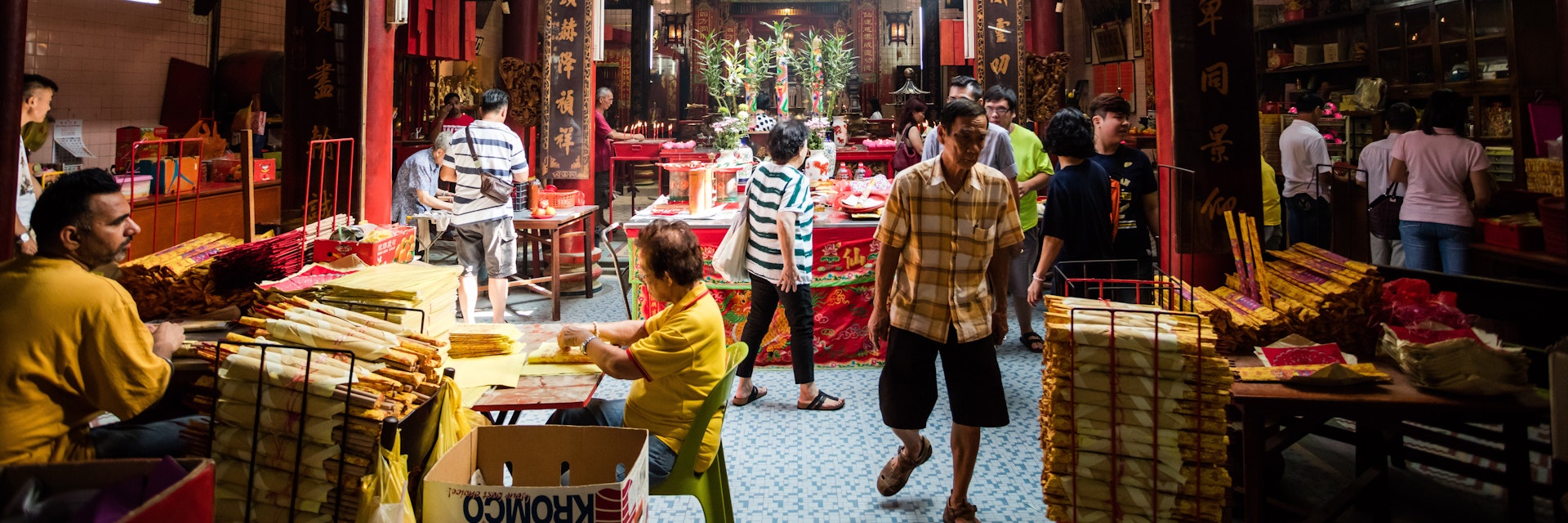
©J. Lekavicius/Shutterstock
Dynamic cities, fabulous food, beautiful beaches, idyllic islands and national parks with wildlife-packed rainforests – all of this can be found in Malaysia.
Best Time to Visit
Best places to visit, your next trip starts here.
Go from dreaming to planning with trip planning options made to help you craft your ideal itinerary.
Attractions
Must-see attractions.
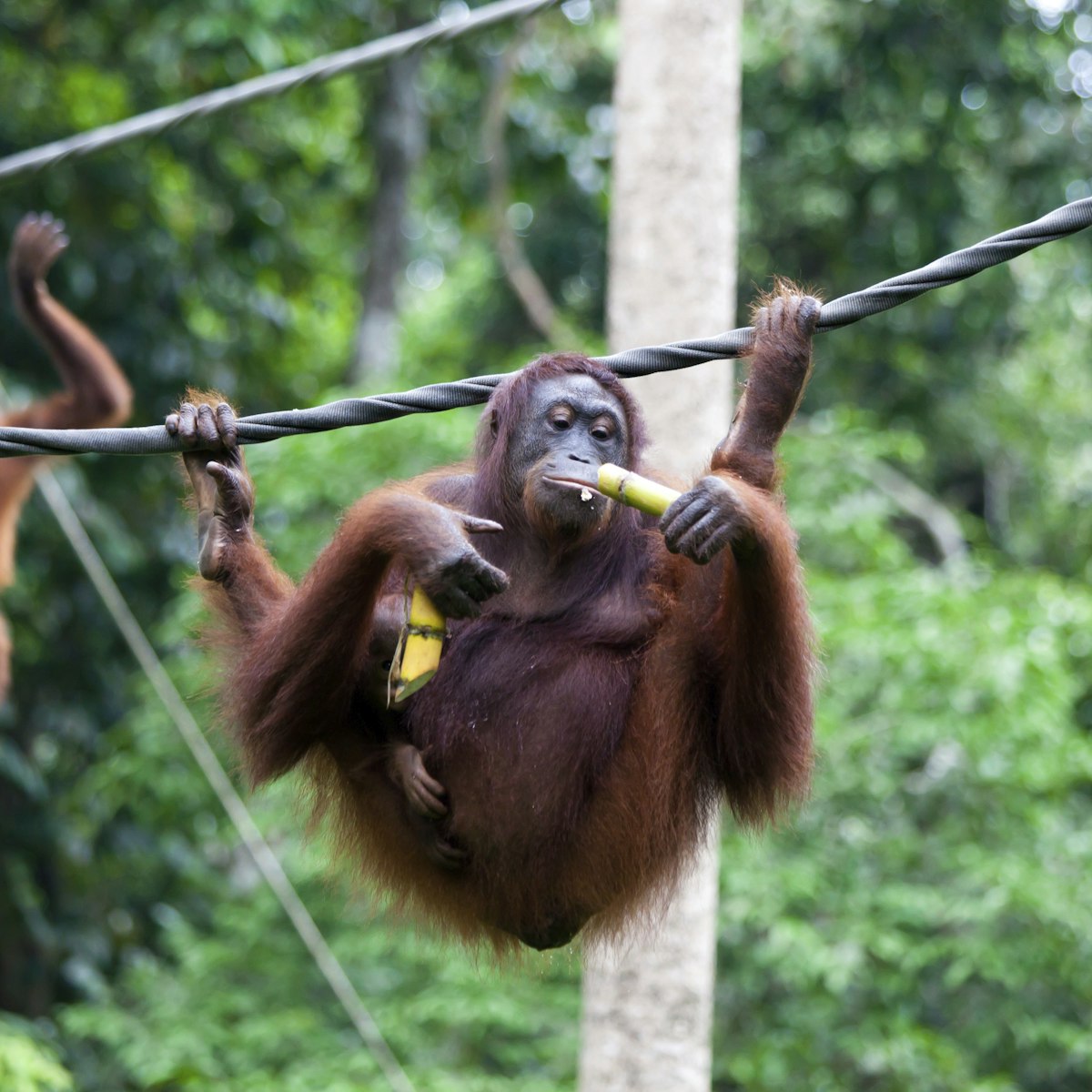
Sepilok Orangutan Rehabilitation Centre
Around 25km north of Sandakan, and covering 40 sq km of the Kabili-Sepilok Forest Reserve, this inspiring, world-famous centre welcomes orphaned and…
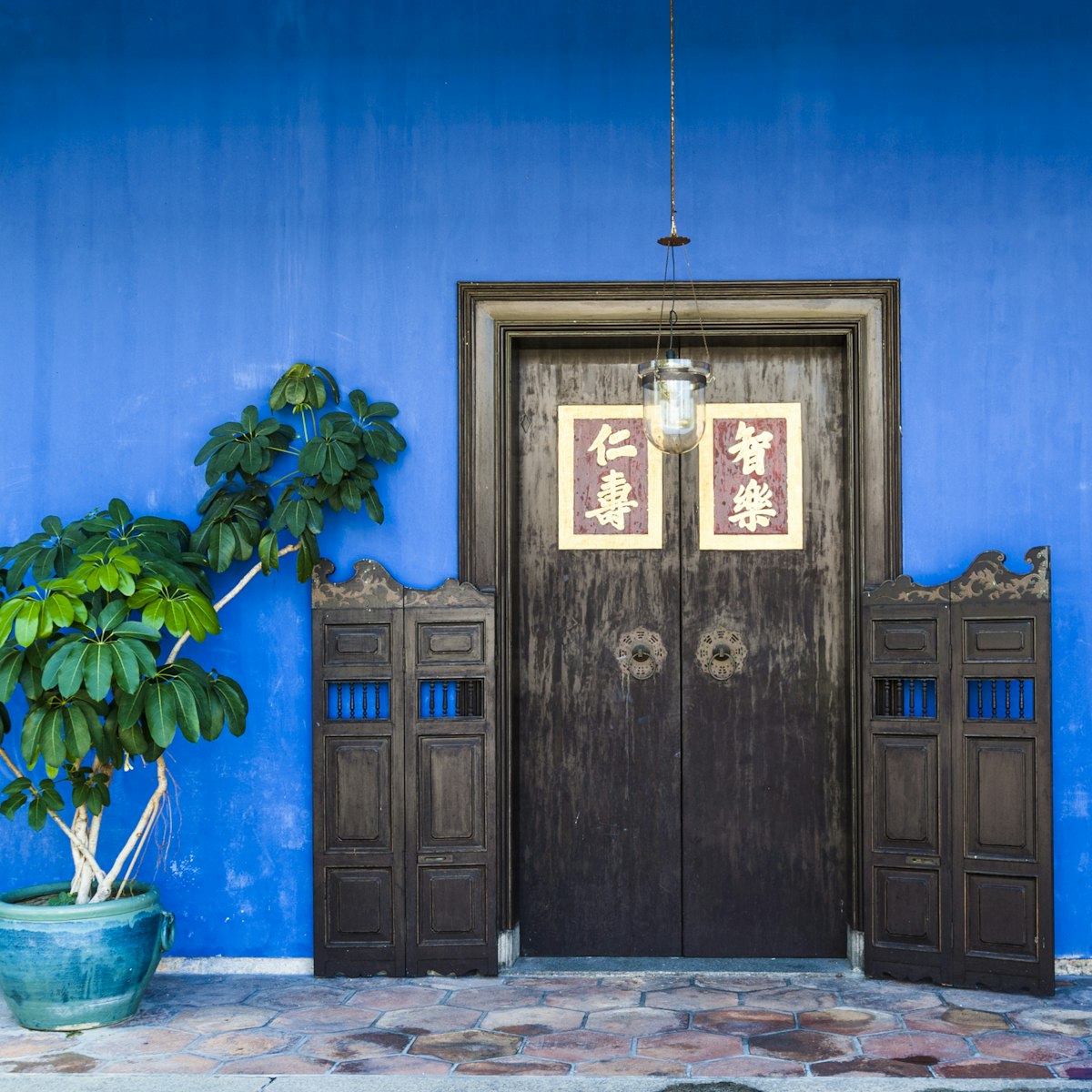
Blue Mansion
George Town
The most photographed building in George Town, this magnificent 38-room, 220-window mansion was built in the 1880s and rescued from ruin in the 1990s…
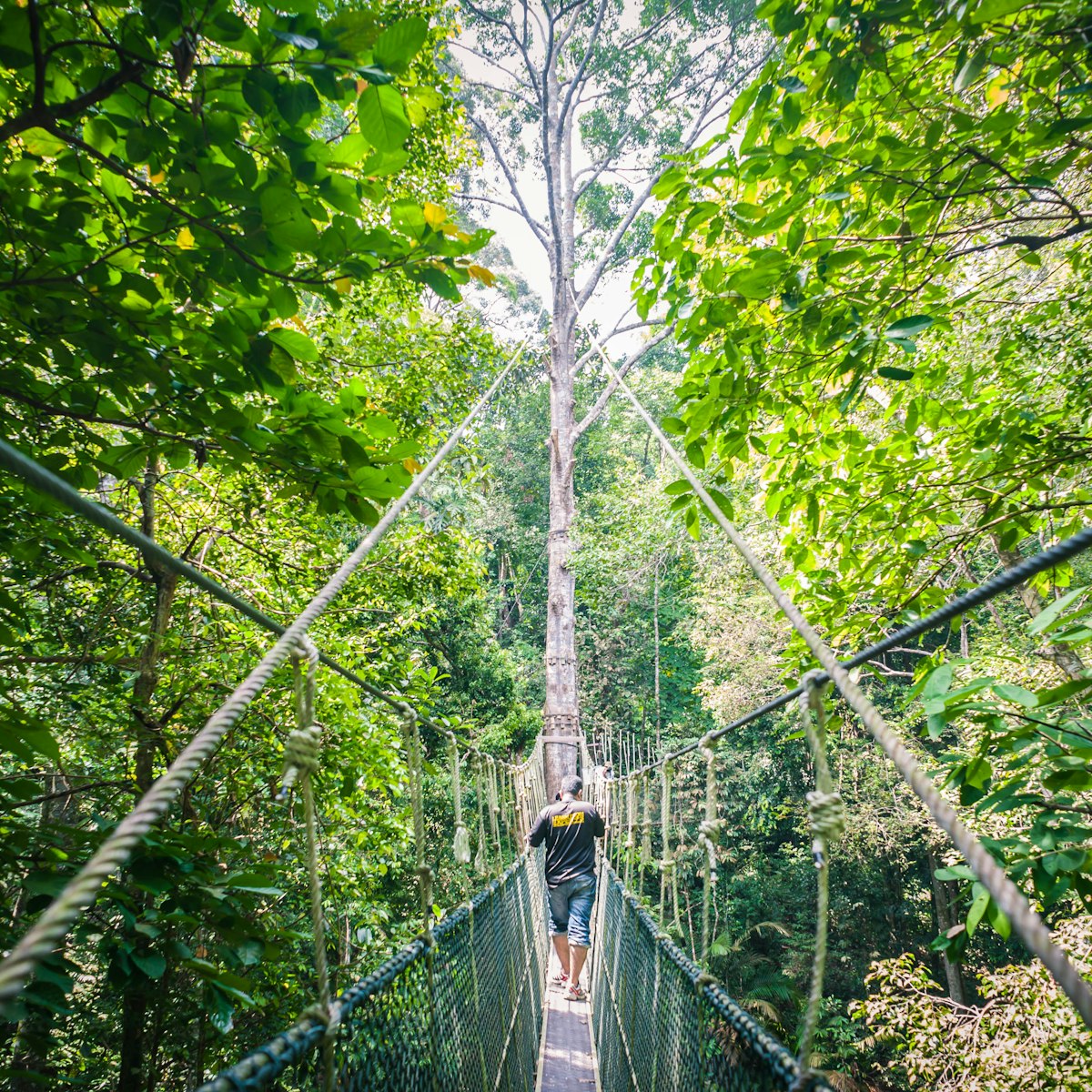
Penang National Park
At 23 sq km, this is Malaysia's smallest national park, but it's beach-fringed forests are home to silvered leaf monkeys, flying lemurs, leopard cats and…
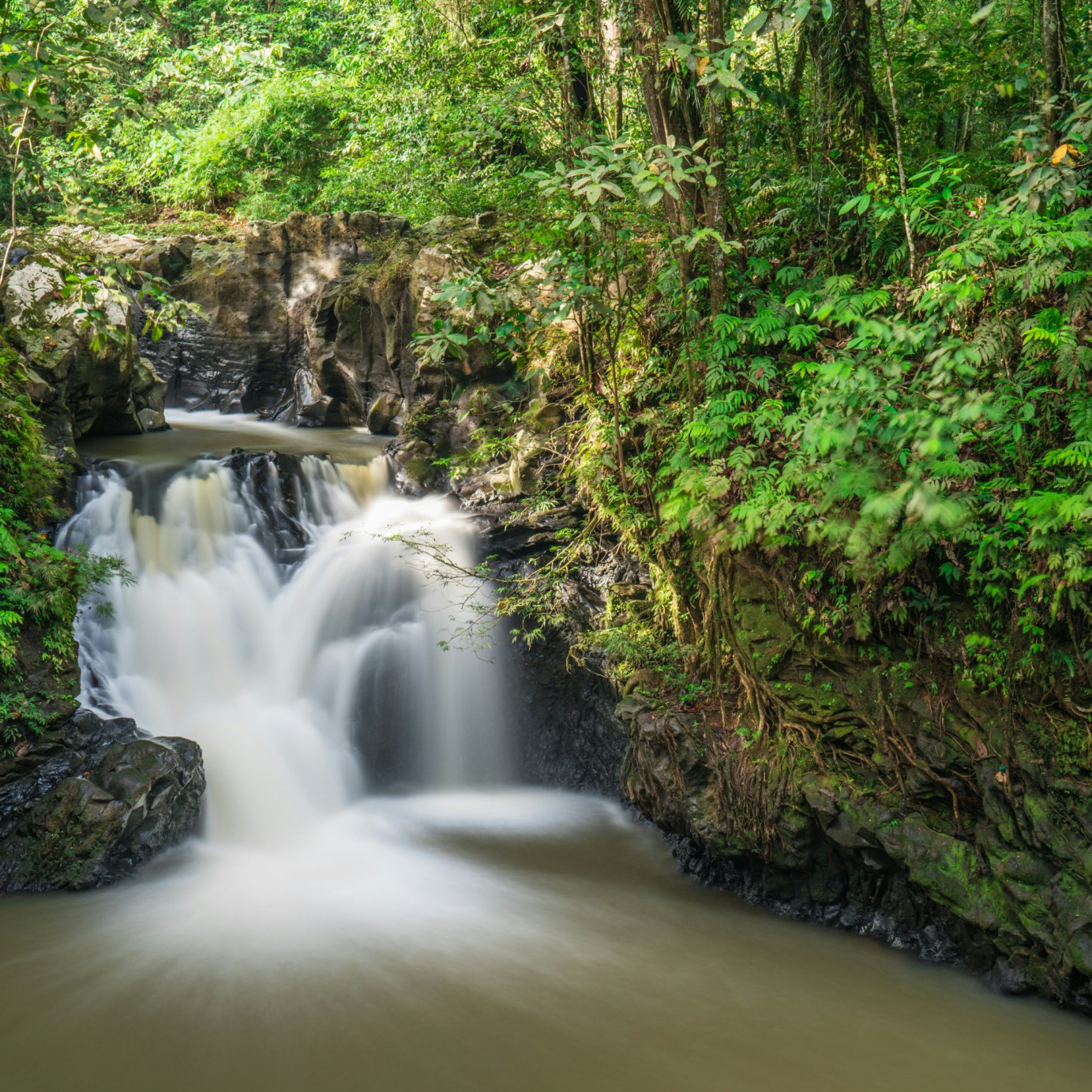
Tawau Hills Park
This small reserve has forested hills rising dramatically from the surrounding plain. If getting into the Maliau Basin or Danum Valley feels like too much…
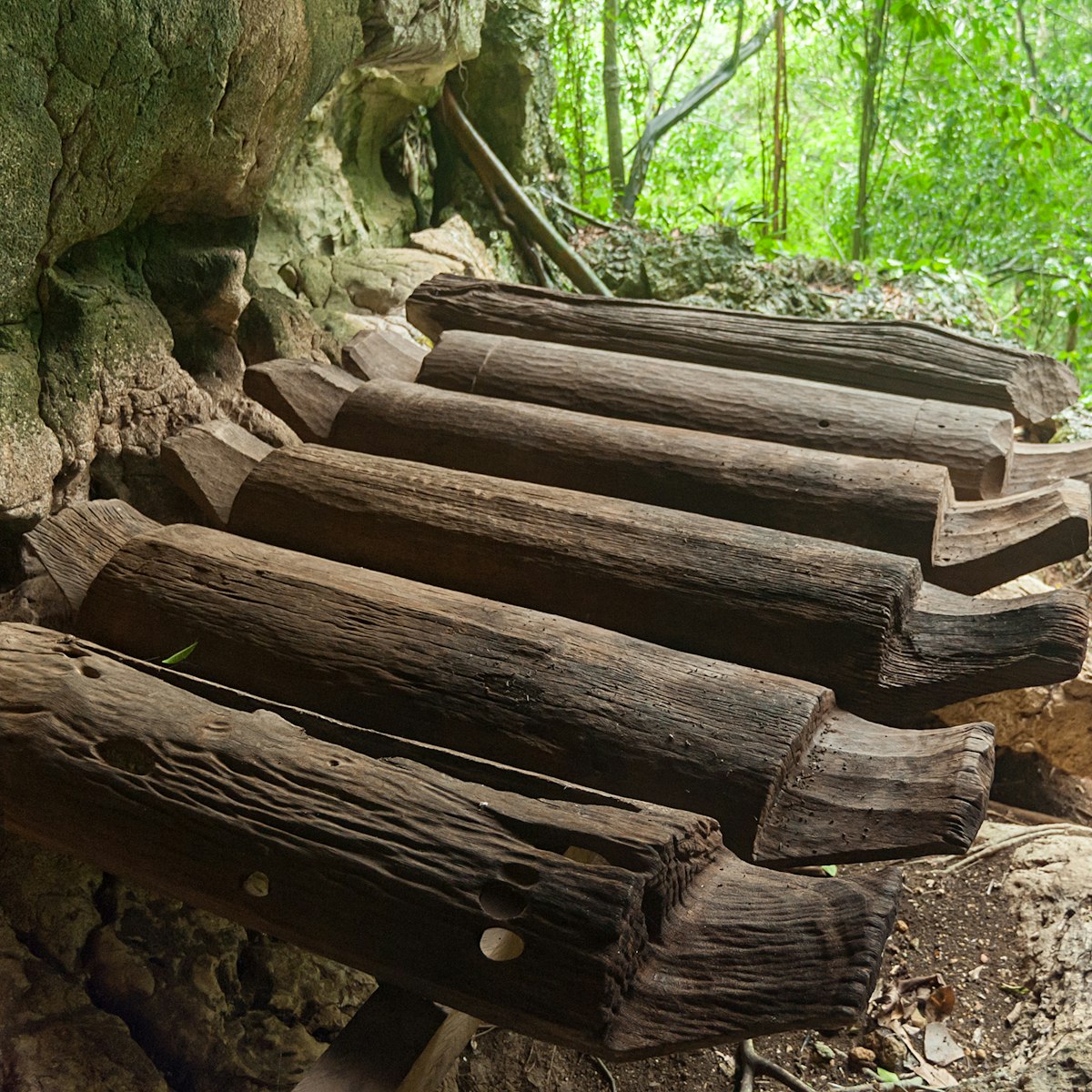
Agop Batu Tulug
This hill, 2km north of the Batuh Putih bridge, features three caves housing the ancestors of local Orang Sungai (People of the River). Because the…
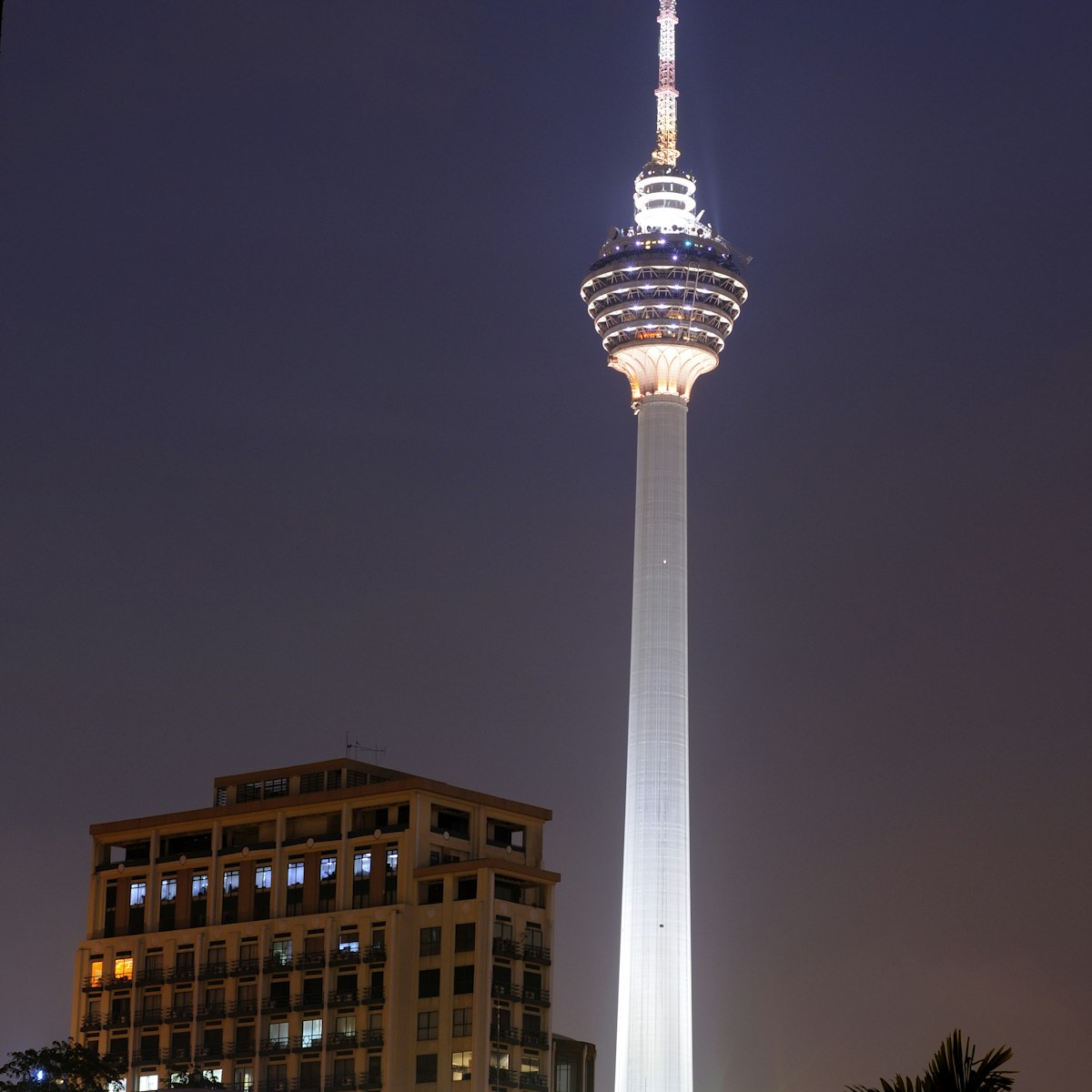
Chinatown, Merdeka Square & Bukit Nanas
Although the Petronas Towers are taller, the 421m Menara KL, rising from the crest of Bukit Nanas, offers the best city views. The bulb at the top…
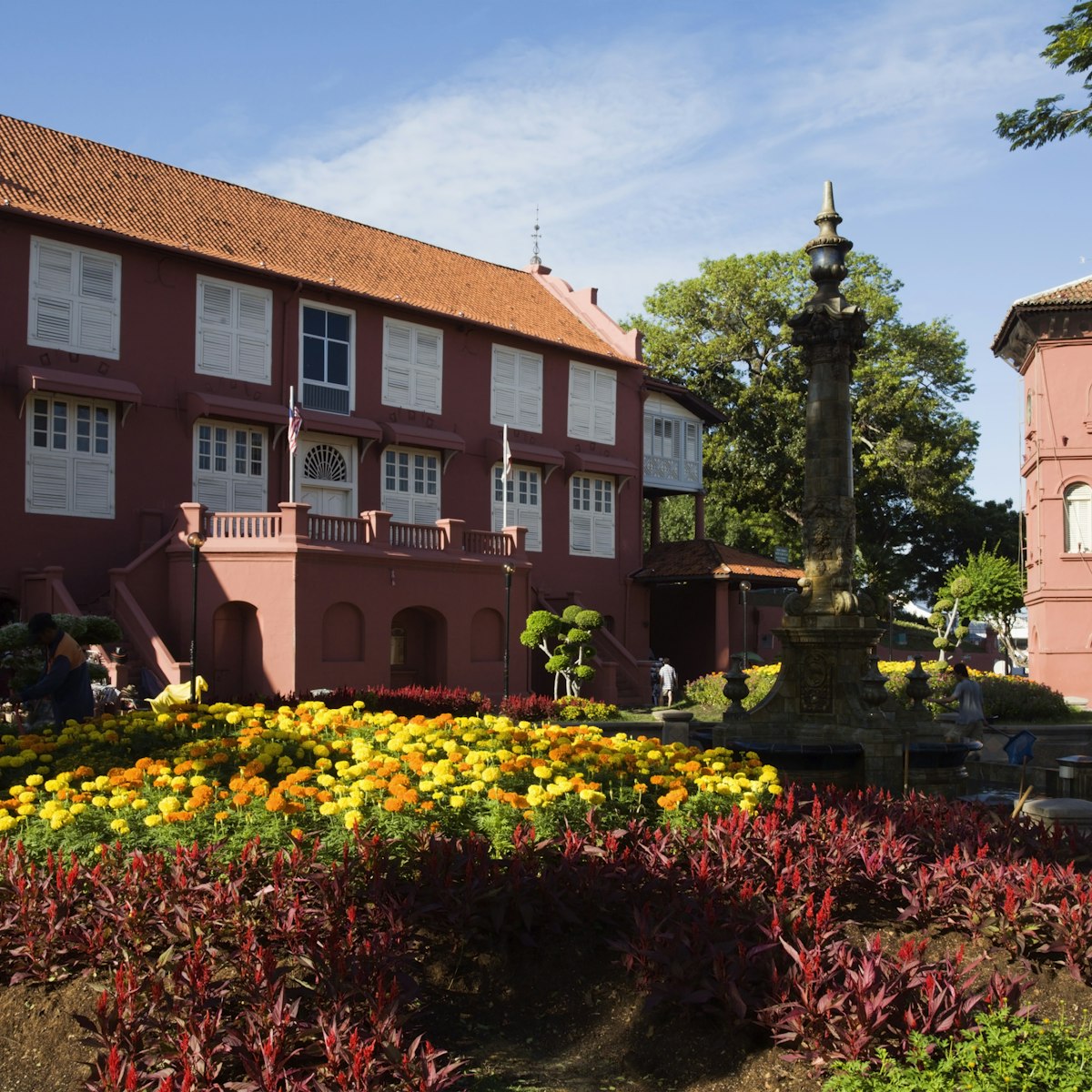
Melaka City
This former town hall and governor's residence dates to the 1650s and is believed to be the oldest Dutch building in the East. It functioned as State…
![travel guides malaysia [UNVERIFIED CONTENT] Masjid Jamek is the oldest mosque in Kuala Lumpur. It is located at the confluence of the Klang and Gombak river. It was built in 1907 and officially open by the then Sultan Selangor in 1909.](https://lp-cms-production.imgix.net/2019-06/477284513_master.jpg?auto=format&fit=crop&ar=1:1&q=75&w=1200)
Masjid Jamek Sultan Abdul Samad
This graceful, onion-domed mosque, designed by British architect AB Hubback, borrows Mogul and Moorish styles with its brick-and-plaster banded minarets…
Top picks from our travel experts
15 of the best things to do in malaysia.

Boh Sungei Palas Tea Estate
Cameron Highlands
If there's time for only one tea-themed experience in the highlands, make it this spectacularly situated plantation, with its own tea interpretation…

Boh Tea Garden
Velvety green views are glorious from this out-of-the-way tea plantation, though it's a long drive to get here (allow 40 minutes from Tanah Rata and use…

Panorama Langkawi
Pulau Langkawi
The highlight of this family-friendly amusement park is SkyCab, a cable car that whisks visitors to the top of Gunung Machinchang (713m). For an extra RM6…
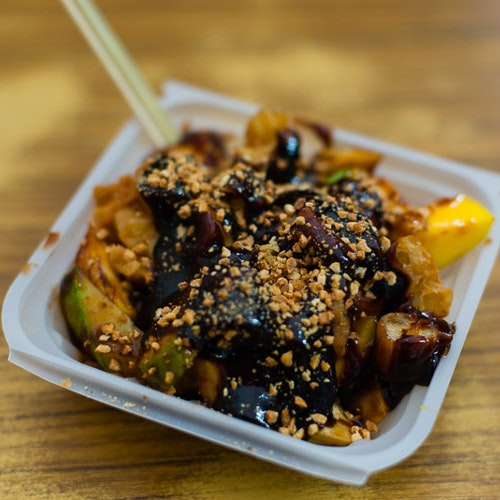
Lorong Baru Hawker Stalls
Ask locals where their favourite hawker stalls are and most will pick this night-time street extravaganza. It's a great spot for ikan bakar (grilled…

Ramayana Cave
No cave at Batu is more spectacularly embellished than Ramayana Cave, which boasts psychedelic dioramas of the Indian epic 'Ramayana'. Pass the green, 15m…

China House
You can't really say you've been out in George Town until you've stepped inside China House. This block-wide amalgamation of shophouses is packed with hip…

Bako National Park
Bako National Park is one of the best places in Sarawak to see rainforest animals in their native habitats. It's notable for its incredible biodiversity,…

Anjung Gurney Night Market
Penang's most famous hawker complex sits just past the Gurney Plaza mall, cooled by breezes wafting in off the sea. It buzzes with stalls serving Muslim…
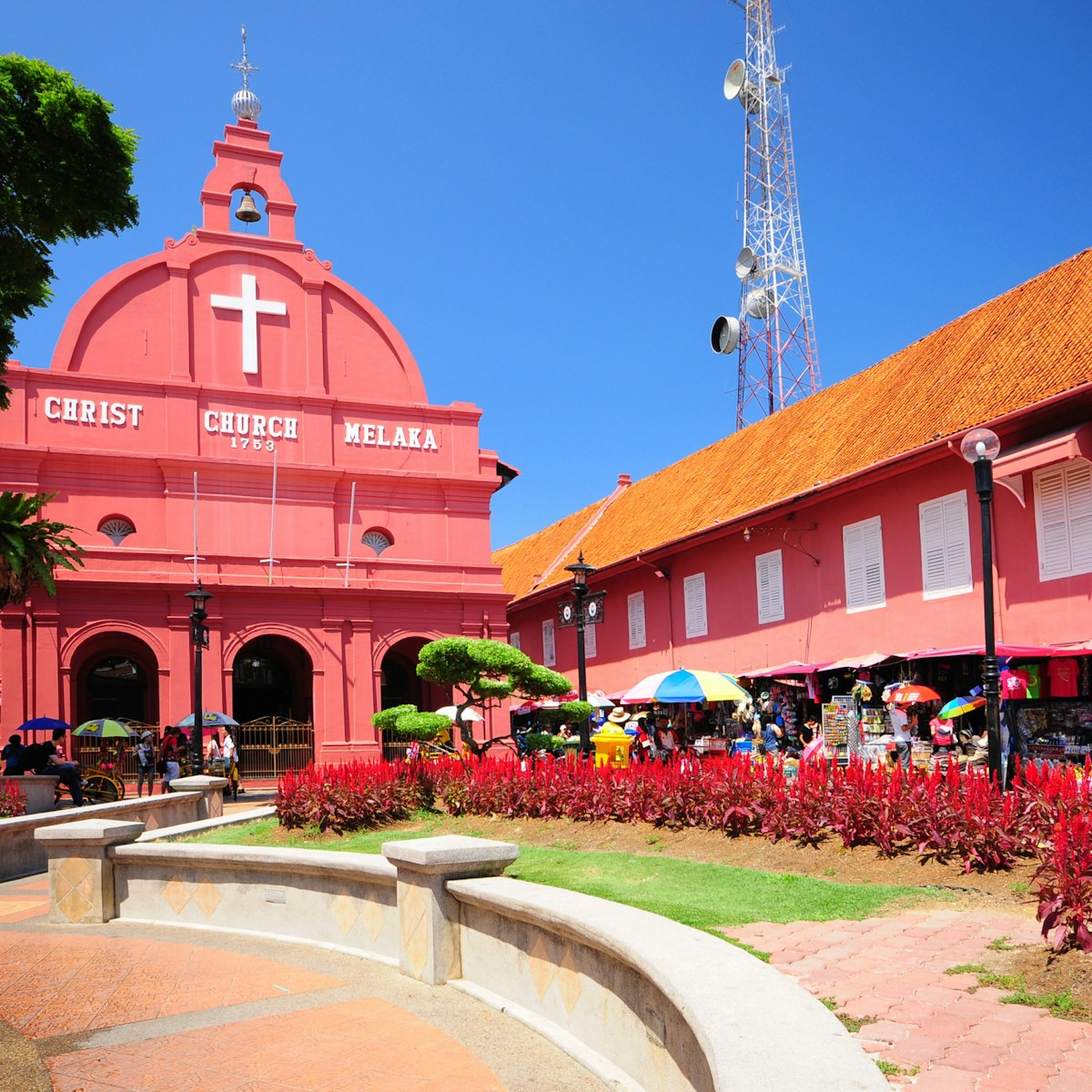
Christ Church
Built in 1753 from laterite bricks brought from Zeeland in Holland, this eye-catching cherry-pink church is one of the most photographed and imposing…

Deer Cave & Lang Cave
Gunung Mulu National Park
A 3km walk through the rainforest takes you to these adjacent caverns. Deer Cave – over 2km long and 174m high – is the world’s largest cave passage open…
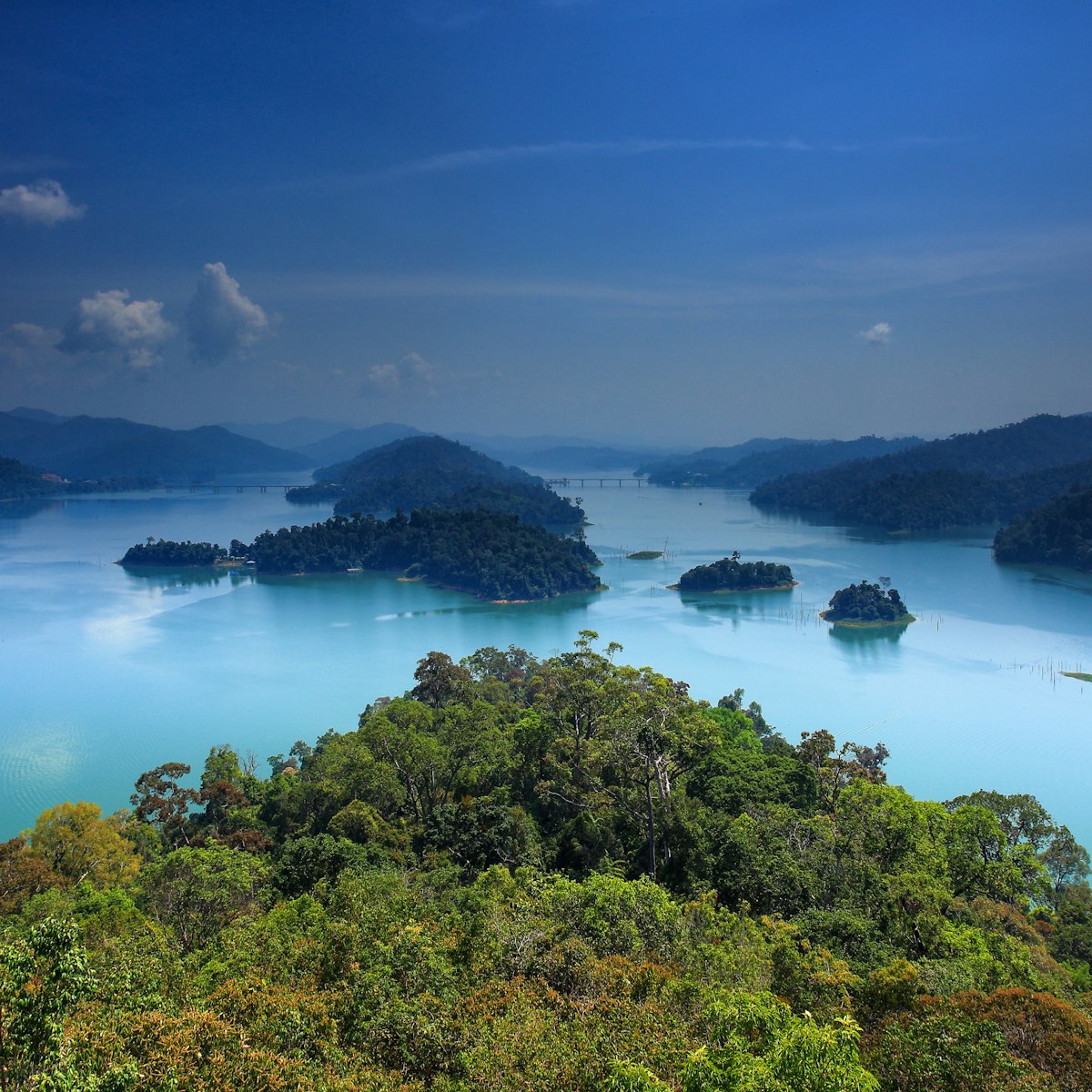
Royal Belum State Park
This 1175-sq-km park within Belum-Temenggor Rainforest was gazetted in 2007 to protect a rich menagerie of tigers, tapirs, panthers and the Sumatran rhino…

Sultanate Palace
This wooden replica of the palace of Sultan Mansur Shah, who ruled Melaka from 1456 to 1477, houses an open-air cultural museum and lovely gardens. The…
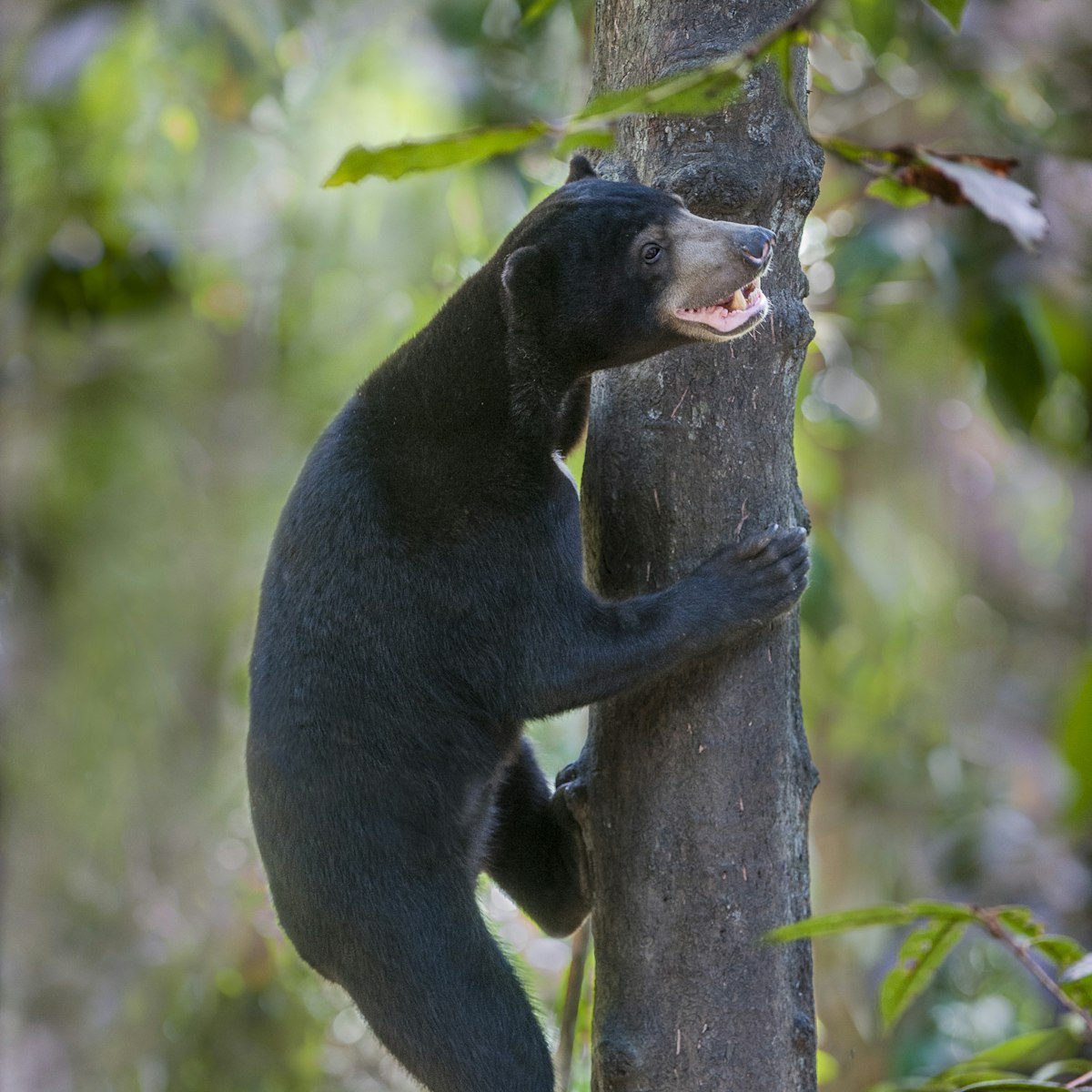
Borneo Sun Bear Conservation Centre
The wonderful BSBCC provides care to rescued sun bears (44 at the time of writing), the world's second-most endangered bear. It's possible to see the…

Kafe Heng Huat
Outside Kafe Heng Huat you'll find Soon Chuan Choo who, in her trademark red chef's hat, has been turning out some of Penang's best char kway teow (rice…

Cameron Valley Tea House 1
Views over the plantation are breathtaking from this easy roadside pullover on the road between Ringlet and Tanah Rata. There are no guided tours, but you…
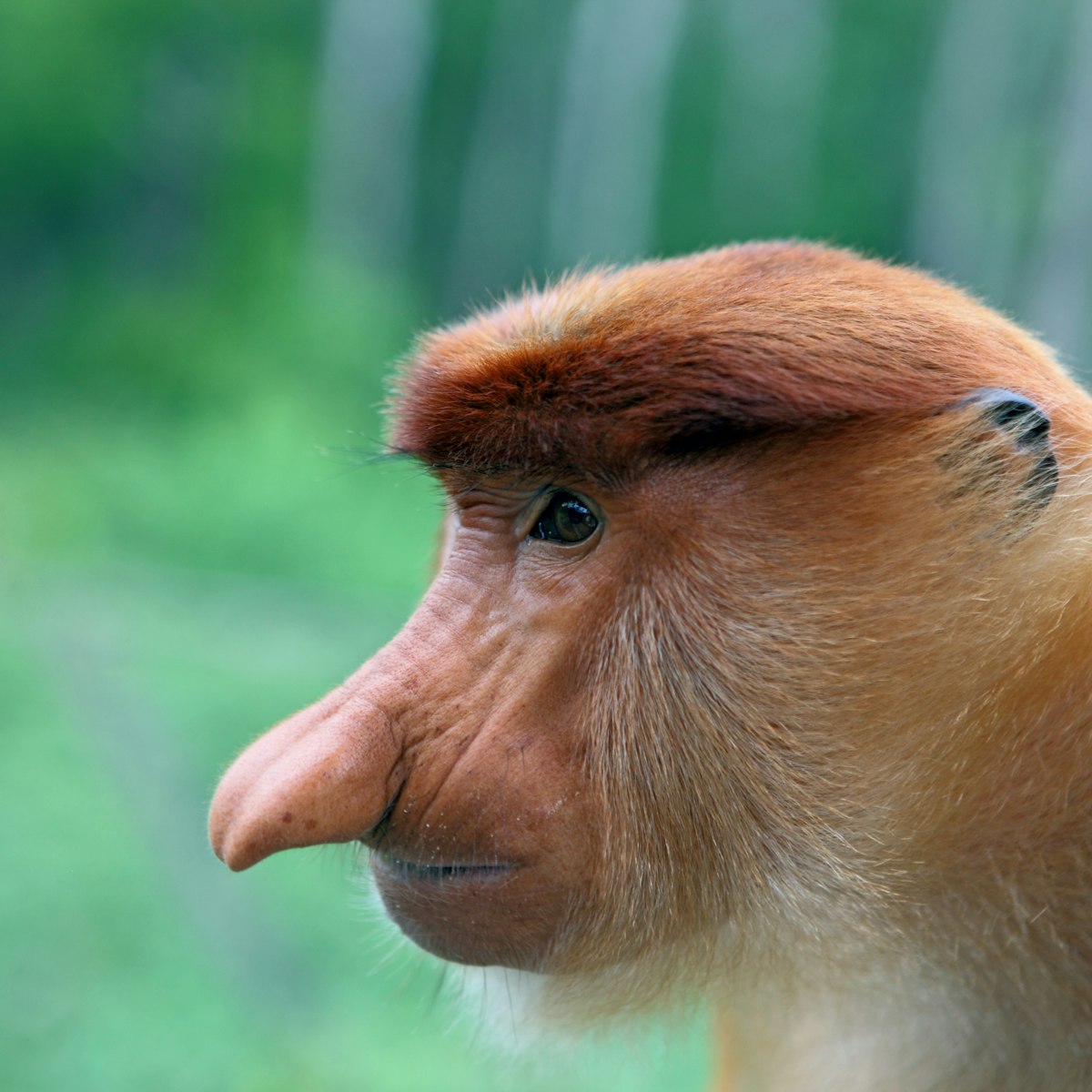
Labuk Bay Proboscis Monkey Sanctuary
A local palm-plantation owner has created a private proboscis monkey sanctuary, attracting the floppy-conked locals with sugar-free pancakes at 9.30am and…

Dutch Square
The focal point of the Unesco Heritage zone, this attractive and elegant square is surrounded by Dutch-era buildings that have been painted crimson, shady…

Masjid Ubudiah
With bands of Italian marble and enormous gold domes, Masjid Ubudiah is a contender for the title of Malaysia's prettiest mosque. Commissioned by Perak’s…

Temple Cave
Centrepiece of the Batu Caves complex and one of Malaysia's most photographed sights, Temple Cave sits atop 272 colourful steps populated by scampering…

Hameediyah dates back to 1907 and is supposedly the oldest place serving nasi kandar (curries served over rice) in Penang, though the current restaurant…
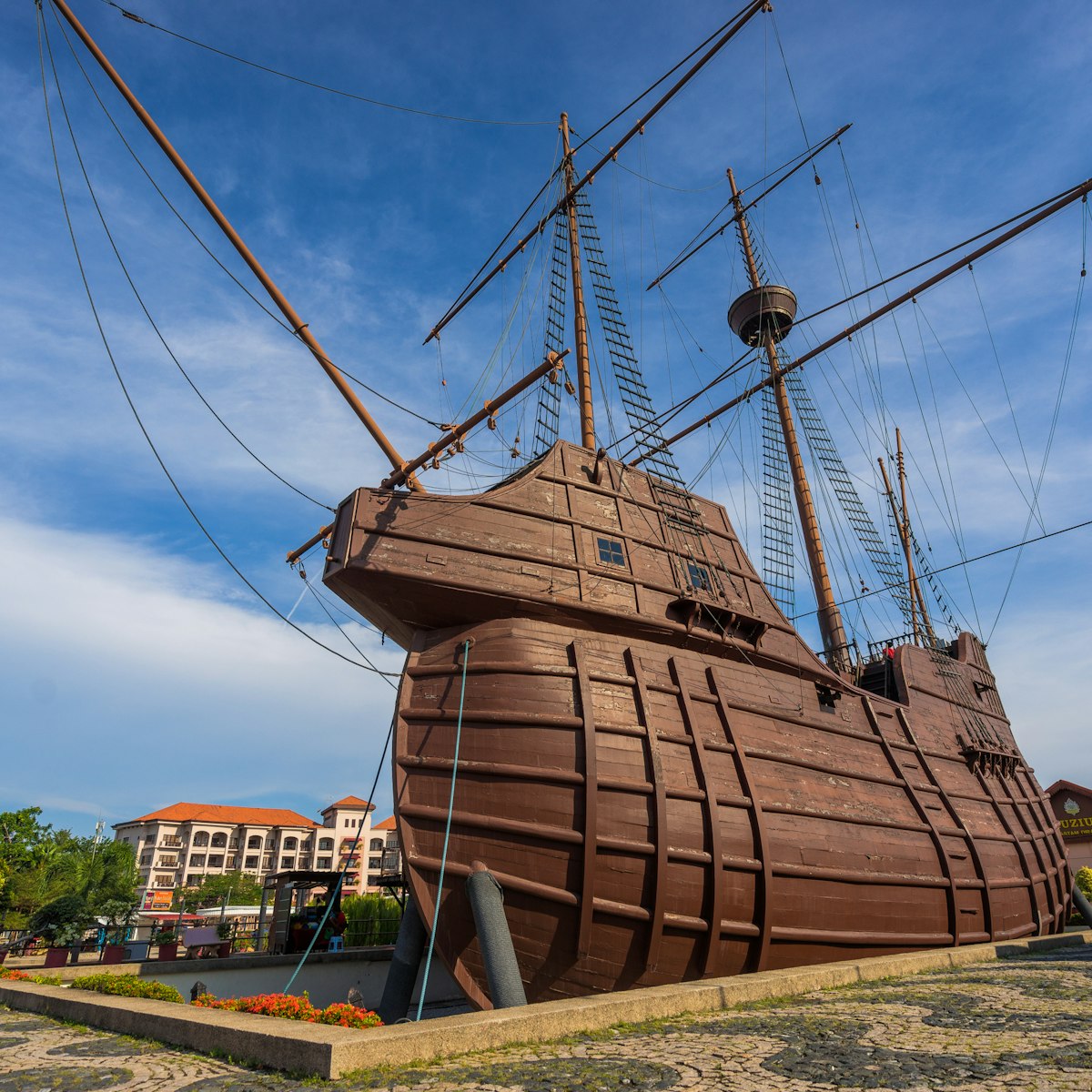
Maritime Museum & Naval Museum
Embark on a voyage through Melaka's maritime history at these linked museums, all covered by the one ticket. The most enjoyable of the Maritime Museum's…
Planning Tools
Expert guidance to help you plan your trip.
Best Things to Do
Experience the very best of Malaysia's astonishing landscapes, cultures and cuisines with these top things to do.
Things to Know
From what to pack to social etiquette, here is everything you need to know before visiting Malaysia.
Transportation
Malaysia is divided between the Malay peninsula and tropical Sabah and Sarawak on Borneo, but getting around is easy with these simple tips.
Visa Requirements
A great place for impulsive travelers, many nationals can enter Malaysia visa-free for up to 90 days.
Money and Costs
Malaysia should really be better known as a budget travel destination. It's easy to travel around, stay and eat cheaply with these top budget tips.
Best Road Trips
You can explore Malaysia without stepping inside a car but exploring with your own wheels opens up a tropical world. Here are Malaysia's best road trips.
Latest stories from Malaysia
Filter by interest:
- All Interests
- Adventure Travel
- Art & Culture
- Beaches, Coasts & Islands
- Food & Drink
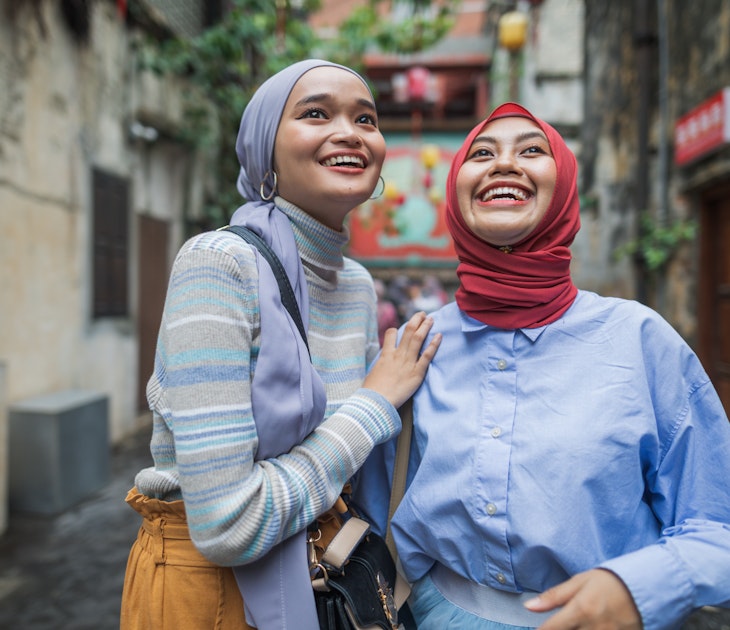
Destination Practicalities
Feb 3, 2024 • 7 min read
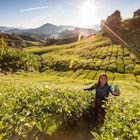
Jan 29, 2024 • 8 min read
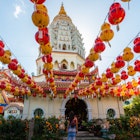
Jan 22, 2024 • 11 min read
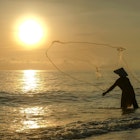
Sep 1, 2023 • 8 min read
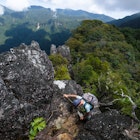
Mar 29, 2022 • 8 min read
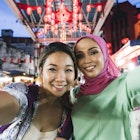
Mar 8, 2022 • 2 min read
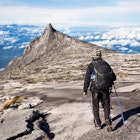
Feb 25, 2022 • 12 min read
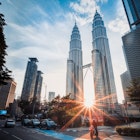
Feb 21, 2022 • 11 min read

Feb 19, 2022 • 5 min read
in partnership with getyourguide
Book popular activities in Malaysia
Purchase our award-winning guidebooks.
Get to the heart of Malaysia with one of our in-depth, award-winning guidebooks, covering maps, itineraries, and expert guidance.
Malaysia and beyond
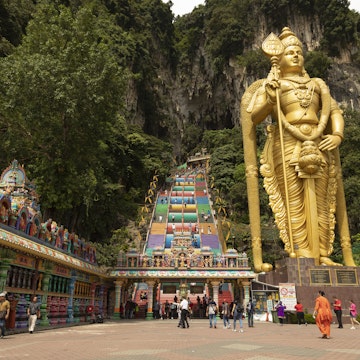
Malaysia Travel Guide: Tips for the Ultimate Itinerary
Malaysia, a country of incredible landscapes, colonial towns, delicious food, tropical islands, and friendly people. Because of its rich cultural history, Malaysia is now famous for its cuisine, a mix of Chinese, Indian, and Indonesian traditions. As a holiday destination, Malaysia is still under the radar compared to its neighbors Singapore and Thailand. Its infrastructure is well-developed, which makes for an effortless travel experience. Here’s the complete 2-Week Malaysia Travel Guide.
A 2-week Malaysia itinerary
Two weeks is an ideal length for getting to know West Malaysia. Here’s a day-to-day Malaysia Route Guide.
Note: this travel guide only covers West Malaysia and not Borneo.
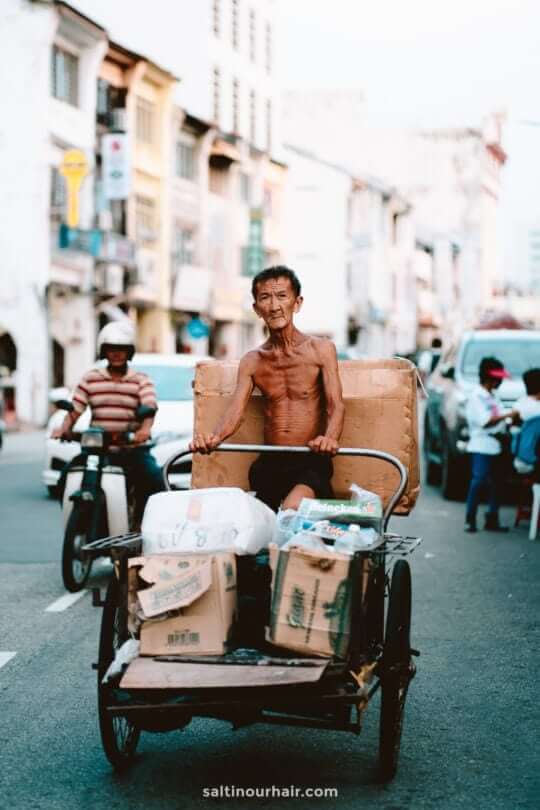
Here’s our two-week route map of Malaysia. Discover the route’s highlights and what locations you will be visiting in the country if you follow this travel guide.
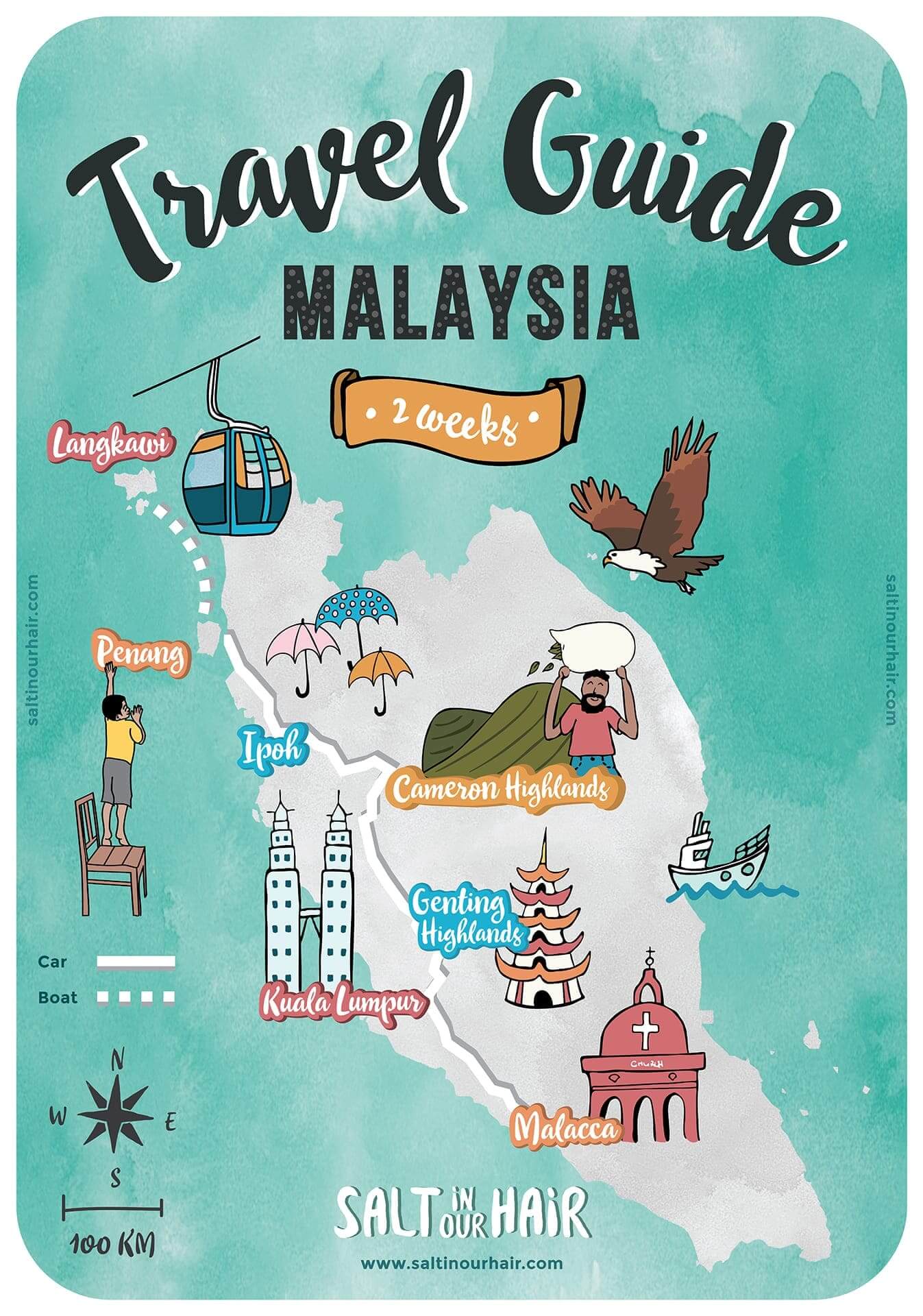
Day 1 – 2: Kuala Lumpur
Touchdown in the majestic, buzzing capital of Malaysia. Kuala Lumpur is a cultural mix of people of Chinese, Indian , and Malay descent. As a result, English is a commonly spoken language throughout the entire country.
Read: 15 Things To Do in Kuala Lumpur
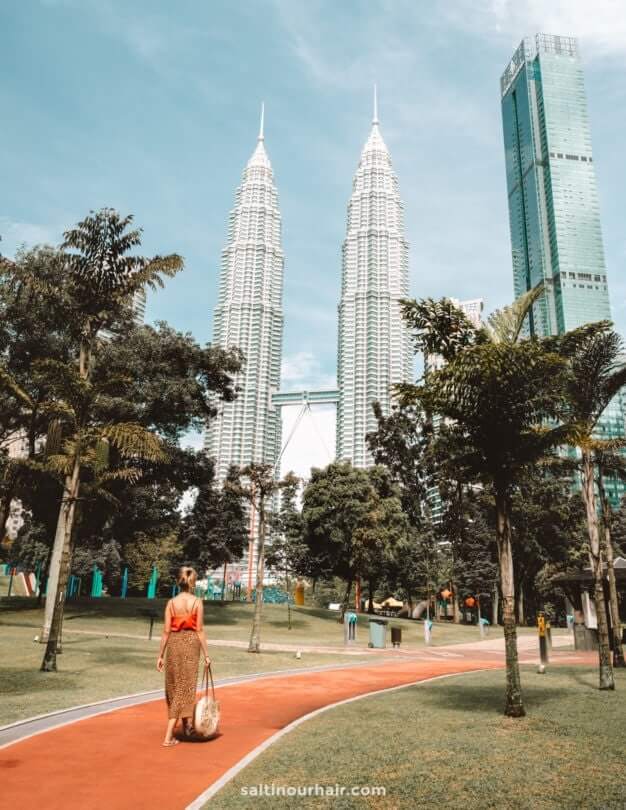
Visit the Batu Caves and the stunning Chinese Thean Hou Temple during the first two days of your Malaysia travel itinerary.
See availability and tickets for a tour of Batu Caves
Where to Stay in Kuala Lumpur
Bukit Bintang and Brickfields are the two main areas to find a hotel in Kuala Lumpur. They are close to the city center, connected to the metro, and some sights are doable on foot.
Hotels in Kuala Lumpur 😴
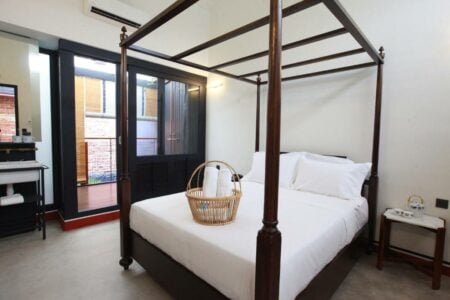
Ritz Carlton is right in the middle of the city, next to the shopping mall. It offers multiple pools, a spa, a gym, comfortable beds, and a delicious buffet.
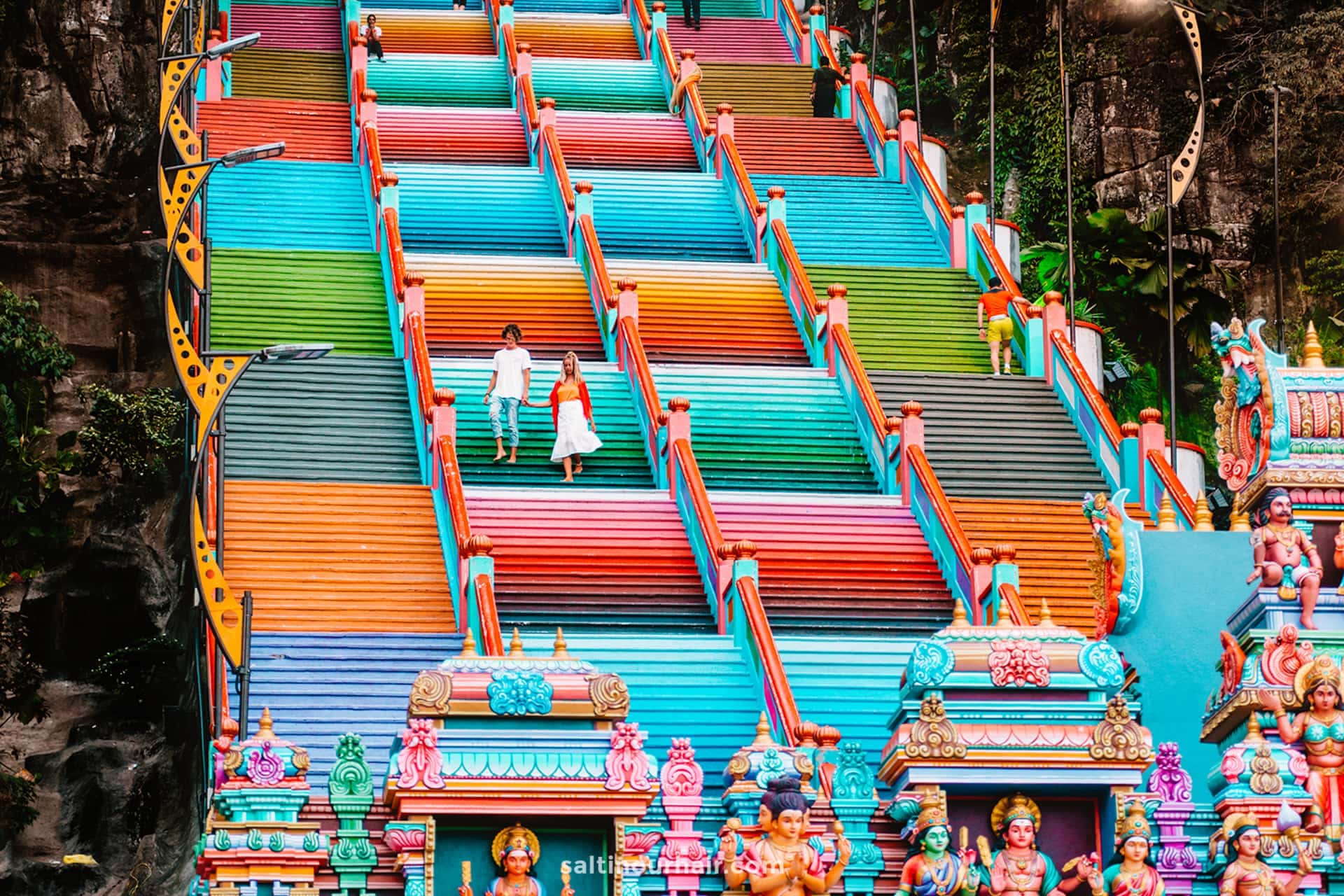
Day 3 – 4: Malacca
The charming riverside city of Malacca is a mix of colorful buildings, street art, and architecture of historical significance. The very walkable city center of Malacca is an official UNESCO Heritage site, and although a bit off the usual Malaysia travel route, it is well worth the detour.
Read: Two days in Malacca, things to do
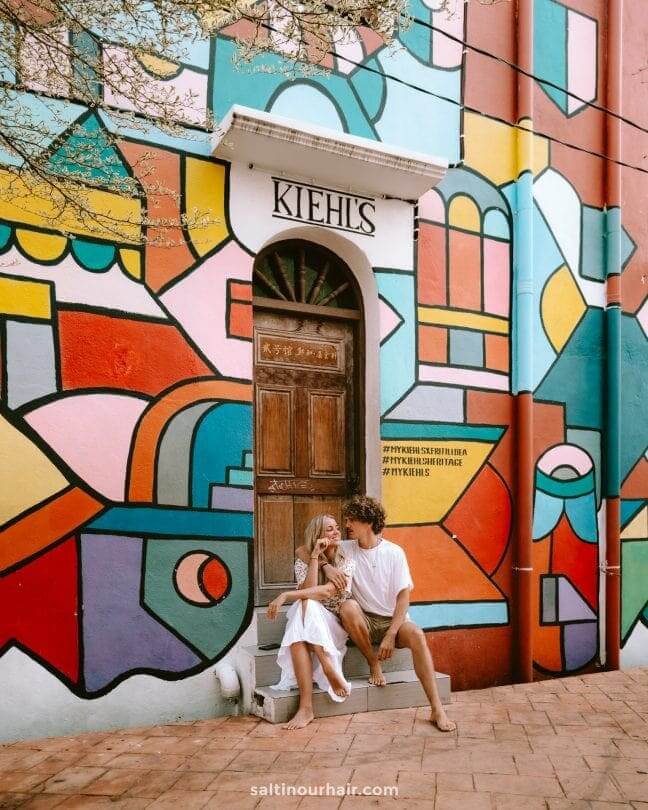
Kuala Lumpur to Malacca Leave from Kuala Lumpur to Malacca on the morning of day 3. You will arrive before lunch which gives you 1.5 days to explore this small city.
Purchase your bus tickets here
Where to Stay in Malacca
It’s best to situate yourself centrally so as to be within walking distance from all the attractions. There is a nice atmosphere by the river, and plenty of hostels and guesthouses are situated here.
Hotels in Malacca 😴
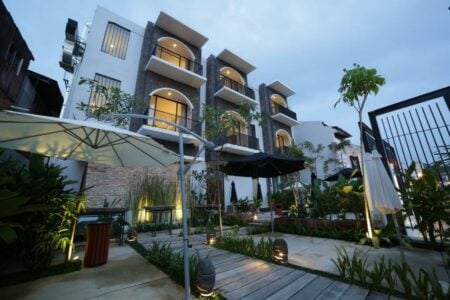
Guesthouses in Melaka are very reasonably priced and of good quality. However, there are more upmarket hotel options that sit a little further out of the center.
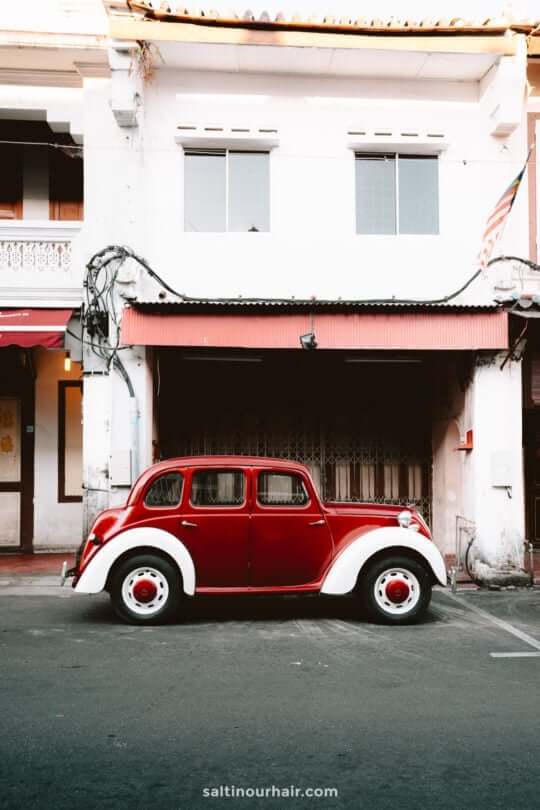
Day 5 – 6: Cameron Highlands
Make your way up into the highlands of Malaysia. The cooler, wetter climate, and fertile ground make this an area ideal for tea plantations. The Cameron Highlands is, therefore, famous for its never-ending tea plantations and stunning hiking trails.
Here’s how to spend your days in the Cameron Highlands
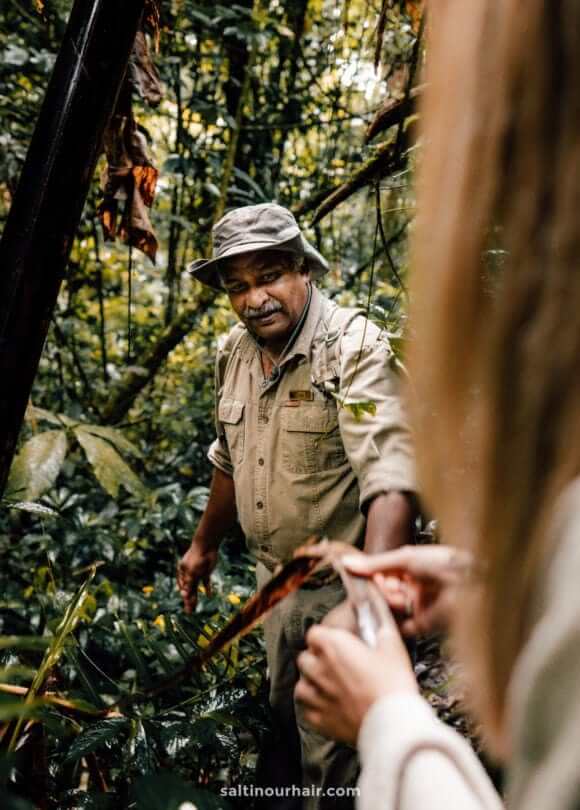
Malacca to Cameron Highlands From Malacca to Cameron Highlands is a long, but straightforward, 5-hour drive. To break up the long journey, stop at the Genting Highlands to see the Chin Swee Caves Temple. However, we would only recommend this if you travel by car. Rent a car here .
Or purchase your bus tickets
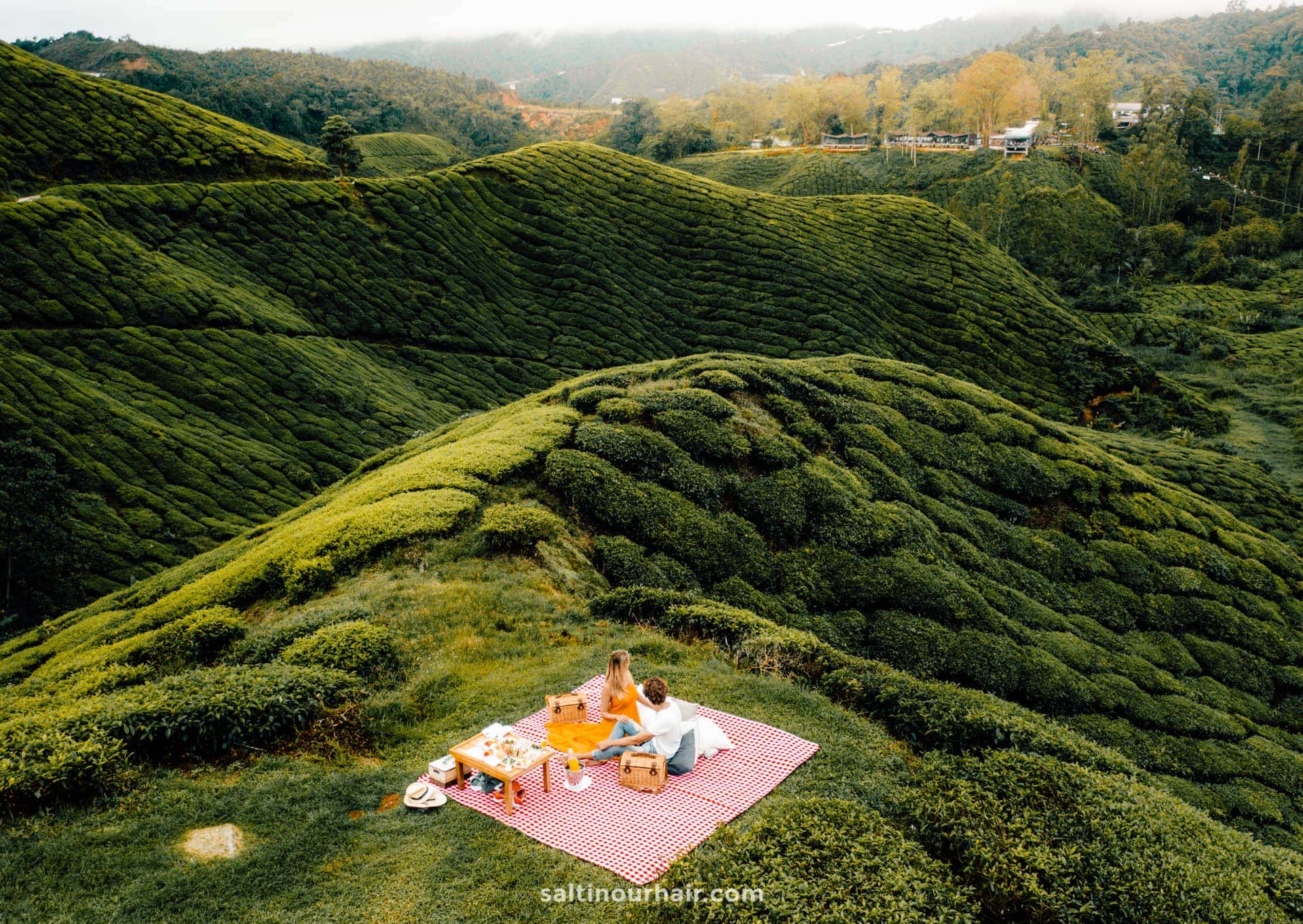
The Genting Highlands
The Genting Highlands is popular on the weekends with Malaysians for the gigantic malls, casinos, and hotels. Avoid these parts and, instead, take the cable car up the mountain to the Chin Swee Temple. This colorful tiered pagoda stands tall at the summit, providing beautiful views of the thick, green forest beneath the Titiwangsa Mountains.
We recommend to rent a car in Malaysia through Sunny Cars with free cancellation and insurance included. Book your rental car here .
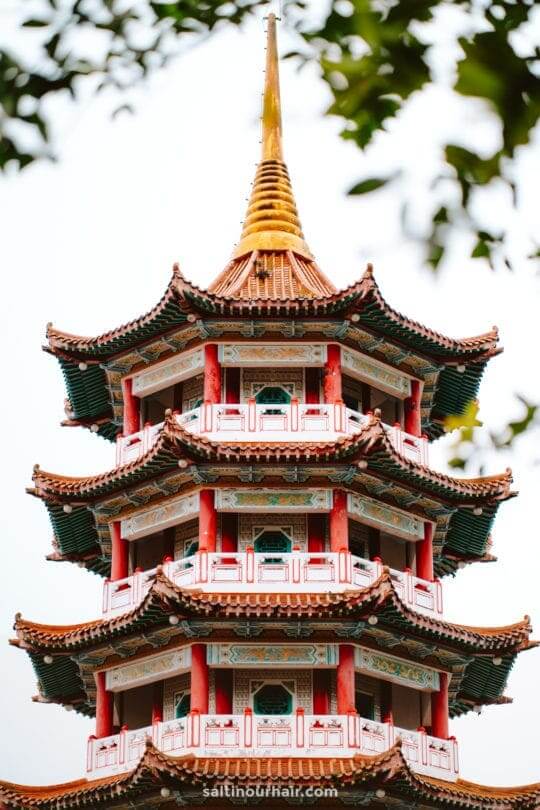
How to get to Chin Swee Cave Temple
The gondola leaves from the Awana car park , every day from 7 AM until midnight. Thrillseekers can choose to travel in the glass-bottomed gondola for the price of RM 50 per person. The normal gondola costs a much cheaper RM8 per person.
Where to Stay in the Cameron Highlands
The 3 main towns that make up the Cameron Highlands are Tanah Rata, Brinchang, and Ringlet. A variety of low-range- mid-range accommodation is available in each of the three.
Choose your location based on the sights you would most like to see. For example, Ringlet is closest to the BOH tea plantation, whereas most of the waterfalls are situated closer to Tanah Rata.
Hotels in Cameron Highlands 😴
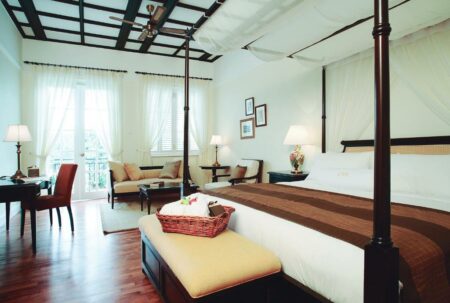
The true Cameron Highlands experience can be found at the Cameron Highlands Resort , a colonial-style mansion with beautiful interiors in keeping with the history of the area.
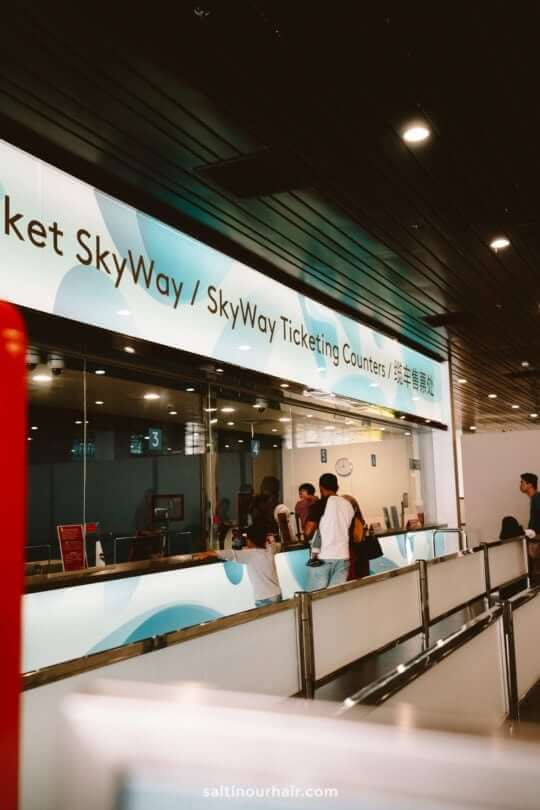
Day 7: Ipoh – An undiscovered Malaysia travel spot
Go off the beaten path and visit Georgetown’s little brother, Ipoh. Wander down the colonial streets of Ipoh old town, where art and street food dominate the scene. Follow this with a visit to one of the temples carved into the limestone.
Read more: Ipoh – Things to do
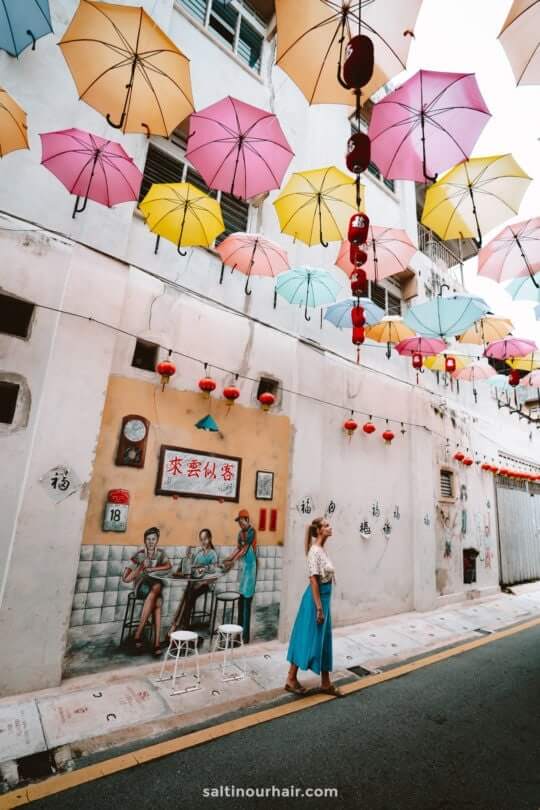
Cameron Highlands to Ipoh From Cameron Highlands to Ipoh takes 2 hours. Take the bus or car to Ipoh in the afternoon of day 6 so you have the 7th day to explore the highlights of Ipoh.
Get your bus tickets in advance
Where to Stay in Ipoh
There is a diverse range of budget hostels to luxury resorts within Ipoh, set within the town’s bustling center or set amongst the serene nature.
Hotels in Ipoh 😴
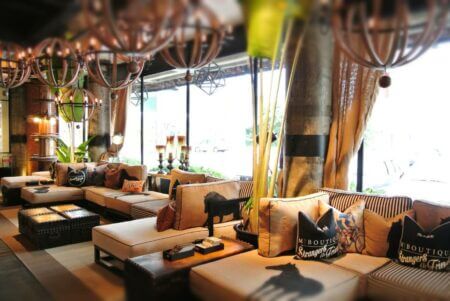
As a recommended stay in Ipoh is around 2 days, it’s best to situate yourself in one of the many good quality guest houses within the old town as a base to explore.
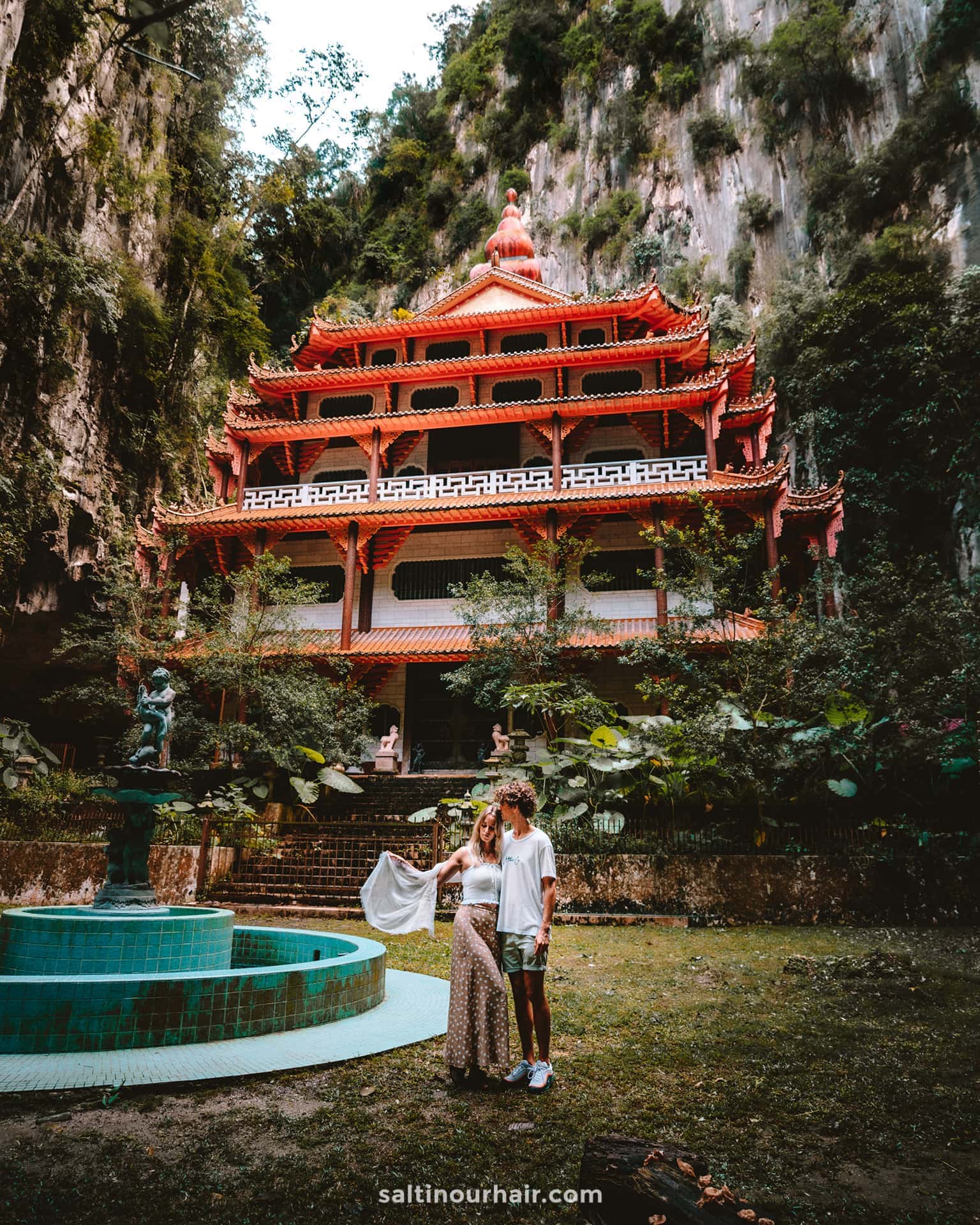
Day 8 – 10: Georgetown, Penang
Georgetown is a beautiful city located on Penang , an island just off the coast of Malaysia. World-famous for its street art trail, it has rightly become one of the must-visit places in Malaysia.
Take to the streets for incredible murals, beautiful temples, and a mouth-watering street food scene! And when you’re done with the city, visit some of the small white-sand beaches or the national park.
Everything about Georgetown, Penang
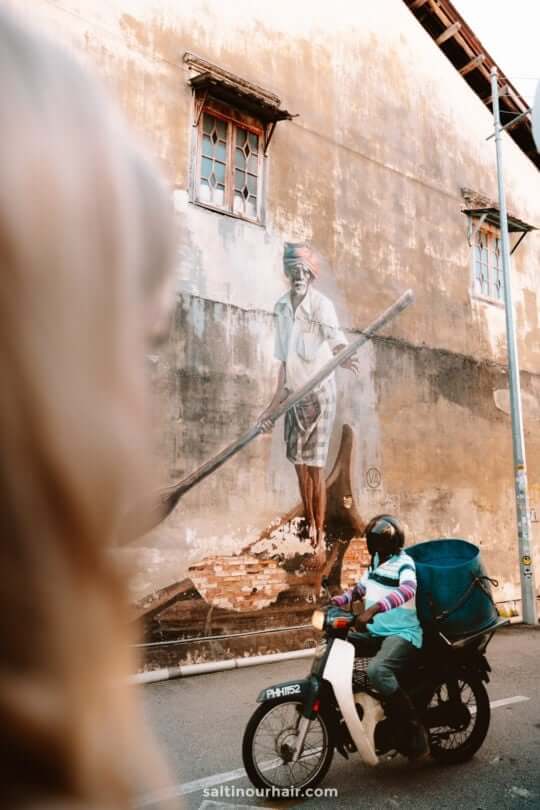
Ipoh to Georgetown To get from Ipoh to Georgetown, you can take a direct bus to the center of town. The island is connected to the mainland by a bridge, so there is no need to catch a boat.
Get your bus tickets
Alternatively, go for a more fun experience by taking a 2-hour train to Butterworth and catching the ferry to Penang from there.
Where to Stay in Georgetown
A hotel or guesthouse in Georgetown is best to find within the old town if you’d like to be close to all the top things to do.
Hotels in Georgetown 😴
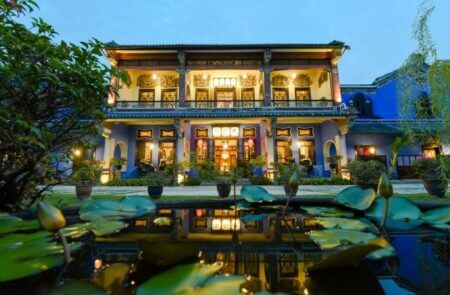
Cheong Fatt Tze Mansion is a beautiful hotel to stay in and conveniently located within walking distance of the street art trail and other iconic sites.
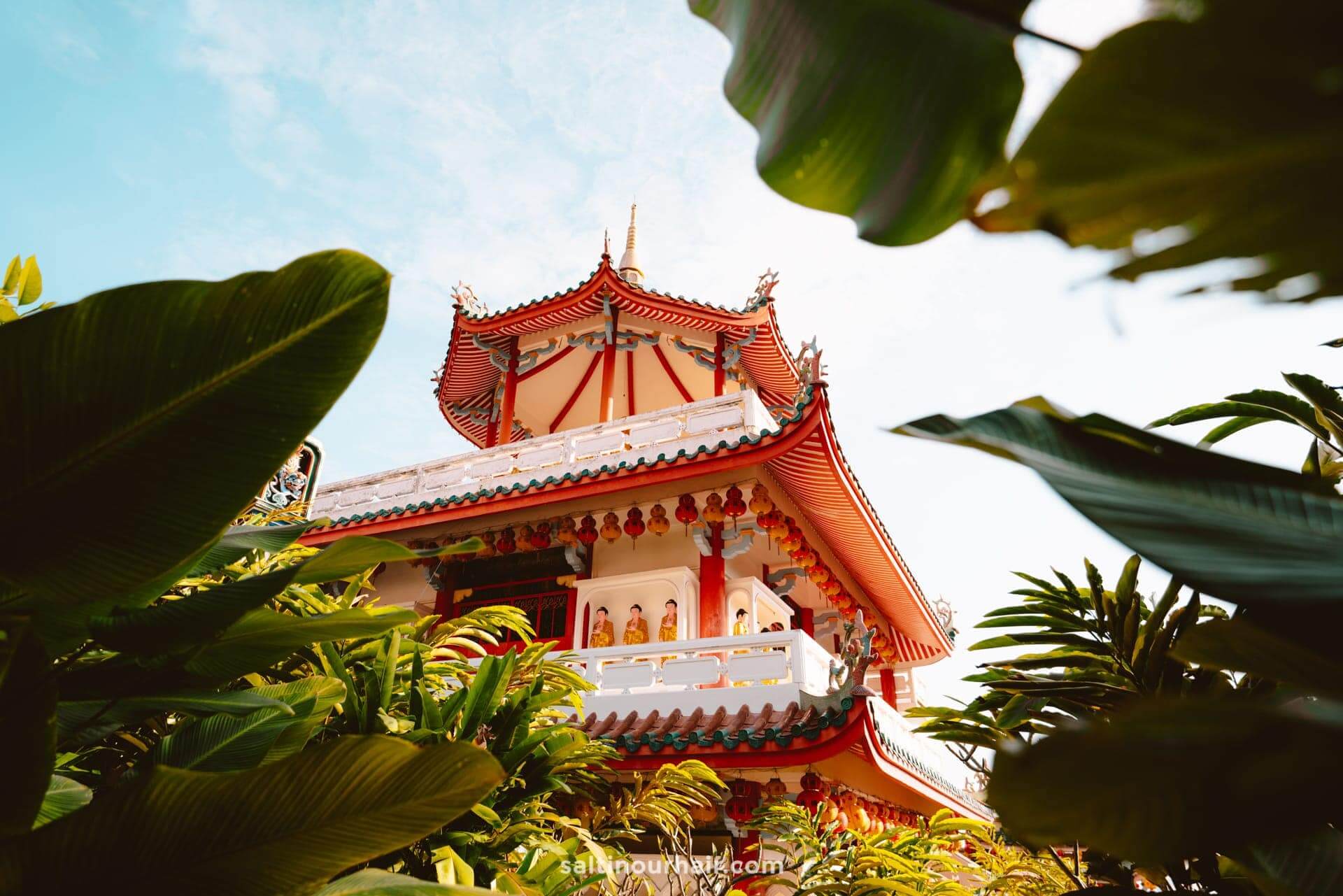
Day 11 – 14: Langkawi
The final part of your time in Malaysia is absolute paradise! Visit the 99 islands of the Langkawi archipelago. Discover stunning beaches, take boat trips amongst the limestone islands or through the mangrove, visit waterfalls, and take the world’s steepest cable car.
Find out about all the things to do in Langkawi
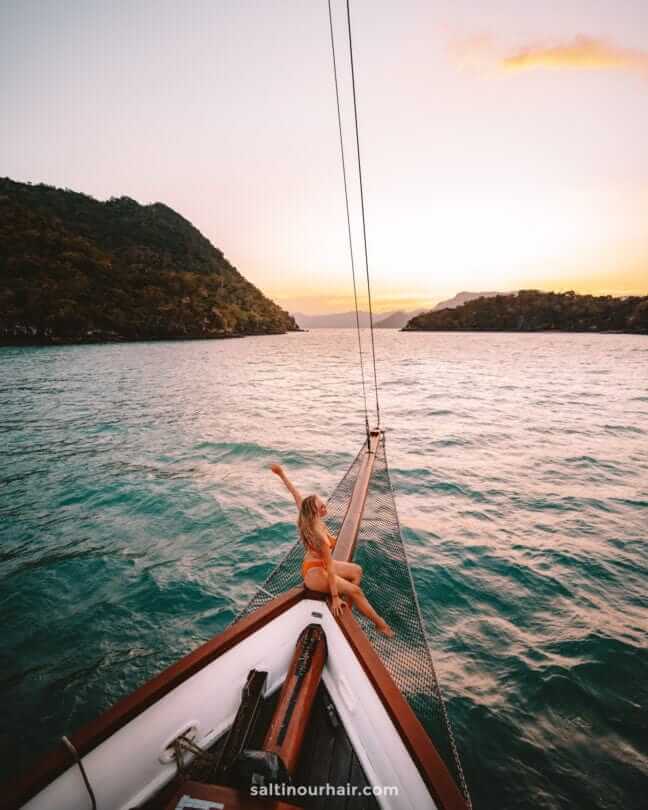
Georgetown to Langkawi Before, there used to be a super-fast ferry between Penang Island and Langkawi. However, nowadays, the only way to get there is to hop on a quick plane ride to the archipelago.
Where to Stay in Langkawi
Langkawi is a large island and offers many options for accommodation.
Hotels in Langkawi 😴
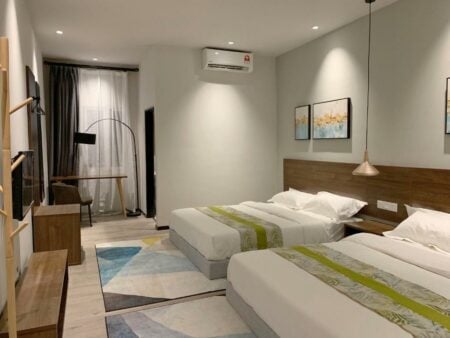
Stay close to Cenang Beach so you’re close to all the restaurants or at the north coast to have a more secluded experience away from the crowd.
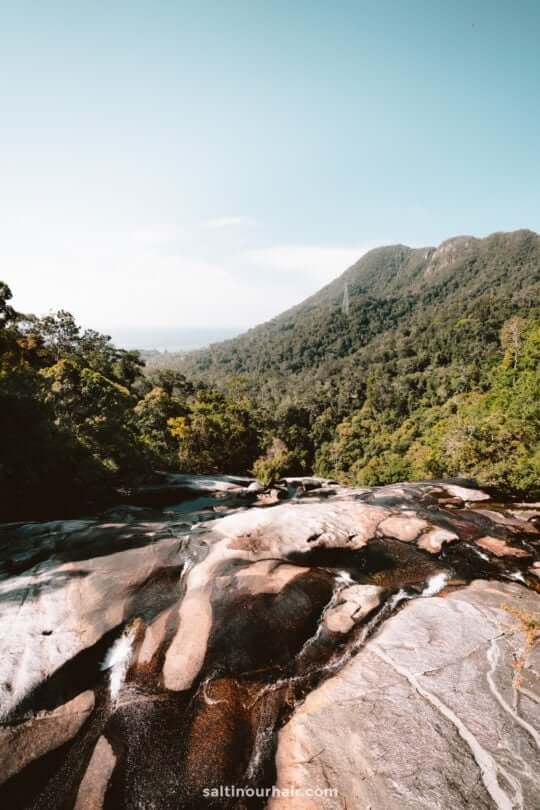
Alternative Malaysia route options
Is your time in Malaysia limited? Remove Ipoh and/or Malacca from the itinerary to cut down your trip to 10 days.
Costs of traveling in Malaysia
Traveling around Malaysia is, in general, very affordable. The price depends largely on your choice of accommodation, transport, and tours. Expect to travel on a budget of 15 – 30 USD per person and 35 – 75 USD for a bit more comfort.
Costs of Traveling in Malaysia
Travel on a budget in Malaysia, from $180 − $320 USD weekly per person, mid-range $530 − $1650 USD, and high-end from $1650 − $2550 USD. However, costs depend on factors like accommodation, transportation, and activities. We did not include flights. Check flight prices here
- Hotels: $30 − $200 USD Check available hotels
- Hostels: $7 − $20 USD Check available hostels
- Transport: $5 − $15 USD Book public transport
- Car Rental: $50 − $100 USD Book a rental car
- Food: $5 − $20 USD
- Activities: $5 − $35 USD See tickets & tours
- Sim: $1 − $3 USD Get an eSIM or SIM here
- Travel Insurance: $2 − $6 USD Get Travel Insurance
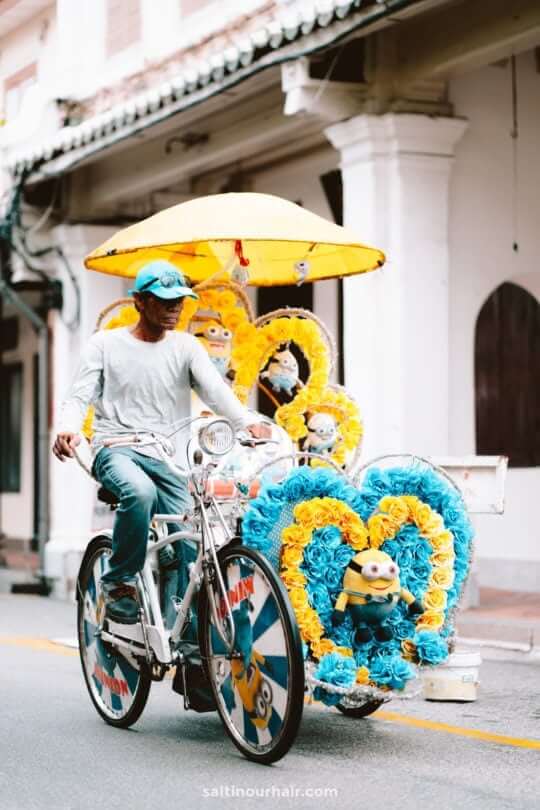
How to get around in Malaysia
The infrastructure of Malaysia is well-developed and makes getting from A to B a piece of cake!
By public transport
There are train and public bus connections between all major tourist destinations. When you’re in need of help, it’s good to know that the majority of Malaysians speak a bit of English.
Book your buses and trains here
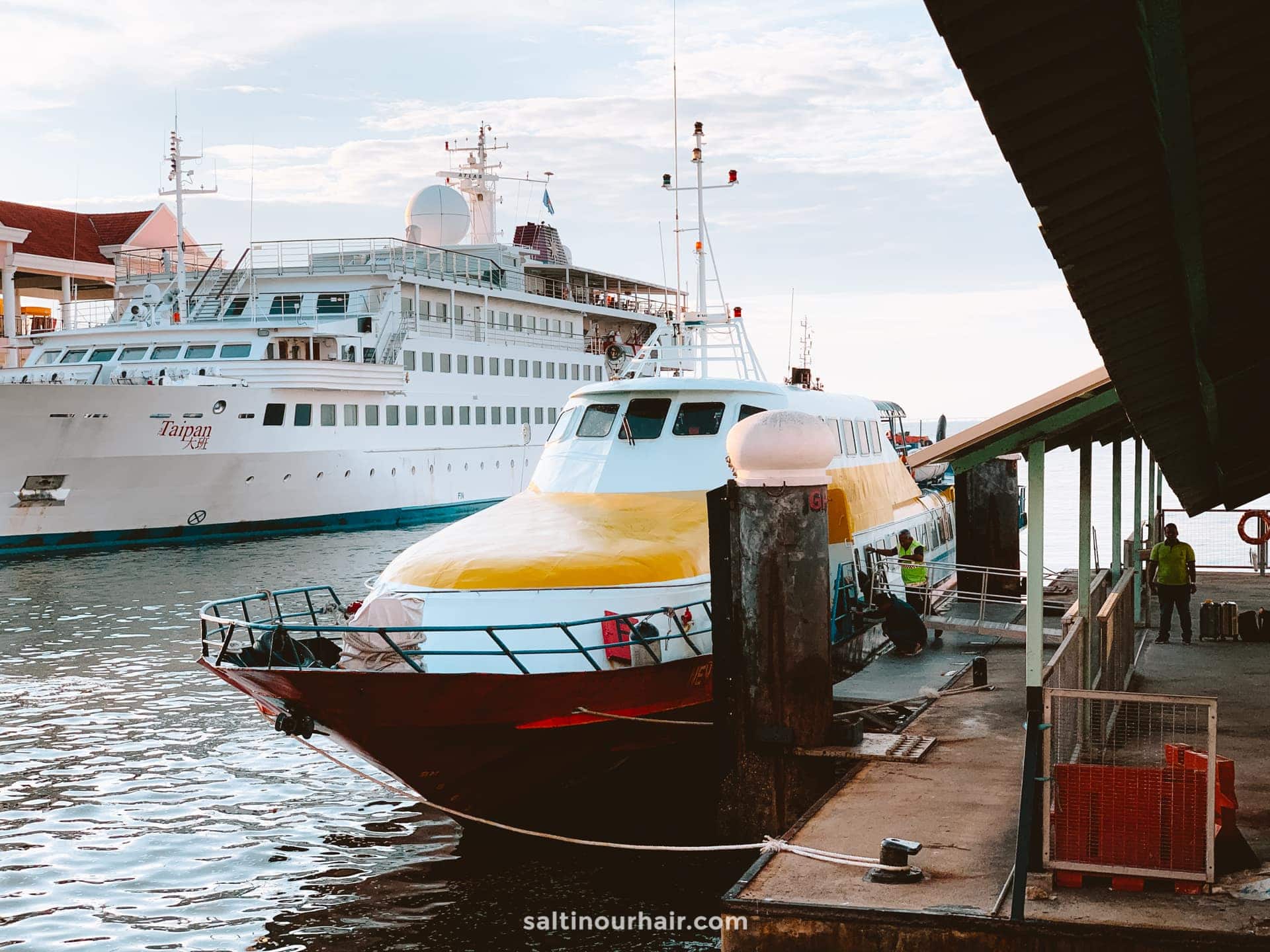
Getting around by car is also a great option since the roads are well-maintained. It also gives you greater flexibility and freedom to explore some lesser-known spots.
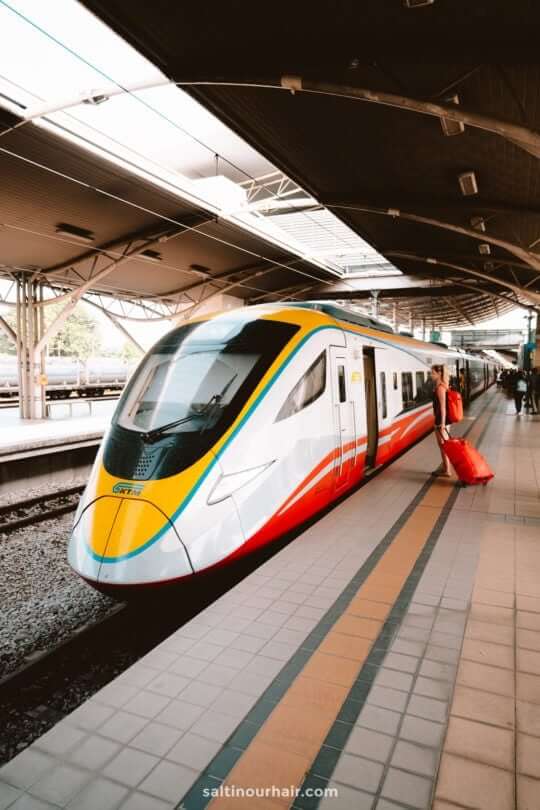
Best time to visit Malaysia
Malaysia has a warm and humid climate of 25 – 32 degrees throughout the entire year. The best time to visit West Malaysia is between December and March.
You can escape the heat by going into the highlands, where temperatures range from 15 – 25 degrees. Try to avoid the wet season from April to October. * Please note that this does not apply to Borneo.
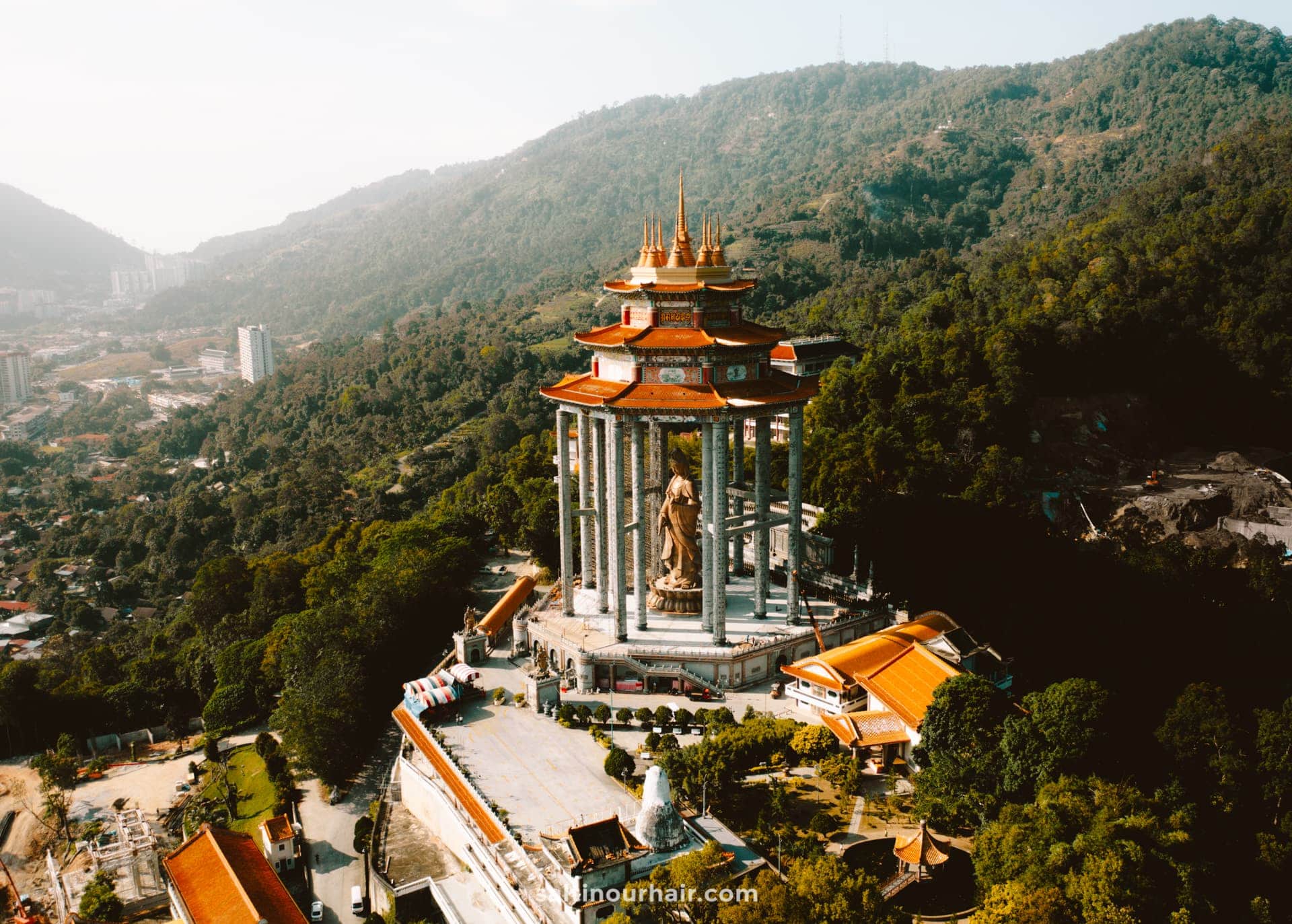
Do I need a Visa to travel to Malaysia?
Most nationalities do not have to apply for a Malaysian Visa. There are a few countries that need to apply for an e-Visa, which is an easy process.
Check here if you need a visa for Malaysia
Safety in Malaysia
Malaysia is a safe country to travel to. Crime is low, as is the number of pickpockets, and you should feel safe to roam around and walk freely. The people are friendly and will help you as much as they can.
Here’s how to: find the right travel insurance
By purchasing through our links, you support us at no additional cost. Thank you for your support. ♥️
- Find Hotels via Booking.com
- Find a Rental Car via Sunny Cars
- Find Flights to Malaysia via Skyscanner
- Get a Travel Insurance via Heymondo
- Book Tours & Attractions via GetYourGuide
- Book a Bus/Train/Transfer via 12Go
Best Things to do in Cameron Highlands, Malaysia
15 things to do in kuala lumpur (3-day guide), 8 things to do in melaka, malaysia (2-day travel guide).
Looking for more travel information? Plan a chat with us for personalised travel advice or get an answer from the Salt in our Hair Travel Community on Facebook.
Hello ☺️ how did you move around Malaysia? A mix of train, bus and rental car? I am a bit scared of driving there but also would love to visit so many places… Thanks!
Hey! Yes, a mix of all, however, I think you can get to all of the places in this guide with public transport!
Your email address will not be published. Required fields are marked *
Notify me when new comments are added.
Wander-Lush
Malaysia Travel Guide
Every time I come to Malaysia there’s one thing I gotta have… laksa. Anthony Bourdain
Skyscrapers, Street Art & Cendol
For Anthony Bourdain, it’s laksa. For me, it’s Cendol. Nothing says Malaysia like a freakish bowl of sweet coconut milk topped with green jelly and kidney beans. Give me a slice of thick-cut toast with Kaya butter, a tall glass of Ipoh white coffee, and a simple bowl of Char Kuey Teow fried noodles, all in quick succession. I’m no foodie, but Malaysia sure brings it out in me.
From the skyscrapers of Southeast Asia’s most iconic metropolis, Kuala Lumpur , to the 130-million-year-old rainforests in Taman Negara , Malaysia truly is a place where old and new, tradition and modernity, the crumbling and the glossy, meet in the middle. Many adventures begin at Kuala Lumpur international airport . Before you make a break for it, take a few days to soak up the place where it all comes to a head.
Take a quick trip to the Batu Caves and a drawn-out hike to Mount Kinabalu . Kick back on the Perhentian Islands , sip tea in the Cameron Highlands , and saunter down the river in Kota Kinabalu in search of wild orangutans. From Peninsular Malaysia to the island of Borneo, this is undoubtedly one of Southeast Asia’s most varied and underrated countries.
Malaysia is the original melting pot, a heady blend of Malay, Indian, Chinese, Hokkien and indigenous cultures. If you’re a handicraft lover like me, best leave some serious space in your suitcase for souvenir shopping . Iban baskets from Kuching and ikat and batik textiles are my picks.
Walk the streets of Ipoh , my favourite city in Malaysia, with its heritage architecture and hawker markets, and roam the five-foot ways for legendary street art in Penang . Maybe it’s the Milo or milky tea served with a cracker on the side, but Malaysia always makes me pine for a childhood I never had. Anywhere you land, the nostalgia is almost as thick as the cloying humidity.

Malaysia travel essentials
Please note: Some of these links are affiliate links, meaning I may earn a commission if you make a purchase by clicking a link (at no extra cost to you). Learn more .
December-February (winter) or October/November (shoulder season).
How long in Malaysia?
2 full days for KL; 10-14 days for the highlights; 3-4 weeks for a good overview.
Daily budget
40-50 USD per person per day (mid-range hotel; local meals; bus fares; museum tickets).
Getting there
Fly into KL or Penang; train or bus from Singapore or Thailand.
Malaysia visa
Visa-free for most passports (stay for 30/90 days).
Getting around
Domestic flights (AirAsia), high-speed train or bus.
Where to stay
Hostels, family-run guesthouses or hotels.
Tours & experiences
Street food tours, tea fields and culture walks.
Explore Malaysia
Discover all the best things to do (and eat!) in Malaysia with my latest travel guides.

Penang Culture Guide: 6 Unique Things to Do in Penang

Things to Do in Ipoh: The Perfect Ipoh Itinerary for Food, Art & Culture

Where to Go in Malaysia: Top 30 Unmissable Destinations

What to Buy in Malaysia: Best Local & Authentic Malaysia Souvenirs

KL Layover Guide: Essential Info, Plus 9 Alternative Things to Do on a Layover in Kuala Lumpur, Malaysia

60+ World Rituals, Festivals & Ceremonies Worth Travelling For (Part 3)
My malaysia favourites.
Cameron Highlands tea fields & jungle trek.
Must-eat meal
Laksa & Popiah (spring rolls) in Kuching.
local experience
Over-ordering at a hawker market.
best souvenirs
Rattan baskets & ikat or batik textiles.

Dive Into Malaysia
How To Plan A Trip To Malaysia: The Ultimate Malaysia Travel Guide!
Do you need to plan your trip to Malaysia? Great! You are in the right place!
In this article, I walk you through exactly how to plan a trip to Malaysia which is perfect for you. I talk about what steps you need to take, how far in advance you should take them as well as break down when the best time is to go to Malaysia, how to get to Malaysia, where to visit, where to stay, how to get around and everything else you could possibly need to know for the perfect break.
I also talk budget and what to pack. Everything you need to know!
If this is sounding overwhelming, don’t worry! I’ll help you plan your own travel Malaysia step-by-step. This handy travel booking list along with the timeframes below will keep you on track.
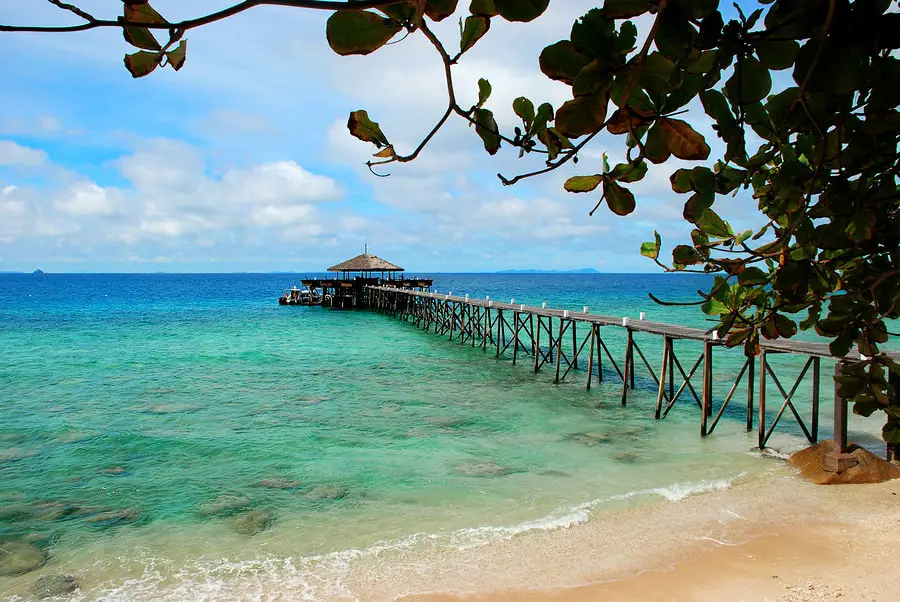
Because the good news is that it is quite easy to plan a trip to Malaysia by yourself with the information in this article, on this site and with some help of some online booking engines.
We travel to Malaysia multiple times a year and have also lived there. We always arrange everything ourselves – it’s easy, fun and the most cost-effective option. Although if you would rather do a tour to save any hassle then I also have suggestions for that below too!
Ready to get started? Let’s make that Malaysia tour plan!
Travelling to Malaysia? Click here to download your free Malaysia Trip Planning checklist . We’ll help you get ready for your trip!
Planning a trip to Malaysia? Have any questions? Join our Malaysia Travel Planning Facebook group here now! It’s the perfect place to ask any questions and to be inspired!
If you aren’t just interested in Malaysia and wondering how to plan a Singapore/Malaysia trip, this is also covered. If you haven’t yet decided if Malaysia is the right place for you, be inspired by this list of places to visit in Malaysia!
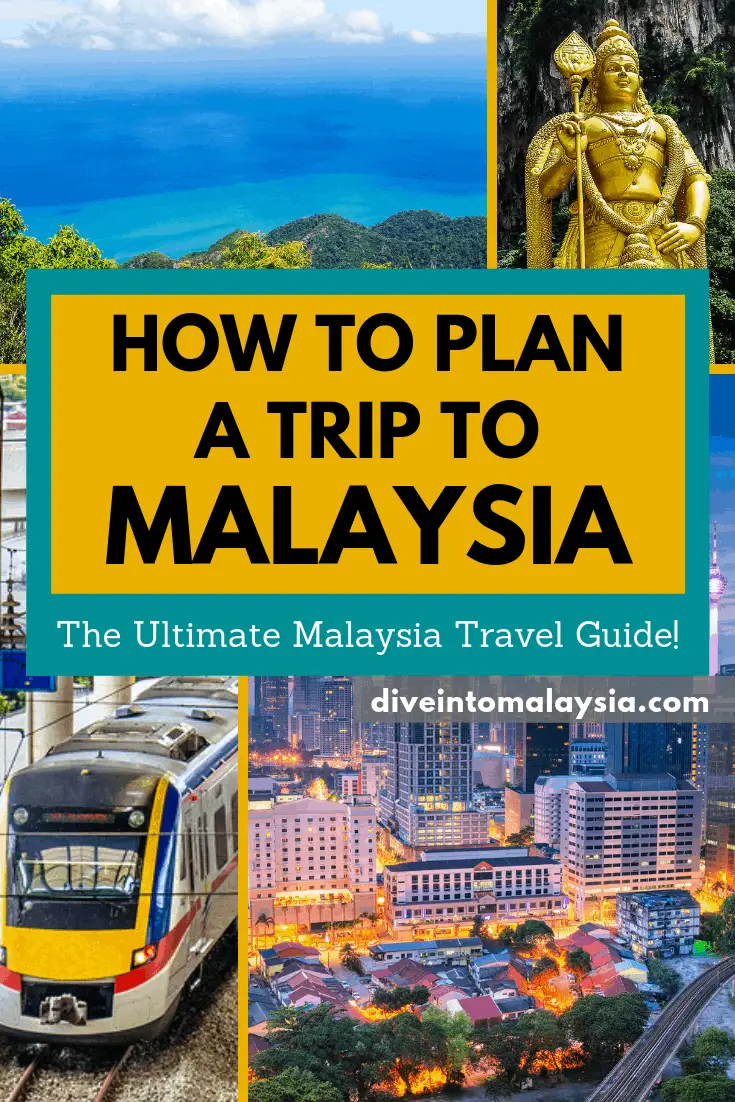
How To Plan A Trip To Malaysia
The first step in how to plan Malaysia trip is to work out when exactly you will go. If you have set dates, you can skip the next section. Otherwise, I’ll help you decide when to go.
Then I will give you a list of what to book, when and you can read each further section below as you work through your planning list.
Looking for the ultimate Malaysia Itinerary Planner for your trip? Click here to get it now! It’ll help you plan an awesome trip.
I also talk about how to plan a trip to Malaysia in my podcast episode here.
Malaysia Map
But before we start going through everything, here is a Malaysia map. If you aren’t familiar with the geography of Malaysia, you can quickly and easily see where all the places are that we talk about below.
If this is you, I recommend you take a minute to take a good look at this map. You can open it by clicking on it. You can zoom using the controls to get an idea of where all the places mentioned below are. Keep it open while you read the rest of this article.
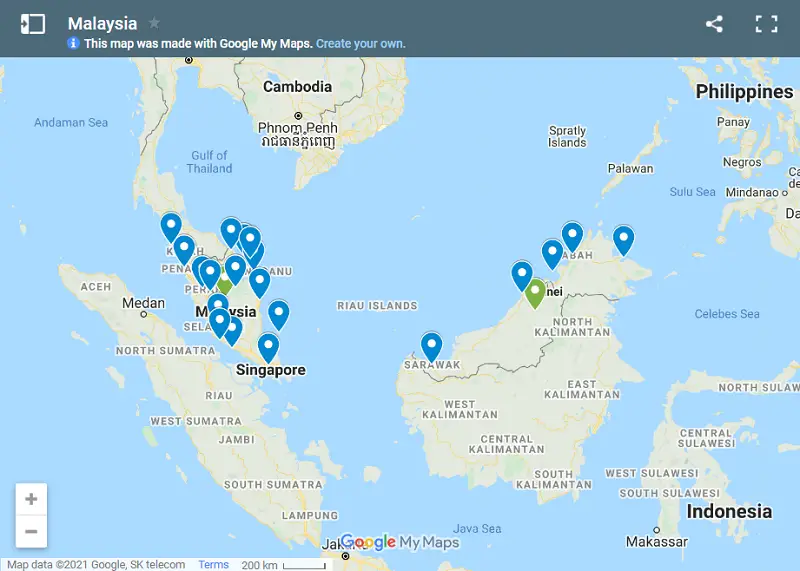
Basically, there are two parts of Malaysia – peninsular Malaysia which is attached to Asia and is where you will find the capital, Kuala Lumpur, and popular destinations like Langkawi and Penang.
Then there is Borneo or East Malaysia which is a big island a couple of hours flight from Kuala Lumpur. This island is also shared with the countries of Brunei and Indonesia.
When To Go To Malaysia
The good news is that it’s never a bad time to go to Malaysia! It’s always a good time of year somewhere.
One of the major destinations in Malaysia, the capital Kuala Lumpur, does not vary much year round. Singapore is close to the equator and does not vary much either if you plan to add that to your Malaysia trip.
Most other areas have a more distinct monsoon/rainy season and a dry season. It is best to visit in the dry season which is November – March on the west coast of peninsular Malaysia (which includes Penang and Langkawi) and April – October on the east coast (which includes Perhentian Islands and Redang Island) and in Borneo.
On the west coast, it does not matter too much and rainy periods do not tend to last long or cause too many problems. On the east coast, however, it is a different story and many of the islands basically shut down in the monsoon period so it is best to avoid this area then.
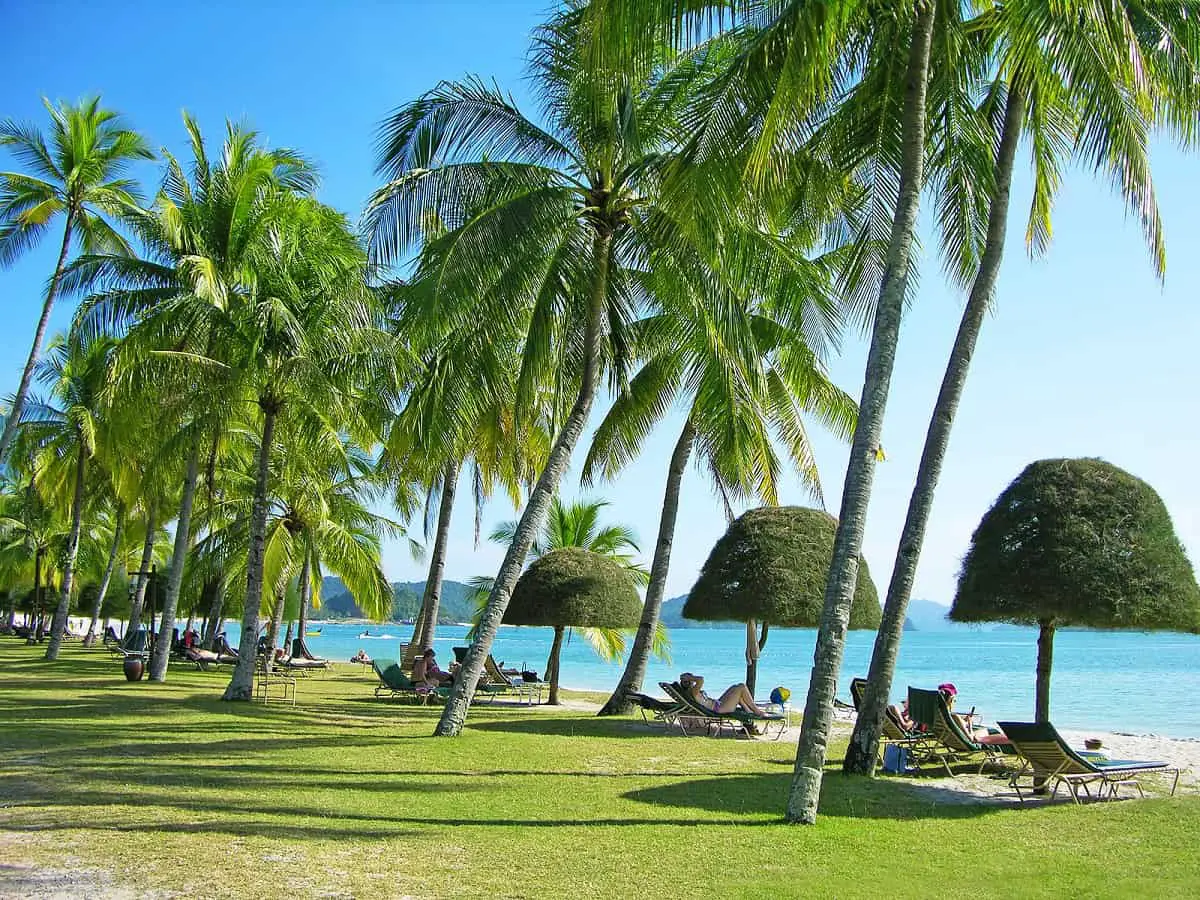
Other things to take into account are school holiday periods in Malaysia and Singapore. These fall from mid November to the start of January and there are shorter periods in March, May/June and July/August. See the latest ones here .
Finally, “the haze” is a problem that occurs annually around June – November thanks to pollution from fires in Indonesia. The affect of this is variable – sometimes it is minor and won’t affect your travel. Other times, the pollution can be quite bad especially in areas like Singapore and Malaysia.
Peak tourist times are December, January and Chinese New Years. Expect things to fill up quicker and be pricier at these times so it’s especially important to book ahead.
Here is a full article with more specific details about the best times to visit Malaysia in different parts of the country.
Travel Booking List And Countdown
Malaysia does not tend to get booked out completely but there are definitely times when it pays to book in advance which is mainly in the peak tourist season in December and January. If you are visiting for an event or festival, like Chinese New Years, it is also important to book in advance.
However, you are generally best off booking flights and accommodation 6 – 12 months in advance for the best deals. There can be a big cost saving on flights particularly when they are booked far in advance especially if you want to go in the peak tourist time or school holidays.

6-12 months in advance:
- Book international flights
- Get travel insurance
- Plan itinerary
- Book any domestic flights
- Consider booking accommodation and any tour packages
3 – 6 months in advance:
- Book accommodation if not booked yet including overnight tours ( like these )
- Work out how you will get around Malaysia, book car hire if necessary and any remaining domestic flights
1 month in advance:
- Get visa if necessary
- Work out how you will access money
- Book attractions and tours
- Book bus tickets
- Book airport transfers or plan how you will get to your hotels
- Work out sim card for phone
- Make sure you print out or have easy access on your phone to all bookings
1-2 days in advance:
- Fill in the online form for your digital arrival card. All foreign travellers must do this up to 3 days before arrival.
How To Travel To Malaysia
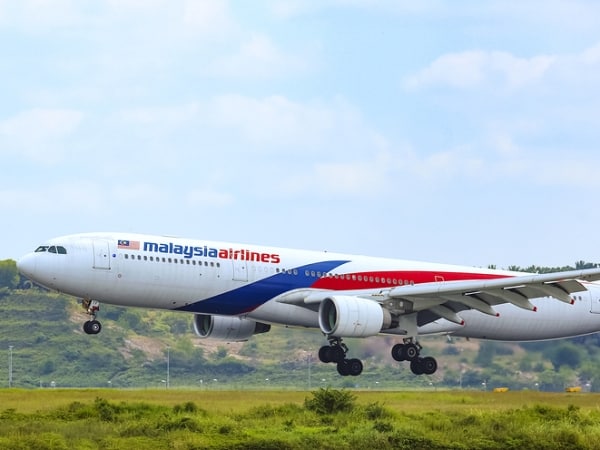
Unless you are from or visiting a neighbouring country, you are most likely flying into Malaysia. Thankfully, this is usually quite easy with Kuala Lumpur being a major hub. There are also international airports in other parts of the country like Langkawi and Penang but options are usually limited and this tends to only work if you are flying from a neighbouring country.
Even if you are coming from nearby, like Thailand, flight deals can be very good so it can be worth flying over the extra hassle of overland transport.
Best Flight Deals To Malaysia
To find the best flight deals to Malaysia, I recommend using Skyscanner or CheapOair which will give you a good comparison of all available options.
Skyscanner is particularly good for searching for the cheapest days to fly and you can also set up price alerts so it will email you if the price changes. Click here to give it a go.
CheapOair is a better choice if you are looking for business or first class flights. Click here to do a search.
There are two major airlines based in Malaysia: AirAsia (budget airline) and Malaysia Airlines and these can be convenient options especially if you want to connect to a domestic Malaysia flight. However, many great airlines fly to Malaysia and it’s not necessary to travel one of the local airlines.
I highly recommend you listen to my podcast episode here where I walk you through how to get the best flight deals as well as many things to consider when flying to this part of the world.
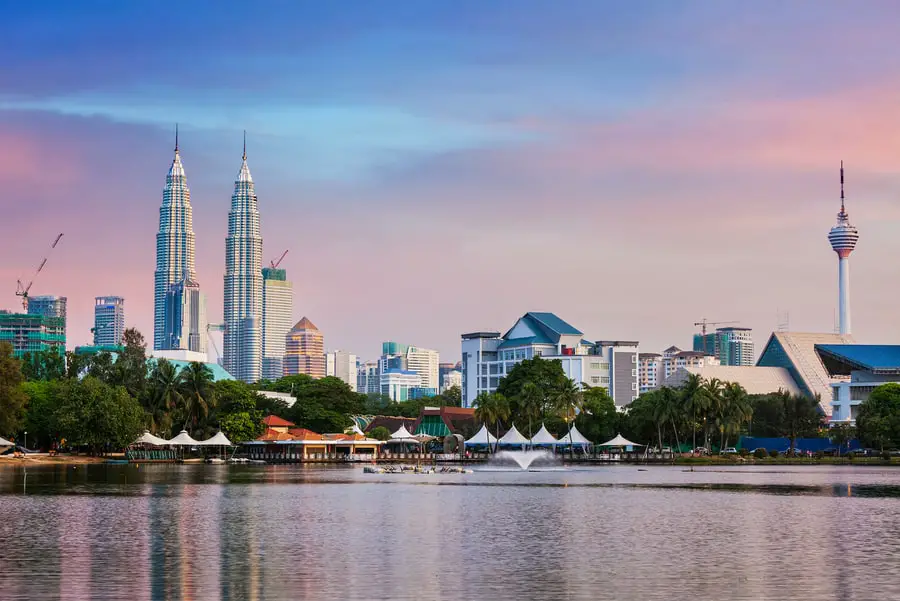
It can often be cheaper to book flights to Kuala Lumpur separate to any domestic flights.
It’s also worth considering flying into Singapore instead especially if you want to visit Johor Bahru or Tioman Island. Flights to Singapore can be cheaper and there can be more options too.
If you want to visit Singapore on your trip as well as Malaysia , this is particularly a good option but there are also many flights from Singapore to different locations in Malaysia and it’s easy to go straight from the airport across to Johor Bahru in Malaysia as well.
In fact, you can book a taxi directly from Singapore airport to Malaysia here.
If you have plenty of time before you plan to travel, are flexible with dates and live in Asia or Australia, then signing up for the AirAsia newsletter is a great idea. There can be some great sale fares but you do need to be ready to book the second they come out as they usually sell out fast.
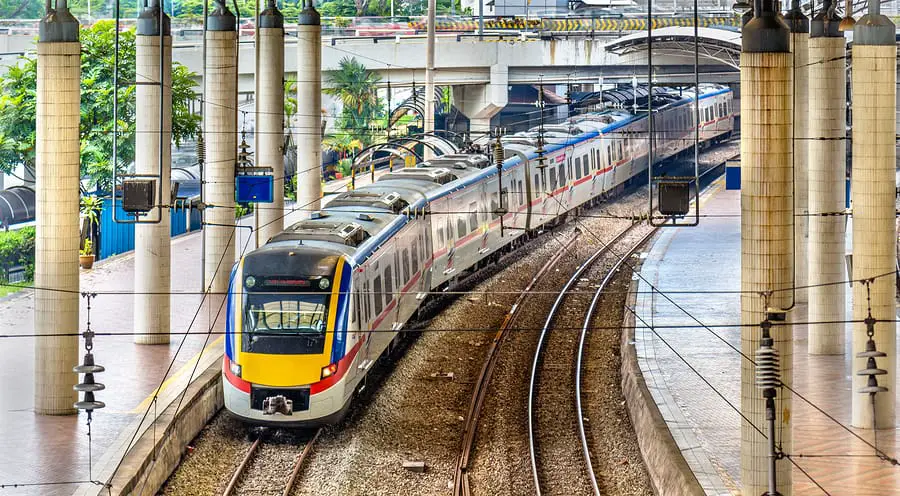
If you are in a neighbouring country, it’s also easy to travel overland into Malaysia.
There are buses, trains and boats between Malaysia and Thailand. The most frequent and often easiest option is by bus.
Hat Yai, in southern Thailand, is a common point to get buses into Malaysia (and they leave frequently) although there are many places from which you can travel to Malaysia.
Click here to look for tickets now.
It’s also possible to get a train into Malaysia. You will first need to catch a train in Thailand to the border with Malaysia at Padang Besar. From here, you can catch a second train to Alor Setar (for Langkawi), Butterworth (for Penang) or all the way to Kuala Lumpur.
You can also take a ferry, There are regular fast ferries between Satun in Thailand and Langkawi ( find times and ticket prices here ). In high season, there can be boats operating to Koh Lipe in Thailand from Langkawi as well ( timetables here ).
It’s very easy to travel between Singapore and Johor Bahru in Malaysia with frequent buses to many places in the country.
It’s also possible and very easy to take taxis between the two countries which is what I do and recommend. You can book a taxi here and be picked up at your hotel or airport and taken anywhere in Malaysia.
There is also a train from the Woodlands Train Checkpoint across to Johor Bahru although a bus or taxi is more convenient.
Find more details on exactly how to do this here.
It’s possible to take ferries between Indonesia and Malaysia. If you are in Kalimantan (the Indonesia part of Borneo) then it’s also possible to bus to Malaysia from Pontianak ( timetable and prices here ).
Most ferries depart from Sumatra in Indonesia and arrive in Melaka and Penang. There are also ferries from the islands of Bintan and Batam to Johor Bahru or Tarakan in Kalimantan to Tawau in Sabah, Borneo.
Brunei is surrounded by Malaysia in Borneo and it’s easy to travel between the two. There are buses or you can take a ferry from Brunei to Pulau Labuan which is a Malaysian island just off the coast of Borneo.
Find ferry information here and bus information here.
Passports And Visas
If you are from Australia, New Zealand, Canada, USA or the EU you do not need a visa at time of publishing. Many other nationals do not need visas either for stays for up to 90 days. However, it is best to always check this for yourself.
Your passport does need 6 months validity at the time you enter so get a new passport before you go if this is an issue.
You also need to fill in an online form here up to 3 days before entering the country. You can’t do it any earlier and all foreign travellers need to do this.
This is a new requirement that came into effect on 1 December 2023. It will give you a Malaysia Digital Arrival Card (MDAC).
When entering, if you talk to an official and you plan to stay in the country for more than 30 days, ask for 90 days entry. Sometimes, they will give you less than the allowed 90 days if you do not ask.
When travelling to Sabah and Sarawak (which are Borneo), your passports will be inspected again.
Money In Malaysia
The Malaysian currency is called the ringgit (RM) and there are many ATMs around which is the best (and usually cheapest) way to get cash. You will need to carry around this currency as it’s rare for anything else to be accepted. You can use credit cards at many places as well.
Note that your card from home can have some killer fees when it comes to using it overseas.
I highly recommend you consider getting a Wise multi-currency account. It’s free and makes it super easy and cheap for you to exchange your currency for ringgit or other currencies when you travel. You can use the card at ATMs as well.
Click here for more information.
Where To Go And Malaysia Itineraries
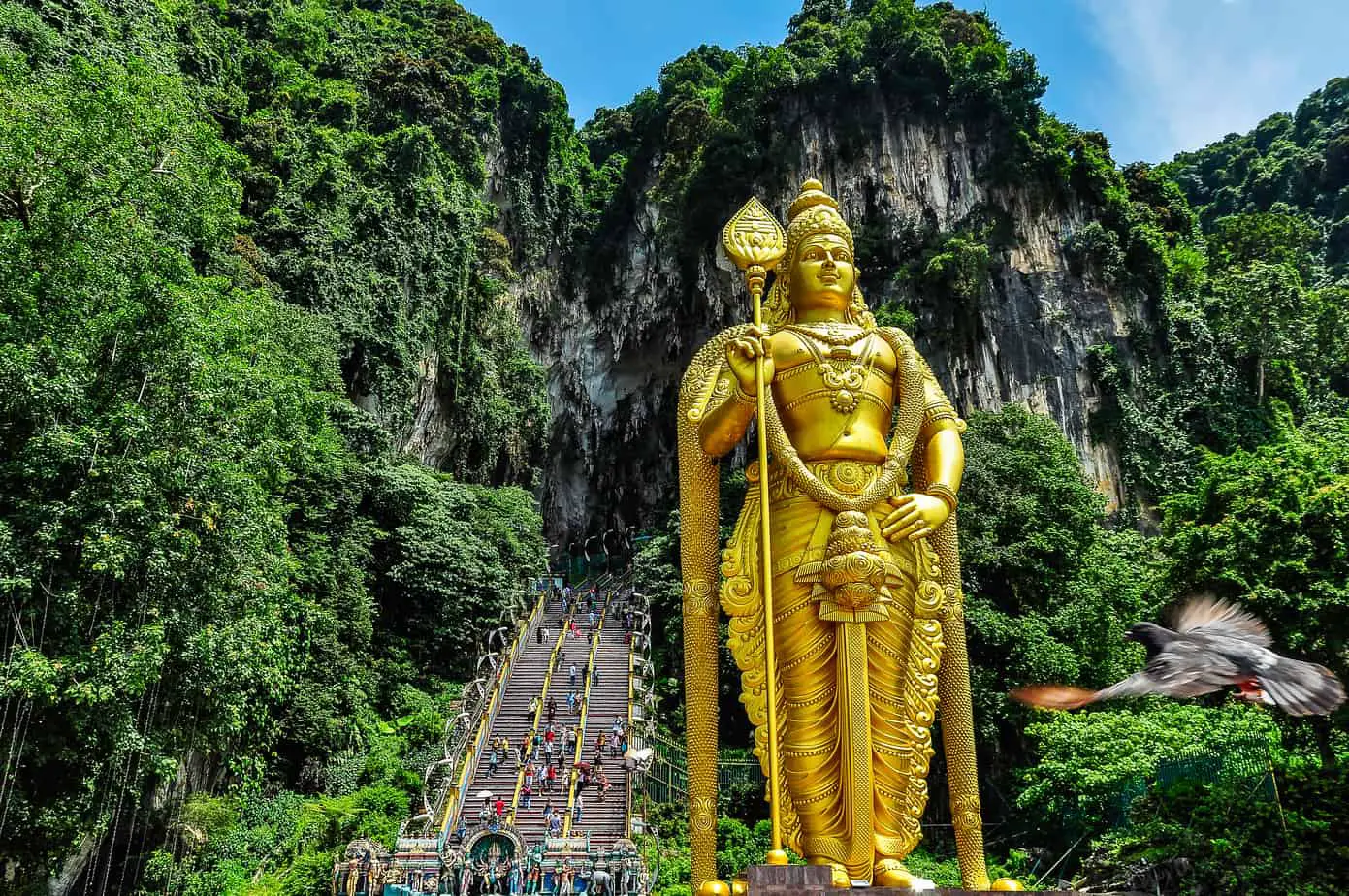
The hardest part of how to plan a trip to Singapore and Malaysia is likely to be working out where you can go. There are many great options!
The most popular places are:
- Kuala Lumpur – the capital and largest city with many attractions and things to do
- Penang – an island with an interesting history, UNESCO listed old town, beaches and great food
- Langkawi – a popular island for beaches and relaxing with the best resorts in the country and some good attractions
- Johor Bahru – a popular starting point from Singapore especially for families as it’s home to Legoland Malaysia
- Melaka – close to Kuala Lumpur, this is a great destination to learn more about the mixed history of Malaysia
- Cameron Highlands – cool down in the highlands with beautiful views, tea plantations and many farms and low key attractions
- Tioman Island – a popular beach and diving destination from Singapore
- Perhentian Islands – some beautiful beaches and good diving off the east coast of Malaysia
- Sabah – this fantastic state in Borneo is full of amazing wildlife and natural attractions
- Kuching – the capital of Sarawak in Borneo, there are many amazing day trips to enjoy cultural, natural and wildlife attractions from this pretty, riverside city
- Singapore – yes this is its own country and not in Malaysia, but combining a trip to Malaysia with Singapore is a popular option and worth considering
There are also many other fabulous places to visit in Malaysia which I recommend you consider if you have more than two weeks. However, if it’s your first trip and you have up to two weeks, these places are your best bet.
As a general rule, I recommend 3 days per place minimum. You can adjust this based on whether you are someone who likes to take it easy when you travel or like to go quick and see as much as possible.
Looking for the ultimate Malaysia Itinerary Planner for your trip? Click here to get it now!
You can also find some itineraries combining Malaysia and Singapore here and more Malaysia itineraries here . You don’t have to reinvent the wheel, just use one of mine!
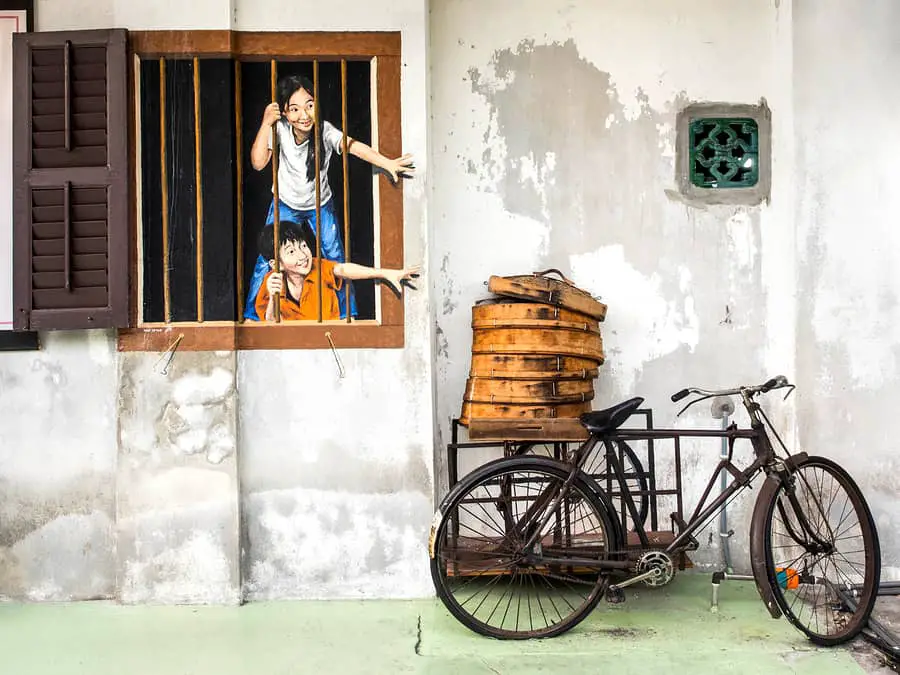
If you are looking for some destinations to add to your travel planner Malaysia which are slightly less popular, consider making the journey to Borneo and exploring the states of Sabah and Sarawak and perhaps adding Brunei . I only recommend this if you have at least a week available and I would only visit one state with just a week.
Some other destinations in peninsular Malaysia worth considering are:
- Ipoh – known for its street art and amazingly good food
- Redang Island – beautiful beaches and some solid resort options on the east coast if you would like something less popular than Tioman and the Perhentians
- Port Dickson – if you don’t have long in Malaysia and want a beach destination convenient to Kuala Lumpur
Recommended Group Tours In Malaysia
If you would rather just enjoy your holiday while not worrying about the details, a group tour is an excellent option. Here are some recommend options…

Trafalgar Tours
Trafalgar Tours is the best choice if you want everything taken care of on a bus tour.
They offer a great tour program in Malaysia and Singapore which you can see here.
Click here to find more information about Trafalgar Tours.
G Adventures
I have done a couple of G Adventures tours and love them because they are good at making things easy for you while still getting you to out of the way destinations and giving you local experiences as well as giving you some time by yourself if you want it.
The groups tend to be small with a maximum of 15 travellers making it easier to visit places and keep things local.
Click here to see G Adventures tours in Malaysia.
Intrepid Travel
I have done a few Intrepid Travel tours as well and I love how many of them use public transport and put an emphasis on local experiences while keeping everything hassle free with your own tour guide.
They have an average group size of 10 which works well compared to big bus tours.
Click here to find more Intrepid Travel tours.
Customised Tour Packages
A great alternative to group tours and booking accommodation and attractions separately is to purchase customised tour packages.
We have some great Malaysia tours and experiences that you can book through us. These enable you to save money and effort by combining accommodation, transport, meals, activities and more to make your trip super easy and comfortable.
In fact, some attractions in Malaysia you can only visit this way. Some attractions and activities also limit numbers (like Turtle Island in Sabah) so booking a tour this way is the only way to experience.
You can see all our special tours for Dive Into Malaysia readers here.
Accommodation In Malaysia
One of the reasons we love Malaysia is because of the huge range of accommodation available for all budgets and what great value it is. This is somewhere where you can find a 4-star over water chalet for under $100 a night!
Budget hotels abound and there are hostels for people on low budgets. Cheap hotels tend to still be clean and a reasonable standard, just basic.

Midrange options are excellent and this is somewhere I recommend you aim to pay for at least this if you can. Often you can find solid midrange options for around $50.
Finally, on the upper end, there are some truly amazing resorts and hotels which can be incredibly good value. The best options are in the most visited places of Kuala Lumpur, Langkawi, Penang, Johor Bahru, Kota Kinabalu, Miri, Kuching and Port Dickson. If you go to less busy places, there can be a lack of really great accommodation so if 5 star resorts with great service are important to you then the places just mentioned are your best bet.
Note that Malaysia has a tourism tax for foreigners of RM10 per night. From the 1 January 2023, you may need to pay this when you check in to your hotel if you didn’t pay when booking.
Best Accommodation Booking Sites
I highly recommend Agoda for booking accommodation in Malaysia.
It usually has the best price and has a rewards scheme where you quickly gain credit to use towards your next booking. In fact, if you pay upfront, often you get the credit straight away so you can use it for your next hotel booking.
Agoda also has a great range of accommodation in Malaysia including private home and apartment rental.
Click here to start searching now.
Booking.com also tends to have similar prices but without the rewards. It has less options in Malaysia as well. If you would like to check it out as well, click here.
Airbnb is also possible here for people who like to stay in apartments and homes and we have stayed in some great deals in Kuala Lumpur and Penang.
I find TripAdvisor useful for looking at reviews for hotel options to double check they are good quality.
Note that there is a tourist tax of RM10 a night which is often not added to your hotel cost until you arrive at the hotel. This is not a scam and needs to be paid.

We have many hotel guides to help you book your perfect stay. Here are some of them:
- Best resorts in Malaysia
- Best beach resorts
- Best resorts for families
- Resorts with private pools
- Best resorts in Langkawi
- Best hotels in Kuala Lumpur
- Best hotels in Penang
- Best hotels on Pangkor Island
- Best hotels in Ipoh
- Best hotels in Taiping
- Best hotels in Cameron Highlands
- Best hotels in Johor Bahru
- Best hotels in Desaru
- Best hotels in Melaka
- Best hotels in Muar
- Best resorts in Redang
- Best resorts on Tioman Island
- Best resorts on Perhentian Islands
- Best hotels in Kota Bharu
- Best hotels in Kuala Terengganu
- Best hotels in Taman Negara
- Best hotels in Kota Kinabalu
- Best hotels in Sandakan/Sepilok
- Best hotels in Semporna
- Best hotels in Tawau
- Best hotels in Labuan
- Best hotels in Miri
- Best hotels in Bintulu
- Best hotels in Sibu
- Best hotels in Kuching
You can also listen to my podcast here about booking accommodation, tours and attractions in Malaysia.
How To Get Around Malaysia
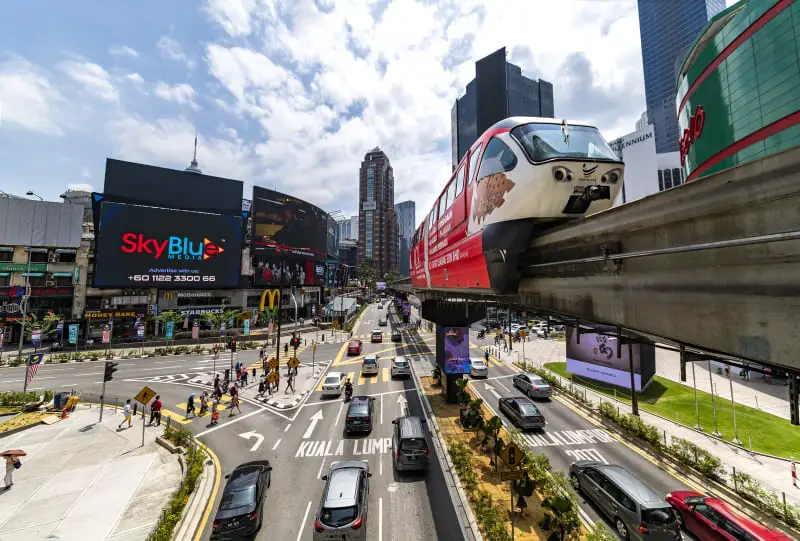
There are a few options for getting around Malaysia. All are quite easy!
Buses in Malaysia go most places and can be great quality between cities and towns. They are usually quite quick and are easy to book online or on arrival. Booking before you go can help you save time when you are there and ensure you get a bus at the perfect time.
However note that if you don’t see any buses scheduled on your dates that you may be looking too early. They often only appear 1 – 3 months before the travel date. Looking at closer dates can help give you a good idea of when they may run on your travel dates.
Click here to see bus timetables, prices and to book your bus.
Train is also a good option although it is more limited than bus in both routes and frequency. Trains can be tough to work in to your schedule if you have limited time.
The main routes are from:
- Johor Bahru to Kuala Lumpur (switching trains at Gemas)
- Johor Bahru to Tumpat. This is also known as the jungle line and takes you through the middle and up the east coast of Malaysia
- Kuala Lumpur to Butterworth (for Penang)
Click here to see train timetables, prices and to book.
Buses can be more comfortable and luxurious and I recommend them over the trains unless you are a train lover.
3. Shared Taxi
Shared taxis are also an option over longer distances. You pay for your seat and they leave when they are full. I prefer buses as they can be more comfortable but a shared taxi can be faster if you don’t wait too long for them to fill up.
4. Private Taxi
It’s possible to hire private taxis to take you anywhere in Malaysia. This is generally more expensive than the other options on this list but it depends how many people you have. This can be a great option for families.
The good news is that for foreigners, private taxis between towns and cities can be very affordable.
You can simply take a shared taxi and buy all seats or arrange one beforehand.
You can click here to book a taxi through this site . We work with local operators to give you a great price and reliable service.
5. Car hire
Car hire is a fun and easy way to explore the country. We find driving in Malaysia quite easy and it is our preferred option along with private taxi . It can be cost effective for families or bigger groups and it also gives you more freedom.
You can find more information on driving in Malaysia including road rules here.
Click here to check out car rental prices.
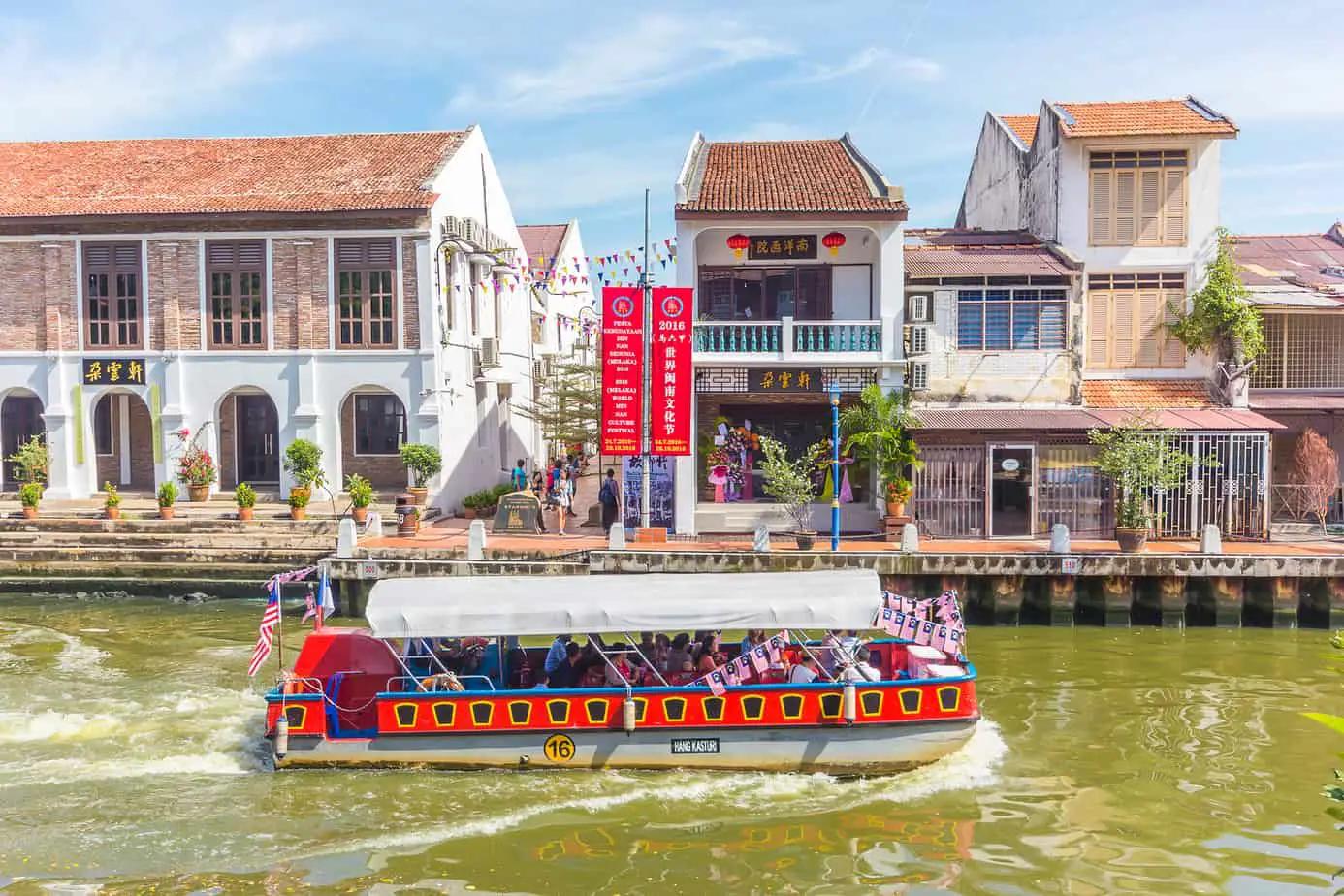
If you plan on visiting an island in Malaysia, you will probably need to take a ferry. These tend to run frequently to popular choices and be easy and good value.
You can find ferry timetables and book tickets for many popular routes here.
Finally, flying is a great option within Malaysia. Domestic flights can be as cheap as a few dollars during sales but even outside of sale periods, they tend to be a bargain.
Flights are especially a good idea for covering a larger distance and when you are short on time. So, for example, if you are visiting Langkawi and Kuala Lumpur, I would definitely fly. Or maybe, you are visiting Penang and Kuala Lumpur and a few places along the way. Going overland one way and then flying the other could make sense.
It’s also necessary to fly if you want to travel from peninsular Malaysia to Borneo. This is the only way to make this journey. Flights tend to be a great deal between these points as well and you can fly to Borneo from a few points in Malaysia like Johor Bahru, Penang and Langkawi so you don’t necessarily have to go via Kuala Lumpur.
Click here to check out flight prices.
You can also listen to my podcast here about the best ways to get around Malaysia.
Want the Easiest (and BEST) Way to travel around Malaysia?
We can book a taxi for you between anywhere in peninsular Malaysia. Travel straight from one hotel to your next without any fuss or sweat.
You can pick your own departure time, relax and know everything will go to plan.
Click here for prices and online booking.
Attractions And Tickets
While the only attraction you need to book in advance is the Petronas Towers in Kuala Lumpur , many attractions in Malaysia have much cheaper prices if you book them in advance on Klook .
Klook is a trustworthy site we use all the time for attractions, tours and activities as it has the best prices and is always very easy to use.
I highly recommend that once you have your itinerary, you go through Klook and book tickets for any attractions you want to visit, particularly big ones like Legoland Malaysia or Sunway Lagoon .
Klook is also great for tours. A tour is invaluable for finding out more about the places you are visiting. Or, in the case of Malaysia, for getting you out and tasting the best food!
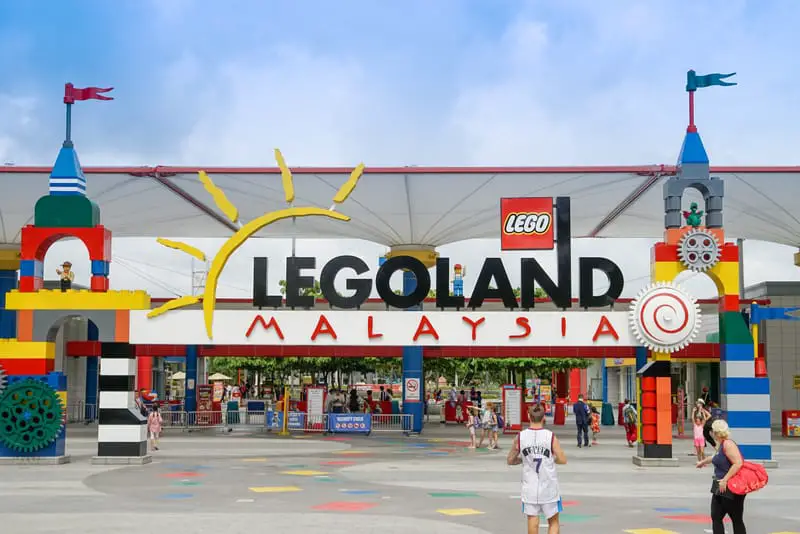
Some tours we particularly recommend:
- Melaka Day Tour – If you don’t have time to stay in Melaka, visit with this easy day tour from Kuala Lumpur
- Kuala Lumpur Food Tour – Visit local neighbourhoods in Kuala Lumpur while trying the best food on offer. Use code DIVE30 to save RM30
- Batu Caves – Visit this top attraction near Kuala Lumpur easily on this tour
- Simply Enak KL Food Tour – Amazing food to try on this tour of the best of Kuala Lumpur
- Kuala Lumpur City Tour – Explore and learn more about the capital of Malaysia
- Penang Heritage Tour – See and learn about UNESCO listed George Town
- Penang Hill And Temple Sightseeing – Visit Penang Hill and Kek Lok Si Temple
- Simply Enak Penang Food Tour – Amazing food to try on this tour of the best of Penang. Use code DIVE30 to save RM30
- Langkawi Island Hopping Boat Tour – The scenery in Langkawi is stunning and this is the best way to relax and enjoy it
- Langkawi Helicopter Tour – Don’t miss the chance to see Langkawi from the air!
Want Help Having An Awesome Food Experience in KL?
Join a Simply Enak (aka delicious) Food Tour!
There are three different options depending on whether you want to concentrate on street food, nightlife or off the beaten track places.
No matter what you pick, you’ll taste a range of fabulous local food and drinks while learning the history and culture of Kuala Lumpur.
There’s no better way to discover this great city.
Make sure you use the coupon code DIVE30 for RM30 off your tour.
Click here for all your option s .
Airport Transfers And Arrival
Arriving in Malaysia is straightforward but it can be daunting the first time, especially if you have a long flight.
You can read our guide here about getting from KL Airport to KL Sentral in the city centre.
On arrival at either terminal in Kuala Lumpur, you can follow signs to get to transportation hubs and buy a coupon for a taxi to your hotel. You can also use the Grab app to book yourself a taxi. It works the same as Uber.
However, if you would like to just arrive and not think at all, I recommend booking a transfer in advance, especially if you have a long journey to get to Malaysia. Here are some options:
- Kuala Lumpur Airport
- Penang Airport
- Langkawi Airport
If you want to go straight to another city on arrival at Kuala Lumpur International Airport (like to Melaka, Cameron Highlands, anywhere 🙂 ), we can book a long distance taxi for you which will pick you up directly at the airport and drop you at your hotel.
Click here for the latest prices.
Travel Insurance
Travel insurance is invaluable. You just never know what will happen!
A few years ago, I broke my leg getting into the shower in Thailand. Doctor and hospital visits, tests then needing to cut our trip short and get a direct flight home added up and it was great to have travel insurance take care of it all – especially when they even paid for me to get home in business class and I was able to talk to an Australian doctor about what was going on.
In my opinion, if you can’t afford travel insurance, you can’t afford to travel.
I recommend buying travel insurance as soon as you book your flights as they will start covering you for some problems from that point.
We have a few recommended options depending on your country of origin:
- Cover-More for Australians here
- Cover-More for New Zealanders here
- VisitorsCoverage for US travellers here
If you are coming from Europe or elsewhere, World Nomads is our recommended option and you can get a no-obligation quote here.
Malaysia Travel Costs

Malaysia can be as cheap or as expensive as you want. The best part is that Malaysia is very good value, so while it may not be as cheap as some nearby countries, you do tend to get more for your money.
Some sample budgets for two people:
Budget travellers: RM200 a day
Mid-range travellers: RM300-600
High-end travellers: RM700+
Of course, budgets will vary due to many factors like how often you move around, how many places you want to visit, how much you like to drink alcohol (relatively expensive) and much more. These are rough estimates only to help you plan.
It’s also worth noting that you can get incredible food for cheap so there really is no need to spend a lot on that as long as you are happy eating the local cuisines.
What To Pack
The good news is that Malaysia is basically always hot and humid – so you can leave all the heavy sweaters and coats at home!
However, this doesn’t mean you should just pack shorts and tank tops.
It’s important to always be respectful to local culture when it comes to how to dress and beach attire is definitely best suited to the beach or your resort. Malaysia is majority Muslim and local people tend to cover up.
You do not need to keep covered but it is a good idea to keep your shoulders covered and, in more conservative areas on the east coast, I recommend covering your knees too. Lightweight, light coloured clothing is the best.
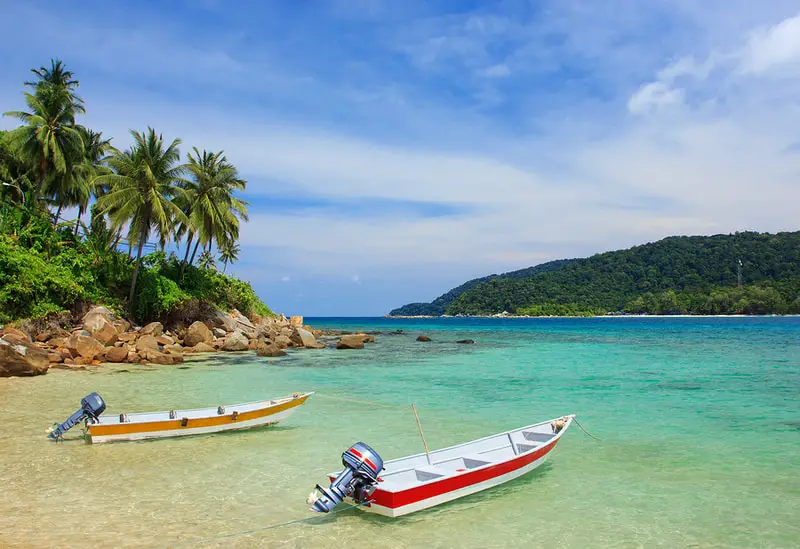
You can buy anything you need in Malaysia very easily and we often buy our toiletries when we get there because they are cheaper than at home! The one exception to this is sunscreen – it’s expensive. We even had my mum bring it over for us when we were living in Malaysia!
Other essential items:
- Umbrella or rain coat – rain can be sudden and heavy
- Good walking shoes that have good grip on wet surfaces. Preferably sandal style
- Scarf or sarong to cover up when going in mosques and some temples
- Plug Adapter – Malaysia uses a UK plug
- Power cube – so you can charge all your electronics in one place
Internet And Phone Coverage
Many accommodation providers and some restaurants will have wifi for keeping in touch with home. However, we always buy a local sim card so we don’t have to worry and because they are so cheap and easy.
You can get one at the airport in minutes and even buy one beforehand here.
You can read our full article about getting a sim card in Malaysia here.
Other Things To Consider

- While the majority of Malaysia has a Monday to Friday working week, some states follow a Sunday to Thursday working week. This occurs in Johor, Kedah, Kelantan, and Terengganu. There are usually still shops open but if you want to visit attractions like museums on a Friday, check they are open before you go.
- As mentioned above, there is a tourist tax on accommodation which is currently RM10 per night. This is paid at the hotel.
- Alcohol can be relatively expensive in Malaysia. If you are coming from a western country, it is unlikely to be so bad but it will seem expensive if you are coming from a neighbouring country like Thailand. It is also not that readily available thanks to the Muslim culture. Langkawi and Tioman Island have duty free status and alcohol is much cheaper.
- Ramadan is a period of fasting for Muslim people where they don’t eat during daylight hours. However, it is usually not hard for visitors to find somewhere to eat thanks to the sizeable Chinese and Indian communities who do not observe Ramadan. Those restaurants will generally still have normal opening hours.
- Foreigners pay more for many attractions in Malaysia. You will notice a “MyKad” price and a regular price. MyKad is just for Malaysians. It’s just how it is.
- Food in Malaysia is awesome!! Read our full food guide here and bookmark it for your trip.
- Download the Grab app before you go. This is just like uber and is generally the cheapest and easiest way to get taxis within a city/town/area. You can’t fully set it up until you arrive in the country though.
Malaysia With Kids
Our final section in this guide to plan a trip to Malaysia & Singapore is about travelling in Malaysia with kids. If you don’t have any kids, you can skip this and you are done! Feel free to ask any questions in our Malaysia travel Facebook group.
However, if you have kids, I want to put your mind at ease. We travel to Malaysia frequently with our three kids and have travelled here with a newborn and toddlers. In fact, I spent the first half of my last pregnancy in Malaysia so my third child was somewhat made in Malaysia.
This is a great destination with kids. We just love it!

Malaysians love kids. We always feel very welcome everywhere with our kids and they get lots of positive attention when they were little. This helps put all of us at ease which leads to much better behavior.
Many restaurants are outdoors which I find works great with kids and kids will love all the natural attractions as well as the big attractions like Legoland Malaysia , Sunway Lagoon , KidZania KL , Escape Penang and KL Bird Park (and so will you!).
There are usually discounts on everything for kids with the youngest kids being free.
Many of the resorts in places like Langkawi and Penang offer kids club so you can get some quality adult time while your kids have a ball with new friends.
You can read our picks for the top family resorts in Malaysia here.
You can also listen to our best tips for families here and find out what my kids themselves think about travelling in Malaysia.
Some of our kids (and our) favourite places are:
- Port Dickson – The kids love the opportunity for a private pool villa over the sea like here and the top resorts here have a range of family activities and programs
- Legoland Malaysia
- Kuala Lumpur – There are some great attractions here from kids including KidZania , a giant park at KLCC and science museum and aquarium and the fabulous KL Bird Park
- Penang – We lived here with our kids and it is so great. There is the beach, natural attractions like Youth Park, the fabulous Escape Penang and many other things to do and eat
- Langkawi – Great for relaxing and nature time
- Ipoh – The Lost World of Tambun is a big hit
- Cameron Highlands – There are some great low-key attractions here which appeal to families like bee and strawberry farms
- Kuching – This is a great place to hang out and do day trips to places like the Sarawak Cultural Village and to see orangutans
- Sandakan – Another great place in Borneo to base yourself for fabulous kid-friendly wildlife experiences like Sepilok Rehabilitation Orangutan Centre , Labuk Bay , Kinabatangan River , Turtle Island and more.
Planning a trip to Malaysia? Have any questions? Join our Malaysia Travel Planning Facebook group here now! It’s the perfect place to ask any questions and to be inspired!
Remember we can also book a taxi for you to help you get around Malaysia quickly and easily. Click here for more details.
I hope this has helped you answer all your questions when you are working out “how to plan my trip to Malaysia”. Ask any questions in our Facebook group ! And find more useful Malaysia planning guides here. I also discuss how to plan a trip to Malaysia and walk you through it in my podcast episode here.
Related posts:
By Sharon Gourlay
Sharon is a certified Malaysia travel expert and can't get enough of travelling and talking about Malaysia since she first visited 21 years ago. She travels around Malaysia multiple times a year both alone and with her kids. She used to call Penang home and especially loves this food paradise. Sharon also has a Bachelor of Arts in Asian Studies, a Certificate III in International Travel Sales and has been certified by Tourism Malaysia as a Malaysia Travel Expert. Through this site, she'll help you have the perfect trip to this amazing destination.
Malaysia Travel Guide
Malaysia is a diverse Southeast Asian country with one of the most developed economies in the region. The capital city, Kuala Lumpur, has a lot of cool urban sights like the Petronas Twin Towers, while the Malaysian state of Sabah in Borneo is known for rugged jungles and unique wildlife.
Read through this complete Malaysia travel guide for more info on what to expect!
Quick Facts
Malay; 'Thank you' is 'terima kasih'
Malaysian Ringgit (MYR)
Kuala Lumpur
Visa free access for 160+ nationalities
Tropical; hot & humid year round (rainy season varies depending on area)
Power Plugs
Malaysia has a major airport in Kuala Lumpur (code: KUL) with direct flights from many countries all over the world.
In fact, a good portion of the air traffic in Southeast Asia connects through this airport, so if you do any traveling in this part of the world then you'll most likely pass through Kuala Lumpur at some point in your journeys.
In Malaysian Borneo (Sabah), the main airport is Kota Kinabalu (BKI). You can shop for flights to Malaysia on Skyscanner.
Malaysia is a pretty safe travel destination, with a low violent crime rate from the UN of 2.1 per 100k inhabitants (66% lower than the global average).
I’ve traveled in many parts of Malaysia and didn't witness any crime. Terrorism is not an issue here and attitudes toward foreigners seem welcoming. Just practice normal precautions, especially at night. Mosquito spray can be a good idea too, especially during the rainy season.
The climate of Malaysia is tropical, so the weather is hot and humid year round. Malaysia's rainy season for the west coast runs from April to October, and the most sunny months for the west coast are from November to February.
For Kuala Lumpur, the opposite is true, so the most sunny months are May through September. It's still possible to visit Malaysia in the rainy season, but you might want to give yourself some extra days as a buffer in case of bad weather.
Malaysia can be a very budget friendly travel destination, with hostels available from 25 Ringgits ($5 USD) and private hotels from 70 Ringgits . Meals are also cheap, costing about 15 to 30 Ringgits depending on location.
Transportation in Malaysia is generally by motorbike or car, and these can be rented, but hiring a driver is cheap and often preferable. The Grab transportation app is great for getting around cities like Kuala Lumpur.
The best Malaysia tours & activities
My latest blog posts about Malaysia
15 Best Things To Do In Kuala Lumpur Malaysia
There are lots of amazing things to do in Kuala Lumpur, Malaysia’s capital city, and it seems like we’re discovering more every time we visit. Not only …
Thean Hou Temple: Chinese Shrine In Kuala Lumpur Malaysia
Thean Hou Temple is a colorful Chinese temple in Kuala Lumpur, Malaysia, with some awesome architecture. It’s a contemporary building (1987), but it has all of the …
How To Visit The Batu Caves In Kuala Lumpur Malaysia
The Batu Caves are one of the best things to see near Kuala Lumpur city in Malaysia. These are big limestone hills with huge caves to explore …
Get In Touch
Feel free to contact me if you have travel questions, comments, or suggestions! I'll try to get back to you!

MALAYSIA Travel Guide: Trip Highlights, Itineraries, & Tips
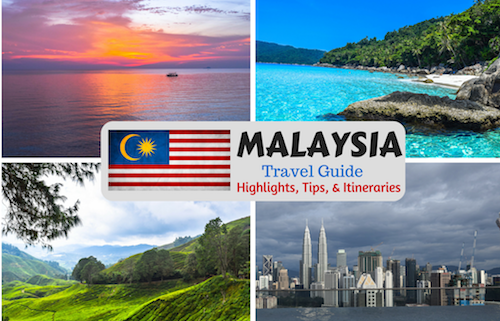
Welcome to Malaysia!
Malaysia is an amazing and diverse country that has something to offer everyone. If you’re looking for amazing food, gorgeous islands, and beautiful landscapes — Malaysia is a destination you should highly consider for your next holiday. I have traveled pretty extensively through Peninsular Malaysia, and it has grown to become one of my favorite countries in entire world! I’ve compiled this Malaysia Travel Guide as a source for people planning trips to this amazing country.
This guide will go over trip highlights, how to get around Malaysia, Malaysia itineraries, and general travel advice!
Hope you enjoy reading my Malaysia Travel Guide and favorite photos from my travels!
Note: This Malaysia Travel Guide will focus entirely on Peninsular Malaysia. I have never traveled to Sabah or Sarawak, and am not too well informed about those areas of the country.
Traveling to Malaysia soon…? I’d definitely recommend purchasing the Malaysia Lonely Planet Travel Guide ! I pretty much always travel with a LP guidebook, and it can definitely a huge asset on the road!
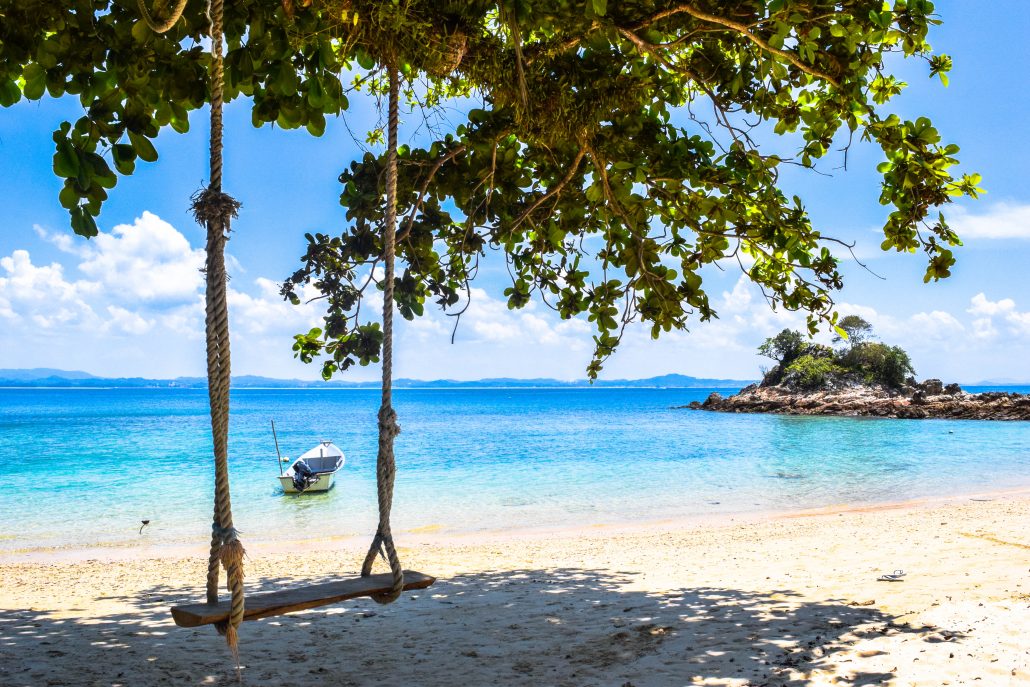
Pulau Kapas, Malaysia
Malaysia Trip Highlights
Kuala lumpur.
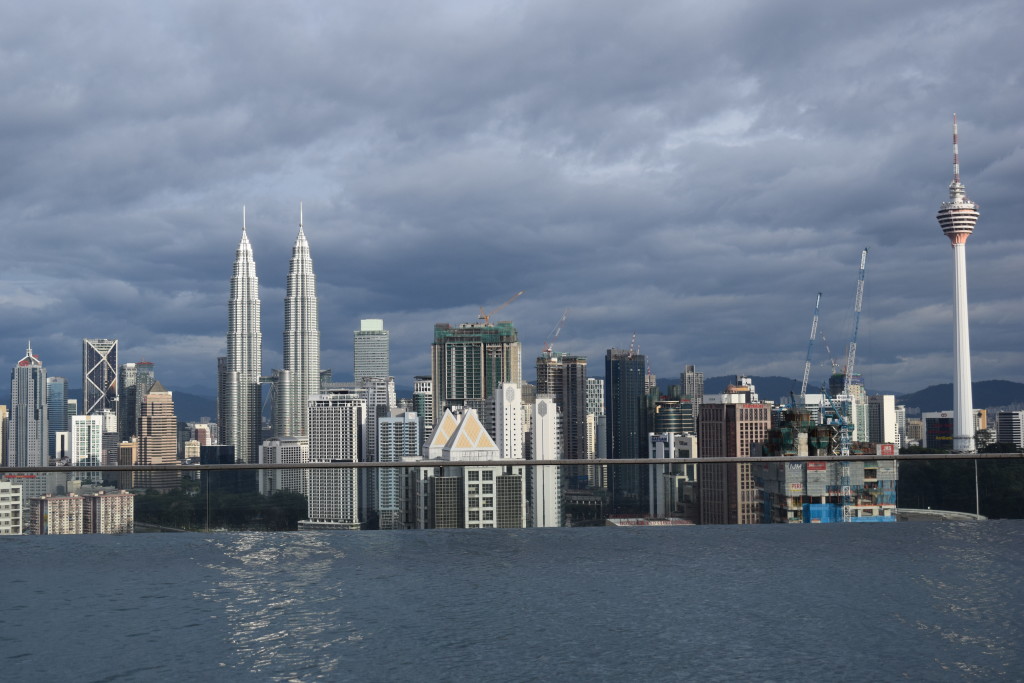
You’ll most likely be starting your Malaysian holidays in the amazing capital city — Kuala Lumpur. This is truly a special place with friendly people, beautiful sights, and delicious food (just like the rest of Malaysia). During my travels in South-East Asia , I was lucky enough to call this city home for awhile. The first time I visited Kuala Lumpur I actually didn’t enjoy the city too much, but after spending more time there I discovered how special the city really is.
Check out the following blog posts I’ve written:
- 10 Amazing Things to do in Kuala Lumpur
- Heli Lounge, Kuala Lumpur; Drinks + Sunset on a Helipad
- The Absolute Best Thing To Do in Kuala Lumpur
TOP KUALA LUMPUR TIP
Sign up for AirBNB , and stay at the REGALIA CONDOMINIUM . I used to live there, and it’s by far the best place to stay in Kuala Lumpur.
It’s luxury complex that has all the amenities you’d want, perfectly located, and has the most amazing infinity pool. There is a mall right next door with a grocery store, movie theater, and tons of other shops. Also, if you sign up for AirBNB with this link , you’ll get $38 off your first visit! Which is easily a free-nights accommodation at The Regalia! Trust me. You want to stay here!
Best Hostel in Kuala Lumpur
Reggae Mansion
Perfect location, amazing rooms, and wildly crazy rooftop parties every night! If you’re backpacking around Malaysia, than you have to stay at Reggae Mansion! This place does sell out, so check rates & availability !
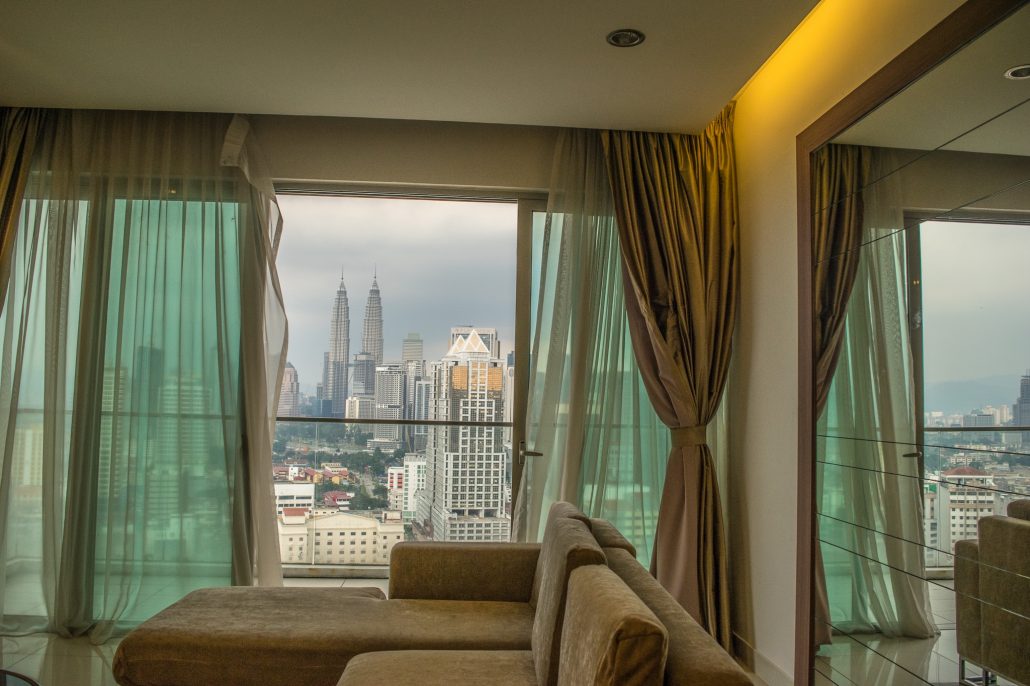
Penang is the cultural hotspot in Malaysia! You’ll fall in love with it’s busy streets, beautiful artwork, and enchanting history. Oh, and the food is absolutely amazing. Most people come to Penang only planning a few day stay, but end up staying much longer than they expected. You can spend a day on Batu Ferringi beach, hike through the National Park, and take the journey up to Penang Hill for spectacular views of the entire city.
Best things to do in Penang:
- Beach day and sunset on Batu Ferringi Beach
- Spend some time hiking through the National Park
- Take a visit to Penang Hill for spectacular views of the city
- Stroll through Georgetown and check out all the artwork
- Eat at Penang’s famous hawker stalls
Best Hostel in Penang
Ryokan Muntri Boutique Hostel : This is a recently opened hostel in Penang,and has excellent affordable rooms, very well-located in George town, and a really cool Japanese theme. It’s got terrific reviews by everyone, and you’ll love your stay here! Check rates & availability .
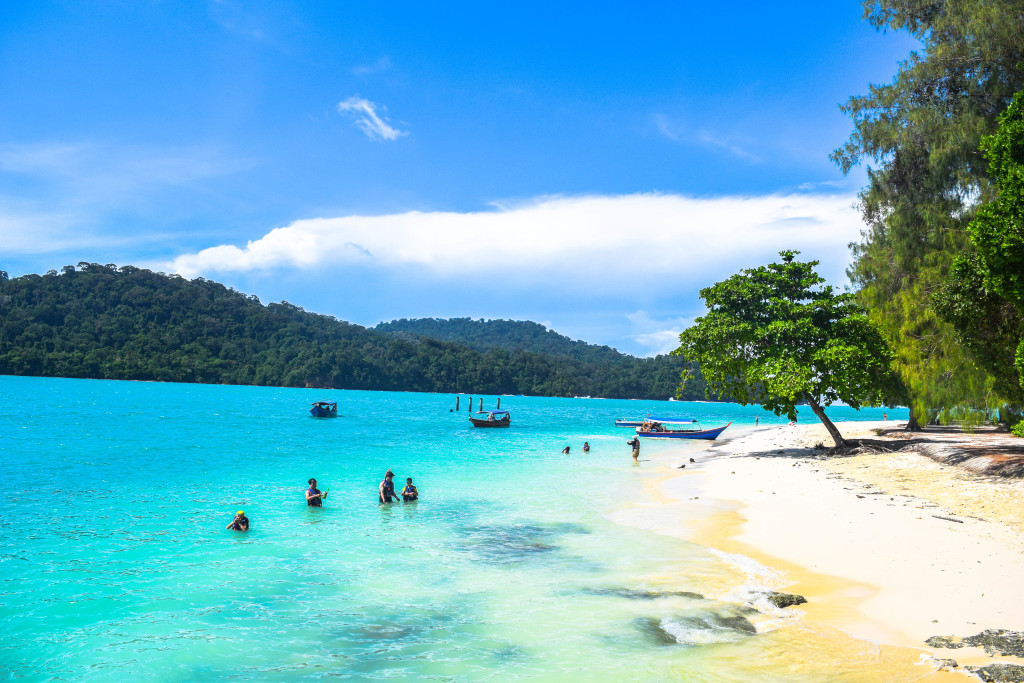
Officially known as Langkawi the Jewel of Kedah, Langkawi is an archipelago of 104 islands in the Andaman Sea, around 30 km off the mainland coast of northwestern Malaysia. It’s right at the border of Thailand, and is a popular place to visit for traveller’s going north/south between Malaysia and Thailand. It is truly an amazing island with amazing things to do, cheap accommodations, tax-free booze, and beautiful landscape.
Check out some of my blog posts on Langkawi:
- A Backpacker’s Guide to Langkawi, Malaysia
- Top 5 Reasons to Backpack Langkawi
- Berjaya Resort Crashing in Langkawi
- Chasing Waterfalls in Langkawi
Best Hostel in Langkawi
Langkawi Dormitorio :
Just footsteps away from the beach, this perfectly located hostel had comfortable rooms, great prices, and an excellent atmosphere! Langkawi Dormitorio .
Cameron Highlands
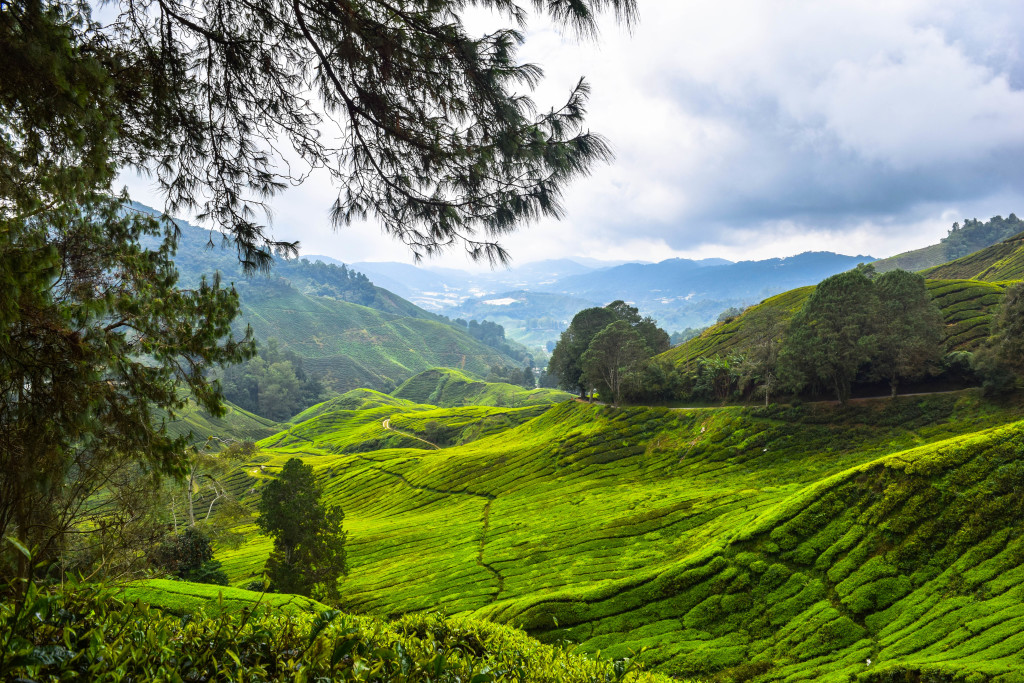
The Cameron Highlands is a stunning hill station in central peninsular Malaysia, and has become a popular destination for visitors in Malaysia. Roughly the size of Singapore, the Cameron Highlands covers a large stretch of land, and there’s tons to see, do, and explore. You’ll fall in love with the beautiful green tea plantations, and will leave you speechless when you visit the highest peak in the Cameron Highlands
For more information on the Cameron Highlands, check out the guide below!
- A Backpacker’s Guide to the Cameron Highlands
Best Hostel in The Cameron Highlands:
CH Traveler’s INN :
A newly opened hostel in the center of Tanah Rata, and simply the best place to stay on a budget for traveler’s visiting the Cameron Highlands! Check rates & availability .
Taman Negara
Teman Negara National Park is the perfect place for travelers who love wild life viewing, jungle trekking, hiking, rock climbing, fishing, camping and many more. It is well established as one of the most popular ecotourism in Malaysia. Popular activities include the canopy walk, jungle trekking, rapid shooting, cave exploration, and boat cruises.
Recommend days spent here: 1-2 days max
Check out the Teman Negara National Park website for more information
The Perhentian Islands
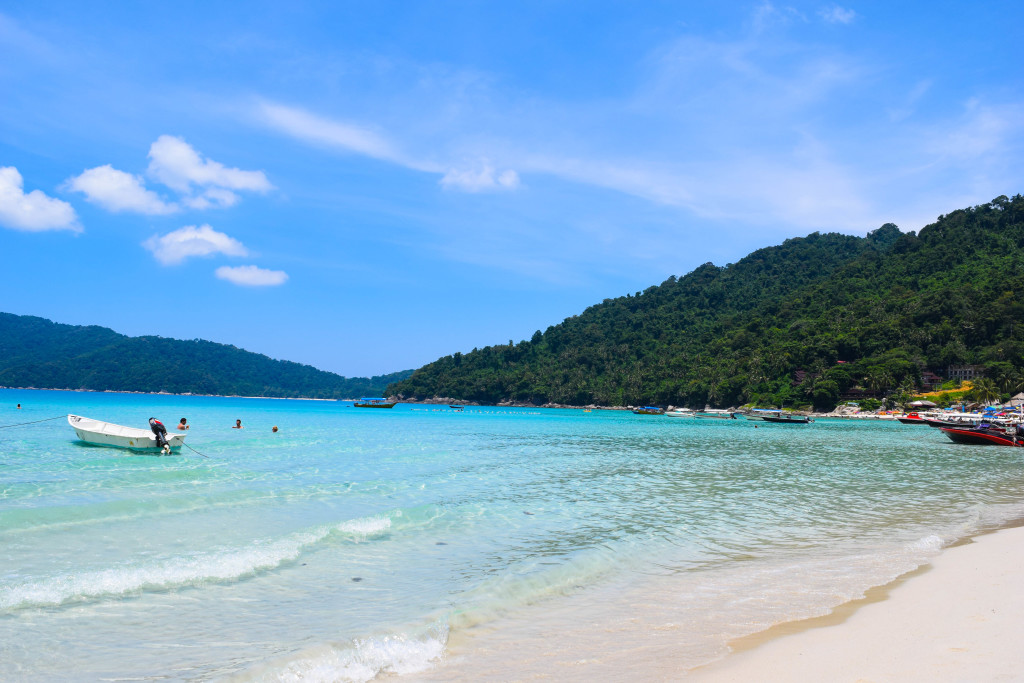
Welcome to paradise. The Perhentian Islands consist of both Perhentian Kecil & Perhentian Besar. They are both absolutely stunning, and the minute you step foot on of the two islands you’ll never want to leave. I’ve visited Perhentian Kecil on two different occasions now, and I definitely would not mind going back for a third. The beaches are gorgeous, the atmosphere is relaxing, and the nightlife can get pretty crazy.
Perhentian Kecil is more for a younger crowd. It’s much more lively at night and has an incredible fireshow. Perhentian Besar has a lot more resorts, and is a bit more family oriented.
If you’re going to Malaysia — you’d be mistaken to skip the Perhentian Islands!
Check out my blog posts on this paradise island!
- A Backpacker’s Guide to the Perhentian Islands
- The Perhentian Islands: Perfectly Picturesque (Photo Essay)
Pulau Kapas
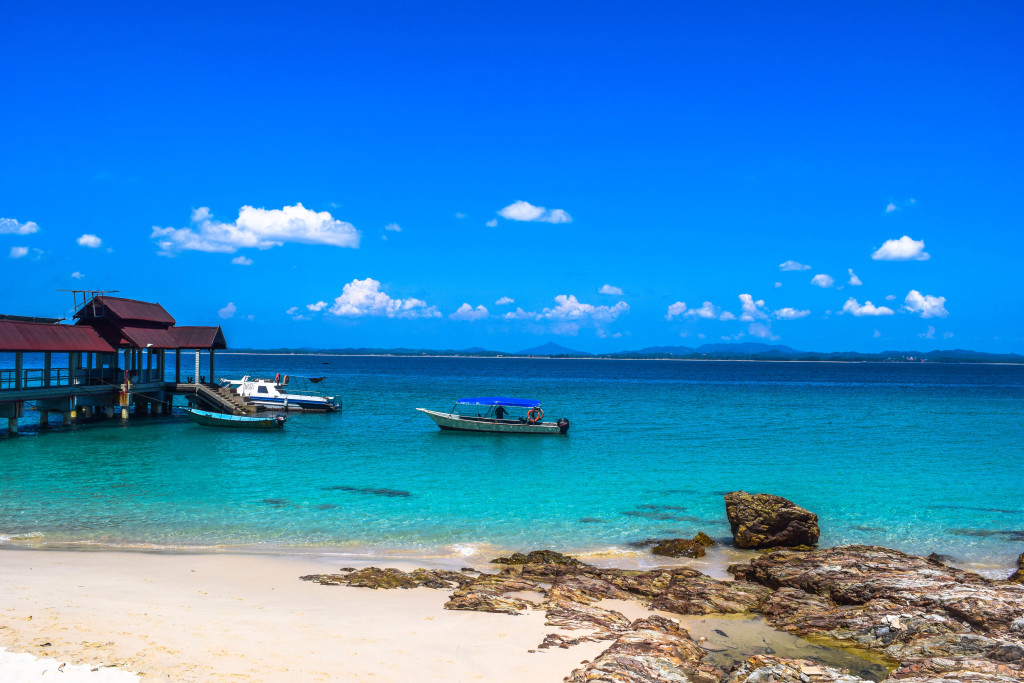
Pulau Kapas is an idyllic island escape for those looking for a bit more of a remote location. You won’t find any big crazy resorts, fast wi-fi connection, or luxury restaurants. What you will be rewarded with is amazingly beautiful water, suburb underwater life, and an extremely laidback atmosphere. Pulau Kapas is truly a Malaysian gem, and I guarantee if you go for a couple days you won’t regret it!
For more information about traveling to Pulau Kapas:
- The Ultimate Guide to Pulau Kapas, Malaysia
- Longsha Beach Camping on Pulau Kapas, Malaysia
- Pulau Kapas: The Most Beautiful Island in Malaysia (Photo Essay)
Tioman Island
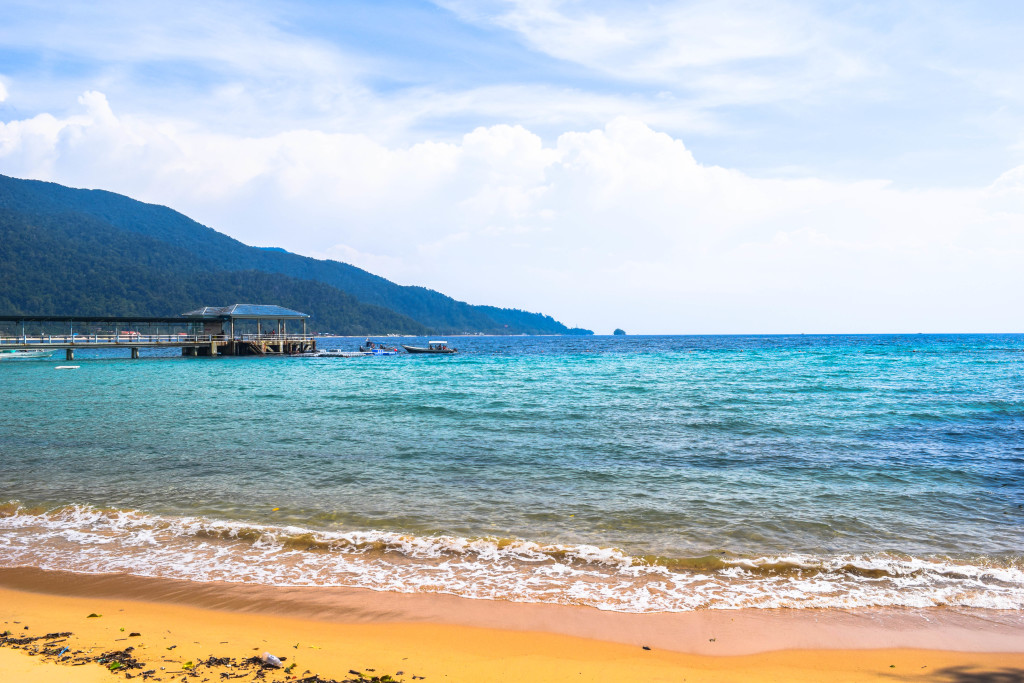
If you’ve looking for some more island action, than definitely make your way over to Tioman Island. It isn’t as gorgeous as the Perhentians or Kapas, but it has some of the best scuba-diving sites in the whole country. The island is pretty massive, and is a 2-hour ferry ride from the mainland. It is a DUTY-FREE island, which makes drinking on this island pretty cheap! It’s a popular destination for weekend trips from Singapore and Kuala Lumpur, so book in advance if you plan on being there on a Saturday & Sunday. If you do plan on going, I’d definitely recommend staying on ABC Beach.
When I was there, I happened to catch really bad weather, and had some transportation issues. I still had a great trip. Read about it below:
- A Weekend Trip to Tioman Island
Melaka is just a short bus ride away from Kuala Lumpur, and can be a great place to spend one night. It’s small enough to walk around, explore, and try some delicious food. There’s not a whole lot to see here, but it’s definitely worth the visit.
To plan your visit, check out this post titled:
- Top 15 Places To See in Melaka
Getting Around Malaysia
The Malaysian transportation is some of the best I’ve found in all of South-East Asia. Prices are relatively low, there’s tons of options, and they are all relatively comfortable.
Flights / Airfare
Malaysia is actually a really easy country to book extremely cheap domestic flights.
- Malindo Air
If you know your exact dates, you can actually get great flight deals. Malindo Air is really great and includes 1 20kh checked bag. These are particularly useful for flights to/from Kuala Lumpur.
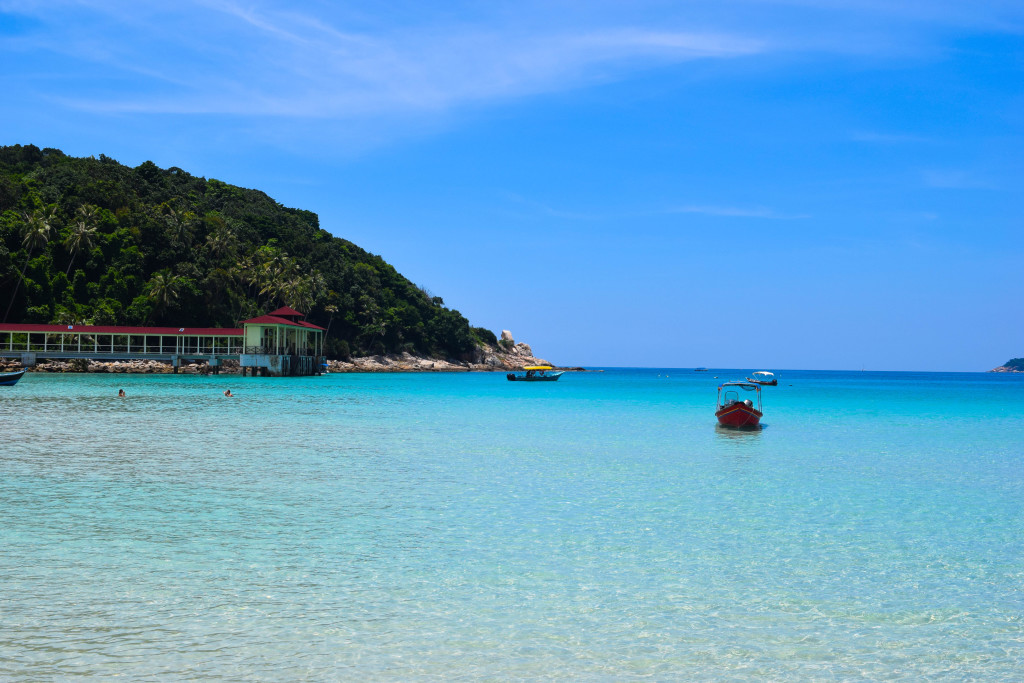
Perhentian Islands
Traveling around Malaysia on the bus transport is actually really easy, budget friendly, and comfortable. There are loads of different companies that offer a ton of different routes. None of the journeys take that long, and the busses can actually be really nice. For bus schedules, routes, and fares, check out the website below. I’ve booked online tickets with them, and made the process extremely easy. You can just show the email confirmation at the bus station, and receive your ticket.
- EasyBook.com
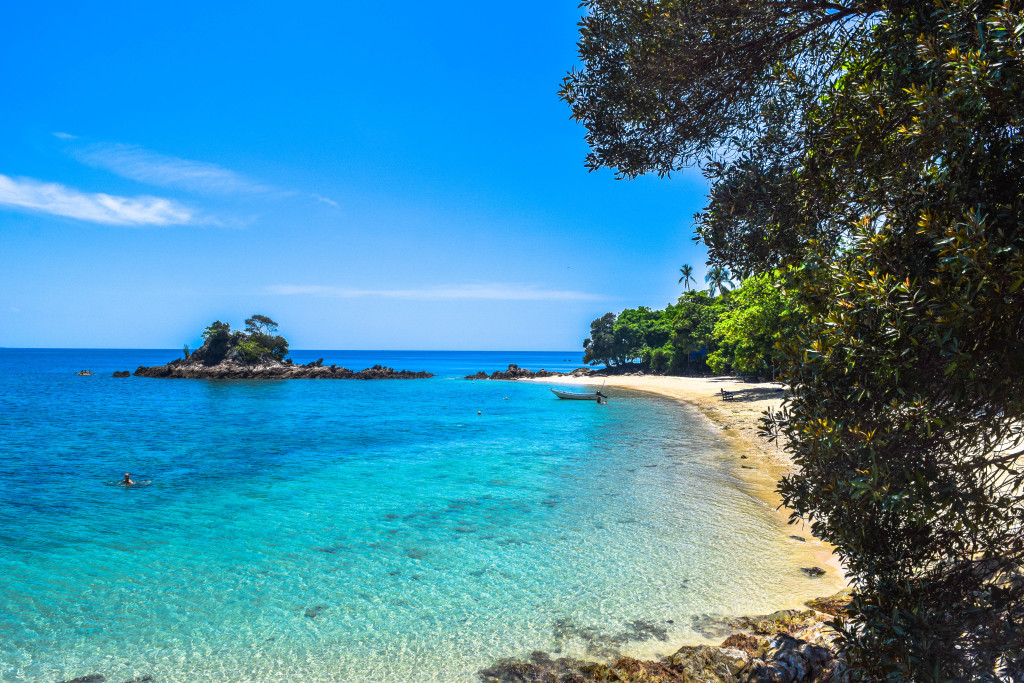
- Hitchhiking in Malaysia
Just like in any destination, you should be careful when hitching a ride alone. With that being said, Hitchhiking in Malaysia can be done, and it’s actually not too difficult. I met these Spanish girls on Pulau Kapas who found a ride all the way from Teman Negara – Kuala Terranganu. It’s not that it saves a ton of money, but it’s a great way to meet some local people, and have a unique travel experience. For more information on Hitchhiking in Malaysia check the website below:
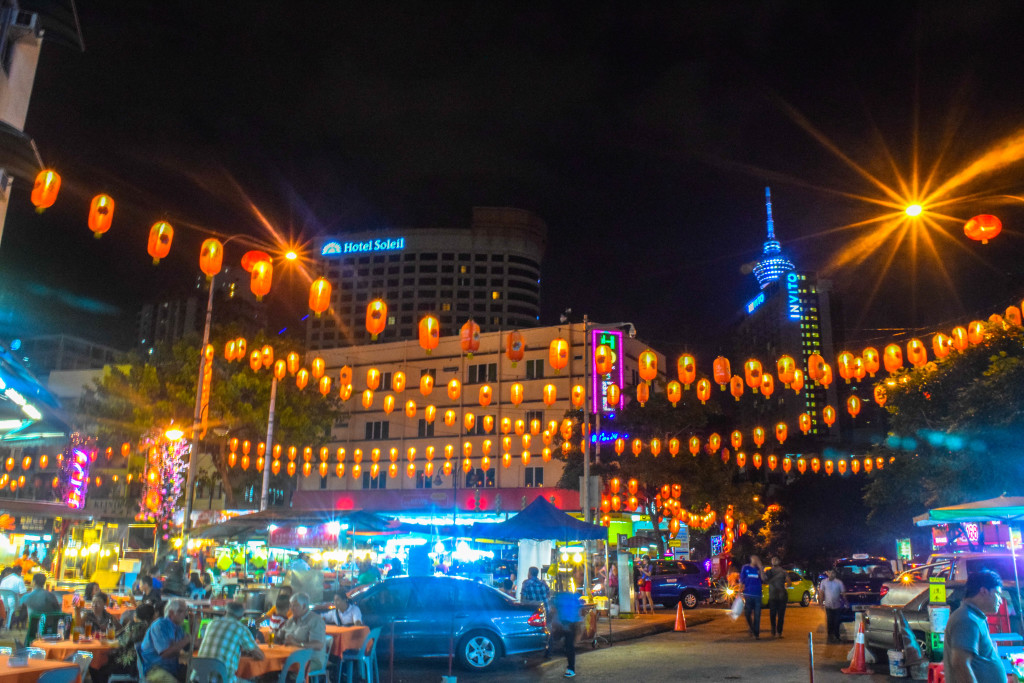
Jalan Alor in Kuala Lumpur
- Trains in Malaysia
I’ve actually never taken a train in Malaysia, but I have heard that the system works out. I almost boarded a train from Penang – Kuala Lumpur, but ended up extending my stay in Penang, and finding a flight that was cheaper than the train! I honestly think that dealing with trains on other routes would just get complicated, so I’d just personally recommend Flights and Busses over taking trains in Malaysia.
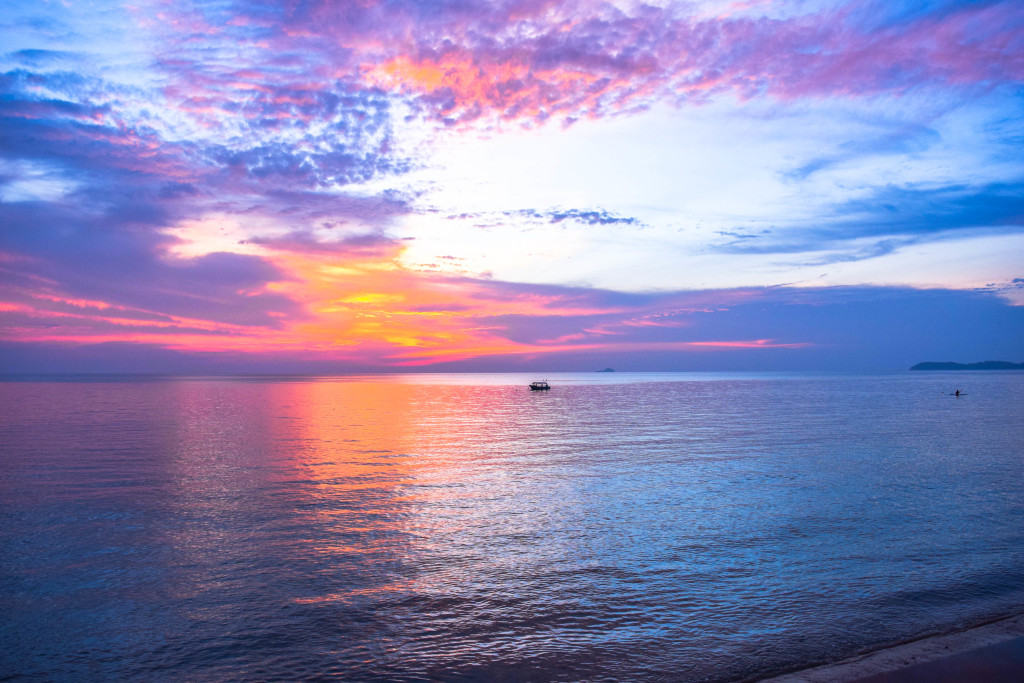
Sunset on Tioman Island
Renting A Car
I’ve never rented a car and explored Malaysia on my own (mainly because I’m a solo budget traveler), but I have had some friends rent a van and go on weekend trips from Kuala Lumpur. It’s definitely not the best option for everyone,
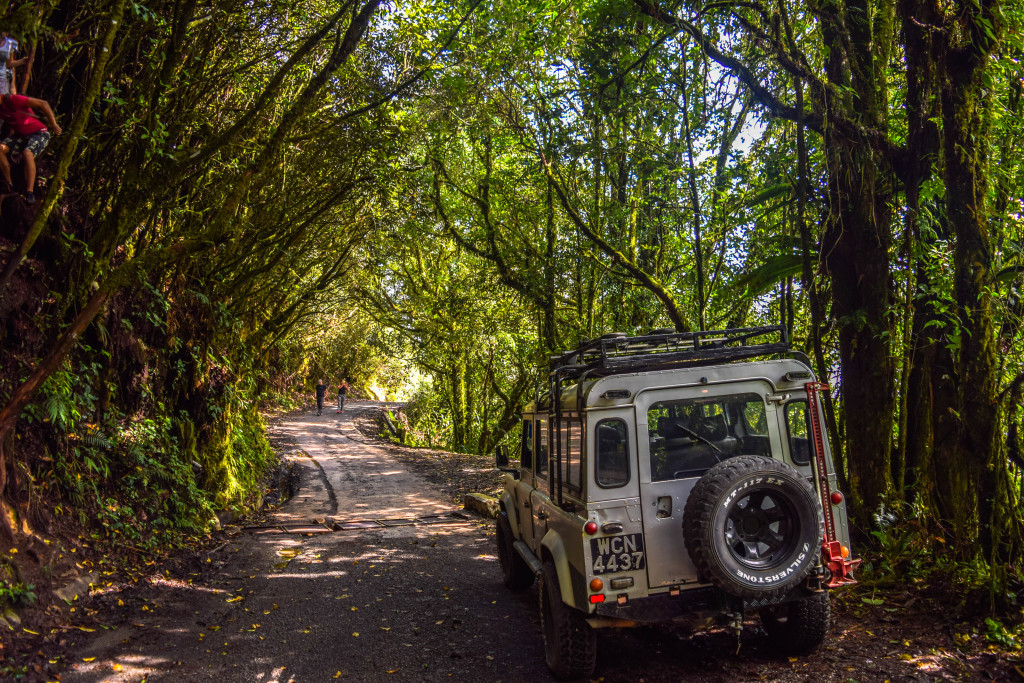
Jeep Excursions in the Cameron Highlands
Malaysia Trip Itineraries
If you look at each of these locations on a map, you can see that it actually fits pretty well
One Week Malaysia Itinerary
If you are only in Malaysia for a brief visit, than you want to enjoy your holiday. My advice would be to enjoy 2-3 days in Kuala Lumpur, and fly to either Penang for 3-4 days. You don’t want to rush around each destination, because you will want enough time to enjoy each place and do all the activities.
Two Week Malaysia Itinerary
Days 1-3 — Kuala Lumpur
Take a morning bus to Teman Negara
Days 4-5 — Teman Negara
Book the early bus ticket to the Cameron Highlands
Days 6-7 — Exploring the Cameron Highlands
Book the early departure bus to Penang
Days 8-10 — Penang
Catch the two hour ferry to Langkawi
Days 11-13 — Langkawi
Catch a domestic flight from Langkawi to Kuala Lumpur
Day 14 // End of Trip — Kuala Lumpur for your outgoing flight..
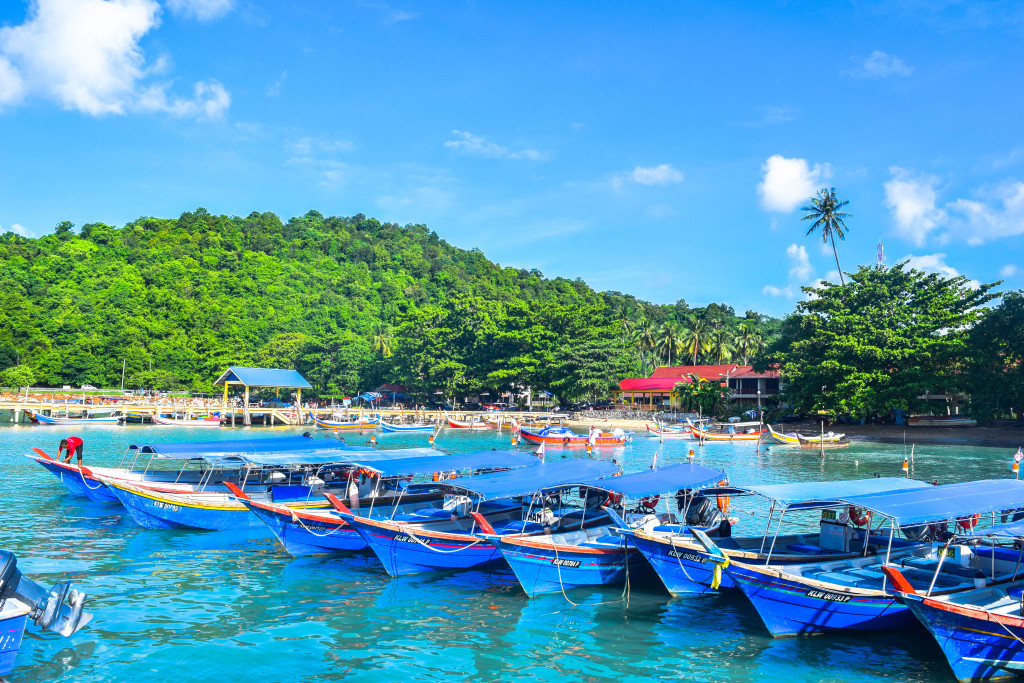
Island Hopping Boats in Langkawi
Three Week Malaysia Itinerary
Book transportation to Marang Jetty for access to Pulau Kapas (Close to Kuala Terranganu)
Days 8-10 — Pulau Kapas & Gem Island
Book early morning boat back to mainland, and get to main bus station. Book transport to Perhentian Islands
Days 11-15 — The Perhentians Islands
Book Domestic Flight from Kuala Terrananu Airport – Penang. Cheap fares available if booked in advanced.
Days 16-17 – Penang
Days 18-20 — Langkawi
Day 21 // End of Trip — Kuala Lumpur for your outgoing flight..
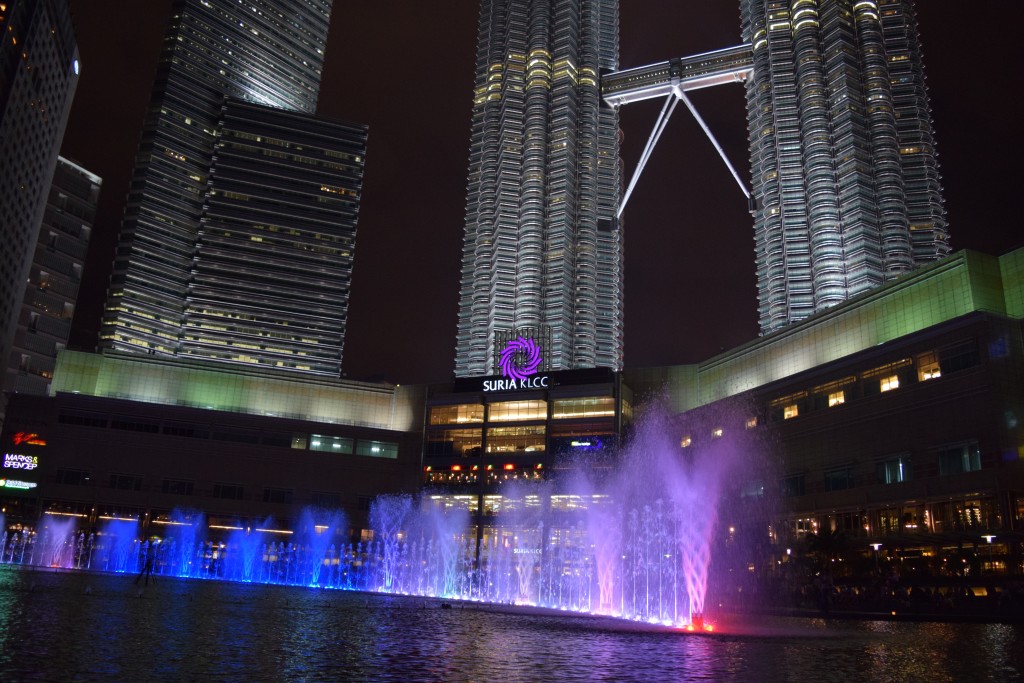
Water & Lights show at KLCC
One Month in Malaysia Itinerary
If you have a full month in Malaysia, I honestly would just recommend to follow the 3-week itinerary, but travel slower. This will also allow flexibility with the domestic flights, and also spending less time on travel. I would also recommend staying in Kuala Lumpur for an extra couple days, and doing a one-day trip to Melaka. If you want to see it all, you can switch up this itinerary to add Pulau Tioman, but I would honestly skip it. I found it to be really touristy, difficult to get to, and there are much better islands and beaches in Malaysia.
If you have even more time in Malaysia, look out for cheap domestic flights over to Borneo. You could scuba-dive off the coasts of the world famous Sipadan island, or hike the highest peak in Malaysia — Mt. Kinabalu!
General Malaysia Travel Advice
Eat as much as you possibly can! The food in Malaysia is absolutely incredible. When you get to Kuala Lumpur, check out a Nasi Kandar and try the various curries, Roti Canai, and Nasi Lemak!
Interact with the locals! Malaysian people are extremely friendly, and generally speak really great English! They are very open and welcome to tourism, and can be a great experience.
Understand you are in a Muslim country! Be respectful with your clothing!
Get a local SIM card! Malaysia has a wide variety of phone plans, and it will come in handy to have 3G / 4G internet when your traveling. I’d recommend Tune Talk. There are great prices and deals, and it’s good coverage.
Download my Free E-Book — 77 Amazing, Helpful, Money-Saving Tips for Backpacking South-East Asia . This goes over a ton of valuable information for Malaysia!
If you haven’t figured it out by reading this post, I have traveled pretty extensively throughout Malaysia. I think it’s an amazing country, and am always thinking about going soon and exploring different parts. I’m actually dying to get over to Borneo, but I’m sure that time will come eventually.
If you’re ever planning a trip to Malaysia, feel free to Contact Me with any questions!
Thanks for reading!
Share the Malaysian Love!
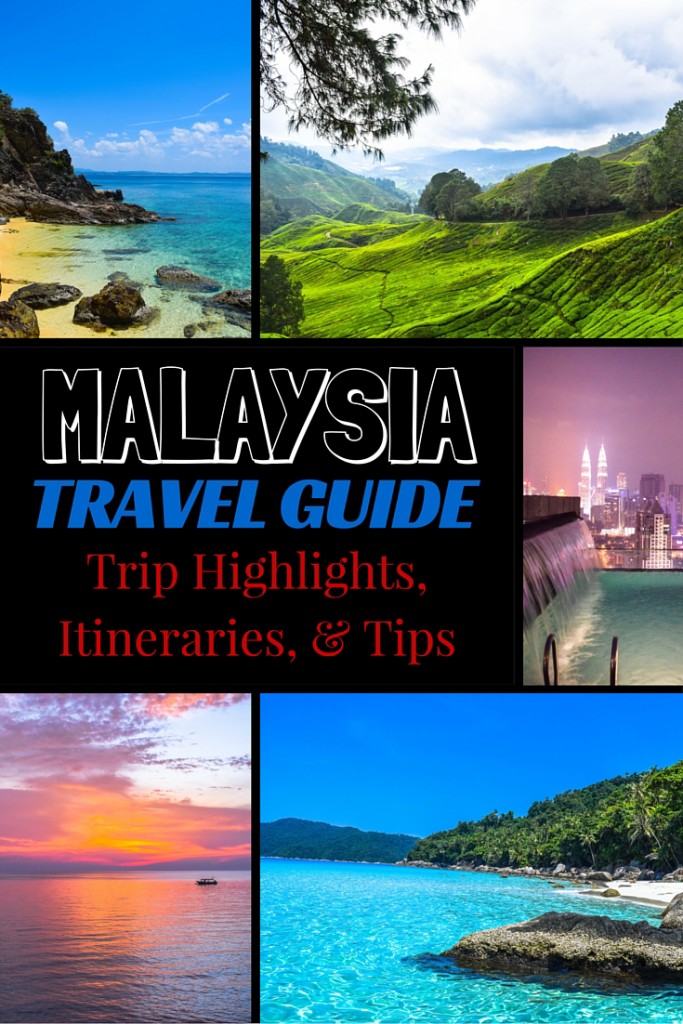
What a great resource! Malaysia is toward the top of my travel list…hopefully I’ll have the time to do the 3 or 4-week itinerary!
Thanks for the great info!
Glad you like it Sarah! :) When you do go to Malaysia, I guarantee you’ll love it! It’s such an amazing country, and so much fun to travel around! Enjoy!
Glad I could help out man! It really is an amazing country! I can’t wait to get back and explore even more.
Thanks for the information. It is really helpful. I am planing to go to Malaysia next month but i only have a week. Perhentian islans sounds like an amaizing place. I am between going there or visit Bali. What do you reckon? Thanks
Regards Gara
Hmm. Bali or Perhentian? Tough Decision. TO be honest, I’d probably choose Bali because you can do a whole lot more in one week. Bali is kinda small, but packed with stuff to do. Perhentian is more of a chill-out, diving destination. Let me know if you have any other questions.
Hello, I am crazy about looking for amazing food, gorgeous islands, and beautiful landscapes ans Malaysia is my dream destination. your blog has very rich content which includes numerous photographs of spots, Island, culture..and many more. Nicely organized and detailed blog.
Thanks so much Jesse! Awesome to hear my site is helping you out! :-)
Hey thanks man for giving this list.I will go Malaysia with my friends in next years.But i don’t know which place to start travel.But after read this i got a brief idea.I will go for 15 days tour.Hope you list will fulfill my journey.Can you give me a list of affordable hotels of Malaysia?
Hey Tina, I normally stayed in hostels because I was a super budget traveler in Asia, lol. I’d just check booking.com and read reviews and everything. :-)
Hi if u wanna come to malaysia and need me to guide you just whatsapp me – +601129293631 or dm me on instagram @hakimzakaria98
What an awesome blog! I’m heading to KL tomorrow from Sebah, I only have a week and at abit of a loss with figuring out what i can squeeze in and what not to miss. This is really helpful, so much info all in one place.
Thankyou! :)
So happy to help! Enjoy Malaysia! :-)
Hi! I’m Thien from Vietnam. I was in Malaysia a couple of years ago. Your sharing strongly reminds me of my traveling experiences when in Malay. Thanks greatly for that!
Would you like to try out some wonderful places in Vietnam? Check out this Things to do in Vietnam for various useful suggestions.
Hope that you can visit and explore our country one day.
Wow! Nice post! I love KUALA LUMPUR in Malaysia. It is my favorite place! Me and my Keymalaysia team already visited there!
Been in love with Malaysia ever since our first visit. Their beaches and rich culture is outstanding! Definitely coming back soon. So many more islands and sites to explore. Such a detailed and informative post you have! Kudos!
Hey, this blog is so helpful!!
We’ve got 2 weeks in Malaysia, we’d like to go to Penang, Langkawi, Perhentian Kecil, Pulau Kapas and of course Kuala Lumpur which we fly in and out of. Could you give me any info on how to get from each place please?
Any advice would be great thankyou!
Do u have a travel agency ? or just a traveler ?
Nice Malaysia Travel post author. Thank you. Keep it up.
Nice post author.Thank you.
I adore Malaysia – the beaches, food, street art and culture is the best, not to mention the scuba diving! Your guide has inspired me to return when I can, thanks Jones!
Thanks so much for this! Very useful guide
Trackbacks & Pingbacks
[…] Check out this Malaysia Travel Guide to help you plan your […]
[…] ex-pat community, surprisingly great nightlife, and excellent travel options from KLIA Airport. Traveling Malaysia is one of my best memories while in South-East Asia, and I’m definitely planning on moving […]
[…] If you’re visiting Malaysia, here are some Malaysia travel tips! […]
[…] I would not necessarily read about in guide books or find on other blogs. As of now, I am using Jones’ Malaysia Travel Guide as a rough source. I hope to spend about three to four weeks here later this year so there’s […]
[…] Malaysia Travel Guide: Trip Highlights, Destinations, & Itineraries […]
Leave a Reply
Leave a reply cancel reply.
Your email address will not be published. Required fields are marked *
Save my name, email, and website in this browser for the next time I comment.
Photography Gear
Work With Me
Privacy Policy
Destinations
Music Festivals
Travel Itineraries
Inspiration
Travel Gifts
Southeast Asia

Malaysia Travel Guide
Your ultimate malaysia travel guide, with tips, and things to see and things to do in malaysia. great for first-time and returning travelers..
Malaysia is like two countries in one, cut in half by the South China Sea.
Influenced by China and India, the multicultural peninsula is a zenith of culture with dynamic urban metropolises while Borneo is where travelers go for respite on one of the many turquoise beaches or to explore its vast and ancient jungles.
This Malaysia travel guide will help you plan your next vacation.
Popular City Guides
- Hawker Stalls
- Great Things to do in Borneo – Malaysia’s Wild Jungle Island
Our Highlight
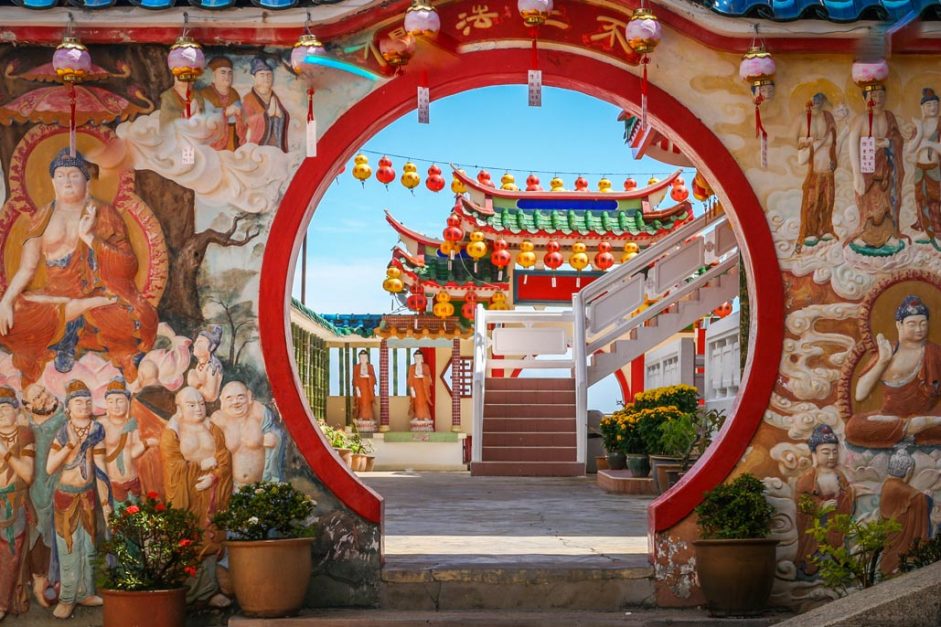
Table of contents
Table of Contents
Fast Facts about Malaysia
- Malaysia power voltage is 230/240 V 50 Hz; Power sockets G.
- The Malaysian currency is the Malaysian Ringett (MYR) and is around 4 MYR to 1 USD.
- Malaysia is a multicultural but predominantly Islamic country.
- Water is generally safe to drink water straight from the tap. Bottled mineral water, however, is easily available in shops and supermarkets.
- For five consecutive years, Malaysia has won the coveted Guinness League of Excellence Award and bragging rights for brewing some of the best Guinness in the world.
- Visiting during Ramadan is not a problem as visitors and non-Muslim Malaysians aren’t expected to abstain from eating, drinking or smoking in public during the month of fasting.
- Malaysia has one of the highest rates of biodiversity in the world, said to host some 20% of the world’s animal species. The Taman Negara in Malaysia is over 130 million years old and is considered the oldest forest in the
Things to See and Do in Malaysia
- Hike Mount Kinabalu – This 4095 metre mammoth is a 2-hour bus ride from Kota Kinabalu, the capital of Sabah, Malaysian Borneo’s northern province.
- Trek the Pinnacles of Gunung Mulu – a stone forest of white and grey limestone, jutting 45 metres out of the earth in razor sharp formations.
- Go on a Jungle Safari – Take a boat up the The Sungai (river) Kinabatangan right into the heart of the jungle of Borneo, and stay in a rustic camp for a few days with Uncle Tan Wildlife Adventures .
- Attend the Thaipusam Fesitval – It is the most fascinating festival you will ever witness. Thaipusam is a Hindu festival that happens every January or February.
- Take Cooking Lessons – Learn about the rich Malaysian cuisine by taking cooking classes for a short time during your stay.
- Visit Sarawak Cultural Village – This is the home of Malaysian culture where you can learn about the art, music and culture of the people.
- Explore Kuala Lumpur – Malaysia’s intrinsic colourful contrasts climax in spectacular Kuala Lumpur.
- Enjoy Tea Time in Cameron Highlands – When travelling to Malaysia, one normally doesn’t think of tea plantations and mountain chalets. But when visiting the Cameron Highlands in the country’s interior, that is exactly what you will find.
Accommodation
Budget – Budget hotels in Malaysia start from about 4 USD per night, which is very affordable. Some of these hotels provide free Wi-Fi and free parking spaces.
Mid Range – In Malaysia, hotels in this category cost about 12 USD per night on average. Rooms here are fitted with air conditioners and water heaters. Some hotels also provide free Wi-Fi.
High End – Hotels here have modern rooms and suites fitted with kitchenettes. There are also gyms, indoor or outdoor pools, dining, free Wi-Fi, and in some cases, free shuttle or chauffeur services. Rooms cost 100 USD and above per night.
Check out our favorite booking platforms Booking.com , Tripadvisor and VRBO for the best deals on accommodation in Malaysia.
Nasi Lemak – Nasi Lemak, which is the traditional dish of Malaysia, is coconut rice cooked with pandan leaf and topped with chili sauce or other Malaysian curries.
Ikan Bakar – This is marinated grilled fish or seafood, spiced with chili sauce, wrapped in banana leaves, and prepared over charcoal.
Nasi Kandar – With influence from India, this dish consists of steamed rice, Indian style curries, and a variety of protein options.
Char Kuay Teow – This is a stir fry noodle dish known for its unique smoky taste and accompanied with seafood and protein of your choice.
Bak Kut Teh – Bak Kut Teh is a Malaysian broth-based delicacy consisting of pork ribs, spices, and herbs that are slow-cooked until they are tender.
The Best Ways to Get Around Malaysia
Getting to maylasia:.
Flights: Malaysia has airports in major cities like Kuala Lumpur, Kuching, and Penang. You can get direct flights to Malaysia from the United Kingdom, India, and Taiwan, to name a few.
You can check for the best flights to Malaysia on Skyscanner .
Transportation:
Buses : Buses are common in Malaysia, and fares cost around 4 USD.
Taxis / Uber : There are affordable and safe taxi services in Malaysia. Most taxis are metered but cost about 1 USD and above depending on the distance. Uber is no longer available in Malaysia, but there are substitutes like Grab and Easy Taxi.
Car Rental: Car rental services are available in Malaysia. Depending on the rental company, you may spend about 45 USD a day.
You can also compare prices here .
When to go To Malaysia
The weather in Malaysia is always warm and humid, which makes it easy to visit at any time of the year. However, there is an important point that should be noted. The east coast and west coast have different rainy seasons.
For the former, it starts around November till mid-February and is quite intense. The west coast has a more toned down rainy season, which begins in April and ends in October.
Where to Stay in Malaysia
MOV Hotel – If you plan to visit Kuala Lumpur, this hotel has western breakfast options, free Wi-Fi, a gym, swimming pool, and other attractions.
The Waterfront Hotel Kuching – Located in Kuching, this hotel offers free Wi-Fi, free parking, airport shuttle and an indoor pool.
Eastern & Oriental Hotel – This hotel in Penang has a golf course, fitness, spa and wellness centers. They also offer free Wi-Fi, free parking, and complimentary breakfast.
What to Pack for Malaysia
Malaysia is hot and humid with a typically tropical climate . Average temperatures lie between 21 C and 32 C. Humidity is high. Rain tends to occur between November to February on the east coast of Peninsular Malaysia, on western Sarawak, and north-eastern Sabah.
On the west coast of Peninsular Malaysia, the rainy season is April to May and October to November.
- Dress conservatively. Malaysia is a Muslim country, as a result women should be dressed conservatively (long pants, shirts with arms and shoulders covered) while men are recommended to keep their shoulders and legs covered. Many religious sites forbid shorts and sleeveless shirts for both sexes, so a light scarf is handy to wrap around the shoulders. Swimsuits are ok to wear at the beach or pool, but make sure to cover up before walking anywhere else.
- The protection basics – Travellers should stock up on the essentials: sun block, mosquito/insect repellant containing DEET or a pyrethroid insecticide, sunglasses and a hat.
- Pack for Humidity – for humid weather it is best to pack fabrics that breathe as much as possible and natural fabrics, like cotton, linen or rayon (avoiding silk, wool and polyester). Clothing should be loose and comfortable to encourage the flow of air and allow moisture to evaporate. Think: cool yet conservative
- Sarongs – From protecting yourself from the hot island sun, covering up at religious sites or keeping warm on a cool night, sarongs are a must-have.
See our packing tips: packing tips
Malaysia Travel Guide: Best Booking Resources
Whenever we travel to we make sure to start with these companies. We have tried a lot of different ones over the years and all of these have consistently proven to be the best when it comes to offering great prices.
We have used every one of these personally and continue to do so.
- Booking.com : This is our go site to when comparing prices for accommodation. It usually has the cheapest prices, especially in Europe and we love their interface. Not to mention you get free cancellation and you are guaranteed the best price.
- Trip Advisor : What we like about Trip Advisor is that we can look at all the reviews and then book our accommodation. TripAdvisor is where we go when we want to compare prices with multiple accommodation providers.
- VRBO : is the main search engine we use when we are looking for a home or apartment rental. It can sometimes be cheaper than hotels and it is the best way to stay in areas that offer a more local feel.
- Hostelworld : With one of the largest databases of hostels in the world, Hostelworld is the go-to site when you are looking for budget accommodation.
- Skyscanner : This is the first place we check for flights. It consistently comes back with the cheapest and best options. It allows us to compare a lot of airlines to get the best price.
- Rome 2 Rio : If you want to see how to get somewhere by plane, train, bus, ferry or car Rome2Rio lays it all out for you as well as related costs.I love how they show it all to you on a Google Map and it works offline.
- Get Your Guide: For all your day trip and city guide needs, we use Get Your Guide. It has the world’s largest collection of things to do with more than 30,000 activities in 7500 destinations.
- World Nomads Insurance: When traveling to Italy you should always have travel insurance. We have found the best bang for your buck is by far World Nomads.
Malaysia Travel Guide: Related Articles
To browse all our articles and guides about Malaysia click here.
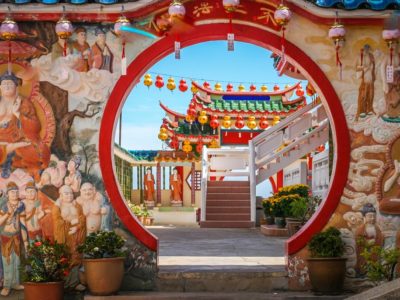
16 Best Things To Do In Penang, Malaysia
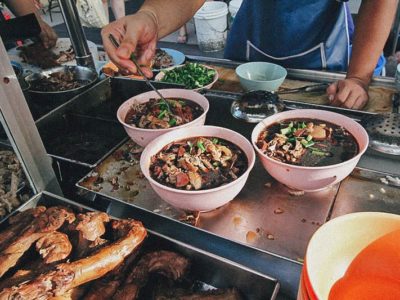
7 Legendary Hawker Stalls in Penang, Malaysia
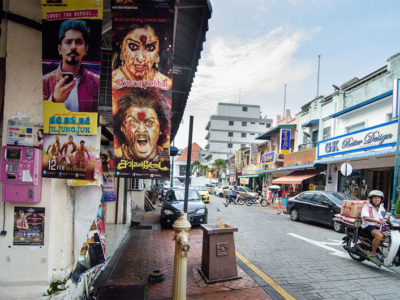
Photowalking the Streets of Georgetown, Penang

MALAYSIA TRAVEL GUIDE AND THINGS TO DO
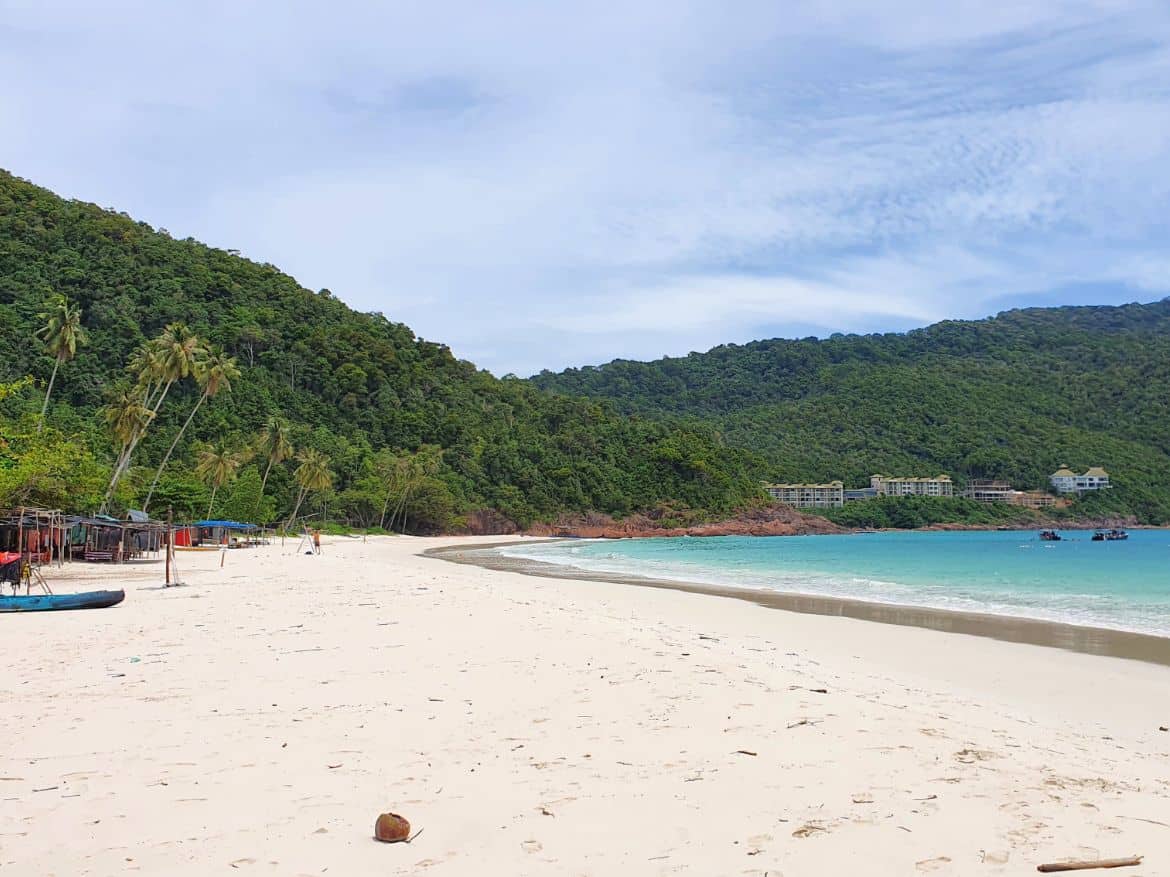
Malaysia is a diverse and vibrant country located in Southeast Asia, known for its rich cultural heritage, tropical landscapes , beautiful beaches and delicious cuisine .
This guide will help you plan the perfect trip to Malaysia by showing you the top attractions and things to do , best beaches & places to visit including maps , photos and itinerary .
INTRODUCTION TO MALAYSIA
Why visit MALAYSIA ?
Malaysia is known for its stunning natural landscapes , including tropical rainforests , beautiful beaches , and lush highlands .
Popular destinations include Langkawi, Penang, Cameron Highlands, and Taman Negara National Park . Also, Malacca and George Town , historic cities with colonial architecture, are UNESCO World Heritage Sites .
Kuala Lumpur is the capital city of Malaysia and is known for its modern skyline, cultural attractions and vibrant street life.
Langkawi, Tioman , and Perhentian Island s offer pristine beaches, crystal-clear waters, and opportunities for water sports and relaxation.
Malaysia is home to diverse wildlife, including orangutans, tigers, and various species of birds. Borneo , in particular, is known for its rainforest and unique wildlife.
Malaysia is divided into two regions: Peninsular Malaysia (West Malaysia) and Borneo ( East Malaysia), separated by the South China Sea.
The country is renowned for its cultural diversity , with a mix of Malay, Chinese, Indian , and indigenous influences. It is home to various religious communities, including Islam, Buddhism, Hinduism , and Christianity.
Malaysia is also known for its delicious cuisine , especially street food, offering a diverse range of flavours with a mix of Malay , Chinese and Indian influences.
It is also a great destination for outdoor activities , including trekking in the rainforest, island hopping, snorkelling and scuba diving.
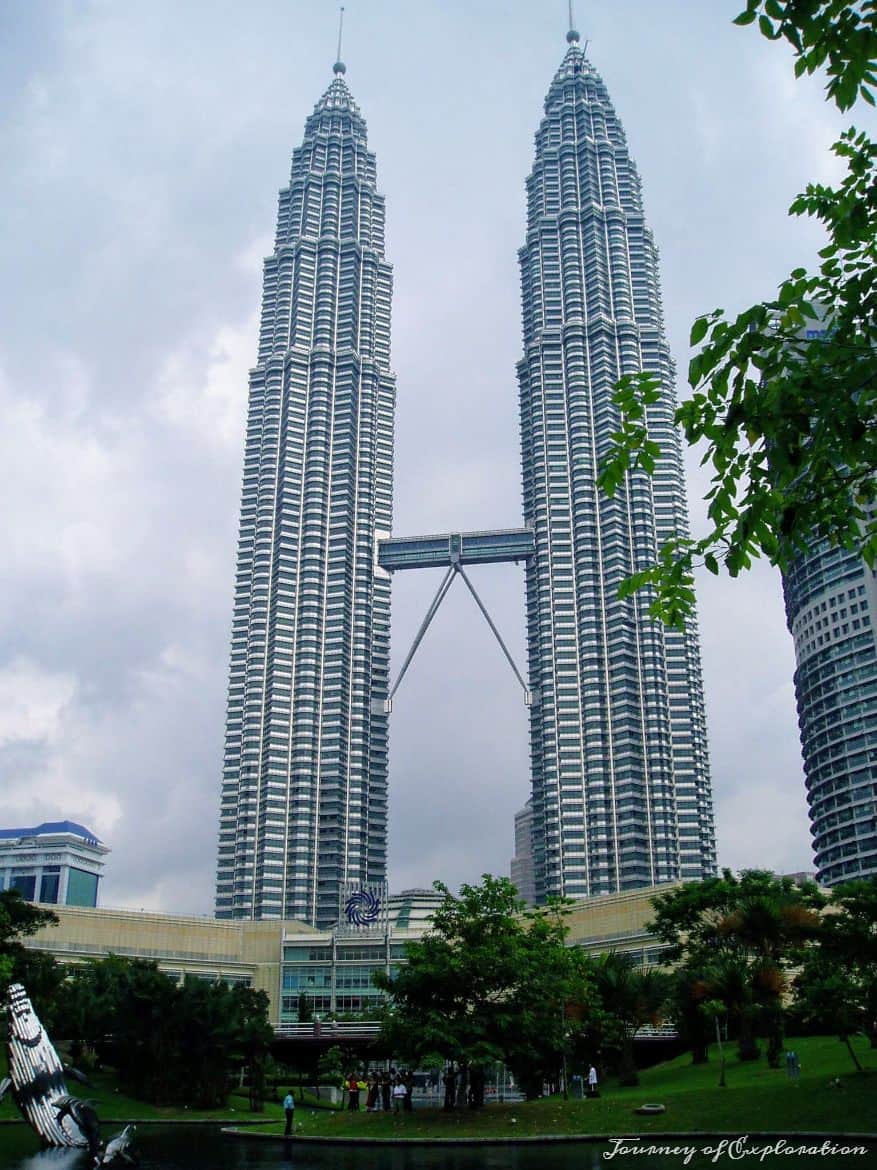
BEST TIME TO VISIT MALAYSIA
The best time to visit Malaysia depends on the specific regions you plan to explore, as the country experiences two monsoon seasons, affecting different parts of the country. Malaysia has a tropical climate , characterized by high temperatures and humidity throughout the year. Here’s a general guide:
- The west coast, including Kuala Lumpur and Penang, experiences its main rainy season from April to October.
- The dry season is from November to March, making it an ideal time to visit. December to February is considered the peak tourist season.
- The east coast experiences its main monsoon season from November to March, bringing heavy rainfall and rough seas.
- The dry season is from April to October, making this period the best time to visit the east coast.
- Borneo has a relatively consistent climate throughout the year but experiences higher rainfall from November to March.
- The drier period from April to September is a good time to visit, especially for activities like trekking and wildlife spotting.
In summary, the best time to visit Malaysia , considering both the west and east coasts will be from May to September for the sunnier weather, but preferably the months of May, June or September due to the lower prices and crowds.
Weather can be unpredictable at any time of year; rain and cloudy skies are common even in the dry season. High temperatures are more or less constant throughout the year and the sea is warm all year round. Malaysia experiences higher humidity levels, so be prepared for warm and humid weather.
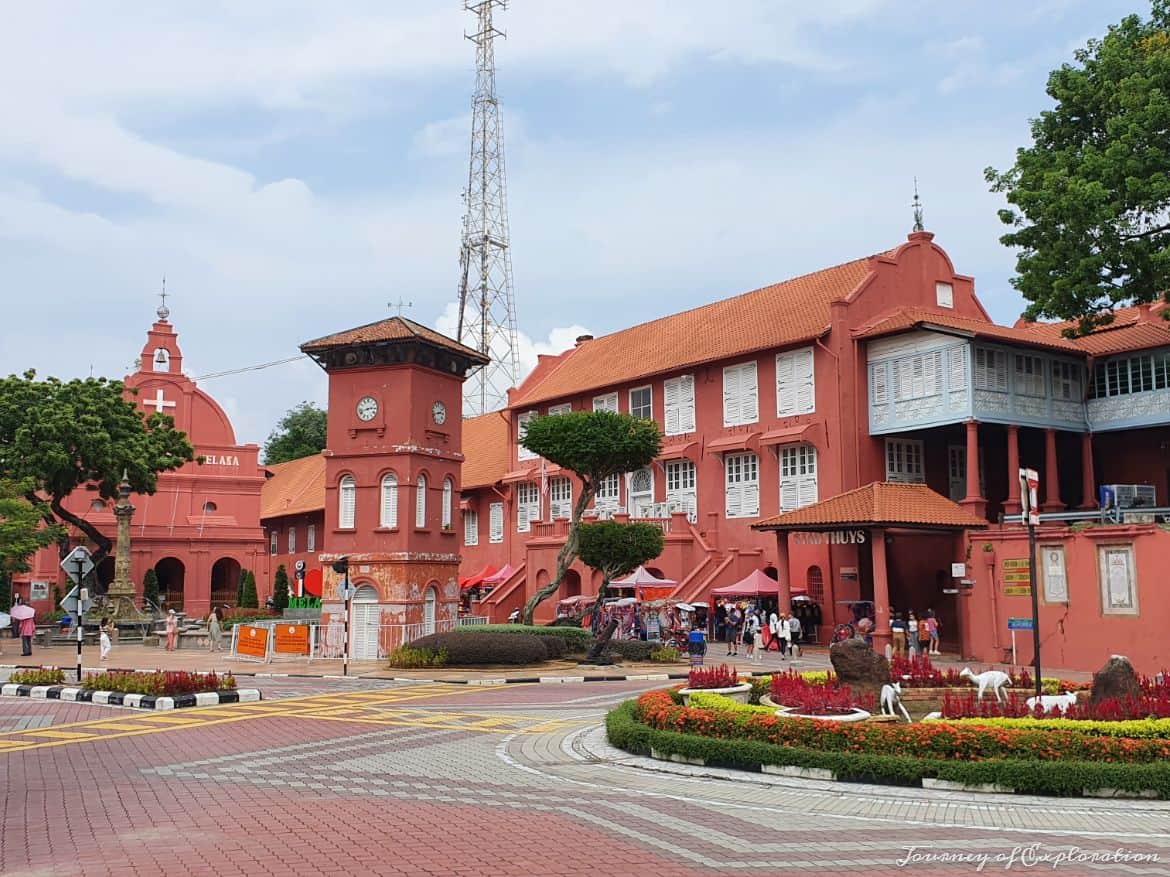
HOW LONG TO STAY IN MALAYSIA
Two weeks will be enough to cover most of the major attractions in Peninsular Malaysia, but you will need to stay longer if you want to explore multiple islands, engage in water activities, and spend some time relaxing on the beach.
If you also plan to visit Borneo (Sabah and Sarawak) for wildlife experiences consider a stay of 3 weeks or more.
You could also combine your trip to Malaysia with visiting Singapore or Brunei as part of an extended stay.
You can check a suggested itinerary here .
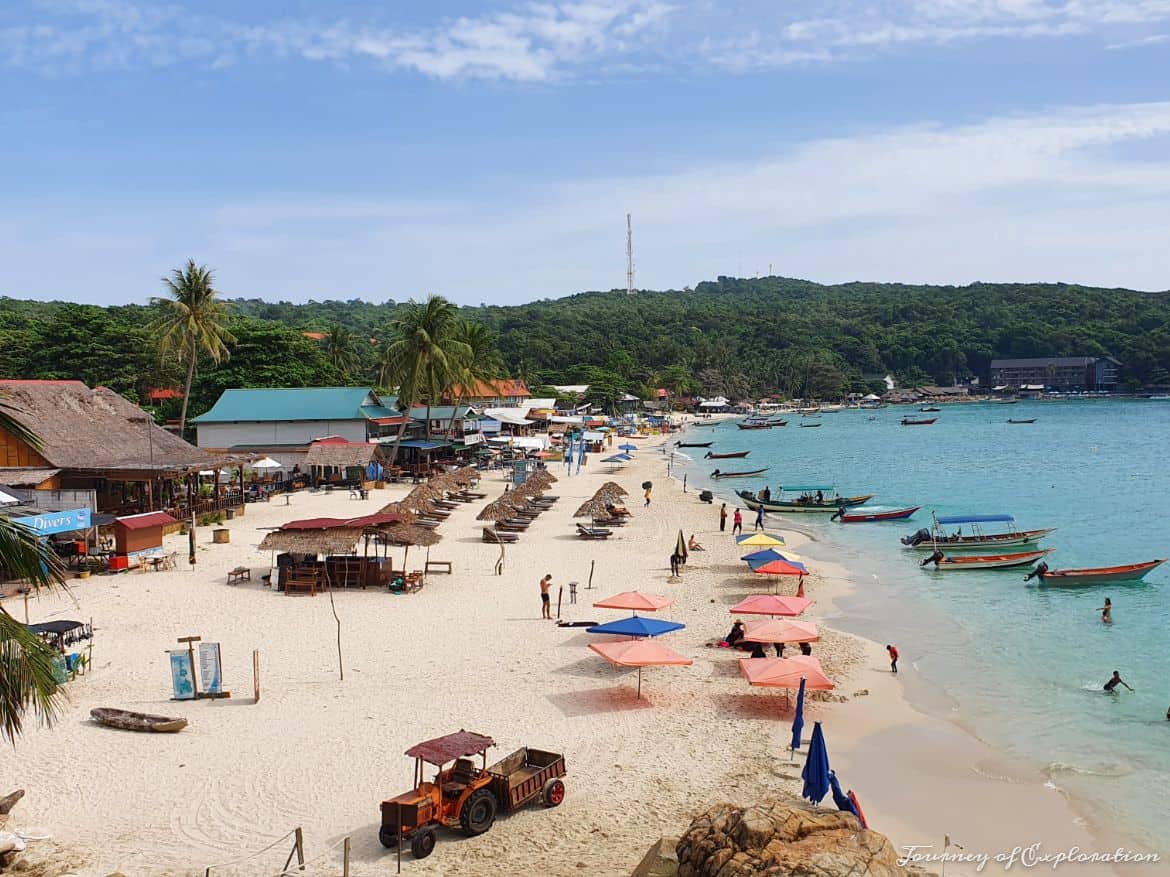
WHERE TO STAY IN MALAYSIA
Malaysia offers a diverse range of accommodations, from luxury resorts to budget-friendly hostels.
It is worth staying in different places if you want to explore the whole country; this will save time from travelling back to the same place. Worth staying in Kuala Lumpur, Cameron Highlands, Penang, Malacca and Kuala Terengganu (for visiting the East Coast).
Also, it is worth staying on one or two of the tropical islands of Malaysia like Langkawi , Perhentian, Redang or Tioman.
Best hotels in Malaysia
- Mandarin Oriental: Located in the city centre with luxurious accommodations and excellent dining options.
- The Ritz-Carlton, Kuala Lumpur : A 5-star hotel offering elegant rooms and top-notch amenities.
- Traders Hotel, Kuala Lumpur: Known for its fantastic view of the Petronas Towers and a rooftop bar.
- Eastern & Oriental Hotel, Penang: A historic and iconic hotel offering colonial-style charm and modern amenities.
- Shangri-La’s Rasa Sayang Resort & Spa: A beautiful beachfront resort in Batu Ferringhi with lush gardens and a range of facilities.
- The Datai Langkawi: A luxurious resort surrounded by rainforest and overlooking the Andaman Sea.
- Four Seasons Resort Langkawi: Offers spacious villas and excellent service on a private beach.
- Casa del Rio Melaka: A boutique hotel on the banks of the Melaka River, known for its unique design.
- The Majestic Malacca: Blending history with modern luxury, this hotel is situated near the historic sites.
- Hatten Hotel Melaka : A 4 star hotel within walking distance from the old town with an outdoor pool and great views from the rooms and bar.
- Grand Lexis Port Dickson : Luxury resort with 2 restaurants and an outdoor pool. Water villas with indoor private pools.
- Avillion Port Dickson
- Lexis Hibiscus Port Dickson
- Felda Residence Kuala Terengganu : Decent hotel offering great views.
- The Taaras Beach & Spa Resort
- Laguna Redang Island Resort
- Redang Beach Resort
- BuBu Long Beach Resort
- MIMPI Perhentian Resort
- Senja Bay Resort
- S hangri-La’s Tanjung Aru Resort & Spa: A beachfront resort with stunning views and extensive recreational facilities.
- Gaya Island Resort: Nestled in the Tunku Abdul Rahman Marine Park, offering a tranquil island getaway.
- The Waterfront Hotel Kuching: Located on the waterfront, providing convenient access to the city’s attractions.
- Hilton Kuching: Offers comfortable accommodations and a central location in Kuching.
Click here to check and compare prices on accommodation for the whole of Malaysia. You can find the hotels on this map .
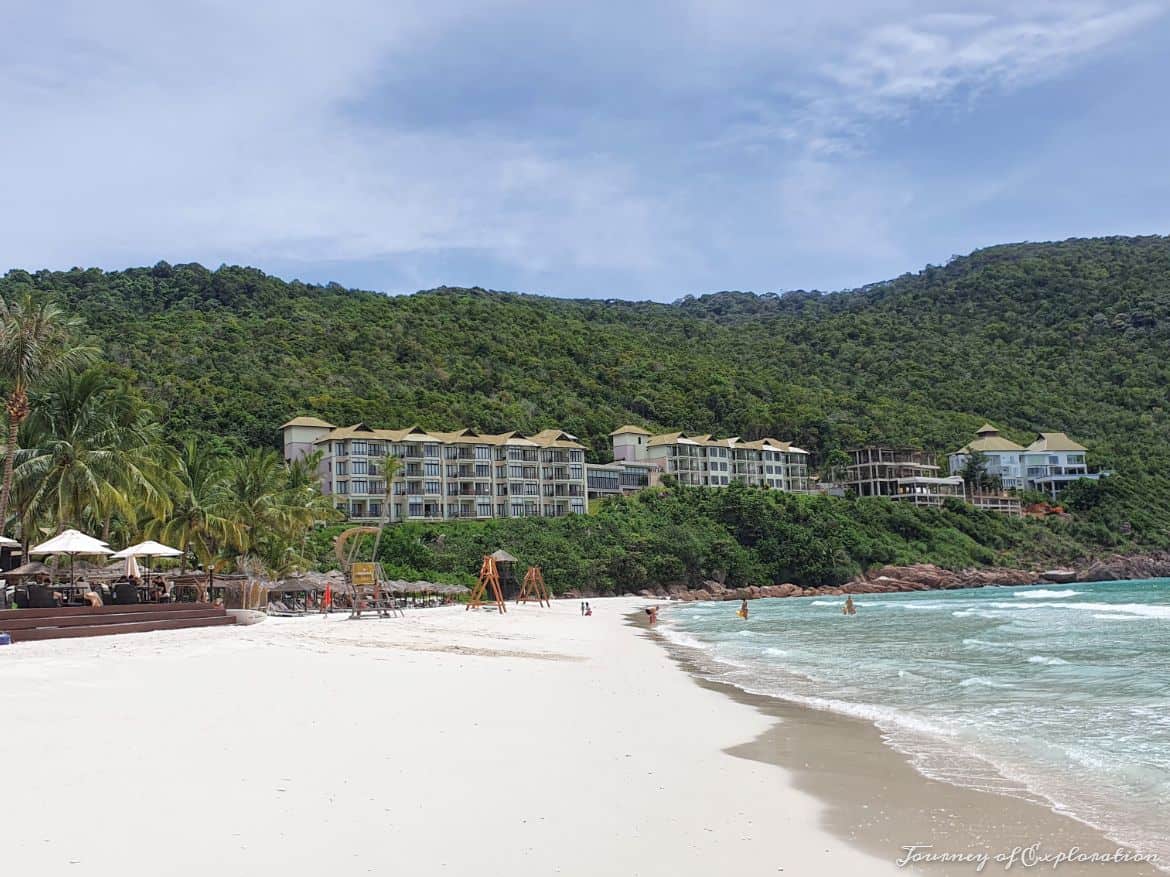
PRACTICAL INFORMATION
Entry requirements/visa.
Citizens of most countries are allowed visa-free entry for tourism purposes for a certain period. The duration varies depending on the nationality.
Some countries have the option for eVisa or visa on arrival. Ensure you meet the eligibility criteria and apply in advance if necessary. For full details check this website .
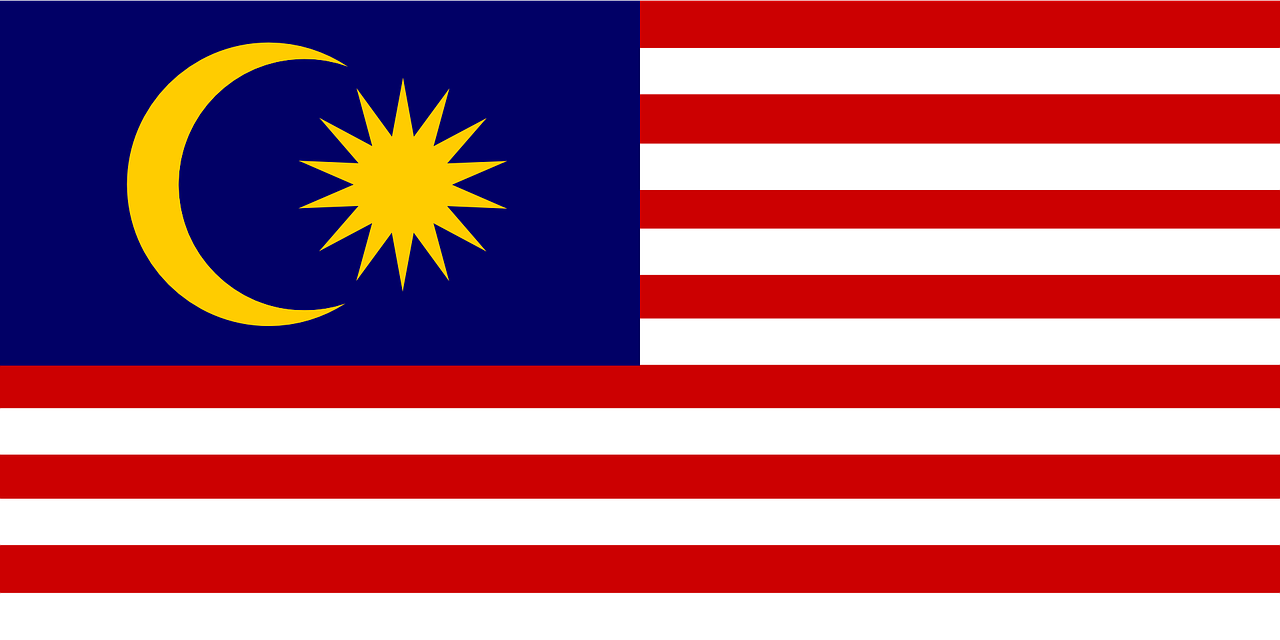
Malaysia is generally considered a safe destination for travellers. The country has a well-developed tourism infrastructure, and millions of tourists visit each year without encountering significant safety issues.
Petty crime such as pickpocketing can occur, especially in crowded areas. You should be vigilant with your belongings and avoid displaying valuable items openly.
It is worth checking the latest health advice regarding vaccinations. Using mosquito repellent is a must in areas where mosquito-borne diseases are prevalent. Consume food and water from reputable establishments.
While the country is generally tolerant, it’s advisable to be respectful of local customs and traditions. Dress modestly , particularly in religious sites.
Travel Insurance
It’s always advisable to get travel insurance before you travel in case of an accident, medical emergency or flight delay.
SafetyWing is an excellent choice for long-term travellers. Alternatively, you can use one of the price comparison websites for cheaper quotes.
Malaysia has a tropical climate characterized by high temperatures and humidity throughout the year. The country experiences two distinct monsoon seasons , which influence the weather patterns.
The Northeast Monsoon (November to March) brings heavy rainfall to the east coast of Peninsular Malaysia
Southwest Monsoon (May to September) affects the west coast of Peninsular Malaysia, bringing heavy rainfall to states like Penang, and Langkawi.
Borneo generally experiences high humidity and rainfall throughout the year.
Overall, temperatures in Malaysia are high and stable and range from around 25°C to 32°C (77°F to 90°F) on average.
Malaysia has high humidity level s, often exceeding 80%. Humidity is relatively constant throughout the year.
More information regarding the weather and average temperatures can be found here .
Local Customs & Etiquette
- Handshakes are generally acceptable for greeting men and women. However, it’s customary for men not to touch Muslim women and the best greeting is just a nod and a smile.
- Shoes must always be removed before entering a Malaysian house.
- Malays usually eat with their hands at home.
- The right hand is always used when eating with one’s hand, when giving and receiving something, as well as during a handshake.
- Shoes must be removed when entering places of worship, such as mosques and temples and make sure that your legs and shoulders are covered up to elbows and knees (ideally long sleeves and trousers).
- The country’s Muslim population does not drink alcohol and does not eat pork .
- Many Malay women wear a tudung ( headscarf ). Women are advised to dress modestly in the most strict Muslim states of north east coast
- Public displays of affection, especially in rural areas, should be avoided, especially between gay couples . Homosexuality is illegal in Malaysia.
The official language is Malay (Bahasa Malaysia), but English, Chinese, and Tamil are also widely spoken. The alphabet is in Latin characters.
Basic words:
- H ello/Hi – Salaam
- Good morning – Selamat pagi
- Good afternoon – Selamat tengahari
- Good evening – Selamat petang
- Good night – Selamat malam
- Thank you – Terima kasih
- Welcome – Selamat datang
- Yes – Ya
- No – Tidak
- Excuse me/I’m sorry – Maafkan saya
- Please – Sila
The currency used in Malaysia is the Malaysian Ringgit , abbreviated as MYR or symbolized as RM. The Malaysian Ringgit is further subdivided into 100 sen. Banknotes and coins are issued in various denominations.
Major credit cards are accepted in urban areas and tourist destinations, but it’s a good idea to have some cash on hand, especially when travelling to more remote areas.
Malaysia is generally considered to be an affordable travel destination, especially when compared to many Western countries. The cost of living in Malaysia is lower than in some developed nations, and travellers can find a range of options to suit different budgets.
Electricity
The power plugs and sockets are of type G (with three rectangular pins, similar to the British one).
The standard voltage is 230V, and the standard frequency is 50Hz.
Internet/Mobile Phone
Malaysia has several major mobile network operators, including Maxis, Celcom, Digi, and U Mobile .
To avoid roaming charges, it is worth buying a prepaid SIM card at the airport, convenience stores or mobile service provider outlets. These SIM cards typically include data, talk time, and text messaging.
Wi-Fi is widely available in hotels, cafes, shopping malls, and public spaces. Many accommodations provide free Wi-Fi for guests.
Airalo is also a good alternative as it provides access to eSIMs (digital SIM cards) for over 200 countries. Travellers can download and install a digital data pack and get free internet without roaming charges. However, Airalo is compatible with only the latest mobile phones
Packing List
Here’s a general packing list for your trip to Malaysia:
- Lightweight Clothing , like T-shirts and shorts made of cotton or linen.
- Modest clothes that cover your shoulders and knees, like trousers, If you plan to visit religious sites.
- A compact rain jacket or poncho
- Comfortable walking shoe s for exploring cities and sandals for the beach.
- Hat and Sunglasses
- Light Jacket for the cooler nights, especially in the highlands
- Sunscreen and Insect Repellent
- Compact Umbrella
- Travel Adapter
- Mobile Powerbank
- Snorkelling Gear
- Waterproof Backpack
- Underwater camera for snorkelling
For more information on travel gear and what to pack click below .
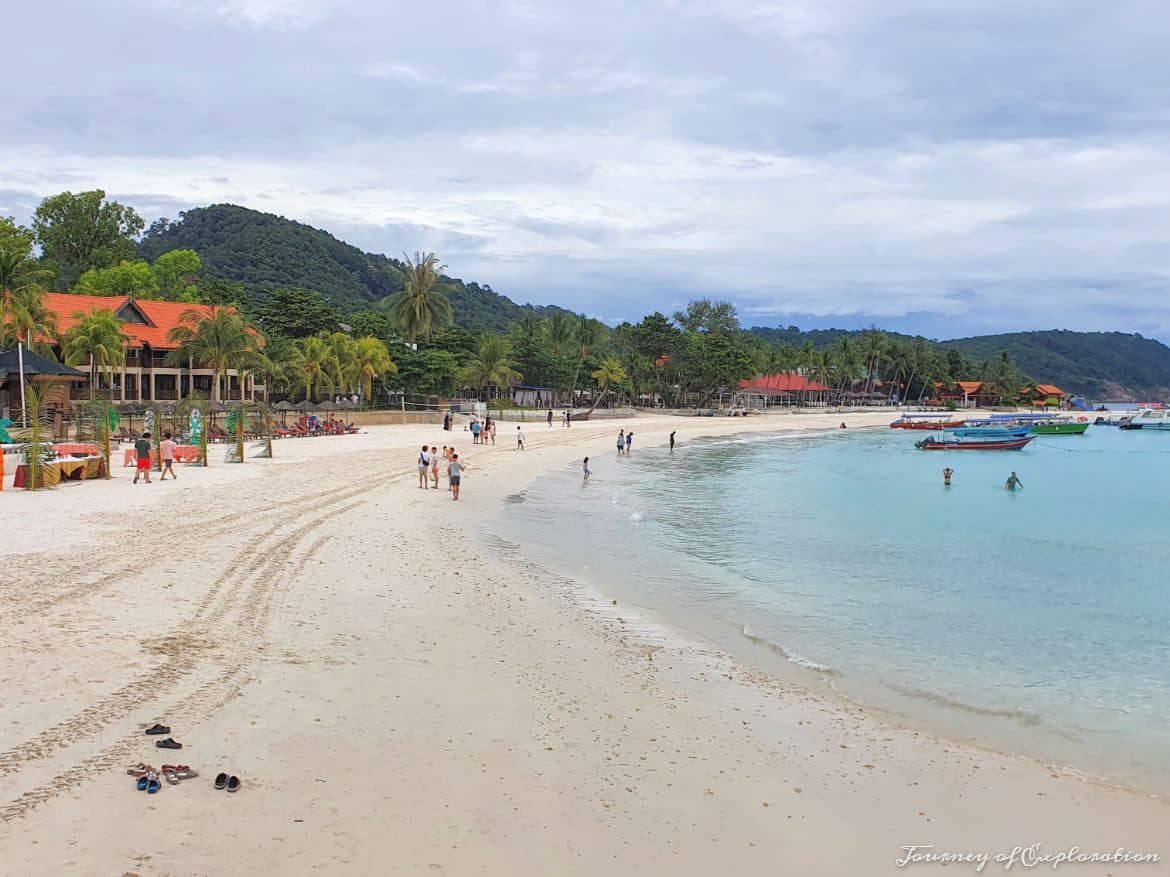
HOW TO GET TO MALAYSIA
Kuala Lumpur International Airport (KLIA) is the main international airport and a major hub for both domestic and international flights.
There are two terminals . KLIA’s main terminal, often referred to as KLIA1 , handles both domestic and international flights. KLIA2 is a dedicated terminal for low-cost carriers and is one of the largest terminal buildings in the world. It is connected to the main terminal by the Aerotrain , a dedicated train service.
Other international airports in Malaysia include Penang International Airport, Langkawi International Airport , and Kota Kinabalu International Airport in Sabah . An alternative option is to fly to Singapore .
Numerous international airlines operate flights to Malaysia. There are also low-cost airlines ( AirAsia ) between various destinations in South East Asia.
For the best website to book your flights, check the link below. Always check prices in advance for the best deals.
Getting from/to the airport
KLIA is located in Sepang, approximately 45 kilometres (28 miles) south of Kuala Lumpur. KLIA is well-connected to the city centre of KL and other parts of the country. Here are some of the ways to get to KLIA:
- KLIA Ekspres : This is a high-speed train service that connects KLIA to Kuala Lumpur city centre. The journey takes approximately 28 minutes. Trains operate every 15-20 minutes. You can board the KLIA Ekspres at KL Sentral, and it provides a seamless and efficient connection.
- KLIA Transit: Similar to KLIA Ekspres but with additional stops, KLIA Transit connects KLIA to KL Sentral and other stations. It takes around 35 minutes to reach KLIA from KL Sentral.
- Taxis operate on a metered system, and the journey time depends on traffic conditions.
- Services like Grab operate in Kuala Lumpur and offer an alternative to traditional taxis. You can use the Grab app to book a ride to KLIA.
- Airport Coach: There are long-distance buses operated by Airport Coach that connect KLIA with various cities and towns in Malaysia.
- Rapid KL Bus: The Rapid KL bus service provides an economical option to travel from different parts of Kuala Lumpur to KLIA. More information can be found here .
From Thailand: If you’re coming from Thailand, you can enter Malaysia by road. There are several border crossings between the two countries.
From Singapore: If you’re coming from Singapore, you can travel by bus, train, or car. The road and rail connections are well-developed.
Passport checks are required at borders so expect delays at peak times, especially from/to Singapore.
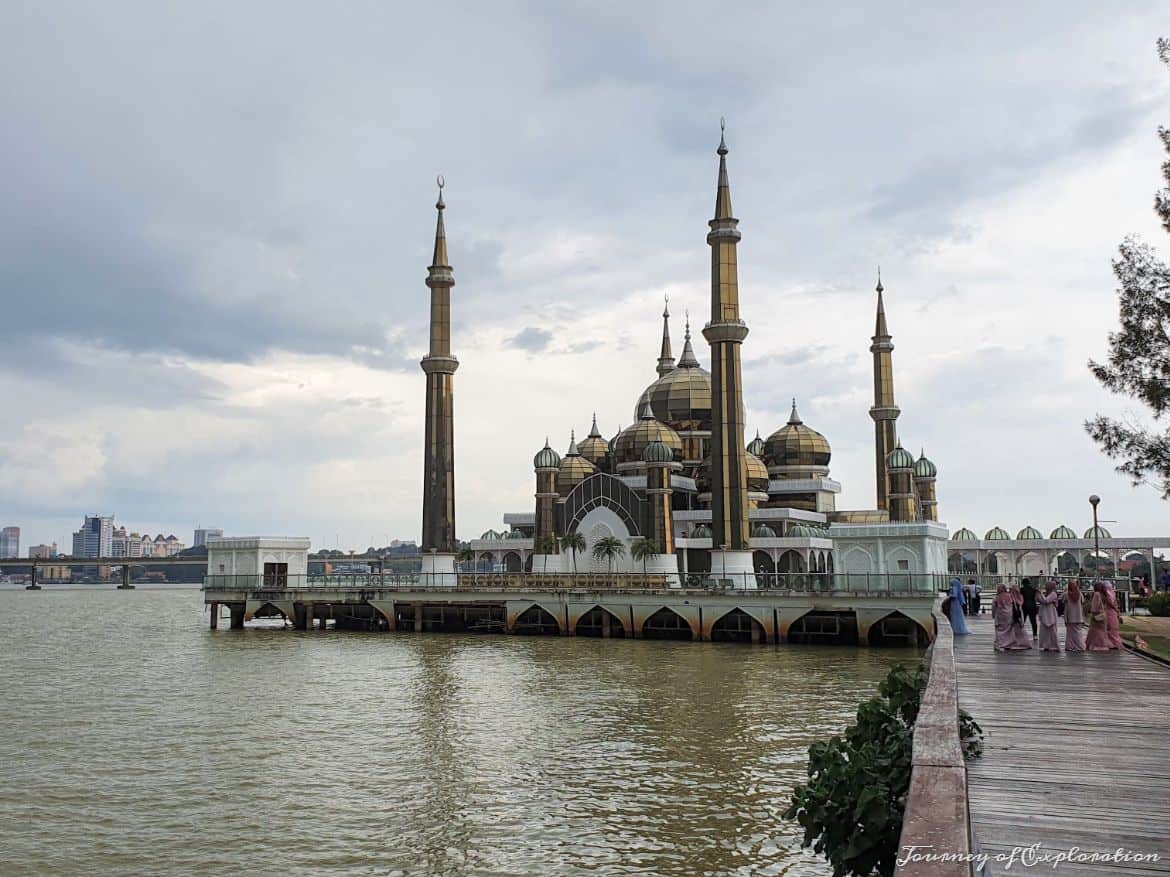
HOW TO GET AROUND MALAYSIA
If you plan to explore different regions in Malaysia, domestic flights are one of the best and fastest ways to travel around the country and are relatively affordable . There are numerous domestic flights connecting the major cities and between Peninsular Malaysia and East Malaysia (Sabah and Sarawak). Here is a guide to travelling by plane in Malaysia:
Major Airlines:
- Malaysia Airlines : The national carrier, Malaysia Airlines, operates domestic flights connecting Kuala Lumpur with various cities, including Penang, Langkawi, Kota Kinabalu, and Kuching.
- AirAsia : AirAsia, a prominent low-cost airline, offers an extensive network of domestic flights covering major cities and popular destinations. They operate mainly from Kuala Lumpur International Airport (KLIA2) and other regional airports.
- Firefly : Firefly is a regional airline with a focus on connecting smaller cities and towns within Malaysia. They operate from Subang Skypark in Kuala Lumpur.
- Batik Air: Previously operated as Malindo Air serves domestic routes along with international destinations. They operate from KLIA and focus on providing a combination of full-service and low-cost options.
- MASwings : MASwings specializes in serving destinations in East Malaysia, connecting cities in Sabah and Sarawak.
- Berjaya Air: Operates private flights to Redang Island.
Domestic flights from Kuala Lumpur operate to the following destinations: Georgetown (Penang), Langkawi, Johor Bahru, Kuala Terengganu, Kota Bharu ( close to Perhentian Islands) , Alo Setar (Kedah), Kuantan, Kuching (Sarawak), Bintulu (Sarawak), Miri (Sarawak), Sibu (Sarawak), Kota Kinabalu (Sabah), Sandakan (Sabah), Tawau (Sabah) & Labuan.
You can check the following website for the best deals.
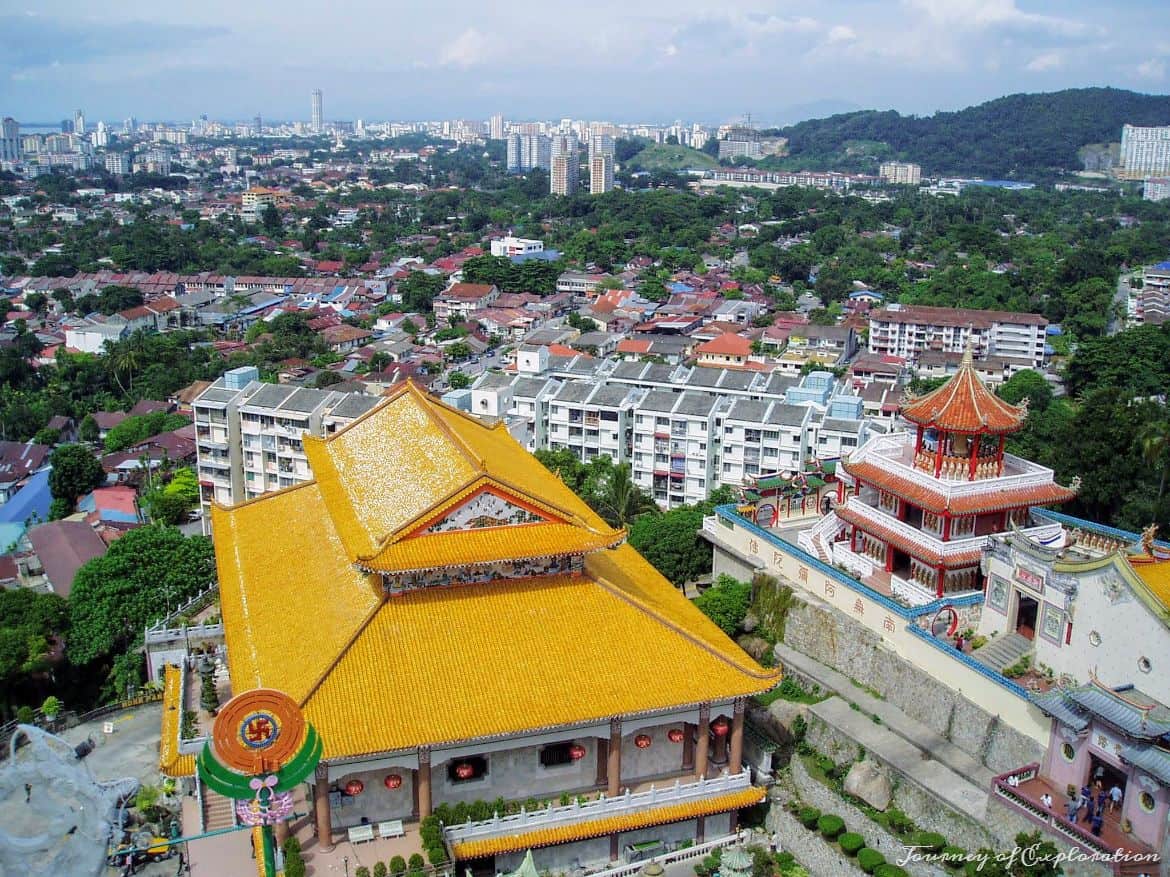
Renting a car in Malaysia is a popular option for travellers who want the flexibility to explore the country at their own pace. The best place to rent a car is the airport .
Car rental c an be relatively cheap off-season. Better to book in advance before your travel for the best deals. Also in high season, there might be low availability and the prices can be much higher if you leave it until you arrive. Check the link below to book and compare car rental prices.
Driving in Malaysia
You can drive in Malaysia with a valid international driving permit (IDP) or a valid driver’s license from your home country. Driving is on the left side, like in the UK.
Malaysia has an extensive network of tolled highways. Ensure you have sufficient cash or a Touch ‘n Go card for toll payments.
Expect traffic congestion , particularly in major cities like Kuala Lumpur. Also, main highways can be congested during peak times, particularly during the holidays. It is advisable to plan accordingly, especially if you go to the KLIA airport.
- Car Parks: Most cities, especially Kuala Lumpur, have numerous car parks. These can be found near shopping malls, office buildings, and popular areas. Pay attention to parking fees, which are usually hourly.
- Street Parking: Some areas may offer street parking with designated parking meters or ticket machines. Make sure to pay the required fee and adhere to time limits.
- Parking Coupons: In certain areas, especially in historic towns like George Town in Penang, you might need to use parking coupons. These can be purchased from nearby stores or machines, and you display them on your dashboard.
- Mobile Parking Apps: Some cities have introduced mobile parking apps that allow users to pay for parking through their smartphones. Check if the city you’re in has such services.
Taxis are a common mode of transportation in Malaysia, especially in urban areas and tourist destinations. There are taxi stands in most towns.
In most areas, taxis operate on a metered fare system . The meter calculates the fare based on the distance travelled and time spent waiting in traffic. Some taxis, especially at airports, may have fixed rates to specific destinations. Make sure to confirm the fare before starting your journey.
Grab is a popular ride-sharing service in Malaysia. You can download the Grab app, input your destination, and the app will connect you with a nearby driver. Payment is made through the app. This is the cheapest option if you don’t have a car and there are no bus connections. Maxim is another taxi app offering cheap fares.
Taxis are usually quite affordable even for long-distance travel, if it is shared between more than two people.
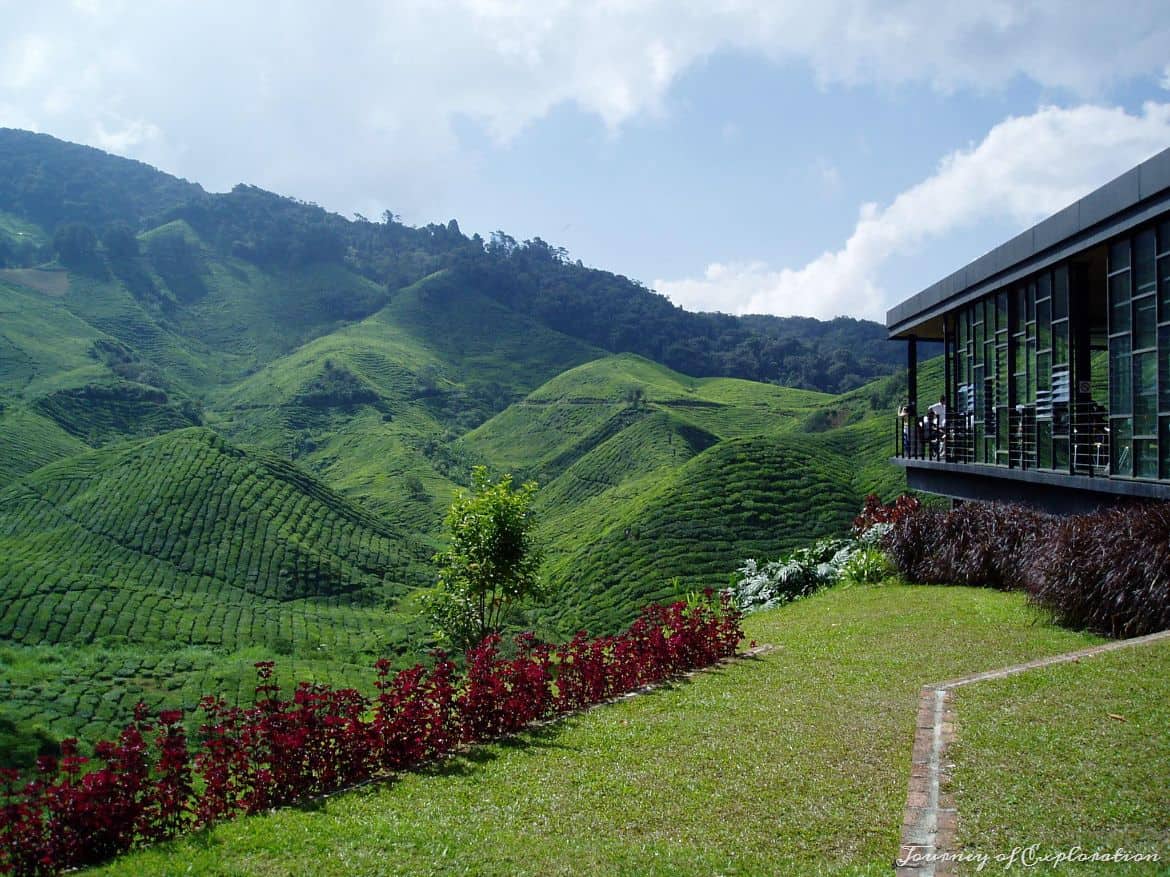
Bus travel is a convenient and affordable mode of transportation in Malaysia, connecting various cities, towns, and rural areas. Here’s a guide to bus travel in Malaysia:
Types of Buses:
- Express Buses: These long-distance buses (coaches) operate between major cities and towns. They are known for comfort and typically have air-conditioning. Express buses are a popular choice for intercity travel.
- Local Buses: Local buses operate within cities and towns, providing transportation for shorter distances. They are often used for commuting within urban areas.
- Shuttle Buses: Some areas, especially tourist destinations, have shuttle buses that transport visitors to key attractions or points of interest.
- RapidKL Buses: RapidKL is a public bus service operating in the Klang Valley and Kuala Lumpur. It provides an extensive network of routes within the city and surrounding areas.
Express and local buses usually operate from separate stations. Tickets can be purchased at bus terminal and from bus company counters. There are different companies, but prices are similar and inexpensive. Many bus operators also offer online booking services through their websites. For popular routes or during holidays, consider booking in advance. Buses don’t usually have restrooms , although on longer routes, there is a rest stop every several hours and, if necessary, a 30-minute food break.
Major Bus Operators:
- Transnasional : A major long-distance bus operator connecting various cities and towns in Peninsular Malaysia.
- Plusliner : Operates express and local bus services, connecting major cities and towns.
- Konsortium Bas Ekspres (KTB): Another prominent express bus operator serving popular routes.
- RapidKL: Operates city buses within Kuala Lumpur and the Klang Valley. They also operate the LRT and monorail services.
- Cityliner: Provides bus services connecting smaller towns and rural areas.
Bus Terminals In KL:
- Pudu Sentral : Situated in the centre of Kuala Lumpur, Pudu Sentral is the major bus terminal serving both local and express buses.
- Terminal Bersepadu Selatan (TBS): Located to the south of Kuala Lumpur, TBS is the main bus terminal serving southern destinations. It houses various bus operators, including Transnasional and Plusliner.
- Terminal Bas Ekspres Shah Alam: Located in Shah Alam, this terminal serves buses travelling to various destinations.
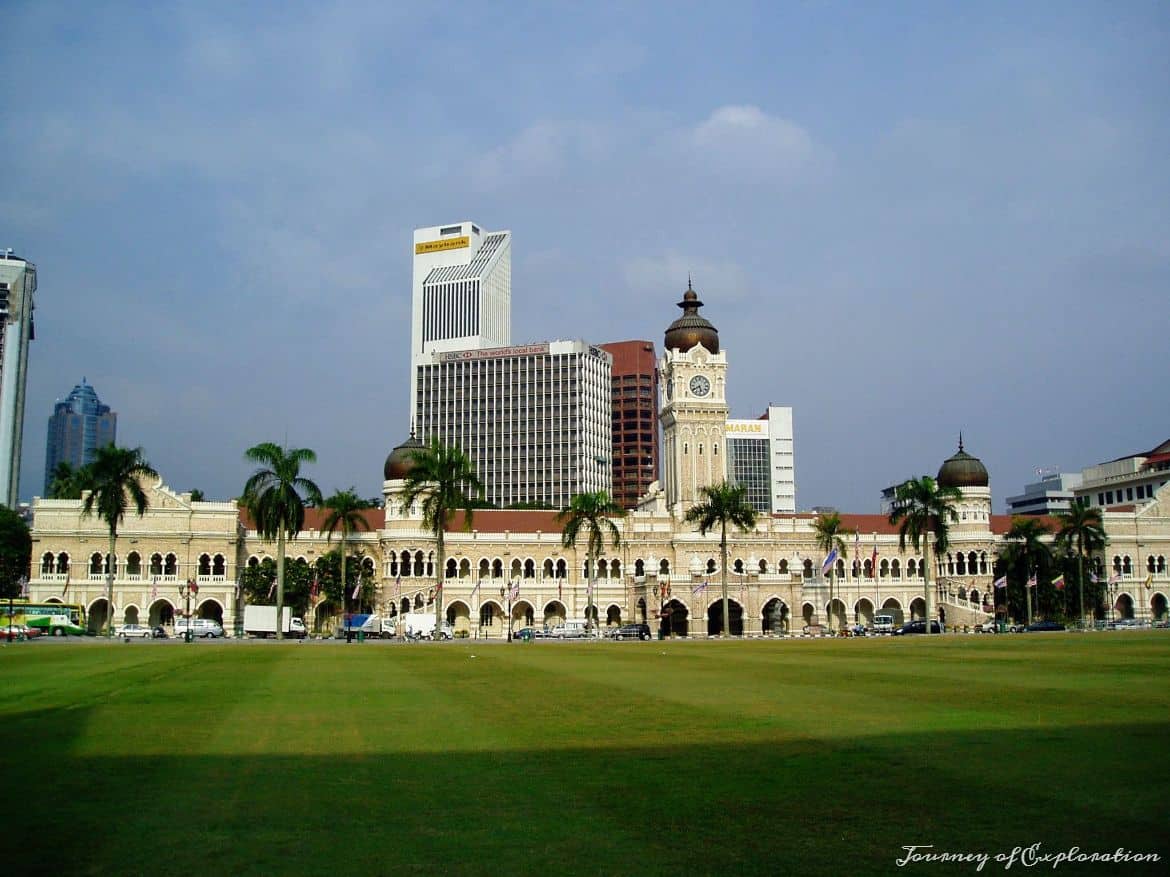
Malaysia has a decent railway system that connects various regions within the country (Peninsular Malaysia). The railway network is operated by Keretapi Tanah Melayu Berhad (KTMB ), the national railway company.
There are two major train routes .
- North-South Line : connects Singapore to Kuala Lumpur, Ipoh, Penang, and further north. Stops include major cities and towns along the west coast of Peninsular Malaysia.
- East Coast Line: Links Gemas to Tumpat, passing through the scenic landscapes of the East Coast. Popular stops include Kota Bharu and Kuala Terengganu. This route, known as the Jungle Railway , is a scenic train route that runs through the interior of Peninsular Malaysia.
Here’s a guide to the types of trains in Malaysia:
- KTM Intercity: KTM Intercity trains operate long-distance routes, connecting major cities and towns. These trains offer various classes, including Economy, Business, and Superior Night Class (overnight sleeper trains).
- Electric Train Service (ETS): ETS is a high-speed electric train service that operates on the electrified double-track railway lines. ETS connects cities like Kuala Lumpur, Ipoh, and Penang, offering a faster travel option.
- Komuter: KTM Komuter is a commuter train service operating in the Klang Valley, connecting areas around Kuala Lumpur and its suburbs. Komuter trains are a popular choice for daily commuters.
You can buy tickets at train stations or through the KTMB website . Prices are relatively cheap. It’s advisable to book in advance, especially during peak travel times.
Travelling by train can be a lot slower compared to travelling by bus, so it’s not recommended if you have limited time in Malaysia.
However, the Jungle Railwa y is a unique travel experience, This railway journey takes you through lush jungles , picturesque landscapes and old colonial stations, providing access to remote areas that may not be easily reachable by road.
Ferries connect the mainland with various islands of Malaysia. Vessels are either modern speedboats or compact motorized fishing boats. You generally buy your ticket in advance from booths at the jetty. Some of the popular ferry routes include:
- Kuala Kedah to Langkawi: Kuala Kedah, located on the mainland, serves as a departure point for ferries to Langkawi.
- Kuala Perlis to Langkawi: Ferries from Kuala Perlis offer another option for travelling to Langkawi.
- Kuala Besut to Perhentian Islands: Kuala Besut is the gateway to the Perhentian Islands in the northeastern part of Peninsular Malaysia.
- Mersing to Tioman Island: Ferries operate from Mersing on the mainland to Tioman Island
- Merang Jetty or Kuala Terengganu to Redang Island: They serve as departure points for ferries to Redang Island.
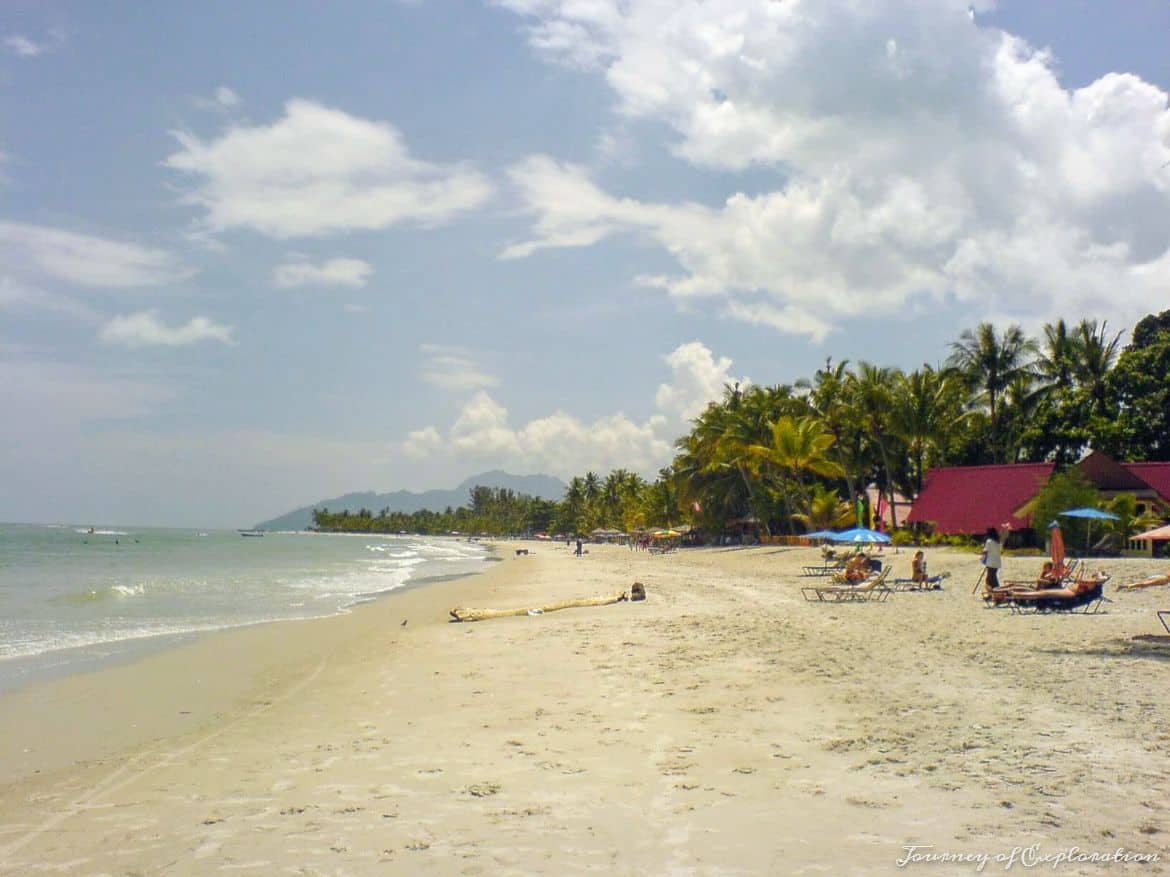
WHAT TO EAT & DRINK IN MALAYSIA
Best places to eat in malaysia.
Here is a guide to the best places to eat in Malaysia and sample the unique local cuisine . Hawker Centers, Food Markets & Street Food is the best way to experience different favours with affordable prices.
- Jalan Alor : It is a popular hawker centre and a great place to try a variety of Malaysian dishes, from satay to Hokkien mee.
- Jalan Petaling Food Market: This massive hawker centre is a great place to try a variety of Chinese, Malay, and Indian dishes.
- Melaka : Melaka is the best place to try Nyonya Cuisine , a unique cuisine with a blend of Malay and Chinese flavours. Try dishes like ayam pongteh and asam pedas.
- Penang : Known as the food capital of Malaysia, Penang offers a wide array of street food, including char kway teow, laksa, and nasi kandar.
- Sarawak : Head to Kuching, the capital of Sarawak, to sample authentic Sarawak laksa, kolo mee, and umai (raw fish salad)
- Terengganu : Visit Kuala Terengganu to sample local delights such as nasi dagang (rice with fish curry), keropok lekor (fish crackers), and satar (grilled fish wrapped in banana leaves).
- Coastal Towns : Head to coastal regions like Langkawi, Kota Kinabalu, and Kuching to enjoy fresh seafood straight from the ocean. Feast on grilled fish, prawns, crabs, and shellfish prepared in various local styles.
Malaysian Cuisine
Malaysian cuisine is diverse, flavourful, and influenced by various cultures, including Malay, Chinese, Indian, and indigenous communities. Here are some must-try Malaysian dishes:
- Nasi Lemak: Malaysia’s national dish, featuring fragrant coconut rice served with anchovies, peanuts, boiled eggs, cucumber, and spicy sambal.
- Rendang: A rich and aromatic dry curry made with beef or chicken, coconut milk, and a blend of spices, slow-cooked to perfection.
- Satay: Skewered and grilled meat, typically served with a delectable peanut sauce. Common choices include chicken and beef satay.
- Roti Canai: A flatbread often paired with dhal (lentil curry) or various curries. It’s a popular choice for breakfast or snacks.
- Char Kway Teow: Stir-fried flat rice noodles with prawns, Chinese sausage, bean sprouts, and savoury soy sauce, prepared in a wok.
- Nasi Goreng: Malaysian fried rice with ingredients like prawns, chicken, eggs, and vegetables, seasoned with sweet soy sauce.
- Laksa: A spicy noodle soup with a coconut milk base. Varieties include Penang Laksa and Sarawak Laksa.
- Hainanese Chicken Rice: Poached chicken served with fragrant rice, accompanied by chilli sauce, ginger paste, and a flavorful broth.
- Mee Goreng Mamak: Stir-fried noodles with a spicy and tangy sauce, often cooked with prawns, tofu, and vegetables, showcasing Indian-Muslim influences.
- Otak-Otak: Grilled fish paste mixed with spices, wrapped in banana leaves. A popular snack or side dish.
- Cendol: A refreshing dessert comprising green rice flour jelly, coconut milk, shaved ice, and palm sugar, perfect for Malaysia’s tropical climate.
- Kuih: Assorted traditional Malaysian desserts, including colourful treats like kuih lapis, onde-onde, and kuih ketayap.
- Murtabak: Stuffed flatbread filled with minced meat, onions, and sometimes eggs, often served with a side of curry.
- Ikan Bakar: Grilled fish marinated with spices and wrapped in banana leaves, offering a delightful seafood experience.
- Teh Tarik: Malaysian pulled tea, prepared by skillfully pouring hot tea back and forth to create a frothy texture.
- Asam Laksa: A spicy and tangy noodle soup, asam laksa showcases a tamarind-infused broth, rice noodles, flaked fish, and an array of aromatic herbs. It’s particularly popular in Penang.
- Nasi Dagang: Originating from the East Coast, nasi dagang consists of steamed glutinous rice and fragrant rice cooked in coconut milk. Served with fish curry and pickled vegetables, it’s a flavorful delight.
- Durian: Revered as the “king of fruits,” durian is a polarizing delicacy with a potent aroma. Its custard-like flesh varies among different varieties, creating a distinctive and memorable taste.
- Hokkien Mee: This noodle dish combines thick yellow noodles and rice vermicelli stir-fried with prawns and squid in a flavorful seafood broth. Garnished with crispy shallots and lime, it’s a savoury delight.
- Keropok Lekor: Hailing from the East Coast, keropok lekor is a popular fish cracker made from a blend of fish and sago flour. Deep-fried to perfection, it’s enjoyed with a side of spicy dipping sauce.
- Kaya Toast: A beloved breakfast or tea-time treat, kaya toast features toasted bread spread with kaya, a sweet coconut and egg jam. Often paired with soft-boiled eggs and coffee or tea, it’s a comforting classic.
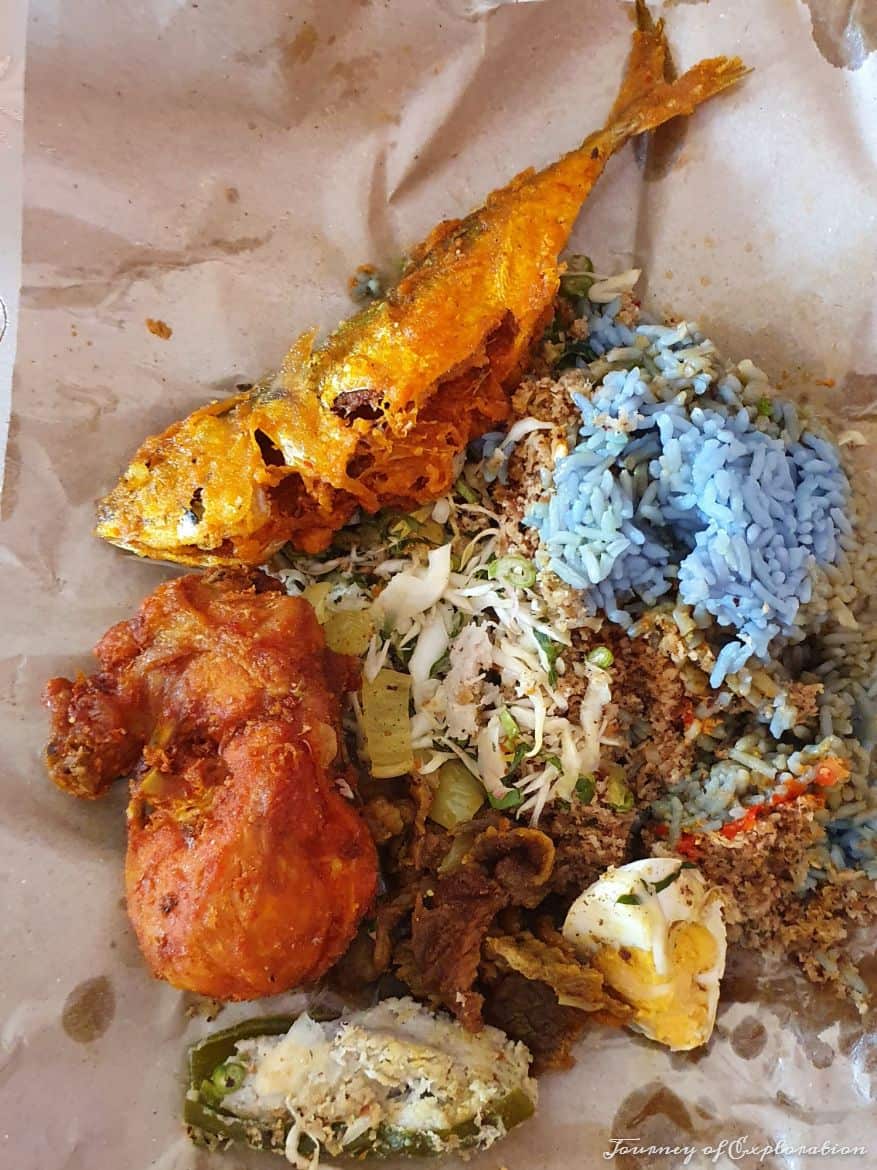
MALAYSIA THINGS TO DO
BEST attractions & PLACES TO VISIT
Peninsular Malaysia
- Petronas twin towers : They dominate the Kuala Lumpur skyline and the observation deck provides stunning views of the city.
- Menara KL Tower: Another towering landmark, Menara KL offers 360-degree views and a revolving restaurant.
- Sultan Abdul Samad Building: A beautiful Moorish-style building that houses the National Textile Museum.
- National Museum: Learn about Malaysia’s history and culture through exhibits on archaeology, ethnography, and art.
- Merdeka Square
- Malacca (Melaka): A UNESCO World Heritage Site, Malacca is known for its historical architecture, vibrant street art, and a mix of cultural influences.
- Cameron Highlands: A hill station known for its tea plantations, cool climate, and lush landscapes. Explore the tea estates and enjoy the scenic beauty.
- Penang Island: Home to George Town, another UNESCO World Heritage Site, famous for its street art, diverse architecture, and delicious food.
- Langkawi: A tropical paradise with beautiful beaches, lush jungles, and the Langkawi SkyBridge offering panoramic views.
- Taman Negara: One of the world’s oldest rainforests with diverse flora and fauna. Canopy walks and river cruises offer a unique experience.
- Batu Caves, Selangor: A limestone hill featuring caves and temples, with the giant golden statue of Lord Murugan and the colourful steps making it an iconic site.
- Perhentian Islands: Pristine coral reefs, clear turquoise waters, and white sandy beaches make these islands a perfect destination for snorkelling and diving.
- Redang Island: Known for its crystal-clear waters and vibrant marine life, Redang is a popular destination for beach lovers and snorkelers.
- Pulau Tioman : Pulau Tioman, also known as Tioman Island, is located off the east coast of Peninsular Malaysia. This island paradise boasts stunning beaches, vibrant coral reefs, lush rainforests, and a laid-back atmosphere, making it a popular destination for tourists.
- Putrajaya : Putrajaya, Malaysia’s administrative capital, is a unique city with grand government building, the iconic pink mosque and a riverside setting.
- Kota Bharu : It is the capital of Kelantan state in Malaysia with a rich history and culture. It has some nice traditional buildings, a bustling market, and a delicious local cuisine.
- Kuala Terengganu : It’s a charming coastal city with the famous Crystal Mosque (Masjid Kristal) .
- Johor Bahru : Second-largest city in Malaysia and a major economic hub It is known for its theme parks (Legoland Malaysia, Hello Kitty Town, and Puteri Harbour Family Theme Park) and shopping malls.
- Port Dickson: Fondly known as PD, is a coastal town in Negeri Sembilan, Malaysia. It’s a popular weekend getaway and beach resort destination, particularly for Malaysians and Singaporeans, offering a laid-back atmosphere, beautiful beaches, and a variety of water activities.
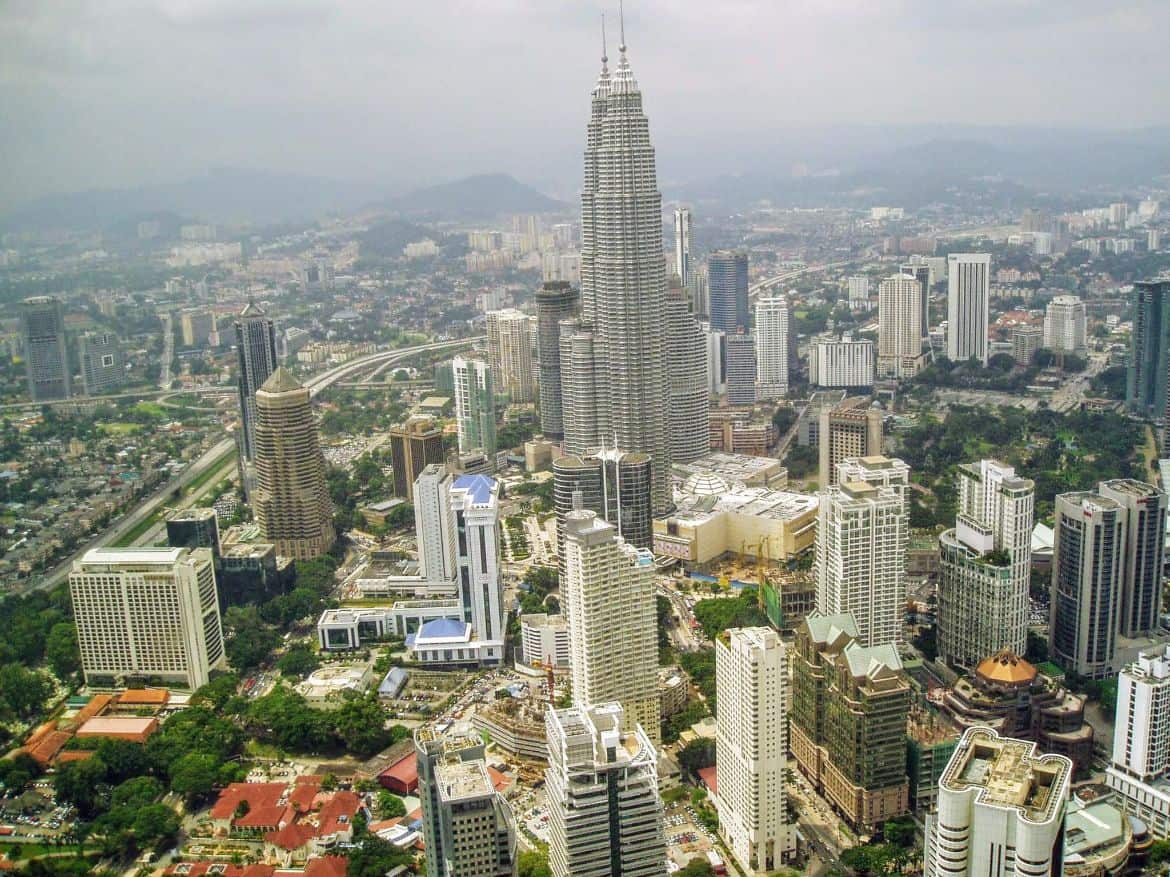
Borneo (Sabah and Sarawak)
- Mount Kinabalu: The highest peak in Southeast Asia, offering challenging treks and breathtaking views of the surrounding landscapes.
- Kinabatangan River: A haven for wildlife enthusiasts, the river is home to diverse species, including orangutans, pygmy elephants, and proboscis monkeys.
- Bako National Park, Sarawak: Malaysia’s oldest national park, known for its wildlife, trekking trails, and distinctive ecosystems.
- Sepilok Orangutan Rehabilitation Centre: Located in Sabah, this center is dedicated to the rehabilitation of orphaned orangutans, offering a chance to see them up close.
- Mulu Caves, Sarawak: A UNESCO World Heritage Site, Mulu National Park is famous for its limestone karst formations and extensive cave systems.
- Kuching, Sarawak: The capital city of Sarawak, known for its diverse culture, historic buildings, and lively Sarawak River waterfront.
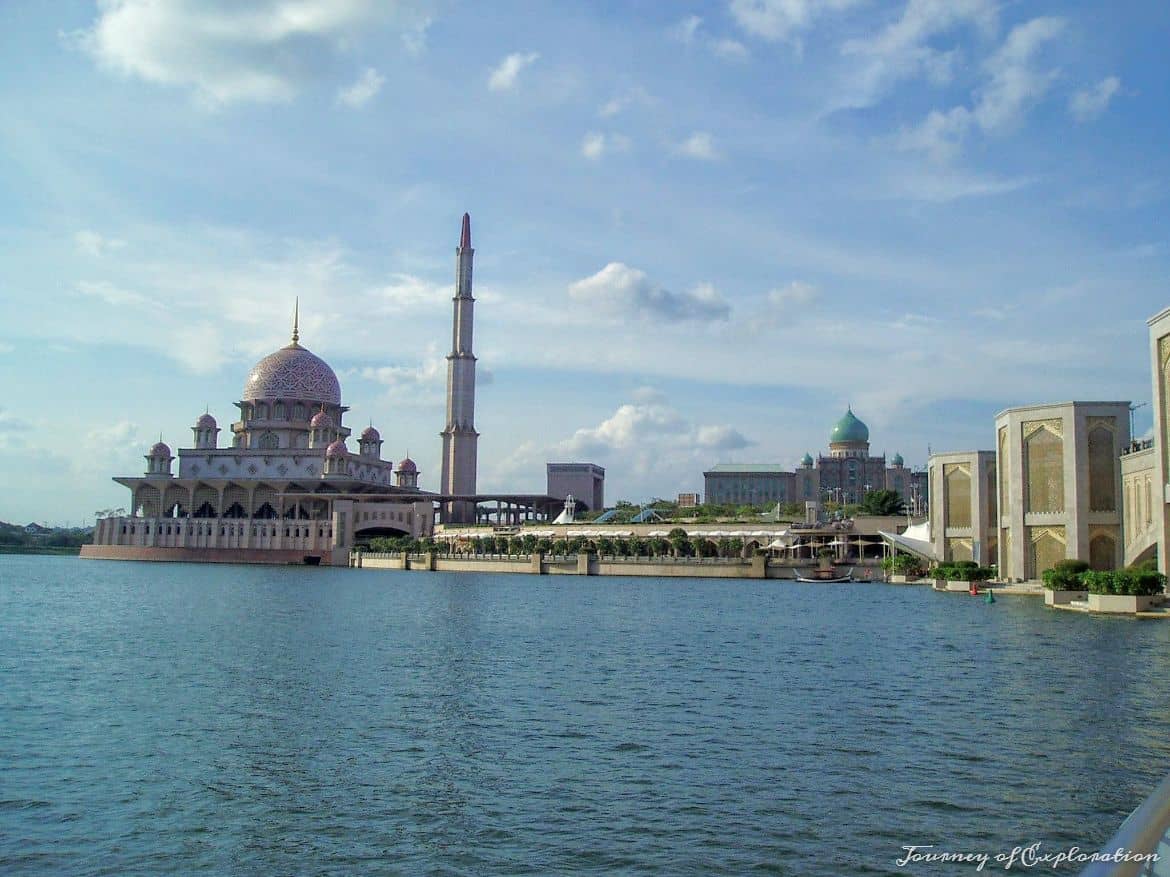
MALAYSIA BEST ISLANDS
- Langkawi : Known for its duty-free status, Langkawi is an archipelago of 99 islands in the Andaman Sea. It offers stunning beaches, lush rainforests, and attractions like the Langkawi SkyBridge.
- Perhentian Islands: Comprising Perhentian Besar and Perhentian Kecil, these islands are renowned for their crystal-clear waters, vibrant coral reefs, and a laid-back atmosphere. They are popular for snorkeling and diving.
- Tioman Island: Located in the South China Sea, Tioman Island is known for its diverse marine life, vibrant coral reefs, and lush rainforests. It’s a popular destination for snorkelling, scuba diving, and trekking.
- Redang Island: A part of the protected Terengganu Marine Park, Redang Island boasts powdery white sands, clear turquoise waters, and excellent snorkelling and diving opportunities.
- Pangkor Island: Accessible from the west coast of Peninsular Malaysia, Pangkor Island offers tranquil beaches, historic Dutch ruins, and opportunities for water activities like snorkelling and kayaking.
- Sipadan Island: Located off the coast of Sabah in Borneo, Sipadan is renowned for its world-class diving sites. It’s a marine paradise with diverse underwater life, including turtles, sharks, and coral gardens.
- Kapas Island: Also known as Pulau Kapas, this small island off the east coast of Peninsular Malaysia is famous for its white sandy beaches, clear waters, and a laid-back atmosphere.
- Rawa Island: A private island off the east coast of Peninsular Malaysia, Rawa Island offers pristine beaches, coral reefs, and a tranquil environment for relaxation.
- Mabul Island: Known for its proximity to Sipadan, Mabul Island is famous for muck diving and is a haven for underwater photographers. The island offers a range of diving experiences.
- Lankayan Island: Located in the Sulu Sea, Lankayan Island is known for its exclusive dive resorts and is a great destination for those seeking a peaceful retreat and excellent diving opportunities.
- Lang Tengah Island : Lang Tengah Island, located close to Redang, is known for its crystal-clear waters and vibrant coral reefs. It’s an excellent spot for snorkelling.
- Boheydulang Island : A small mountainous island inside a marine park, accessible as part of a boat tour excursion. It offers hiking, diving, and snorkelling opportunities. Great view from the top.
- Pulau Sibuan : A tiny island with crystal clear waters, great for snorkelling.
- Mataking Island : The further island from Semporna, a great scuba diving destination.
- Mantanani Islands : Mantanani Islands are tiny islands in Sabah with pristine beaches and clear waters. It’s a fantastic location for diving and snorkelling, and you might even spot dugongs in the surrounding waters.
- Tunku Abdul Rahman National Park: This island chain off Kota Kinabalu offers a variety of beaches, ranging from secluded coves to lively resorts. Explore the islands, trek through the jungle, and relax on the beach.
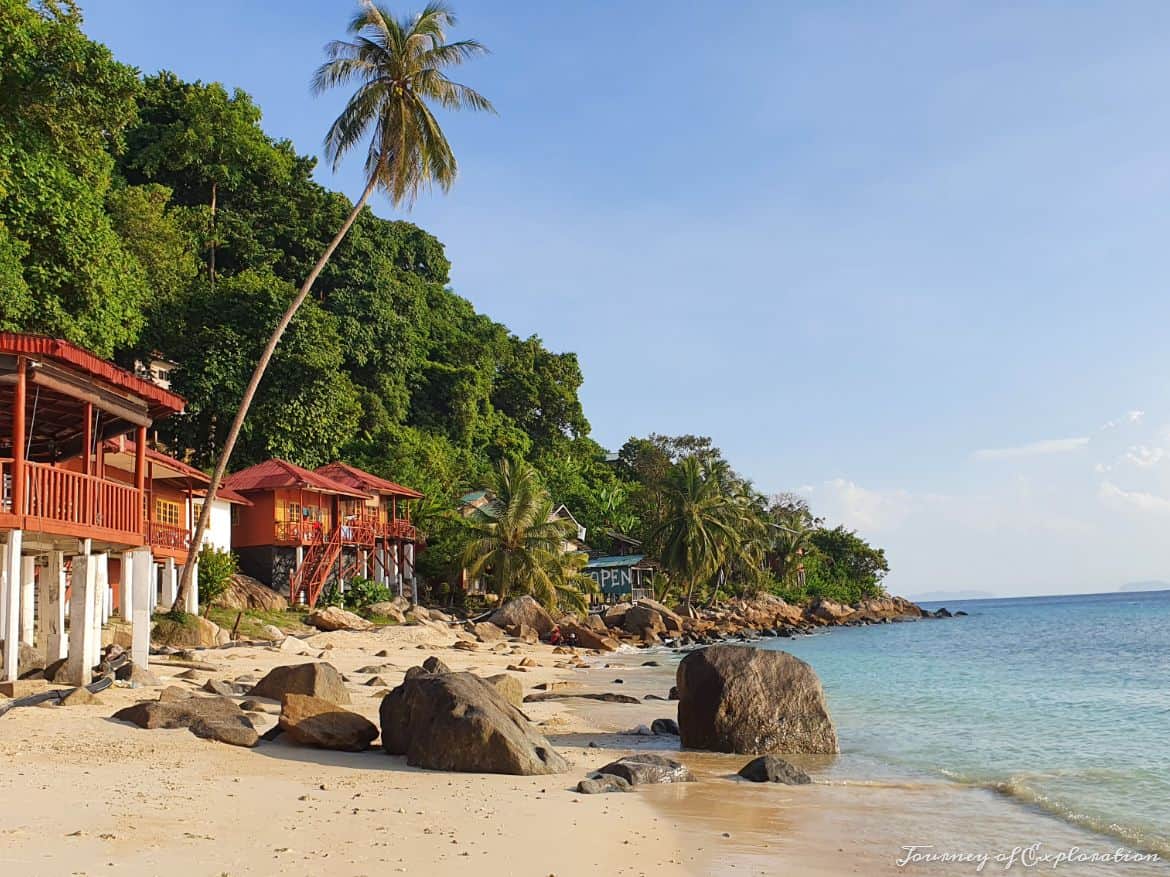
BEST BEACHES IN MALAYSIA
Malaysia is home to some stunning beaches, offering white sands, crystal-clear waters, and beautiful coastal landscapes. Here are some of the best beaches in Malaysia:
- Langkawi – Cenang Beach: Cenang Beach in Langkawi is one of the most popular and vibrant beaches in Malaysia. It features a long stretch of soft, golden sand, and the area is known for its water sports, restaurants, and nightlife.
- Perhentian Islands – Long Beach: Long Beach on Perhentian Kecil is a paradise for beach lovers. The powdery white sand and clear turquoise waters make it an ideal spot for swimming, snorkelling, and relaxing. The beach has a laid-back atmosphere.
- Tioman Island – Juara Beach: Juara Beach on Tioman Island is a serene and less crowded beach, surrounded by lush greenery. It’s perfect for those seeking a peaceful retreat. The beach is known for its gentle waves, making it suitable for swimming and kayaking.
- Redang Island – Long Beach: Long Beach on Redang Island boasts powdery white sand and clear waters. It’s an excellent spot for snorkelling, and the vibrant coral reefs are home to diverse marine life. The beach is surrounded by lush tropical vegetation.
- Pangkor Island – Teluk Nipah Beach: Teluk Nipah Beach on Pangkor Island is a popular beach known for its calm waters and scenic surroundings. It’s suitable for swimming, and you can also find water sports activities. The beach is lined with coconut trees and has a relaxed atmosphere.
- Penang – Batu Ferringhi Beach: Batu Ferringhi Beach in Penang is a bustling beach with a range of water sports and beachfront activities. The evening market along the beach offers a lively atmosphere, and the area has numerous resorts and restaurants.
- Desaru Beach, Johor: Desaru Beach in Johor is known for its long coastline and soft sandy shores. It’s a popular destination for water activities such as jet-skiing and kayaking. The beach is complemented by lush greenery and a relaxing atmosphere.
- Cherating Beach, Pahang: Cherating Beach is a popular beach along the east coast of Peninsular Malaysia. It’s known for its laid-back vibe, perfect for those seeking relaxation. Cherating is also famous for its surfing opportunities during the monsoon season.
- Pantai Teluk Kemang, Port Dickon : The most popular sandy beach in Port Dickson with hawker stalls, souvenir shops and water sports. Very busy with families, mainly locals spending their holidays in the nearby hotels.
- Tanjung Aru Beach, Kota Kinabalu: Tanjung Aru Beach near Kota Kinabalu offers stunning sunset views and a relaxing atmosphere. It’s a great spot to enjoy a leisurely stroll along the sandy shores and indulge in local seafood at the nearby stalls.
- Teluk Chempedak, Pahang: Teluk Chempedak in Kuantan, Pahang, is a picturesque beach with a wide sandy shore. It’s a popular destination for swimming and water sports, and the beach is surrounded by lush green hills.
- Tanjung Rhu Beach, Langkawi: Tanjung Rhu Beach in Langkawi is known for its pristine beauty and calm waters. The beach is fringed with casuarina trees, creating a serene and romantic atmosphere. It’s an excellent spot for a peaceful getaway.
- Pantai Kerachut, Penang: Pantai Kerachut in Penang is known for its natural beauty and pristine environment. It can be reached by hiking through the Penang National Park, adding an adventurous element to your beach visit.
- Perhentian Islands – Turtle Beach : The best beach in Pulau Perhentian Besar with beautiful waters and the chance to spot the famous turtle.
- Teluk Dalam, Pulau Redang : Less visited white sandy beach on the north side of Redang island near the Taaras Resort
- Taaras Beach : Amazing white sandy beach in front of the Taaras Resort in Redang
You can check the location of these beaches on this map .
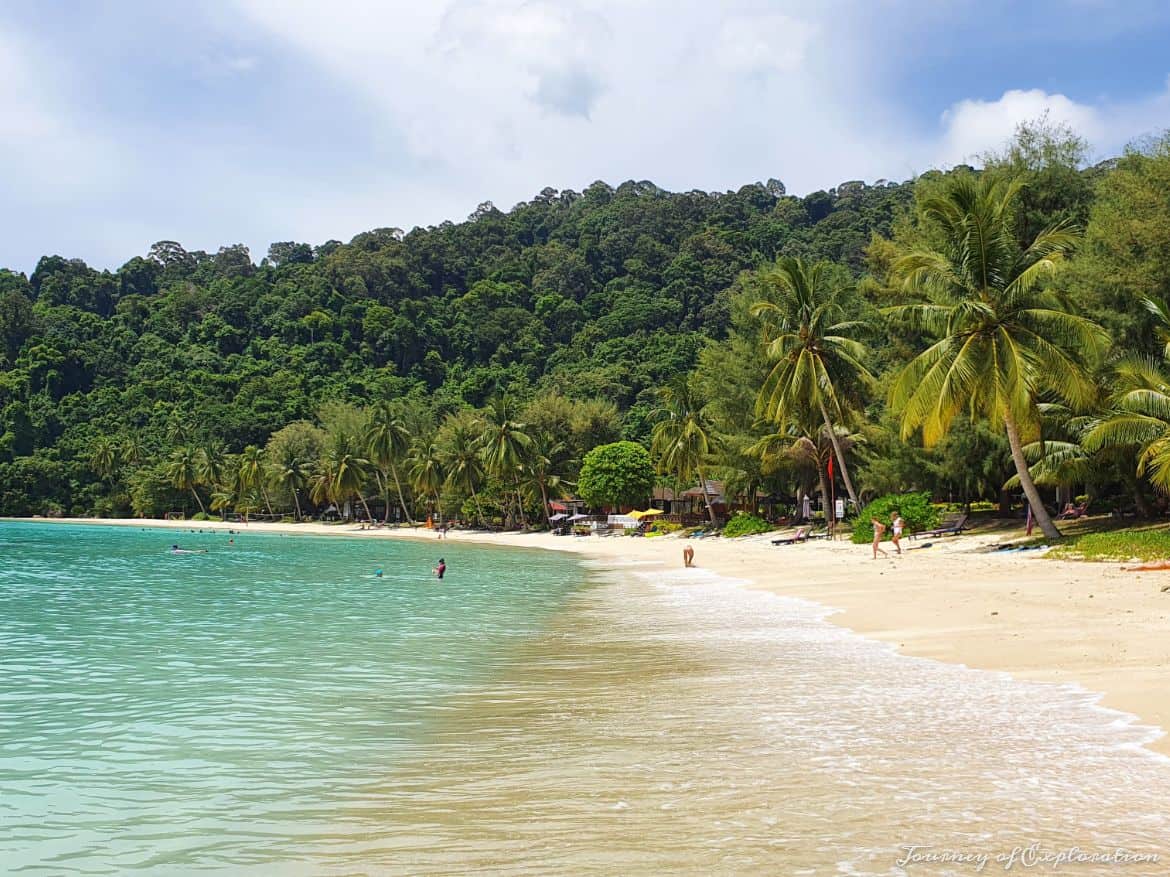
MALAYSIA TOURIST MAP
You can click on the map below for the location of the best attractions, restaurants & hotels, as well as the best places, islands and beaches to visit in Malaysia.
To save the map, make sure you are logged in to your Google account, then click on the star to the right of the title. To locate the map go to your Google Maps app (or Account), click on ‘Saved’ (or ‘Your Places’), and select ‘Maps’.
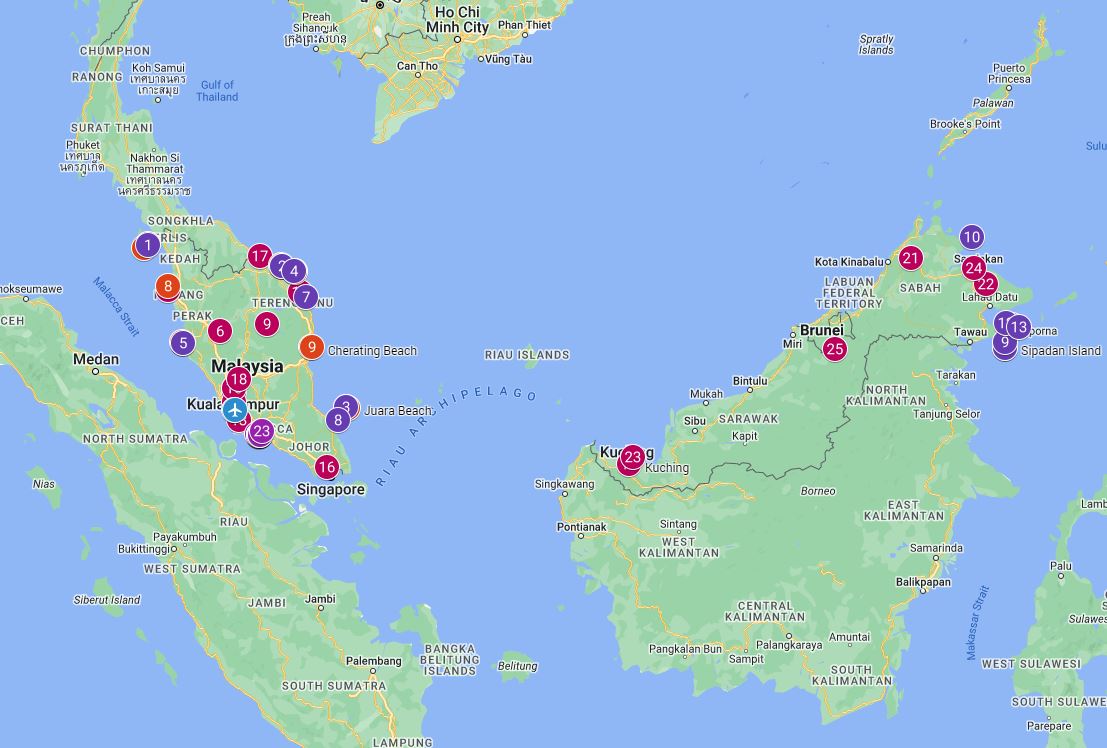
MALAYSIA ITINERARY
It is worth staying in Malaysia for 2 to 4 weeks if you want to explore both the East and West Coast of Peninsular Malaysia as well as Borneo . The following itinerary includes things to do for 3 weeks with additional days to explore Brunei and Singapore as optional trips. This itinerary is packed with a mix of city life, cultural exploration, nature adventures, and beach relaxation. Note that the pace is intense, so be prepared for early mornings and long days.
Day 1-3: Kuala Lumpur
- Morning arrival in Kuala Lumpur.
- Visit Petronas Towers and Suria KLCC Mall.
- Evening stroll in Bukit Bintang.
- Morning visit to Batu Caves.
- Afternoon exploring Merdeka Square, Sultan Abdul Samad Building, and National Mosque.
- Evening at Jalan Alor for street food.
- Day trip to Putrajaya
- Afternoon at the National Museum and Islamic Arts Museum.
- Evening at KLCC Park.
Day 4-5: Cameron Highlands
- Morning bus or drive to Cameron Highlands.
- Afternoon tea plantation tour.
- Morning jungle trekking in Mossy Forest.
- Afternoon visit to Butterfly Farm and Strawbery Farm
Day 6-7: Penang
- Morning bus to Penang.
- Afternoon exploring Georgetown.
- Morning visit to Penang Hill by funicular & Kek Lok Si Temple.
- Afternoon visit to Penang National Park and hike to Monkey Beach.
- Late swim at Batu Ferringhi Beach.
Day 8-9: Langkawi
- Flight or ferry to Langkawi.
- Afternoon visit to Langkawi SkyBridge.
- Morning island hopping boat tour.
- Afternoon at Cenang Beach & Tanjung Rhu Beach
- Evening visit to Eagle Square.
Day 10-11: Melaka (Malacca)
- Morning flight to Kuala Lumpur and bus to Melaka
- Afternoon exploring Dutch Square and Stadthuys.
- Morning visit to A Famosa Fortress and St. Paul’s Church.
- Afternoon at Jonker Street and Melaka River Cruise.
Day 12-14: Kota Bharu & Perhentian Islands
- Early Bus to the KLIA airport for flight to Kota Bharu
- Taxi ride or bus to Kuala Besut for the ferry to Perhentian Islands.
- Half-day boat tour of the islands with snorkelling.
- Explore Long Beach and Coral Bay.
- Afternoon ferry back to Kuala Besut and bus to Kota Bharu
- Explore the city
- Overnight stay in Kota Bhahru
Day 15-16: Kota Kinabalu, Sabah (Borneo)
- Fly to Kota Kinabalu in Sabah, Borneo.
- Afternoon city exploration.
- Full-day island hopping tour to Tunku Abdul Rahman Marine Park
Day 17-18: Sandakan (Borneo)
- Early flight to Sandakan
- Visit the Sepilok Orangutan Centre
- Full-day trip to Kinabatangan River for a cruise and wildlife spotting.
Day 19-20: Brunei
- Early flight to Kota Kinabalu
- And transfer to a flight to Bandar Seri Begawan in Brunei
- Explore Bandar Seri Begawan
- Late flight to Kuching
Day 21-22: Kuching, Sarawak
- Explore Kuching
- Visit the Sarawak Cultural Village
- Day trip to Bako National Park
- Late flight to Singapore
Day 23-24: Singapore
- Full day Exploration of the city
- Visit the harbour
- Late flight to your destination or back to KL
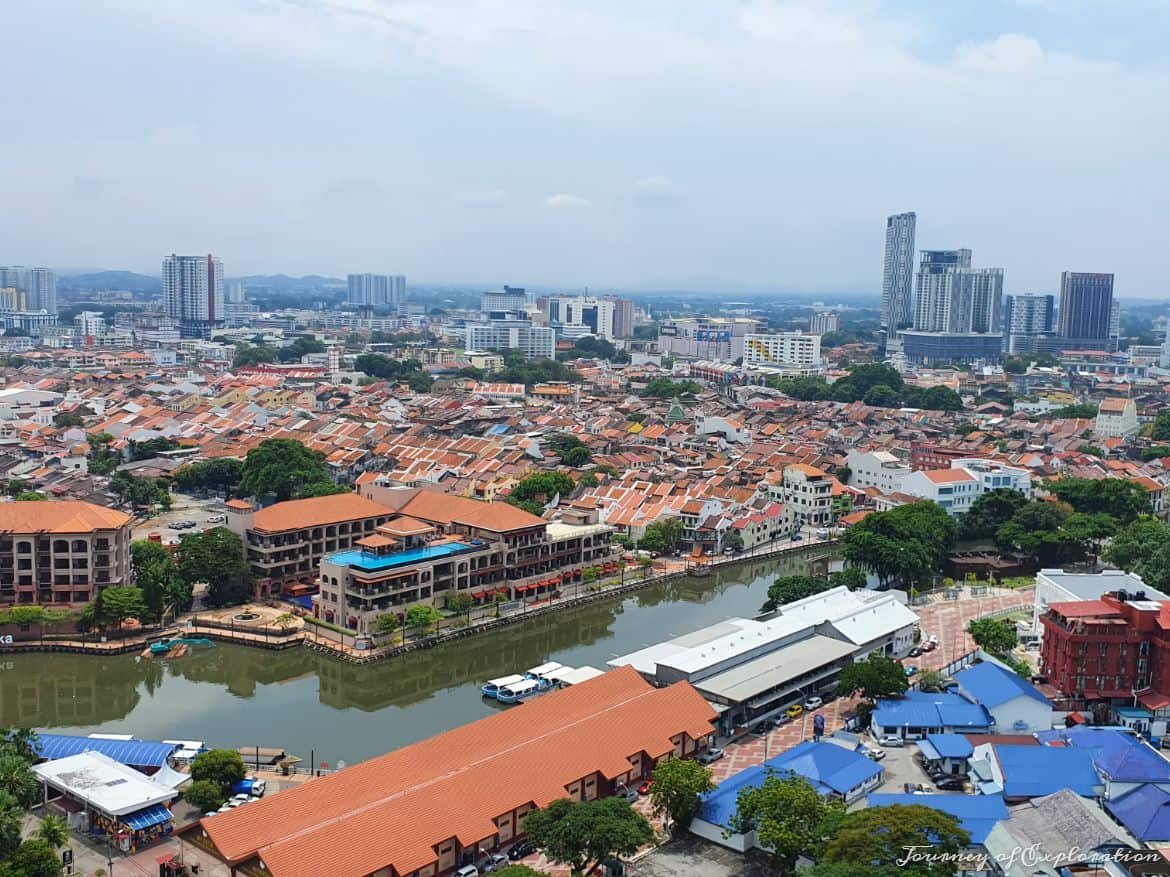
MALAYSIA PHOTOGRAPHY
You can check the best photographs from Malaysia here .
Here is a list of the best viewpoint locations in Malaysia where you enjoy great views .
- Petronas Towers Skybridge, Kuala Lumpur : While you can’t access the top floors, the Skybridge between the Petronas Towers offers stunning views of Kuala Lumpur.
- KL Tower, Kuala Lumpur: The observation deck at KL Tower provides a 360-degree view of Kuala Lumpur’s skyline.
- Penang Hill, Penang: Take the funicular train to the top of Penang Hill for panoramic views of Georgetown and the surrounding areas.
- Rainbow Skywalk, Georgetown : Located at the top of the KOMTAR building in Georgetown, this observation deck provides 360° of Penang,
- Langkawi Sky Bridge, Langkawi: A suspended bridge offering breathtaking views of the Andaman Sea and the lush rainforest below.
- Mount Kinabalu, Sabah : While reaching the summit requires a challenging climb, the lower viewpoints offer stunning vistas of the surrounding landscapes.
- The Shore Sky Tower, Melaka: One of the tallest buildings in Melaka with a rooftop observation deck providing amazing 360-degree views of the city and surrounding coast.
- Menara Taming Sari : A tower with a rotating observation deck in the centre of Melaka offering arguably the best city view (although not as high as the Sky Tower).
- Cameron Highlands, Pahang : The tea plantations and hills in Cameron Highlands provide picturesque views, especially at places like the Boh Tea Estate.
- Kek Lok Si Temple, Penang: The Kek Lok Si Temple complex offers stunning views of Penang from its hillside location.
- Batu Caves, Kuala Lumpur: Climb the steep steps to the entrance of the caves for a panoramic view of the city and the iconic golden statue.
- Genting Highlands, Pahang: The hill station is known for its cool climate and offers panoramic views of the surrounding mountains.
- Gunung Raya, Langkawi: The highest peak in Langkawi provides breathtaking views of the entire island and the Andaman Sea.
- Penang Bridge, Penang: Drive or walk along the Penang Bridge for impressive views of the island and the mainland.
- Broga Hill, Semenyih : A popular spot for sunrise or sunset hikes, providing sweeping views of the surrounding countryside.
- Bukit Taisho , Bahau : A nice hike near Bahau (Negeri Sembilan) with beautiful views from the top
- Alor Setar Tower : Located in Kedah, the tower’s observation deck offers panoramic views of the city and surroundings.
- Skyscape Johor Bahru (Menara JLand) : Located next to KOMTAR shopping centre in Johor Bahru, this observation deck offers a great view of the whole Johor Bahru City Centre and the straights of Johor.
You can check these viewpoints’ locations and the best photo spots on the island on the following map .
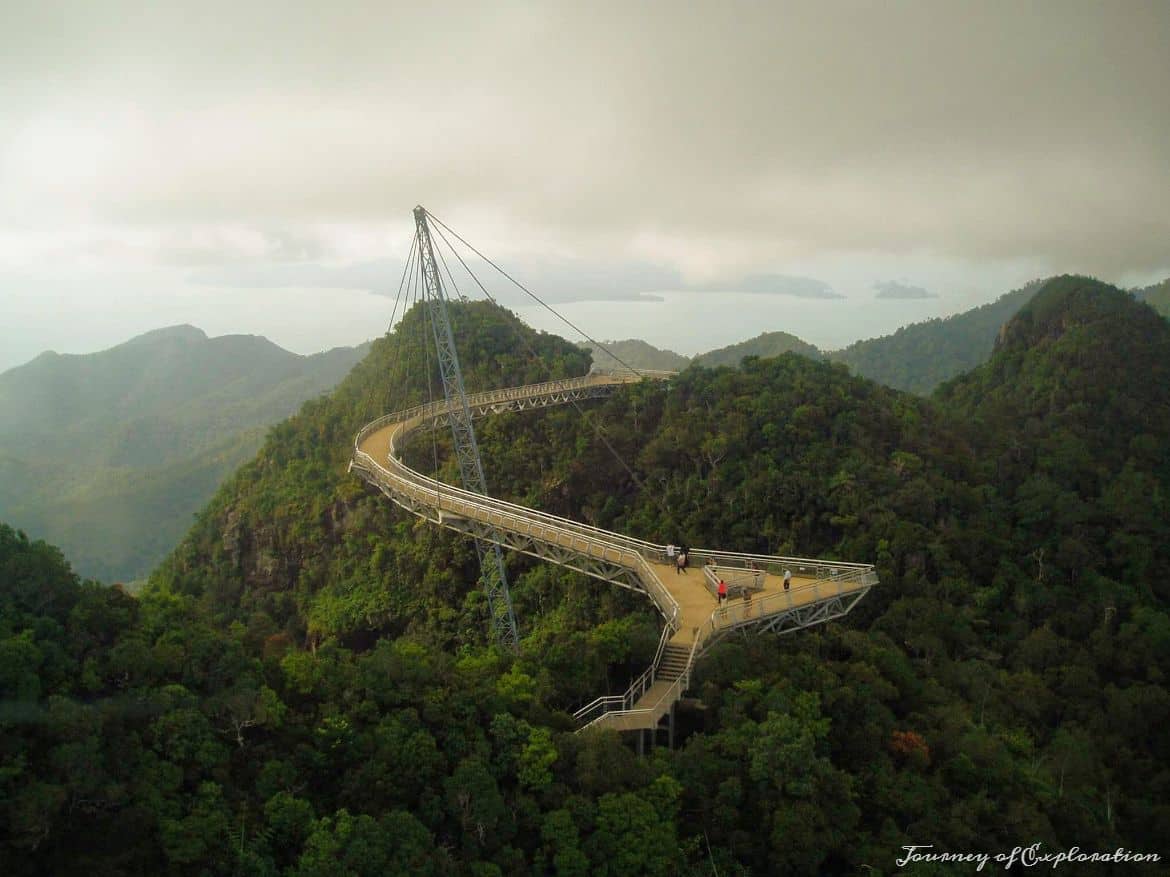
MALAYSIA ACTIVITIES
Malaysia is a great place for water activities like snorkelling , and scuba diving as well as hiking in the tropical rainforests. It is also a great place to encounter wildlife , like orangutans. Here are some popular activities you can enjoy in Malaysia
- Mount Kinabalu: A challenging climb to the summit rewards hikers with breathtaking sunrise views. For those seeking less strenuous options, explore the lower trails surrounding the mountain.
- Cameron Highlands: Choose from various trails that lead through mossy forests, waterfalls, and scenic landscapes, offering different levels of difficulty.
Water Activities
- Snorkelling and Scuba Diving: Explore the vibrant underwater world around Malaysian islands like Perhentian, Redang, and Tioman. Encounter colourful coral reefs, diverse marine life, and even shipwrecks.
- Kayaking: Paddle through the mangrove forests of Langkawi or explore the calm waters around Penang for a unique perspective of the coastal landscapes.
Wildlife Encounters
- Sepilok Orangutan Rehabilitation Centre: Located in Sabah, this centre rehabilitates orphaned orangutans. Witness feeding sessions and observe these remarkable primates up close.
- Bornean Sun Bear Conservation Centre: Learn about the world’s smallest bears and their conservation. Support the efforts to protect sun bears and their habitats.
Theme Parks
- Sunway Lagoon, Kuala Lumpur: A family-friendly destination with water slides, amusement rides, a wildlife park, and a scream park.
- Legoland Malaysia Resort, Johor: Ideal for families and Lego enthusiasts, featuring themed rides, a water park, and interactive Lego displays.
River Cruises
- Kuching: Embark on a river cruise along the Sarawak River to witness the city’s skyline and catch glimpses of proboscis monkeys along the riverbanks.
- Kuala Selangor: Enjoy a firefly tour along the Selangor River at night, witnessing the magical display of fireflies lighting up the mangrove trees.
- Hari Raya Aidilfitri: Also known as Eid al-Fitr, this Muslim festival marks the end of Ramadan. Malaysians celebrate with open houses, feasts, and vibrant cultural performances. It’s a time for forgiveness, reflection, and generosity.
- Chinese New Year: Celebrated with great enthusiasm, Chinese New Year marks the beginning of the lunar new year. Festivities include dragon and lion dances, traditional performances, and vibrant decorations. Chinatowns in cities like Kuala Lumpur and Penang come alive during this period.
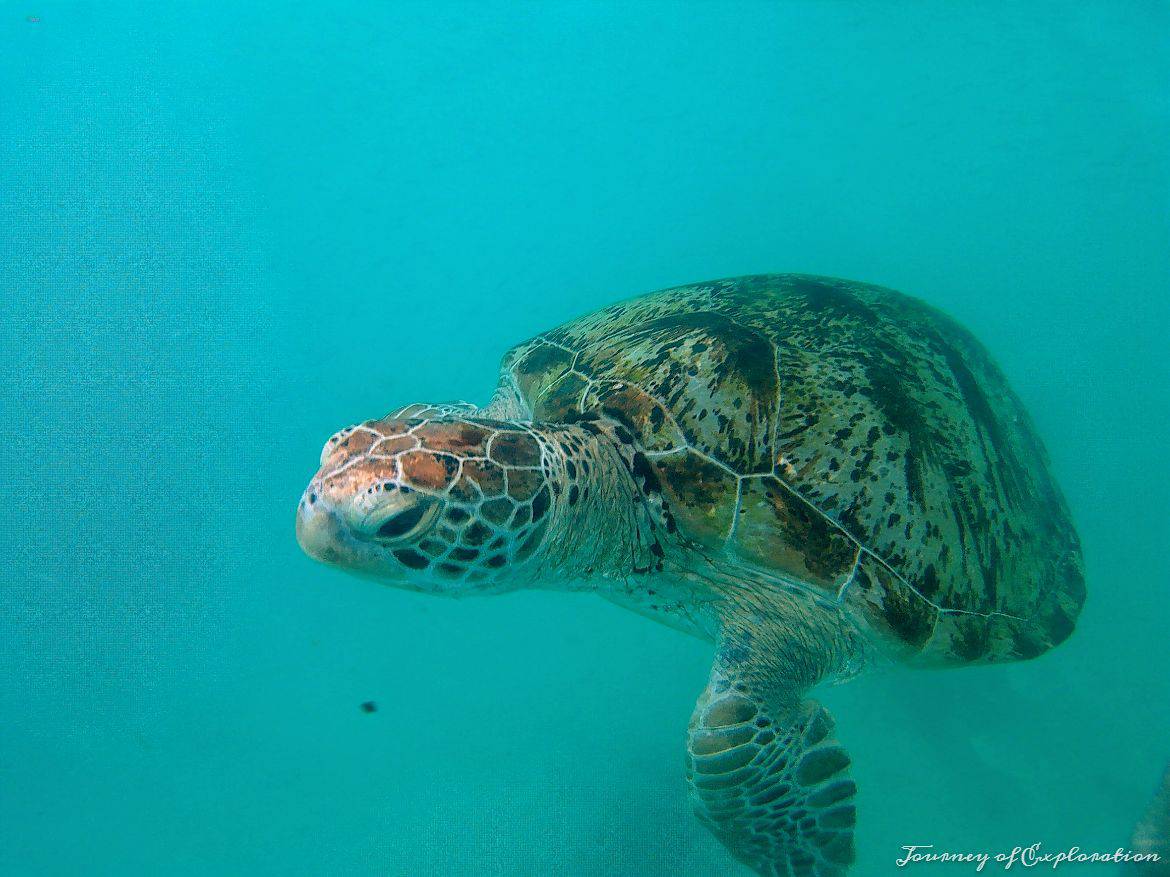
MALAYSIA TOURS
Explore the vibrant cities of Kuala Lumpur, Penang, and Malacca with guided city tours. Visit iconic landmarks, historical sites, and cultural hotspots while learning about the history and culture of each city. These are good options for someone without a car. Some of the best tours available are:
- Kuala Lumpur City Tour Full Day including Petronas Towers and Batu Caves (8 hours, $57)
- Private Tour Kuala Lumpur with Petronas Twin Towers Observation Deck & Batu Cave by private transport (8 hours, $110)
- Penang: Flexible 6-Hour Highlights (6 hours, $80)
- Malacca UNESCO “World Heritage Site” Day Trip from Kuala Lumpur (10 hours, $71)
- Free walking tours by GuruWalk
Nature and Wildlife Tours
Discover Malaysia’s rich biodiversity with nature and wildlife tours. Visit national parks like Taman Negara or explore the rainforests of Borneo to encounter unique flora and fauna, including orangutans, proboscis monkeys, and diverse bird species.
- Private Full-Day Sepilok Orang Utan, Bornean Sun Bear and Rainforest Discovery Center Tour from Sandakan in Sahbah (8 hours, $125)
Embark on culinary tours to savour the diverse flavours of Malaysian cuisine. Explore street markets, join cooking classes, and indulge in a gastronomic adventure with local dishes such as Nasi Lemak, Char Kway Teow, and Satay.
- Sambal Streets Kuala Lumpur Food Tour with15+ food tastings (4 hours, $49)
More information about excursions & tours in Malaysia can be found here .
SHOPPING & THINGS TO BUY IN MALAYSIA
Malaysia is a shopping paradise with a mix of modern malls, bustling markets, and vibrant street scenes. Bargaining is common in markets, especially at street markets. Don’t hesitate to negotiate for a better price. Here are some of the best places for shopping in Malaysia:
- Suria KLCC: Located beneath the Petronas Towers, it’s a high-end mall with international and luxury brands.
- Pavilion Kuala Lumpur : A popular shopping destination with a mix of luxury and high-street brands.
- Bukit Bintang : This area is known for its shopping streets, including Jalan Alor and Pavilion Kuala Lumpur.
- Central Market : A cultural and heritage market offering traditional Malaysian crafts, textiles, and souvenirs.
Malaysia offers a variety of unique products that make for great souvenirs and gifts. Here are some things to consider buying in Malaysia:
- Batik : Traditional Malaysian fabric with intricate patterns and vibrant colours. You can find batik clothing, scarves, and even art pieces
- Songket: A luxurious handwoven fabric often used for special occasions. It features gold or silver threads and intricate patterns.
- Sarongs: Colourful and versatile, sarongs are widely used in Malaysia. They make great souvenirs and can be worn as clothing or used as home decor.
- Pewter Products : Malaysia is known for its high-quality pewter. Look for pewter figurines, tableware, or decorative items from brands like Royal Selangor.
- Traditional Wooden Crafts : Handcrafted wooden items such as traditional Malaysian masks, carvings, and wooden batik stamps.
- Islamic Art: Malaysia has a rich Islamic heritage, and you can find beautifully crafted Islamic art pieces, calligraphy, and prayer rugs.
- Durian-flavored Snacks : While fresh durian might be an acquired taste, durian-flavored snacks like candies, chocolates, and cookies are popular and make for interesting gifts.
- Malaysian Tea and Coffee : Bring home local teas like Boh Tea from the Cameron Highlands or try Malaysian coffee, such as the famous Ipoh white coffee.
- Banana and Tapioca Crisps
- Traditional Malay Games : Unique traditional games like Congkak (a traditional mancala game) or Wau (traditional kites) can be fascinating gifts.
- Tropical Fruits and Snacks : Bring back local snacks like pineapple tarts, kuih (traditional Malay cakes), or dried fruits.
- Batek Prints : Batek is a traditional Malaysian art form involving hand-painted or block-printed fabrics. Look for clothing or wall hangings with Batek designs.
- Malaysian Spice s: Purchase a variety of local spices and spice mixes to recreate Malaysian flavours at home.
- Traditional Weapons: Items like keris (Malay dagger) or traditional weapons are available as decorative pieces and reflect Malaysia’s cultural heritage.
- Malaysian Gemstones and Pearls: Malaysia is known for its gemstones and pearls. Look for jewellery made from Malaysian jade, pearls, or other local gems.
- Nyonya Ware : Unique and colourful porcelain or ceramic kitchenware, often associated with Peranakan culture.
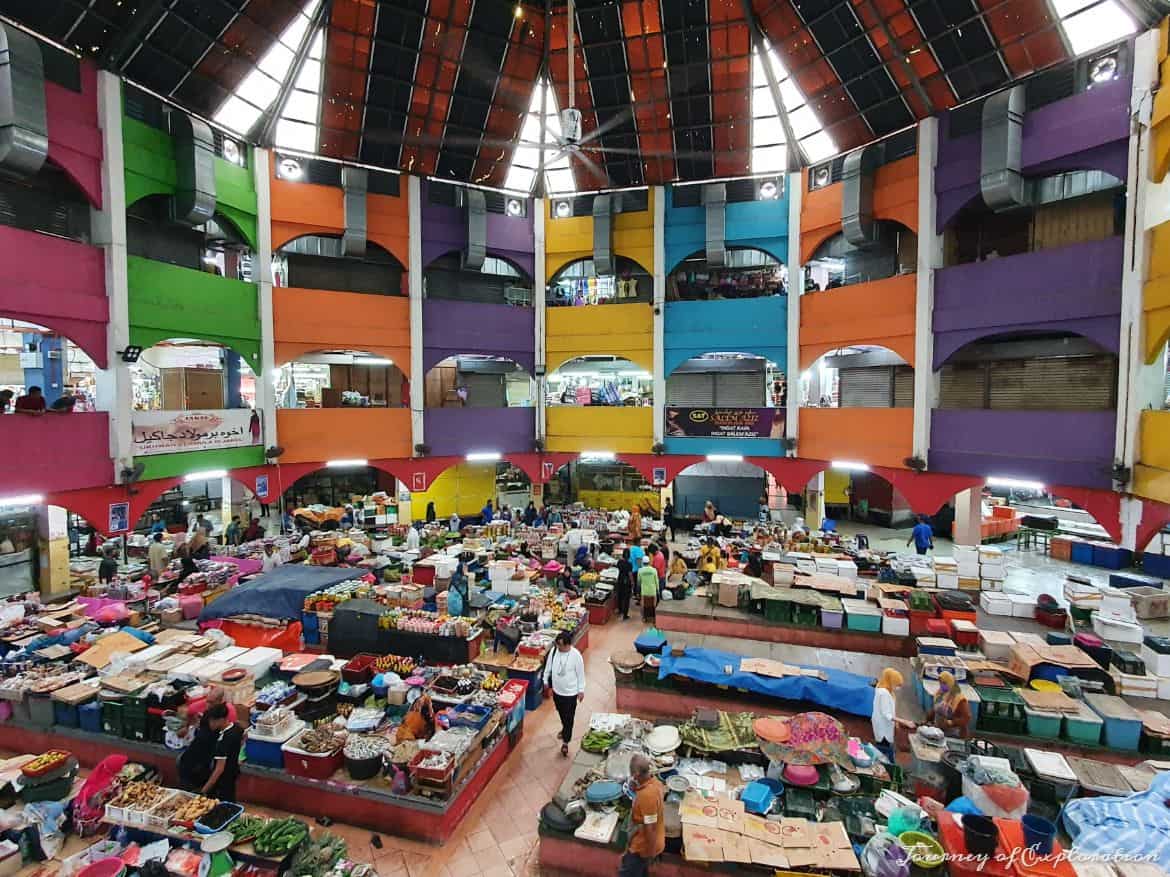
FURTHER READING
Some websites for more information about Malaysia:
- Malaysia Truly Asia : The official tourism website of Malaysia
Some good travel guides to buy before you visit Malaysia:
- The Rough Guide to Malaysia, Singapore & Brunei : It covers Kuala Lumpur, the west coast, the interior, the east coast, the south, Sarawak, Sabah, Brunei and Singapore
- Lonely Planet Malaysia, Singapore & Brunei : This is a comprehensive guide to Malaysia and is perfect for both exploring top sights and taking roads less travelled.
- DK Eyewitness Malaysia and Singapore (Travel Guide ): Another good guide with beautiful photos (also in Kindle).
TRAVEL RESOURCES
- Flights : I always use Skyscanner as my first choice as it’s so easy to use and you can search best deals by month. Google Flights is another very good search engine.
- Accommodation : I always use Booking.com as my first choice, as it offers a great choice of accommodation at affordable prices and it’s so easy to use. Airbnb is a great alternative for homes and apartments to rent by real homeowners. HotelsCombined is one of the best search engines to check deals from different websites.
- Car Rental : I always check Skyscanner for the cheapest car rental options. Discover Cars is also a good and easy-to-use website with great prices.
- Public Transport : You can use this website to check bus timetables on the island. Rome2Rio & 12go is a good website for checking prices & times on train and bus travel.
- Day Trips & Tours : Viator provides the most comprehensive list of day trips and you can book directly with them. GetYourGuide is also a great place to search for tours & activities to do.
- Travel Insurance : SafetyWing is a great choice for long-term travellers and digital nomads. Alternatively, you can use one of the price comparison websites for cheaper quotes.
- Disclosure : This post may contain affiliate links, and at no extra cost to you, I may receive a small commission if you make a purchase. I recommend only products and companies I use and the income goes to keeping this site running and ad-free.
Sharing is caring!
You may also like
Helsinki travel guide and things to do, antalya travel guide & things to do, wroclaw travel guide and things to do, things to do in kefalonia, kefalonia travel guide, turin travel guide and things to do, madeira towns & villages, things to do in jersey, madeira beaches, jersey beaches and bays.
Great summary of the beautifully diverse country, definitely cannot wait for my next trip there!
Leave a Comment Cancel Reply
Save my name, email, and website in this browser for the next time I comment.
This site uses Akismet to reduce spam. Learn how your comment data is processed .
This website uses cookies to improve your experience. We'll assume you're ok with this, but you can opt-out if you wish. Accept Read More
- Destinations

- Testimonials
- Meet the Team
- Work With Us
- Outlook Features
- Sign Up Today
- Travel Guides
- Middle East
Malaysia is not one to be missed, with its vibrant cities, lush rainforests, and delicious cuisine. Climb the Petronas Twin Towers in Kuala Lumpur, explore the ancient rainforest of Taman Negara, or taste the flavors of Penang’s street food. Discover what makes Malaysia a gem in the continent with our travel guide.
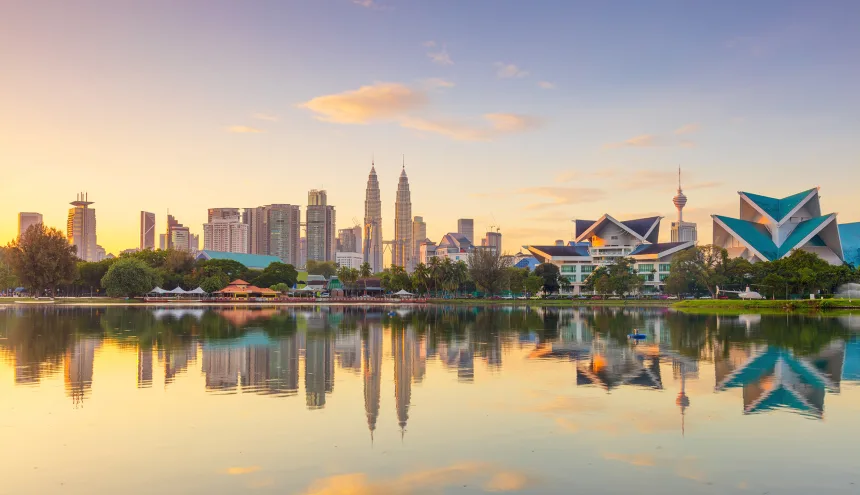
Malaysia Travel Guide
Malaysia is a melting pot with a unique culture, a world-renowned food scene and a spectacular landscape of islands, ancient rainforest and mountains.
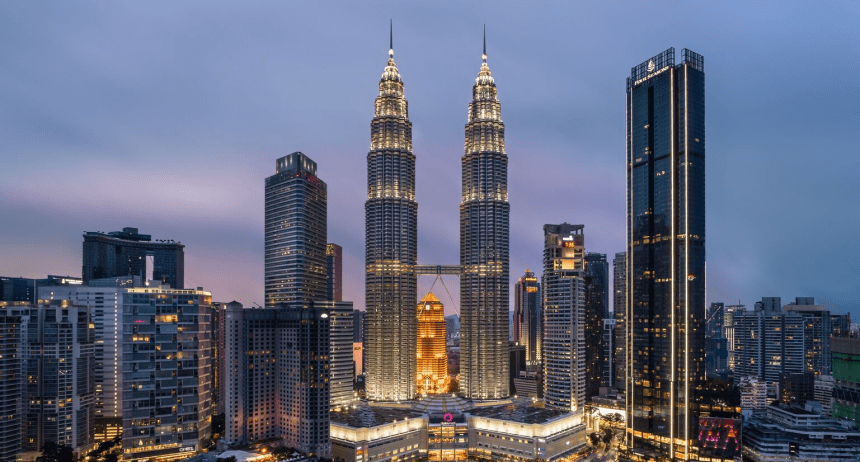
Kuala Lumpur In Focus
Kuala Lumpur is Malaysia’s intriguing capital known for its futuristic skyscrapers such as the Petronas Twin Towers.
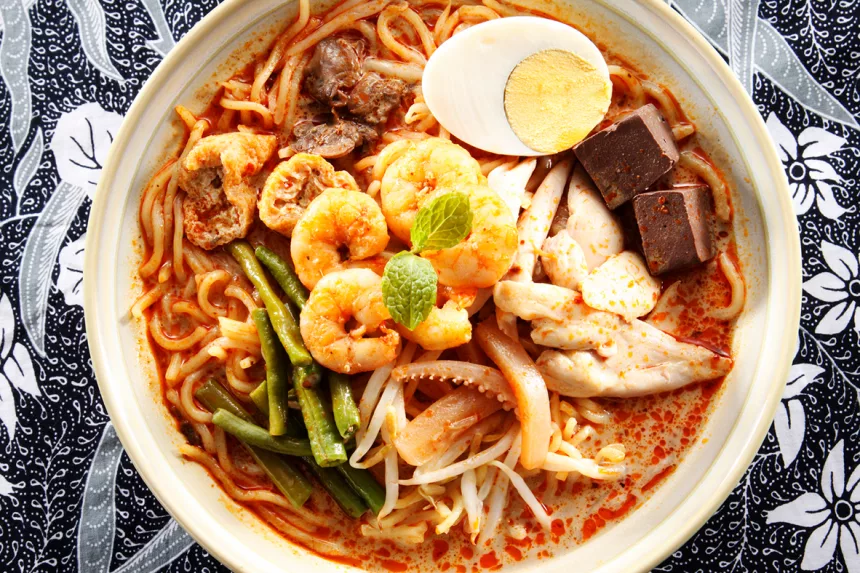
A Taste of Malaysia
From steaming bowls of Indian-influenced curry laksa to Chinese-inspired bah kut teh, the cuisine of Malaysia reflects its heritage.
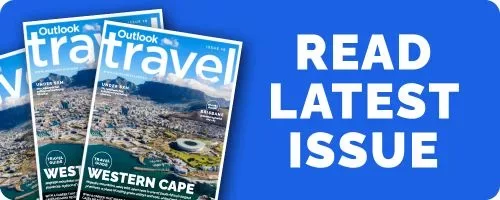
Langkawi Rainforest : The Travelogue
The Outlook Team explores the Langkawi Rainforest, and Malaysian escapism on the Langkawi archipelago.
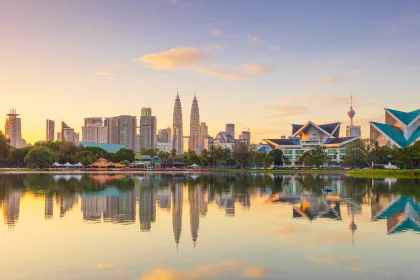
Sign in to your account
Username or Email Address
Remember Me
- Southeast Asia
Latest Articles
Borneo food: top dishes to try when you visit.

Visiting the Borneo Rainforest: All You Need to Know

The Borneo Sun Bear: Where to Find the World's Smallest Bear

The Best Hotels to Book in Sabah, Malaysia

What Are the Best Resorts in Malaysia?


The Best Hotels in Sarawak, Malaysia, for Every Traveller

The Best Hotels in Kuala Terengganu, Malaysia, for Every Traveller

The Best Hotels in Miri, Malaysia, for Every Traveller

The Best Hotels in Batu Ferringhi, Malaysia, for Every Traveller

Inspiration
Get inspired to travel. explore lgbtq+ travel experiences, hidden stories, and the unique attractions that make a destination worth visiting., how boat safaris are bringing tourism to borneo's most infamous beach.

The Hin Bus Depot: Penang’s Centre of Subculture

Reasons Why Borneo is an Ecotourism Paradise

Borneo: Explaining Which Countries Share the Island

11 Reasons Why Malaysia Is The Perfect Winter Escape

GoPro Malaysia

Freerunning across the rainbow steps of Batu Caves, Malaysia | GoPro Send It Worldwide

The Most Difficult Flag Quiz In The World

Things To Do
Plan your sightseeing and activities with our recommendations. explore attractions, book tours, and immerse yourself in the local culture., slide through the malaysian rainforest down the world’s longest water slide.

Try the Most Exhilarating Activities in Langkawi, Malaysia

Take a Walk With the Wildlife of Langkawi

Top 10 Things to Do in George Town, Penang

Top 10 Things to Do in Danum Valley, Malaysia

Top 10 Things to Do in Ipoh, Malaysia

Top 10 Things to Do in Cameron Highlands, Malaysia

The Ultimate Guide to Taman Negara Rainforest

Guides & Tips
Get expert guidance for your trip. from tips on packing to cultural etiquette, our travel advice will help you make the most of your journey., the solo traveller’s guide to borneo.

The 10 Best Co-Working and Study Spaces in Penang

The Ultimate Travel Guide to the Cameron Highlands, Malaysia

A Guide to Malaysia's States and Regions

Danum Valley: Borneo's Untouched Jungle Paradise

How to Get to Danum Valley, Malaysia

How to Spend 48 Hours in Cameron Highlands, Malaysia

How to Spend 24 Hours in Cameron Highlands, Malaysia

Immerse yourself in the local arts, literature, and design. Explore the cultural fabric of the destination through art, literature, and design.
Stay curious: experience malaysia from your living room.

7 Malaysia Locations Filmed in Crazy Rich Asians

The History of Malaysia's Orang Asli People

The Best Museums in Alor Setar, Malaysia

The Best Architecture in Alor Setar, Malaysia

Magunatip: Sabah’s 'Floating' Bamboo Dance

Ipoh's Historic Birch Clock Tower Controversy

The 10 Best Events at This Year's George Town Festival

Kuala Lumpur's 8 Best Contemporary Art Galleries

Places To Stay
Find the perfect place to stay. whether you prefer boutique hotels, luxury resorts, or budget hostels, we have recommendations for you., the best resorts to book in langkawi, malaysia.

The Best Hotels to Book in Penang, Malaysia, for Every Traveller

The Best Hotels to Book in Langkawi, Malaysia, for Every Traveller

Food & Drink
Explore the local culinary scene, from breakfast to michelin-starred restaurants. sip cocktails, savor desserts, and discover the best local markets., take a tour of green acres eco farm in malaysia.

The 10 Best Dessert Spots in George Town

The Best Nasi Lemak Spots in Penang

Where to Find the Best Desserts in Penang

The 10 Best Chinese Restaurants in Penang

The 10 Best Food Stalls in Malacca, Malaysia

The 10 Best Bars in Malacca, Malaysia

The 10 Best Dessert Spots in Malacca, Malaysia


Malaysia Travel Guide 2023: Everything You Need to Know When Travelling to Malaysia
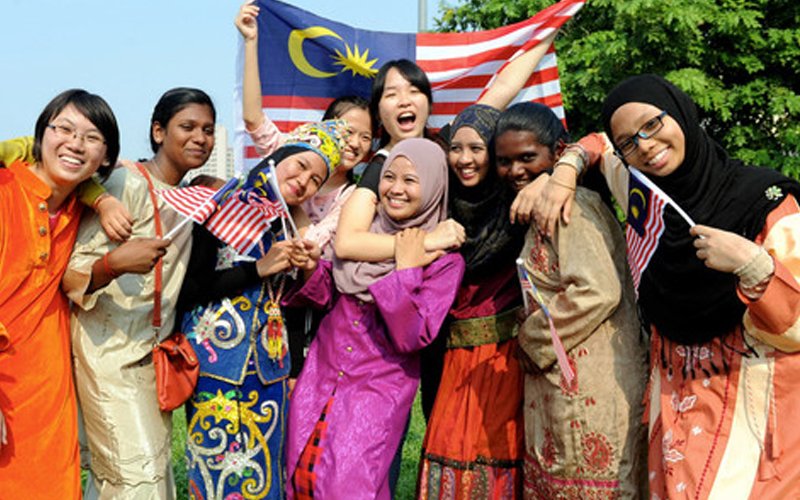
Filled with a blend of Malays, Chinese, Indians and indigenous groups, Malaysia boasts a rich cultural heritage, ranging from a plethora of annual festivals and scrumptious cuisines, to traditional architecture and rural crafts. Malaysia has plenty of alluring natural beauty to take in too, this includes pristine beaches and some of the world’s oldest tropical rainforests, many of which are accessible to tourists. Malaysia’s national parks are top-rate for trekking and wildlife-watching, and sometimes for cave exploration and river rafting.
Being part of the Malay archipelago, which stretches from Indonesia and all the way to the Philippines, Malaysia has become a vital port of call on the trade route between the early world’s two greatest markets—India and China.
As a matter of fact, Malaysia has only existed since 1963, when the federation of the eleven Peninsula states was joined by Singapore and two Bornean territories of Sarawak and Sabah. In 1965, Singapore left the union to become an independent country.
In the present day, the dominant cultural force in the country is Islam, a religion adopted by the Malays in the fourteenth century. Besides, there are also significant Buddhist, Christian and Hindu minorities who often provide surprising juxtapositions of mosques, temples, churches and quills.
Plus, the colour and verve of Chinese temples and street fairs, Indian festivals and everyday life in Malay villages, as well as the indigenous traditions of Borneo, it’s easy to see why foreign tourists are exceptionally drawn into this melting pot.

Table of Contents
Facts About Malaysia You May or May Not Know
- Home to 33.41 million inhabitants (as of January 9, 2023), Malaysia is divided into two distinct regions. Peninsular Malaysia, where the capital, Kuala Lumpur, is situated, is separated by over 600 km of the South China Sea from East Malaysia, comprising the states of Sarawak and Sabah on the very island of Borneo. Both regions are essentially one sea apart from each other.
- Malaysia is a British-style parliamentary democracy, consisting of a ceremonial head of state known as the Yang di-Pertuan Agung (the post will rotate amongst the sultans from each state of the federation).
- Rafflesia, or the world’s largest flower, is a Malaysian rainforest plant that measures a metre across and smells of rotten meat. It’s named after the naturalist and founder of Singapore, Sir Stamford Raffles.
- Historically dominated by agriculture and mining, Malaysia’s economy now features a healthy manufacturing sector.
Where to Go in Malaysia
A. kuala lumpur.
Malaysia’s capital city, Kuala Lumpur (locally referred to as KL), is the social and economic driving force of a nation eager for its own betterment, a fact apparent in the relentless proliferation of air-conditioned shopping malls, top-rated bars and restaurants in the city, and in the continuing sprawl of suburbia and industry surrounding it. However, KL is also strongly rooted in tradition, whereby the same Malay executives who go to work in traditional clothing at festival times, and roadside food stalls and markets are surrounded by high-rise hotels, bank towers and skyscrapers, especially in older towns such as Chinatown and Little India.
Only a couple of hours’ drive south of the capital spots the birthplace of Malay civilization, Malacca, whose astonishing historical architecture and vibrant atmosphere make it a must on anybody’s travel itinerary.
Much further up the west coast lies the island of Penang—the site of the first British settlement in Malaysia. Georgetown, its capital, still features beautifully preserved and restored colonial buildings and a mellow Chinatown district, and is, along with Melaka, recognised for its cultural and architectural diversity as a UNESCO World Heritage Site.
d. Cameron Highlands
If you want a taste of Old England, head for the hill stations of Cameron Highlands where cooler temperatures and lush countryside provide endless opportunities for walks, birdwatching, golfing and sipping on cream teas.
e. Alor Star
North of Penang, Malay traditions hold sway at Alor Star, the last major town before the Thai border. This far north, the prime tourist destination is Pulau Langkawi, an island with international-calibre resorts and picturesque beaches. Here are 10 reasons why you need to visit Langkawi .
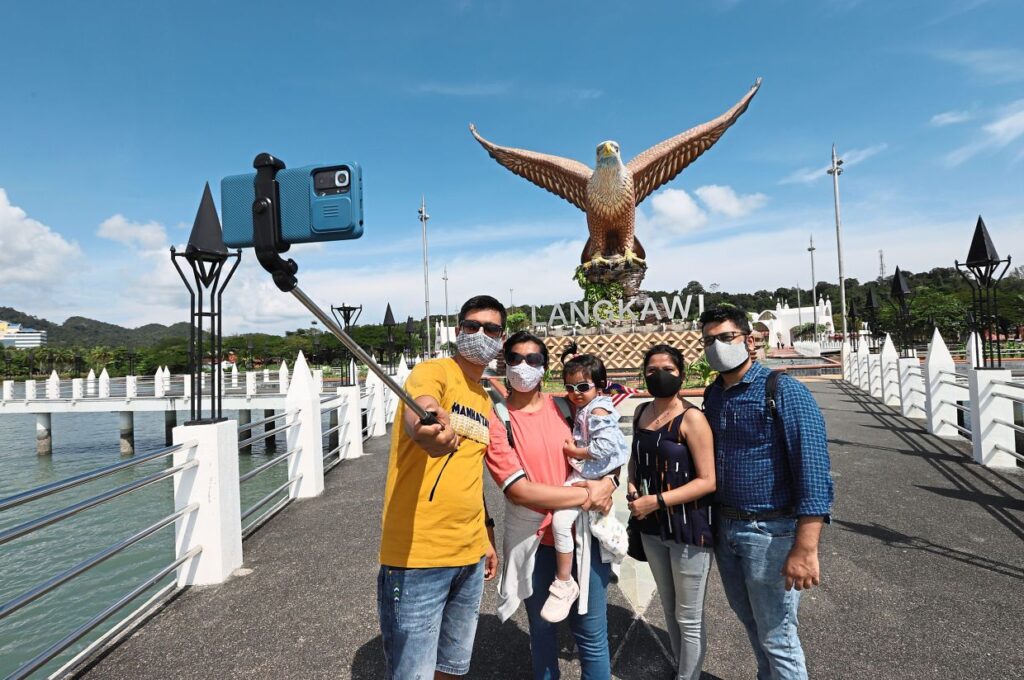
f. The East Coast
The Peninsula’s east coast is rather rural and serene, filled with rustic villages and astounding islands such as Pulau Perhentian and Pulau Tioman, a hotspot for backpackers and tourists alike. The state capitals of Kota Bharu, close to the northeastern Thai border, and Kuala Terengganu, further south, highlight Malay traditions at its finest, featuring craft production and performing arts.
g. Taman Negara
Traversing the Peninsula’s mountainous interior either by land or rail allows you to enjoy the magnificent tropical rainforests of Taman Negara. The national park’s 4000 square kilometres are interesting enough to keep you occupied for days: trails, animal-watching, aerial forest-canopy walkways, limestone caves, waterfalls, and so on and so forth. Here you will be welcomed by the Orang Asli, the Peninsula’s indigenous peoples, a few of whom still cling to a semi-nomadic lifestyle within the park.
h. Sarawak and Sabah
Across the sea from the Peninsula is where the east Malaysian states of Sarawak and Sabah are situated. The first taste of Sarawak comes at Kuching, the old colonial capital, and then the Iban longhouses of the Batang Ai river system. Much further north on the Ranjang River, Sibu acts as the starting point for trips to the less touristy Iban, Kayan and Kenyah longhouses. In the north, Gunung Mulu National Park is the main destination; many frequent here to climb up to view its extraordinary limestone Pinnacles, though spectacular caves also burrow into the park’s mountains. More remote is the Kelabit Highlands, further east, where the mountain air is refreshing and with endless opportunities to trek.
The reason why you should add Sabah in your itinerary is that you can conquer the 4095m granite peak of Mount Kinabalu, set in its own national park, though the vibrant modern capital Kota Kinabalu and its pristine offshore islands, Gaya and Manukan, have their unique appeals, too. On top of this, Sabah is worth visiting for its exhaustive wildlife: turtles, orang-utans, proboscis monkeys and hornbills are only a few of the exotic inhabitants of the jungle and bountiful islands. The far east at Pulau Sipadan is full of marine attractions, featuring a host of sharks, other fish and turtles whereas neighbouring Pulau Mabul boasts hip, but often pricey, diving resorts.
Check out things to do in Malaysia for more details.
Outdoor Activities in Malaysia that’ll Keep You Entertained for Days
Boasting some of the world’s oldest tropical rainforests, beaches and islands, trekking, snorkelling and scuba diving have since become common pursuits in Malaysia. You can find plenty of established resorts on the island of Penang, Tioman, and Langkawi who offer jet skiing and parasailing, making them a hot spot for nature lovers.
Langkawi’s private day resort—Paradise 101 offers bountiful water sport activities at competitive rates, including but not limited to jet skiing, parasailing, banana boat, aqua park, kayaking, together with other adrenaline-rushing outdoor activities such as zip lining across the mighty jungle and grooving beneath the gleaming stars at their OMG Bar. Bid a temporary fond adieu to the hustle and bustle of urban life, and take one step closer to nature as you indulge in Paradise 101’s all-inclusive Langkawi tour packages.
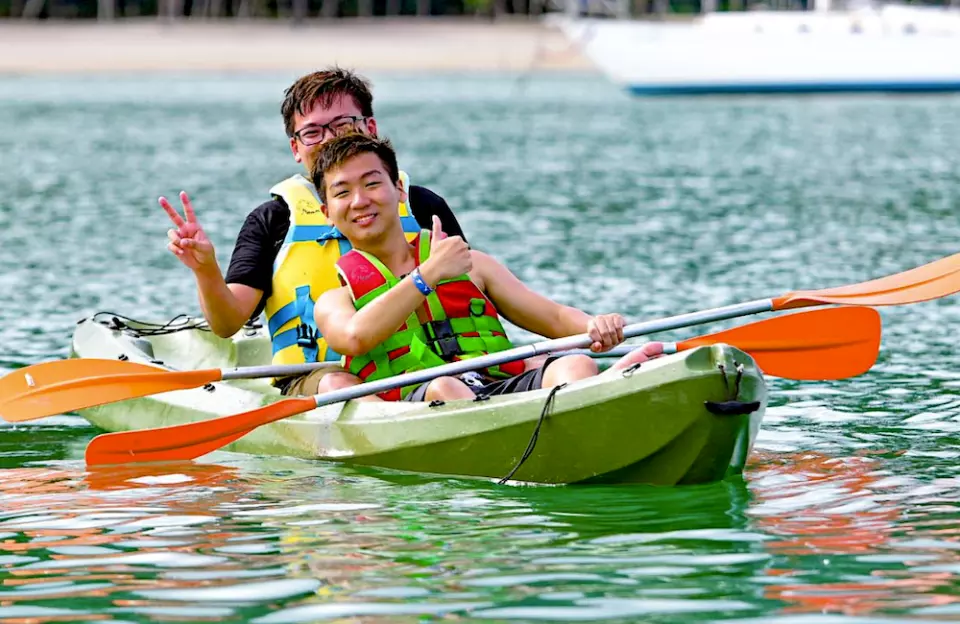
Book Your Experience Today!
a. Snorkelling, diving and windsurfing
The crystal-clear waters and plentiful tropical, marine life and coral of Malaysia are what make snorkelling and diving a must-do activity, this is especially when you’re an underwater enthusiast. You can experience this in Sabah’s Sipadan Island Marine reserve and the Peninsula’s east coast, with islands such as the Perhentians, Redang, Kapas and Tioman.
Enrol yourself in diving courses. Sabah’s Kota Kinabalu and Sarawak’s Miri for instance, offer some of the most wholesome internationally recognised certification courses, featuring a beginner’s open-water course (around RM1,300), to the dive-master certificate (RM 2,200). If you’re already a qualified diver, you can proceed to pay RM180 per day for dive trips that include gear rental.
Many beachside guest houses rent snorkelling equipment for about RM20 per day. Some well-known snorkelling spots mark out lanes for motorboats with buoy lines—remember to stay on the correct side of the line to avoid unwanted accidents. Always seek local advice if you’re not sure which river or sea to swim or snorkel. Stay away from corals if you want to avoid irreparable damage such as the armour-piercing spines of sea urchins or a painful encounter with the fire coral.
You can experience windsurfing in Cherating. Its expansive, open bay and shallow water provide near-ideal conditions during the northeast monsoon season.
b. Whitewater Rafting
Whitewater rafting has become a mainstream activity on Sabah’s Sungai Padas which runs through the spectacular Padas Gorge. If you’re planning to raft in Peninsular Malaysia, we recommend that you go with an operator that’ll cost you around RM250, including equipment.
c. Jungle Trekking
If you’ve been dreaming of jungle trekking through the mighty jungles of Malaysia, Taman Negara is probably the best place to begin. The national park boasts an impressive range of walks, many of which can be done without a guide, while Bako National Park in southwest Sarawak offers easy, day-long hikes.
In contrast, if you’re an expert, Gunung Mulu, Sarawak, should offer you sufficient challenges whereas Sabah’s Maliau Basin is a highly demanded trekking destination. The largely inaccessible Endau-Rompin Park in the south of Peninsular Malaysia is exclusively for serious expeditions only. Taking jungle trekking to another level, we have Mount Kinabalu in Sabah—the hike to the top of its mountain is a demanding but a highly rewarding combination of trekking and climbing.
Wildlife in Malaysia
Peninsular Malaysia and Borneo are known for being a paradise for wildlife-enthusiasts, harbouring over 600 types of birds and 200 mammal species—this includes Asian elephants, sun bears, tigers, tapirs, barking deer, gibbons, hornbills as well as pythons. Other wildlife you will stumble upon are the nose-drooping proboscis monkey, orang-utans, white-tip sharks, clown fish and barracuda, not to mention the green and hawksbill turtles, which lay their eggs by night ashore in season.
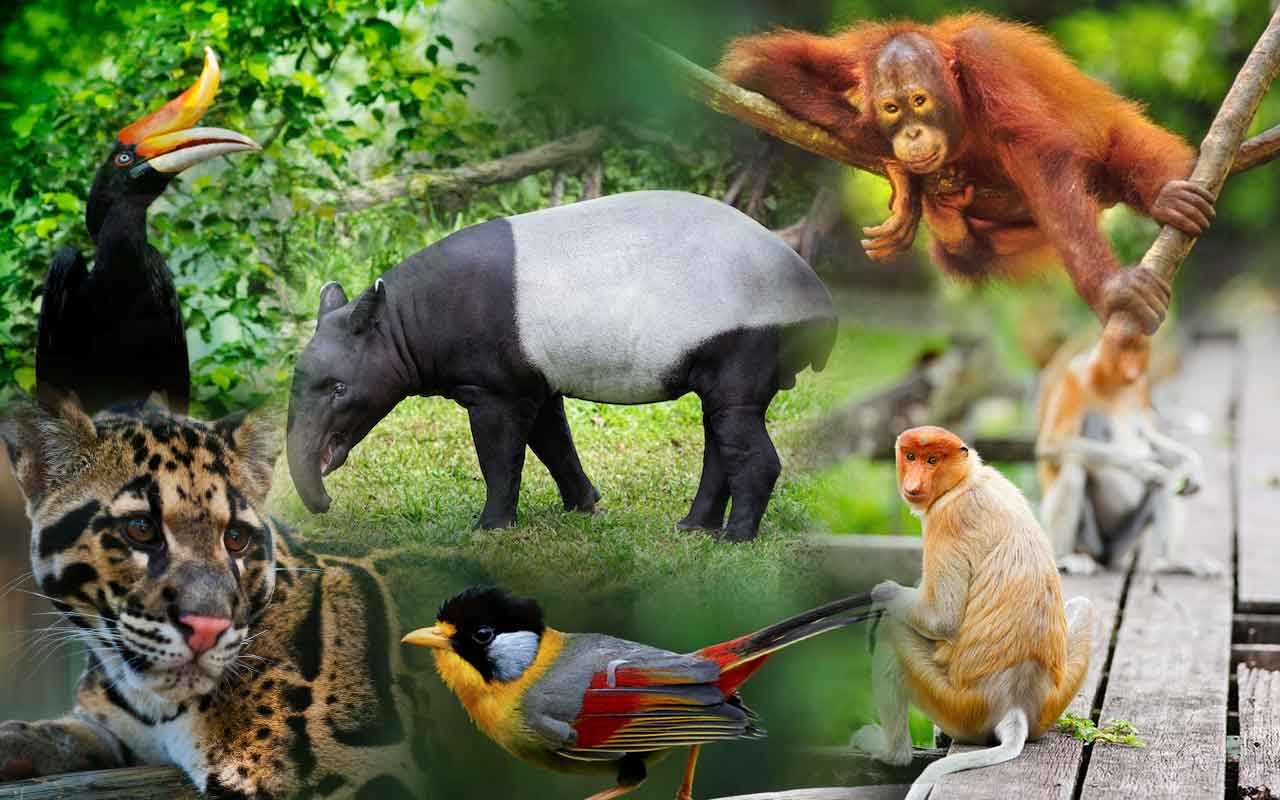
Malaysia Travel Guide: How to Save Money
A little typically goes a long way in Malaysia, but it’s still easy to exceed your budget here if you splurge on lavish meals and tours. Here are some money-saving tips you can follow in Malaysia:
- Use Grab – E-hailing service Grab is just like Uber, much often cheaper than taxis, especially if you’re getting a ride from any airports in Malaysia. Just download the app and you’re set to book your cab!
- Eat street food – Street stalls are where you can get a taste of Malaysia’s authentic, local flavours. The best thing about these hawker food and meals is that it’ll only cost you a few bucks.
- Drink moderately – As Islam being Malaysia’s official religion, drinking is basically frowned upon, but pubs and bars are still widely available. To restrict it, the authorities have made drinking very expensive. So if you really want some booze, take it moderately so it doesn’t wreck your budget.
- Travel during off-season – Traveling during the monsoon season (late November to mid-February) is one of the ways to save money on flights and accommodation. With significantly fewer visitors, this also means that everything is cheaper. To stay away from the worst of rains, skip the east coast.
- Escape the city – Many of the popular tourist attractions in Kuala Lumpur are designed for tourists hence the high price points. We highly recommend you to skip the crowds and head to somewhere such as Langkawi, a faraway island where you get to explore clear waters, pearl white sand, and ancient rainforest idyllic in its natural beauty.
How to Get Around Malaysia
Public Transportation – Most cities in Malaysia boast an excellent public transport infrastructure, this is more prominent in Kuala Lumpur where buses, light rail, commuter rail, and monorail are connected to every part of the city. A ride will cost you anywhere from 1 MYR-15 MYR. Should you plan on mostly utilising public transport, we recommend you to pick up a Touch ‘n Go (TnG) card to use on all modes of public transportation, allowing you to save up to 20% per ride.
Bus – Buses are an easy and efficient means of transport that brings you around Malaysia. Expect to pay around 5 MY – 5 MYR per hour for a bus trip. Some of the well-known bus companies include Transnasional. Plusliner, Aeroline, SP Bumi, Mutiara Express, etc.
Train – Mainland Malaysia has 1,849 kilometres (1,149 miles) of rail, with the main line connecting Singapore to Kuala Lumpur, and all the way to Thailand.
There are two various types of service: air conditioned, express trains with three different classes as well as local trains, which are slower than the former. Both are operated by Keretapi Tanah Melayu (KTM), Malaysia’s national railway service.
Flight – The two leading domestic airlines in Malaysia are Malaysia Airlines and AirAsia. Kuala Lumpur’s two airports (KLIA and KLIA2) receive the most flight traffic, followed by Kota Kinabalu and Penang. There are also several smaller airports around the country as well, such as Langkawi International Airport, Kuantan Sultan Ahmad Shah Airport, and so on and so forth.
Best Time to Visit Malaysia
Malaysia’s two peak seasons occur from the beginning of December to the end of January, and then, from June to mid-September. The first tourist peak season occurs during Lunar New Year. Malaysia’s Chinese population celebrates by taking the week off so your travels could be disrupted if businesses are closed.
Late November to mid-February signifies the arrival of the northeast monsoon, affecting most, if not all of the east coast with heavy rainfall. September and October are considered the wettest months on the west coast, featuring downpours which can sometimes go on for hours. This is most prominent in mountainous areas such as Genting Highlands and Cameron Highlands.
Overall, the best time to visit Malaysia is from March to early November when it’s drier and less humid. To travel Malaysia right after the rainy season is actually a smart idea, as it’s still warm, the countryside embraces lush greenery and expansive waterfalls, and most importantly, tourism isn’t overly busy.
Check out the best time to visit Langkawi here .
In general, temperatures don’t fluctuate much across the country. The daily average is 22-32°C or 73-90°F, while in the hills the temperature stays on an average of 21°C or 67°F. Humidity is high all year round.
Where to Book Your Trip in Malaysia
Paradise 101 – Malaysia boasts 878 beautiful islands that are perfect for an ideal beach holiday, one of them is Langkawi. Paradise 101 offers some of the best outdoor activities there is in Langkawi, ranging from banana boat rides to jet skis, kayaking to parasailing, and so on and so forth. Whether you’re looking for an invigorating day out in the sea, or a tranquil day out by the beach, this private day resort will ensure you a tropical escape that’s second to none.
Get Your Guide – Get Your Guide is a huge online marketplace filled with tours and excursions. They provide a myriad of tour options available in cities all over the world, including sightseeing, street art lessons, and so much more!
Intrepid Travel – If you wish to do group tours with a travel guide person, opt for intrepid. They offer interesting small group tours that rely on local operators at extremely competitive rates!
Related Posts
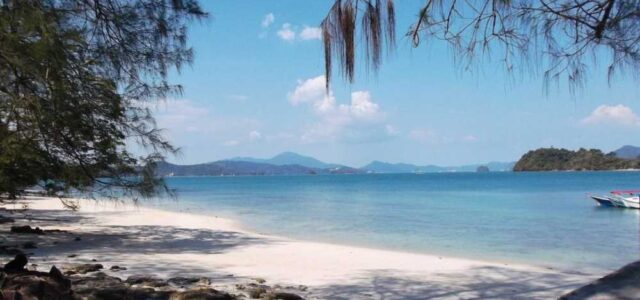
You will be redirected to your dashboard shortly. We will also call you back in 24 hrs .
- Island Hopping, Ziplining, Sightseeing, & Duty-Free Shopping: This Malaysia Travel Guide Has It All!
27 Mar 2023
Striking cityscapes, sandy beaches, and pristine islands were all that I had heard about Malaysia till I saw it all for real on a holiday there in October. I was pretty excited about my Malaysia trip; the itinerary of which was quite packed with lots of interesting and thrilling activities, all thanks to Tourism Malaysia. This trip was 6 days of unlimited fun and limited sleep. With flights in the air, scooters on land, and jet skis on the water, I traversed from India to Malaysia on one of my best trips till date. Have a look at this ultimate Malaysia travel guide and I bet you’d be already planning yours!
Itinerary Of 6 Days Trip To Malaysia
Day 1: Arrival at Kuala Lumpur and city sightseeing Day 2: Transfer to Genting and Genting attractions Day 3: Arrival at Langkawi and duty-free shopping Day 4: Island hopping via jet ski tour Day 5: Ziplining and sunset cruise Day 6: Arrival at New Delhi
Weather In Malaysia In October
I covered Kuala Lumpur, Genting Highlands, and Langkawi on this trip to Malaysia, and the weather was different at all the three places. The temperature was moderate and humid as it was raining in Kuala Lumpur in October. Genting Highlands was much cooler in comparison to KL, but one didn’t really need thermals. It was a pleasant weather in Genting in October. While it was quite warm in Langkawi with temperatures ranging from 25°C to 31°C.
My Experiences On A 6 Day Trip To Malaysia
I visited Malaysia in October, and it was one amazing trip organized by Malaysia Tourism. With 9 other individuals on this trip, I had an amazing time seeing the best of Malaysia and staying at some of the most beautiful properties, enjoying the food at the best restaurants and a lot more. Read on to know what this 6 day trip to Malaysia had in store for me.
1. Kuala Lumpur Sightseeing
My trip to Malaysia began with a little over a 5-hour flight from New Delhi to Kuala Lumpur and I was pretty excited about it. After settling at the hotel and having lunch there, I headed for the first attraction of my 6 day Malaysia trip which was Batu Caves . These were a series of caves and cave temples which had 272 colored steps to reach to the top. The first site of this attraction was the golden gleam of the beautiful Lord Murugan statue , which also happens to be the world’s tallest Murugan statue, standing tall at a height of 47.2 mts. The climb was a bit tedious but the temples and the views from atop were beautiful. The temple complex below and the openings above in the limestone caves, from where the light peaked in, looked lovely after the climb.
After Batu Caves, I headed to the Central Market , which was quite close to Chinatown. The first thing that I noticed around Central Market was the graffiti, both interesting and vibrant. The Central Market itself is a heritage building in Malaysia and houses over 300 shops that have art, culture, food, and experiences. My favorite stop at this market was the Fish Spa , which was a first time experience for me. Ticklish in the beginning, it was fun after the initial one or two minutes. The market also had Batik paintings, souvenirs and other artsy stuff including bundles of postcards in the form of old printed photographs.
The next stop was a crossroad from where I got the perfect view of the Petronas Twin Towers , the tallest building in the world till 2004, and the tallest twin towers till date. After clicking a few pictures with this beauty, I headed to another famous tower of Kuala Lumpur, Menara Kuala Lumpur . Here I had dinner at Atmosphere 360, which is a restaurant 282m above ground level and with the look of a spaceship. Later I also went to the observation deck from where I enjoyed breathtaking views of the city of Kuala Lumpur. This was all that Kuala Lumpur sightseeing had in store for us.
19 Best Places To Visit In Kuala Lumpur In 2022: The City Of Lights
2. A Day At Genting Highlands
No Malaysia travel guide is complete without a mention of Genting Highlands. And another highlight of my 6 day Malaysia trip was a day at Genting Highlands . A hill resort in Malaysia, Genting is a great add on to one’s itinerary. The winding roads and green sideways made the journey even more beautiful. Genting is another world in itself with loads of indoor and outdoor activities. The outdoor theme park was closed at the moment, but that did not stop me from having fun.
The tour started with lunch at Jom Makan Street Food , where I had tasty South Indian food. The next stop was the Sky Symphony show , which is also the only free thing to enjoy at Genting Highlands. It is a visual marvel, a storytelling in the sky with the help of thousands of balls that dance in the sky and is quite entertaining. Next, I headed to experience The Void , which was a thrilling virtual reality experience. Based on Hollywood storylines, there are different missions and one can experience it in teams of 4. It was one of the most thrilling experiences of the entire trip.
The day did not just end here, as I was still to experience the exciting ropeway of Genting. And soon I started the descend to Chin Swee Temple in Genting. It began to rain as soon as I took our glass-bottom gondola. The views of the dense green forest below and all around were terrific. The glass bottom of the gondola added to the thrill, and the environs turned misty and beautiful. By the time I reached the temple, the clouds cleared a bit, and I got amazing views of this 9 storey Chinese temple. This was one of the most picturesque sites of Genting.
The day at Genting ended with a visit to the Snow World where one could enjoy tobogganing & click pictures inside igloo houses.
7 Nature Suffused Soul Enchanting Hill Stations In Malaysia
3. Cenang Walking Tour
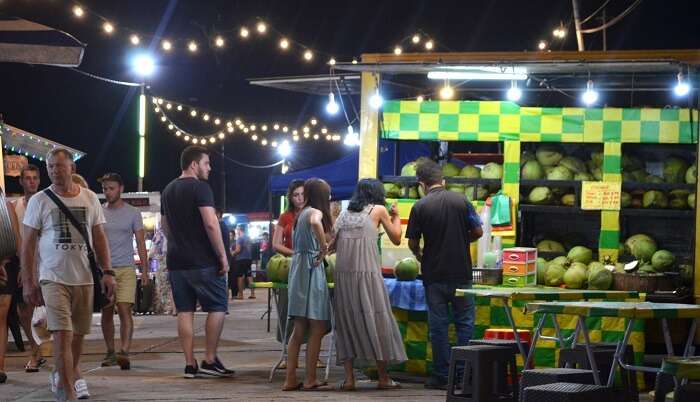
If you are looking for some duty-free shopping, then the duty-free stores at Langkawi are the best places to buy chocolates, liquors, and cigars . Liquor is quite cheaply priced and there is quite a variety of chocolates available. Right outside the duty-free stores which are located at Cenang street, there are a number of stores for street shopping in Langkawi. One can get s ouvenirs, local jewelry, craft items, clothes, perfumes and quirky bags at these stores. There is a sidewalk too with a number of food trucks in Cenang , where one can enjoy the local food of Langkawi.
A Complete Guide For A Trip To Langkawi Island In 2022
4. Island Hopping On A Jet Ski
Langkawi, an archipelago of 99 islands, is drop-dead gorgeous. The clear blue waters, white-sand beaches, and dense green environs, all add to the magnificence of this archipelago. 4 out of a total of 99 islands are inhabited here and on a 4 hour Jet Ski tour with Mega Water Sports , I went island hopping to some inhabited while some unoccupied islands. The first stop was the freshwater lake of Dayang Bunting which is also called the Lake of the Pregnant Maiden. A short hike took us to this beautiful lake that was surrounded by dense forests and had refreshing cool water.
After a swim here I proceeded to the mangroves and limestone caves and later stopped at a remote island before I finally headed back for the mainland. The instructor was quite patient and gave the instructions well before the tour began. All in all, it was quite an adventure and the best way to explore different islands of Langkawi.
27 Exotic Places To Visit In Langkawi For Soaking In The Soothing 2022 Malay Vibes
5. Sky High Langkawi Cable Car
Langkawi isn’t just about the blues and the depth of the sea, but it is also about the mountains and scaling heights. The highest cable car of Malaysia, Langkawi Cable Car takes one through the eastern cliffs of Mt. Machinchang, above the lush green forests. The observation deck offered views of the most pristine sunset. One can even have a wedding here, atop the world, in the clouds, and lock vows and promises forever and put a marriage lock at the bridge here.
The sunset scenes from atop were the most beautiful of this 6 day Malaysia trip. The Sky Bridge was closed for safety reasons as it was drizzling, but the mere sight of it was thrilling and exciting. I would love to go back to Langkawi, just to walk on the Langkawi Sky Bridge.
10 Best Things To Do In Langkawi That Make It A Traveler’s Paradise
6. Ziplining Through The Langkawi Rainforest
Another amazing experience in Langkawi was ziplining through one of the oldest rainforests in the world. And Umgawa Legendary Adventures made it possible with complete assistance, amazing guides, and entertaining time through the 12 ziplines and 3 bridges that took around 2.5 hours to finish. It was great fun soaring from one end to another at the highest being 80 meters above the ground and catching glimpses of the Andaman Sea faraway. The descent was made by abseiling which was equally fun.
8 Places Every Backpacker Must See On Their Trip To Malaysia
7. Music And Dance At The Sunset Cruise
The 6 day Malaysia trip ended with a lovely evening on a cruise ship. I rushed to the cruise ship in a smaller boat as I had missed it at the dock. The speedy boat ride was quite thrilling and once onboard, I was greeted with friendly smiles and drinks. The cruise took us around in the calm waters of the sea and as the sun went down, the energy levels on the cruise ship rose. There was music, dance, and food and as everyone danced to some Bollywood music, that evening, I ended the trip on a memorable note.
Hotels in KL, Genting And Langkawi
I stayed in 3 different hotels on our 6 day Malaysia trip. The first one was the Tamu Hotel & Suites in Kuala Lumpur . It was a nice property with helpful staff. The views from the rooms were amazing and I could see both KL Tower and Petronas Twin Towers. The rooms were also quite spacious with air conditioning and WiFi facility. There weren’t a lot of food options for vegetarians the first day at lunch, but the manager was kind enough to specially get fried rice cooked for us, which was delicious.
The next place where I stayed on my Malaysia holiday was at Genting Highlands at Resorts World Genting . I got the Deluxe room which was later upgraded to Superior Deluxe. The Deluxe rooms though small with approx. 180 sq ft space had WiFi and no views available. The Superior Deluxe on the other hand with approx. 320 sq ft space, had beautiful views of the winding roads leading to Genting Highlands but no WiFi. So, get your priorities straight before you choose the room here.
The last place where I stayed was at The Frangipani Langkawi Resort & Spa in Langkawi. I stayed in the Deluxe Rooms which were the most basic at this lovely property. The Frangipani Langkawi Resort & Spa was a beachfront property where I didn’t get a lot of time to spend, but overall it was a beautiful and clean space. I was welcomed with garlands and a welcome drink, and everyone was helpful at the property.
Food In Malaysia
If you are a vegetarian, then food can be a bit tricky, especially when traveling during off-season periods because buffets do not have a lot of vegetarian options in Malaysia. But there are always options available. Also, coconut water is found in abundance here, and one can find it easily everywhere in Malaysia.
During my Malaysia trip, one place that really stood out for me was Huggin Hippo Langkawi . It was a chic restaurant with views of the sea. The owner of this place was very hospitable and everything I tried here was super delicious. It was no doubt the best meal of my entire 6 days Malaysia trip. Also, the desserts here were really tasty, and poured of love and warmth! Do try this place, on your trip to Langkawi.
Shopping In Malaysia
If one is looking for duty-free shopping, then Langkawi is the best place for it. One can buy chocolates and liquor here. For souvenirs and artsy stuff, I explored Cenang street and found really amazing places with earrings, bookmarks, and other aesthetic items. One can also buy clothes for the beach, perfumes, and more on this street here. If one is looking for more high-end shopping then, Genting Premium outlet is that place to shop at. Other than these two destinations, one can also check out Central Market in Kuala Lumpur was Batik and other authentic Malaysian things and Chinatown for street shopping.
What To Pack For Malaysia
I traveled to Malaysia in October and the weather was good for summer clothes. Genting Highlands was cold compared to Kuala Lumpur and Langkawi but didn’t require a thermal.
Malaysia Travel Tips
I traveled to Malaysia for the first time, and these are a few things that I think would help any first-timer here:
- If you are traveling to Malaysia in October, then carry an umbrella as it can begin to rain anytime. The showers are light and it doesn’t rain for a long time, but an umbrella would always be handy.
- Keep a hard copy of the visa and itinerary as you might need it during immigration.
- Always carry drinking water with oneself. Refill your bottles at the hotel or wherever you find drinking water available as water is expensive in Malaysia.
- Carry a swimsuit if you are planning on trying the watersports in Langkawi.
- Apply sunscreen well, because the sun in Langkawi won’t just tan, but might give you burns, especially on longer tours like island hopping jet ski, under the sun.
- Make sure that you are properly covered when visiting Batu Caves or you’ll have to rent a sarong at the temple complex below. The dress or shorts should be below the knees, and one’s shoulders covered.
- Always carry dry food items with you, because at times you might not find the food of your choice.
- Carry an international adapter as the plug points might not function without it.
- One can only carry 1 liter of alcohol from Langkawi to Kuala Lumpur, so buy wisely.
- Abide by the timings given by the guide or you’ll miss out on experiences.
- Langkawi resorts are beautiful and if you are planning to stay at one, then keep a day entirely free, just to enjoy the property and relax at the beach.
How To Reach Malaysia
One can take a flight to Kuala Lumpur from various cities in India like New Delhi and Mumbai. I took Malindo airlines from Delhi to Kuala Lumpur and back. There was no food available in the flight, for those who had pre-booked a meal, neither for purchase. So, if you plan to fly with Malindo, make sure you are carrying your own food as it is around 5.5 hours flight from one point to another.
21 Malaysia Islands You Must Visit In 2022 For Having The Best Vacation Ever
This 6 day Malaysia holiday was spectacular, all thanks to Tourism Malaysia for planning an amazing itinerary. If you want to experience both highlands and beaches together, plan a similar trip to Malaysia with TravelTriangle and have an awesome time in Malaysia.
Recent Posts
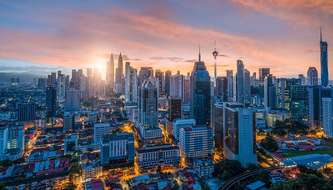
8 Places To Visit In Malaysia Beyond Coastal Charms
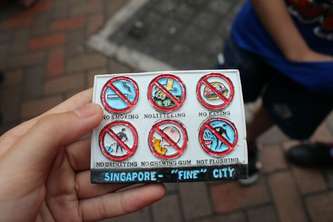
15 Things Not To Do In Singapore And What To Do Instead In 2023!
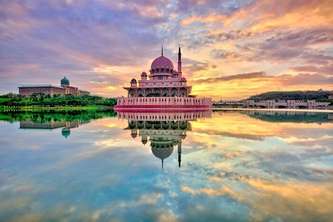
8 Serene Lakes In Malaysia Which Cannot Be Missed On Your Next Getaway!
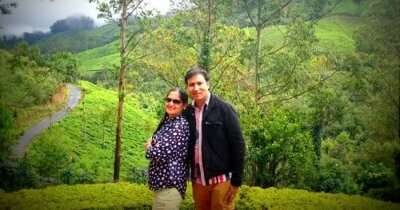
Kerala Trip: Travel Hacks That No One Else Will Ever Share With You
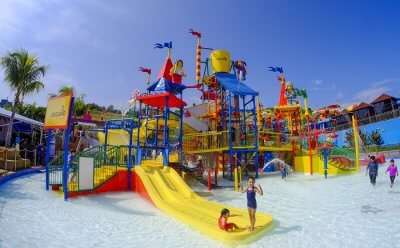
5 Spectacular Water Parks In Malaysia That Are Worth Having Fun In The Sun!
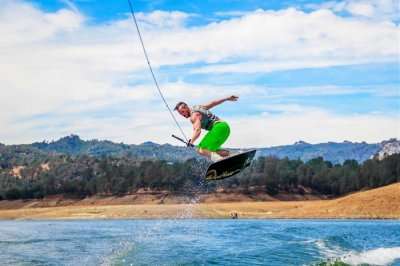
6 Water Sports In Malaysia That’ll Quench Your Thirst For Adventure Like None Other!
Trending Blogs

20 Mysterious Places In India To Visit In 2023 More Bizarre Than The Bermuda Triangle

10 Scariest Roads In India That Are A Driver’s Nightmare

101 Places To Visit In India Before You Turn 30 in 2024

35 Exotic Places To Visit In December In India 2024 To Enjoy A Surreal Vacation

60 Best Honeymoon Destinations In India In 2024

95 Best Honeymoon Destinations In The World In 2023 For A Romantic Escape!
Best Places To Visit In India By Month
Best places to visit outside india by month.
- TravelTriangle
- International
- malaysia »
- Tour Packages
- Honeymoon Packages
- Family Packages
- Budget Tour Packages
- Luxury Tour Packages
- Adventure Tour Packages
- Group Tour Packages
- Maldives Tour Packages
- Bali Tour Packages
- Dubai Tour Packages
- Singapore Tour Packages
- Thailand Tour Packages
- Europe Tour Packages
- Sri Lanka Tour Packages
- Tour Packages From Delhi
- Tour Packages From Mumbai
- Tour Packages From Bangalore
- Tour Packages From Chennai
- Tour Packages From Kolkata
- Tour Packages From Hyderabad
- Tour Packages From Ahmedabad
- Thailand Tourism
- Bali Tourism
- Singapore Tourism
- Maldives Tourism
- Mauritius Tourism
- Dubai Tourism
- Europe Tourism
- Hotels in Thailand
- Hotels in Maldives
- Hotels in Mauritius
- Hotels in Bali
- Hotels in Dubai
- Hotels in Singapore
- Hotels in Sri Lanka
- 1.1 Peninsular Malaysia
- 1.2 East Malaysia
- 3 Other destinations
- 4.1 History
- 4.2 Politics
- 4.3 Geography
- 4.5 Culture
- 4.6 Holidays
- 4.7 Climate
- 4.8 Tourist information
- 6.1.1 Transit visas
- 6.2 By plane
- 6.3 By train
- 6.5 By taxi
- 6.6 By road
- 6.7 By boat
- 6.8 On foot
- 7.1 By plane
- 7.2 By train
- 7.4 By taxi
- 7.5 By ride-hailing
- 9.1 Whitewater Rafting
- 9.2 Martial arts
- 10.2 Banking
- 10.4 Tipping
- 10.5 Shopping
- 11.1 Where to eat
- 11.2 Dietary restrictions
- 12.1 Alcohol
- 13.1 Budget
- 13.2 Mid-range
- 13.3 Splurge
- 16.2 Corruption
- 16.3 Traffic safety
- 16.5 Natural disasters
- 17.1 Healthcare
- 19.1 Electricity
- 19.2 Newspapers
- 20.1 Internet
- 20.2 SIM cards
- 20.3 Telephone numbers
- 20.4 Postal services
Malaysia is a country in Southeast Asia , on the Malay Peninsula, as well as on northern Borneo . The country is one of Asia's tiger economies, having seen great economic and human development during the last several decades. While the capital Kuala Lumpur is a cosmopolitan city, deep jungles cover vast swaths of the land, and the offshore islands are home to pristine beaches and some of the world's best scuba diving sites. Malaysia is also a foodie's paradise, with its diverse ethnic groups contributing to an incredibly rich culinary heritage.
Regions [ edit ]
Malaysia is divided into two main geographical regions, commonly known as Peninsular Malaysia and East Malaysia. See Geography for more information.
Peninsular Malaysia [ edit ]

East Malaysia [ edit ]
Cities [ edit ].
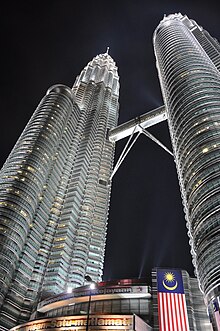
- 3.147778 101.695278 1 Kuala Lumpur — the multi-cultural national capital, home of the Petronas Twin Towers
- 5.4145 100.3292 2 George Town — the capital of Penang and Malaysia's second largest city, famed for its colonial-era architecture, multi-cultural populace, food and arts scene
- 2.188889 102.251111 3 Malacca — the historical city of Malaysia with colonial-style architecture
- 4.6 101.07 4 Ipoh — the capital of Perak , with a historic colonial old town and tin mining area
- 1.455556 103.761111 5 Johor Bahru — capital of Johor and Malaysia's third largest city
- 3.816667 103.333333 6 Kuantan — capital of Pahang and commercial centre of the East Coast
- 5.975 116.0725 7 Kota Kinabalu — close to tropical islands, lush rain forest and Mount Kinabalu
- 1.5575 110.343889 8 Kuching — capital of Sarawak , and largest city in East Malaysia
- 4.414722 114.008889 9 Miri — resort city of Sarawak located near the border of Brunei and gateway to UNESCO World Heritage Site , Gunung Mulu National Park
Other destinations [ edit ]
- 4.529167 101.338889 1 Cameron Highlands — famous for its tea plantations
- 5.916667 102.733333 2 Perhentian Islands ( Pulau Perhentian ) — glittering jewels off the East Coast still undiscovered by mass tourism
- 4.7 102.466667 3 Taman Negara — a large area of rainforest national park spanning Kelantan , Pahang and Terengganu
- 6.35 99.8 5 Langkawi — an archipelago of 99 islands known for its beaches, rainforest, mountains, mangrove estuaries and unique nature. It's also a duty-free island
- 4.114683 118.628756 6 Sipadan ( Pulau Sipadan ) — one of the best dive spots in the world
- 5.775 103.015 7 Redang ( Pulau Redang ) — popular island destination for scuba divers
- 2.816667 104.183333 8 Tioman ( Pulau Tioman ) — once nominated one of the most beautiful islands in the world
- 3.711944 101.736389 9 Fraser's Hill — a time warp to the colonial era
Understand [ edit ]
Malaysia is a mix of the modern world and a developing nation. With its investment in high technology industries and moderate oil wealth, it has become a rich nation in Southeast Asia. Malaysia, for most visitors, presents a happy mix: there is high-tech infrastructure and things generally work well and more or less on schedule, but prices remain more reasonable than, say, Singapore . The demographics between the rich and poor can also be quite apparent: for example, a high rise luxury condominium building built right across the street from old, rundown shop lots or flats. However, you will not find extreme rural poverty or gigantic urban slums as in other countries in Southeast Asia.
In terms of attractions, peninsular (West) Malaysia contains islands with gorgeous beaches and a fraction of visitors found in Thailand 's most popular beaches, mountain retreats surrounded by tea plantations, interesting historical cities, world-famous food, and the highly modern, multi-cultural capital of Kuala Lumpur . East Malaysia contains lush jungles with diverse native population and wildlife, as well as stunning natural attractions such as giant caves, beautiful mountains and fantastic diving sites. Notably, however, Malaysia is not as popular among backpackers as other Southeast Asian destinations such as Thailand, Cambodia and Vietnam , partly due to the relatively higher costs, and partly due to the more religious and conservative, albeit generally tolerant, culture. It also lacks the ancient Hindu and/or Buddhist temples and temple complexes of its neighbors, though it does have some large ones built since the 19th century.
History [ edit ]

Before the rise of the European colonial powers, the Malay Peninsula and the Malay archipelago were home to empires such as the Srivijaya (whose capital was near modern Palembang , Sumatra , but which included the entire Malay Peninsula and lands further north at its greatest extent), the Majapahit (centred in Java , now part of Indonesia, but believed by most scholars to have included the entire Malay Peninsula and most of coastal Borneo among its vassal states) and the Malacca Sultanate. The Srivijaya and Majapahit empires saw the spread of Hinduism to the region, and to this day, despite the fact that Malays are Muslims, many Hindu legends and traditions survive in traditional Malay culture. Mass conversion to Islam only occurred after the arrival of Arab traders during the Malacca Sultanate.
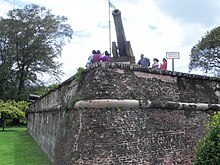
During the 16th century the Portuguese established the first European colony in Southeast Asia by defeating the Malacca Sultanate. The Portuguese were religiously intolerant and cruel, so the Sultan of Johor assisted the Dutch in defeating them, and the Netherlands took control of the city. The British also established their first colony on the Malay peninsula in Penang when it was ceded by the Sultan of Kedah in 1786. Finally, the area was divided into Dutch and British spheres of influence with the signing of the Anglo-Dutch Treaty in 1824. With this treaty, the Dutch agreed to cede Malacca to the British and in return, the British ceded all their colonies on Sumatra to the Dutch. The line of division roughly corresponds to what is today the border between Malaysia and Indonesia .
Before World War II, the Malay Peninsula was governed by the British as the Federated Malay States (Selangor, Perak, Negeri Sembilan and Pahang), which were governed as a single protectorate, the Unfederated Malay States (Johor, Kedah, Perlis, Terengganu and Kelantan), which were each governed as separate protectorates. The Straits Settlements (including Malacca, Penang and Singapore), which were crown colonies directly administered by the British colonisers. These colonies and protectorates were collectively referred to as " Malaya ". British Borneo consisted of the British colony of North Borneo, the Kingdom of Sarawak, which was ruled by a British family known as the "White Rajas", and the British protectorate of Brunei.
World War II was disastrous for the British Malayan Command. The Japanese swept down both coasts of the Malay Peninsula and despite fierce fighting, much of the British military was tied down fighting the Germans in Europe and those that remained in Malaya simply could not cope with the Japanese onslaught. The British military equipment left to defend Malaya was outdated and no match for the modern technology used by the Japanese, and the only two British battleships based in the region, the HMS Prince of Wales and HMS Repulse, were sunk by Japanese bombers off the East Coast of Malaya. By 31 January 1942, the British had been pushed all the way back to Singapore, which fell to the Japanese on 15 February 1942. The situation was no different on Borneo, which fell to the Japanese on 1 April 1942 after months of fierce fighting. The Japanese occupation was brutal, and many, particularly the ethnic Chinese, suffered and perished during the occupation. Among the most notorious atrocities committed by the Japanese were the Sandakan Death Marches, with only 6 out of 2,345 prisoners surviving the war.
After World War II, the Federated Malay States, Unfederated Malay States and the Straits Settlements of Malacca and Penang were federated to form a single British colony known as the Malayan Union, with Singapore being split off to form a separate colony. In the Malayan Union, the sultans of the various states ceded all their powers except those in religious affairs to the British crown. However, widespread opposition to the Malayan Union led the British to reconsider their position, and in 1948, the Malayan Union was replaced by the Federation of Malaya, in which the executive positions of the sultans were restored. In Borneo, the White Rajas ceded Sarawak to the British crown in 1946, making it a crown colony of the United Kingdom.

On 31 August 1957, Malaya gained independence from the British. At midnight, the Union Jack was lowered, and the Malayan flag raised in its place at what is today Dataran Merdeka (Independence Square) in Kuala Lumpur . The crowd, led by the first Prime Minister of Malaya, Tunku Abdul Rahman, then proceeded to chant " Merdeka " seven times. On 16 September 1963, Malaysia was formed through the merging of Malaya with the British colonies of North Borneo (now known as Sabah), Sarawak and Singapore, with Brunei deciding not to join. The first several years of the country's history were marred by the Confrontation ( Konfrontasi ) — actually a series of acts of aggression by Indonesia that ultimately ended in her defeat and a formal peace that has held ever since — and claims to Sabah from the Philippines. On 9 August 1965 Singapore was officially expelled from the federation after several bloody racial riots as Singapore's majority Chinese population and the People's Action Party, led by Lee Kuan Yew (later the long-ruling Prime Minister of Singapore), were seen as a threat to Malay dominance. There were further racial riots in 1969, which led to the forced resignation of Tunku Abdul Rahman; his replacement by Tun Abdul Razak; changes in the Malaysian Constitution that sought to prevent the Barisan Nasional (BN) coalition led by the United Malays National Organisation (UMNO) from ever being defeated in a future national election; and the start of the New Economic Policy, which sought to aggressively promote the economic interests of the generally poorer Malay community (and also the non-Malay indigenous peoples of East Malaysia) over those of the generally less poor Chinese community (with the poorest major ethnic group, the Indians, and also to a very large extent the Orang Asli [aboriginal people] in the Peninsula mostly ignored in the process).
In 1975, boat people from across the South China Sea in Vietnam started coming, and Malaysia became one of the most important places of first refuge for Indochinese refugees, but in general, only those of the Muslim Champa minority were invited to stay permanently. Later, during the period of tremendous economic development under the long premiership of Mahathir Mohammed, a large number of immigrant workers were invited from Bangladesh , Indonesia , India , and several other countries in the area, and even more immigrated illegally. This further increased the diversity of the population, and quite a number of the workers were reported in local newspapers to have intermarried with local women, but it also led to social strife as many Malaysian men resented the competition, and while the economy depended on immigrant workers to do jobs most Malaysians were no longer willing to do, now that their standard of living was higher, most Malaysians also did not want to permanently absorb a large and potentially almost limitless number of poor people from the much more populous countries in the region. Some immigrants were expelled and even caned for immigration violations, but the issue has never been really resolved.
Things came to a head in 2015 when allegations of corruption by then-prime minister Najib Razak surfaced in connection with 1Malaysia Development Berhad (1MDB), which was originally set up to promote economic development by attracting foreign investment. The allegations led to the Bersih (Malay for "clean") rally in which protesters unsuccessfully called for Najib to step down. However, widespread discontent arising from the 1MDB corruption scandal continued to simmer, eventually leading to a shock first-ever electoral defeat for the incumbent BN coalition in the 2018 general election.
Politics [ edit ]
Malaysia is a federal constitutional monarchy consisting of 13 states and 3 federal territories, nominally headed by the king ( Yang di-Pertuan Agong , lit. Paramount Ruler), whose position rotates among the rulers of the 9 royal states of Malaysia every five years, giving Malaysia a unique political system of rotational monarchy. The current king, Tuanku Abdullah from Pahang, was sworn into office on 31 January 2019 and his term ends on 31 January 2024. In practice, the king is only the nominal head of state, while the prime minister is the one who wields the most authority in government.
Malaysia's government is largely based on the British Westminster system, consisting of a bicameral national parliament. The lower house, known as the Dewan Rakyat (Hall of the People) is elected directly by the people. The upper house, known as the Dewan Negara (National Hall), consists of 26 members elected by the state governments, with each state having 2 representatives, while the remaining members are appointed by the king. The head of government is the prime minister, who is the party leader of the winning party in the lower house.
At the state level, each of the states also has its own unicameral Dewan Undangan Negeri (State Legislative Assembly), with the head of the state government being the Menteri Besar (First Minister, often translated as "Chief Minister" in English-language media) in the royal states, and the Ketua Menteri (Chief Minister) in the non-royal states.
Geography [ edit ]
Malaysia comprises two geographic regions, Peninsular Malaysia and East Malaysia, which are separated by the South China Sea.
Peninsular Malaysia ( Semenanjung Malaysia ) occupies all of the Malay Peninsula between Thailand and Singapore , and is also known as West Malaysia ( Malaysia Barat ) or the slightly archaic Malaya ( Tanah Melayu ). It's home to the bulk of Malaysia's population, the capital and the largest city Kuala Lumpur , and generally more economically developed. Peninsular Malaysia consists of plains on both the East and West Coasts, separated from each other by a mountain range known as the Banjaran Titiwangsa , with the West Coast being more densely populated and generally more well-developed than the East Coast.
Separated some 800 km to the east of Peninsular Malaysia is East Malaysia ( Malaysia Timur ). East Malaysia occupies the northern third of the island of Borneo , shared with Indonesia and tiny Brunei . Much of the development on East Malaysia is centred around the cities of Kuching , Miri and Kota Kinabalu . Outside of the major cities and smaller towns are impenetrable jungle where head hunters once roamed and coastal plains rising to mountains. East Malaysia is rich in natural resources and is very much Malaysia's hinterland for industry and tourism, though those who make the trip will find it to be a world-class ecotourism destination.
People [ edit ]
Malaysia is a multicultural society. While Malays (a branch of the Austronesian group) make up a 52% majority, 27% of Malaysians are Chinese (who are especially visible in the cities), 9% are Indians, 12% are members of aboriginal peoples (often called Orang Asli , Malay for "Original People"), and there is a miscellaneous grouping of 1.5% "others", including Thai communities in northern border states and the Portuguese clan in Malacca. The majority of the population (including virtually all Malays, as well as a significant minority of Indians) adheres to Islam , the state religion, and there are substantial minorities who practice Christianity , Buddhism , Taoism, Hinduism , Sikhism and animism, which are allowed under the constitution, subject to the supremacy of Islam — for example, it is illegal to proselytize other religions to Muslims.
Culture [ edit ]
Malaysia shares many cultural similarities with its neighbours, Brunei, Indonesia and Singapore due to their common history. As the first great kingdoms to emerge in the region were Hindu kingdoms with much influence from India, Malay culture has substantial Indian influences. This is most visible in Malay cuisine with its relatively heavy use of curries, albeit using local instead of Indian spices, meaning that Malay curries often have a unique local flavour that is different from their Indian counterparts. Malaysia's minorities also continue to maintain their own distinct cultures, with the Chinese and Indian communities continuing to preserve the traditions brought from their ancestral homelands. In particular, Malaysia's ethnic Chinese community is considered to have preserved Chinese culture and language the best among all the overseas Chinese communities of the world. Moreover, as Malaysia was unaffected by the Cultural Revolution, the ethnic Chinese community of Malaysia has preserved many elements of traditional Chinese culture that have been lost in mainland China.
Holidays [ edit ]
One of the significant characteristics of Malaysian culture is its celebration of various festivals and events. The year is filled with colourful, exhilarating and exciting activities. Some are religious and solemn but others are vibrant, joyous events. One interesting feature of the main festivals here is the 'open house' custom. This is when Malaysians celebrating the festival invite friends and family to come by their homes for some traditional delicacies and fellowship.
Multicultural Malaysia celebrates a vast range of festivals, but the ones to look out for nationwide are Islamic holidays, most notably the fasting month of Ramadan . During its 29 or 30 days, Muslims refrain from eating, drinking, smoking and sex from dawn to sunset. Not all Muslims follow the tradition, or sustain the full period of Ramadan fasting, but most do make a very serious effort. Pregnant, breast feeding or menstruating women are not expected to fast, nor are the elderly, the infirm, or travellers. People get up early before sunrise for a meal ( sahur ), and take off early to get back home in time to break fast ( buka puasa ) at sunset.
At the end of the month is the festival of Eid ul-Fitr , known locally as Hari Raya Puasa or Aidilfitri , when many locals take one to two weeks off to 'balik kampung' or return to their home towns to meet family and friends. Accordingly, this is one of the many times in a year when major cities like Kuala Lumpur have virtually no traffic congestion.
Another important festival is the Muslim festival of Eid ul-Adha , known locally as Hari Raya Haji or Aidiladha . It is during this festival that Muslims perform the Hajj or pilgrimage to Mecca. In local mosques, cows and goats are donated by the faithful and sacrificed, after which the meat is distributed to all. Family reunions are also celebrated during other main festivals when locals usually put on traditional costumes and finery as these festivals are an integral feature of Malaysian society.
During the month of Ramadan, non-Muslims are expected to be considerate of those fasting. Non-Muslims, as well as Muslims travelling ( musafir ), are exempt from fasting but it is polite to refrain from eating or drinking in public. Public school systems also require non-Muslims to refrain from eating in front of those who are fasting. Many restaurants close during the day and those that stay open maintain a low profile. Business travellers will notice that things move rather more slowly than usual. The upside for foreign travellers are the Ramadan bazaars in every city and town, bustling with activity and bursting at the seams with great food. Hotels and restaurants also pull out all stops to put on massive spreads of food for fast-breaking feasts. During the month of Ramadan, meals at the end of fasts are usually considered grand feasts. Worldwide fast-food chain McDonald's is known for holding several all-you-can-eat Ramadan feasts during the month.
Other major holidays include Chinese New Year (around January/February), Deepavali or Diwali , the Hindu festival of lights (around October/November), the Buddhist holiday of Wesak (around May/June), and Christmas (25 December). During Chinese New Year, George Town and Ipoh become the major cities as many local Chinese working and living in KL originated from there. However this situation is changing gradually, as more and more people are making Kuala Lumpur their home town. While visiting during such festivals, travellers will be able to experience many wonderful celebrations, but the downside is many ethnic shops/eateries will be closed. The best option is to visit during the period just after the first two days of the major festival (Hari Raya/Chinese New Year), when shops will open, and the festive mood has still not died down.
Another major celebration is Deepavali , celebrated by the Malaysian Hindus as the festival of light originating from classical India and one of the main cultural celebrations. In Malaysia, locals practice this tradition by wearing new clothes and receiving token gifts of money. This practice has been adapted by all Malaysians regardless of their religion. They distribute red packets or ang pow during Chinese New Year, green packets or 'duit raya' for Hari Raya Aidilfitri and multi-coloured packets during Deepavali.
Some uniquely Malaysian festivals of note include the Harvest Festival at the end of May each year and the ' Pesta Gawai' in early June, both thanksgiving celebrations held in East Malaysia .
Thaipusam is a Hindu festival that falls in January or February and is one of the must-see events. The largest procession in the country takes place at Batu Caves, Selangor. Male devotees carry decorated altars or kavadi up a flight of 272 steps towards the temple, all this while also having religious spears and hooks pierced through external surfaces of their bodies. The ability is attributed to divine intervention and religious fervour. Female devotees join the procession carrying pots of milk on their head instead.
Climate [ edit ]
The climate in Malaysia is equatorial. The north-east monsoon (October to February) deluges Borneo and the East Coast of the Peninsula in rain and often causes flooding, while the West Coast (particularly Langkawi and Penang) escapes unscathed. The milder south-west monsoon (April to October) reverses the pattern. The southern and central parts of Peninsular Malaysia, including perennially soggy Kuala Lumpur, are exposed to both but even during the rainy season, the showers tend to be intense but brief.
Malaysia is close to the equator, so warm weather is guaranteed. Temperatures generally range from 32°C (90°F) at noon to about 26°C (79°F) at midnight. But like most Southeast Asian countries, Malaysia's sun-shining days are interrupted by monsoon season every year, and night temperatures can hit a low of about 23°C (73°F) on rainy days.
Temperatures tend to be cooler in the highlands, with the likes of Genting Highlands , Cameron Highlands and Fraser's Hill having temperatures ranging from about 17°C (63°F) at night to about 25°C (77°F) in the day. Mount Kinabalu is known to have temperatures falling below 10°C (50°F).
Tourist information [ edit ]
- Malaysia Tourism Corporation
Talk [ edit ]
The national-level official language of Malaysia is Malay (officially Bahasa Malaysia , sometimes also known as Bahasa Melayu ) and English is also the co-official language of the state of Sarawak . The Indonesian language, spoken across the border in Indonesia, is similar to Malay, and speakers of both languages can generally understand each other. The main differences are in the loan words: Malay borrowed more from English, while Indonesian borrowed more from Dutch. Some parts of Malaysia near the Thai border, most notably Kelantan , have dialects of Malay which are nearly incomprehensible to speakers of standard Malay, though most people in these areas will be able to converse in standard Malay if needed.
English is compulsory in all schools and widely spoken in the larger cities, among the well-educated upper class, as well as around the main tourist attractions, although in rural areas a little Malay will come in handy. There is also a local dialect of English spoken among Malaysians in urban areas, not inappropriately known as Manglish , which has its own simplified grammar and a vocabulary that is mostly English but includes borrowings from Malay and several other locally-spoken languages; it takes a bit of getting used to if you intend to join in the conversation on local topics. Almost all Malaysians will not pronounce the letter, "h", so "three" becomes "tree". Malaysians will almost always try to speak 'standardized English' (British) when approached by Western travellers. In general, police stations and government offices have English-speaking staff on duty.
Arabic is taught to those who attend Islamic religious schools, and many clerics as well as other very observant Muslims have a functional command of Arabic. However, it is not widely spoken, though the Malay language does have a large number of loan words from Arabic. You also might notice some examples of Malay written with Arabic letters. This is called Jawi, and it is still used for religious publications and inscriptions, especially in more conservative states like Kelantan , although the Latin alphabet is much more commonly used throughout the country.
The Chinese community in Malaysia speaks a wide variety of Chinese dialects including Cantonese , Teochew , Hakka , Hainanese , Hokchiu and Hokkien . Mandarin is taught in Chinese schools while Cantonese is commonly heard in the mass media due to the popularity of TVB serials from Hong Kong among the Chinese community, so many are conversant in both, regardless of their native dialect. Malaysian cities with large ethnic Chinese populations will often have a dialect serving as a lingua franca among that community: in Kuala Lumpur and Ipoh, this is Cantonese; in Penang and Klang, Hokkien; and in Kota Kinabalu, Hakka. The most commonly spoken Indian language is Tamil ; others include Malayalam , Punjabi and Telugu .
In the northern states of Peninsular Malaysia bordering Thailand, there are various ethnic Thai communities, known locally as the Orang Siam , who speak various dialects of Thai . Malacca in the south is also home to a Portuguese community which speaks a Portuguese based creole. The remote forest areas of Peninsular Malaysia are also home to various tribal people known as the Orang Asli , who speak various indigenous languages such as Semelai, Temuan and many others. In East Malaysia several indigenous languages are also spoken, especially Iban and Kadazan.
Films and television programmes are usually shown in their original language with Malay subtitles, although some children's programmes are dubbed into Malay.
Get in [ edit ]
Immigration formalities [ edit ].

Most nationalities can enter Malaysia without a visa and can reside in Malaysia for 14 to 90 days, depending on their nationality. Refer to the Ministry of Foreign Affairs for current information regarding visa requirements and stay periods. The East Malaysian states of Sabah and Sarawak each maintains its own immigration system and separate controls: even Malaysians from other states require a passport or MyKad on arrival.
Those who wish to enter Malaysia for purposes other than for a Social or Business visit still require a visa for any period (except for US citizens who enter for the purpose of studying) but see here for "loopholes" [dead link] .
Nationals of Bangladesh, Bhutan, Montenegro, Myanmar, Nepal, Pakistan, Serbia, and Sri Lanka need a visa but can apply for an e-visa , which is valid for 3 months for a stay of up to 30 days. You'll have to print out the visa once it's issued and bring proof of sufficient funds, a return ticket, and proof of accommodation when you enter the country.
Nationals of India and China are exempted from visa until December 31, 2024. This is valid for a stay of up to 30 days.
Overstaying a visa will result in a US$10, €7.50 or RM30 fine per day. However it's fairly simple to avoid overstaying a visa by doing a "visa run" to a neighbouring country overland or via a cheap flight. Malaysia may impose caning as a punishment for overstaying a visa.
If you are not a Malaysian citizen, ensure that your passport is stamped on entry , or you would be considered to have entered illegally otherwise (and Malaysian immigration officials don't always give entry stamps unprompted). Fines on the order of RM3,000 will be imposed when you try to leave without the entry stamp in your passport. Also ensure that your passport is stamped when you leave , or you would be considered to have left illegally otherwise, which could cause problems should you wish to visit Malaysia again in the future.
Citizens of Australia , Brunei , Germany , Japan , New Zealand , Saudi Arabia , Singapore , South Korea , the United Kingdom and the United States may use the autogates to complete immigration formalities when entering and exiting Malaysia via Kuala Lumpur International Airport (KLIA). In addition, citizens of Singapore can use the autogates at when crossing the Causeway or Second Link by road (but not by train). To do so, you will need to complete the Malaysia Digital Arrival Card (MDAC) online no more than 3 days prior to arrival, and see an immigration officer to complete the enrollment the first time you enter Malaysia after the implementation of the MDAC. Your passport needs to be valid for a minimum of 6 months if entering via KLIA, or 3 months if entering by road from Singapore. Entry through any other immigration checkpoint will require you to be processed at a manned immigration counter.
Transit visas [ edit ]
Even though citizens of Bhutan, India, Myanmar, Nepal, Pakistan and Sri Lanka normally require a visa, they can transit the same airport for up to 120 hours provided they arrive and depart on the same airline, land at Sepang, Kota Kinabalu , Kuching , Penang or Senai and present a genuine air ticket.
By plane [ edit ]
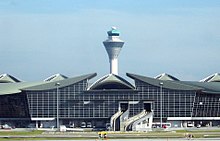
National carrier Malaysia Airlines (MAS) has extensive coverage within Asia, and intercontinental flights to Australia, New Zealand and the United Kingdom. It regularly ranks high in airline quality assessments. Low-cost carrier AirAsia and its sister company, AirAsia X , connects an ever-expanding set of countries including Australia , China , Cambodia , Hong Kong , India , Indonesia , Laos , Macau , New Zealand , the Philippines , Singapore , Sri Lanka , Thailand , Myanmar and Vietnam . Emirates also flies from most cities to Kuala Lumpur via Dubai , and flights to Perth , Australia , make a brief stop in KLIA .
- AirAsia , ☏ +60 3 8775-4000 , 1 300 88 9933 (in country only) .
- Malaysia Airlines , ☏ +60 3 7846-3000 , 1-300-88-3000 (in country only) .
- Emirates Airlines , ☏ +60 36 207 4999 .
Most international flights land at Kuala Lumpur International Airport (KLIA) ( KUL IATA ). KLIA's predecessor, the Sultan Abdul Aziz Shah Airport ( SZB IATA ) in Subang near Kuala Lumpur handles general aviation and turboprop fights, including an international flight from Singapore's Seletar Airport on Firefly . See the Kuala Lumpur Get in section for detailed airport information.
Other airports which have significant numbers of flights to regional destinations are Kota Kinabalu (Sabah), Penang , Kuching (Sarawak), Langkawi and Johor Bahru .
By train [ edit ]
- From Singapore: There's a shuttle train service which runs seven times each way during the morning and evening periods from Woodlands Train Station (in the north of Singapore ) to JB sentral in Johor Bahru , costing MYR5 from the Malaysian side and SGD5 on the Singapore side. Conventional intercity trains then connect Johor Bahru with Gemas (where you can transfer to a train to Kuala Lumpur ) and Tumpat, near Kota Bharu . They don't always match up to the shuttle times, so be prepared for long waiting times or get a backup plan by bus should you miss the shuttle. Early morning trains to Singapore and late evening trains to Malaysia are usually packed on the weekdays and the traffic flow reverses on the weekends. Booking online at the KTMB website may reserve a precious seat without hassle. When travelling from Singapore into Malaysia, both Singaporean and Malaysian immigration checks are conducted at Woodlands Train Station before boarding the train for Malaysia. In the reverse direction, Malaysian immigration checks are conducted at JB Sentral before boarding, while Singaporean immigration checks are conducted on arrival in Woodlands.
- From Thailand: Trains from Thailand start and terminate at the border at Padang Besar where Thai and Malaysian immigration formalities are all conveniently done in the station, and you can transfer between Malaysian and Thai trains. There are two Padang Besar stations; one in Thailand and one in Malaysia; be sure to get off the train only at the Padang Besar station in Malaysia, as that is where both Thai and Malaysian immigration checks are conducted, and where transfers between the Malaysian and Thai trains take place. There is also a less used eastern route from Hat Yai to Thai border town Sungai Kolok , but there are no through trains to the nearby Malaysian station at Wakaf Bahru (near Kota Bharu ).
By bus [ edit ]
Long-distance buses/coaches into Malaysia run from Brunei, Indonesia, Singapore and Thailand. Please see the relevant city pages for more details.
- Brunei — There are buses to Miri and Kota Kinabalu , leaving from the waterfront in downtown Bandar Seri Begawan . There are also buses to Limbang .
- Indonesia — Direct buses operate between Pontianak in West Kalimantan and Kuching in Sarawak .
- Singapore — A multitude of bus companies operate direct routes from Singapore to various destinations in Peninsular Malaysia , including Malacca , Kuala Lumpur , Penang , East Coast cities and even Petaling Jaya and Subang Jaya . Frequent public buses make the short run between Singapore and Johor Bahru , and you can save a few bucks by changing at JB's Larkin terminal to a cheap domestic bus instead of taking a more expensive direct bus.
- Thailand — Several companies operate services from Kuala Lumpur and other cities in Malaysia to Hat Yai in southern Thailand , where direct connections are available to Bangkok and many other Thai destinations.
By taxi [ edit ]
Special cross-border taxis operate between Singapore and Johor Bahru. See Johor_Bahru#By_taxi for details.
By road [ edit ]

Land crossings are possible from southern Thailand and Singapore into Peninsular Malaysia , as well as from Brunei and Kalimantan (the Indonesian side of Borneo) into Sarawak . There is no official crossing into Sabah from Indonesia even though they share a land border. An International Drivers Permit (IDP) is required. See the respective city or state pages for more detailed information.
- Brunei — The main crossings are at Sungai Tujoh on the Miri , Sarawak , to Bandar Seri Begawan (Brunei) road, and the Kuala Lurah-Tedungan checkpoint which is used for traffic travelling between Bandar Seri Begawan and Limbang in Sarawak . You can also access the Temburong district of Brunei by road from Limbang via the Pandaruan (Puni on the Brunei side) checkpoint and Lawas via Trusan (Labu on the Brunei side).
- Indonesia — The main crossing is at the Tebedu-Entikong checkpoint on the main Kuching - Pontianak road. The other two official crossings are the Biawak-Aruk and Lubok Antu-Nanga Badau border crossings. All three crossings are between the Malaysian state of Sarawak and the Indonesian province of West Kalimantan . There are also several unofficial crossings that are used by locals, but as a foreigner, you are advised not to use them as that is considered to be illegal entry.
- Singapore — The two crossings are the Causeway which links Johor Bahru with Woodlands in Singapore, and the Malaysia-Singapore Second Link which links Iskandar Puteri with Tuas in Singapore. See Johor Bahru Get in section and Singapore Get in section for more details. Generally speaking, the Second Link is less congested than the Causeway, and is more convenient for those who wish to drive up the West Coast of Peninsular Malaysia, but a lot less convenient for people who just want to visit Johor Bahru. Cycling into Malaysia is permitted only through the Causeway but not the Second Link; use the motorcycle lanes and have your entry processed at the manual motorcycle counters.
- Thailand — International checkpoints (from west to east, with the Thai towns in brackets) are at Wang Kelian ( Satun ) and Padang Besar ( Padang Besar ) in Perlis , Bukit Kayu Hitam ( Sadao ) and Kota Putra (Banprokob) in Kedah , Pengkalan Hulu (Betong) in Perak , and Bukit Bunga (Buketa) and Rantau Panjang ( Sungai Kolok ) in Kelantan . Thai immigration has long been known to demand a bribe of RM2/20 baht per person to stamp you in or out, though there has been a crackdown on this. Instead, there is now an official fee levied by Thai immigration if you are crossing the border at peak times (05:00-08:30, 12:00-13:00 or 16:30-21:00 on weekdays, and all day on weekends and both Malaysian and Thai public holidays); this is 25 baht for the driver and 5 baht for each passenger if crossing the border by car, and 10 baht for the rider and 3 baht for the pillion if crossing by motorcycle. No fee is payable if you are walking across the border.
By boat [ edit ]
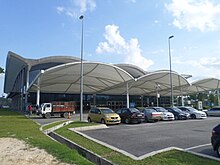
Ferries connect various points in Peninsular Malaysia with Sumatra in Indonesia and southern Thailand , Sarawak with Brunei, and Sabah with East Kalimantan in Indonesia and Mindanao in the Philippines. Luxury cruises also run from Singapore and sometimes Phuket (Thailand) to Malaysia.
- Brunei — Ferries travel daily between the Muara Ferry Terminal in Brunei and Labuan island and Lawas in Sarawak . Speedboats, mostly in the morning, also run between Bandar Seri Begawan jetty and Limbang, Sarawak .
- Indonesia — The main jumping-off points from Indonesia are the Riau Islands of Batam , Bintan and Karimun ; Dumai , Medan and Pekanbaru on the Sumatra mainland as well as Nunukan in East Kalimantan . Ferries link Batam with Batu Pahat, Iskandar Puteri and Johor Bahru ; Bintan with Johor Bahru ; Karimun with Batu Pahat and Kukup in Johor ; Dumai with Malacca , Muar in Johor , Port Dickson (in Negeri Sembilan ) and Port Klang , the port for Selangor ; Pekanbaru with Malacca . Daily ferries also link Nunukan with Tawau in Sabah . There are also minor crossings like between Bengkalis in Riau and Batu Pahat; Sumatra and Malacca and Muar in Johor ; and Tanjung Balai Asahan in North Sumatra with Port Klang , the port for Selangor .
- Singapore — Daily passenger boats run between Changi Point and Pengerang , between Tanah Merah and Sebana Cove Resort, as well as Tanah Merah and Desaru , all in Johor . See the Singapore Get in section for details.
- Thailand — Four ferries travel daily (reduced to three during Ramadan) between Tammalang at Satun and Kuah on Langkawi , Malaysia. Vehicle ferries operate between Ban Taba near Tak Bai in Narathiwat province and Pengkalan Kubur in Kelantan , Malaysia, while passenger boats run between Ban Buketa in Narathiwat province and Bukit Bunga in Kelantan .
On foot [ edit ]
It is possible to enter Malaysia from Thailand by foot at Wang Kelian and Padang Besar (both in Perlis ), Bukit Kayu Hitam ( Kedah ), Pengkalan Hulu ( Perak ) and Rantau Panjang ( Kelantan ). From Singapore , it is possible to cross into Malaysia by foot using the Causeway, but be prepared for a very long walk as Malaysian immigration is now located 2km inland from the border. Unlike the previous customs and immigration complex, the current one was not set up to handle pedestrian traffic, meaning that there are no pedestrian footpaths on the Malaysian side, and you have to walk on the road among vehicular traffic to get to customs and immigration. Crossing the Second Link on foot is not allowed; not that there would be any practical way to continue your journey on either side even if you did.
Get around [ edit ]
Immigration controls are in place for travel between Peninsular Malaysia and East Malaysia, as well as between the East Malaysian states of Sabah and Sarawak. Malaysian citizens need to present their ID cards, while foreign citizens are required to present their passports in order to travel.
Largely thanks to budget carrier AirAsia , Malaysia is crisscrossed by a web of affordable flights with advertised "promotional" prices starting at RM9 for flights booked well in advance. Flying is the only practical option for traveling between peninsular Malaysia and Borneo, as well as reaching some of the more remote outposts of Borneo. State carrier Malaysia Airlines also has competitive fares which now offers equal or even lower priced tickets if booked in advance through the internet, with sustaining class of hospitality. And their offshoot Firefly has a handy network radiating out of Penang previously, has also began operating from the Subang (Sultan Abdul Aziz Shah) airport.
In Sabah and Sarawak , MASWings , operates turboprop services linking interior communities, including those in the Kelabit Highlands , with coastal cities. MASWings took over the rural air services network from FlyAsian Express on 1 October 2007, which in turn took the service over from Malaysia Airlines 14 months before that.
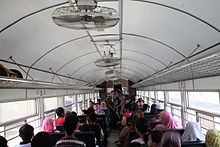
State operator Keretapi Tanah Melayu Berhad (KTMB) provides relatively inexpensive and generally reliable services around Peninsular Malaysia (but not Sabah / Sarawak in Borneo ). The main western line connects Butterworth , Ipoh , Kuala Lumpur and Johor Bahru , while the eastern line runs through Gua Musang and the Taman Negara to Kota Bharu , near the Thai border and the Perhentian Islands .
The pride of KTMB's fleet is the ETS (Electric Train Service) from Padang Besar to Gemas , with a branch line to Butterworth (with transfers to/from George Town by ferry) from Bukit Mertajam , running modern air-conditioned trains daily at 140 km/h. There is no longer ETS service from Padang Besar to Butterworth; the route is served by KTM Komuter trains instead, which while also electrified are designed for commuter rather than long-distance travel. The rest of the network, though, is mostly single-track, with slow diesel locos and all too frequent breakdowns and delays. In May, 2016 KTMB ceased all sleeper trains on the western line, following the electrification of the track to Gemas. An air conditioned 2nd class only, diesel shuttle train now connects the section from Gemas to JB Sentral. Electrification and double tracking of the Gemas to Johor Bahru section is expected to be completed by 2025.
The Jungle Railway is the apt description for the eastern line between Tumpat (close to the Thai border) and Gemas , including stops at Gua Musang , Kuala Lipis , Jerantut (for Taman Negara ) and Wakaf Bahru (for Kota Bharu and the Perhentian Islands ). The original "Jungle Train" is the slow daytime service which stops at every station (every 15-20min or so). It's 3rd class only, meaning no air-con and no reservations, and some stops may be lengthy as it's a single line and all other trains have priority - hence the "Jungle Train" waits in side loops along the way so that oncoming or overtaking trains can pass. Some find it to be a fascinating and stunningly scenic ride; others feel there's not much to see when you're in the jungle. The eastern line also has one night express train (for which reservations are possible and recommended) going in each direction. In addition to air-con seats, these trains have Superior Night (ADNS) sleeper cars, which have upper and lower berths along each side, each bunk having a solid partition at each end and a side curtain for privacy. The carriages shake and rattle quite a bit but are comfortable and clean. These trains have windows for both top and bottom bunks, unlike on Thai sleeper trains.
A third line, known as the East Coast Rail Link is under construction between Port Klang and Kota Bharu , with plans for it to pass through Kuantan and Kuala Terengganu along the way. It is scheduled to be completed in 2027.
Tickets can be booked and even printed online at KTMB's site. Enquiries and reservations can be made by phone at KTMB's call centres, ☏ +60 3 2267-1200 (Malaysia) or, ☏ +65 6222-5165 (Singapore).
In East Malaysia, the only railway line is run by Jabatan Kereta Api Negeri Sabah (JKNS) [dead link] (Web-site in Malay only), running from Tanjung Aru near Kota Kinabalu to the town of Tenom .
Malaysia's sole luxury train is the Eastern & Oriental Express , which travels from Singapore to Bangkok , with stops in Kuala Lumpur and Butterworth .
By car [ edit ]
Malaysia has an excellent highway network with over 2,000 km (1,200 mi) of expressways, culminating in the North-South Expressway along the West Coast from Johor Bahru at the border with Singapore all the way to Bukit Kayu Hitam in Kedah at the border with Thailand . There is also the East Coast Expressway , crossing Peninsular Malaysia coast-to-coast from Kuala Lumpur to Kuantan before heading up north towards Kuala Terengganu . Petrol is slightly cheaper than market prices at RM1.90/litre (Ron 95) (in Peninsular Malaysia, Sabah and Sarawak). Tolls are payable on expressways, but these are priced at varying degrees, ranging from expensive to reasonable: driving the length of the country (734 km) from the Thai border to Singapore costs RM108. While you can drive from Singapore to Thailand within a day on the West Coast, the highway system is considerably less developed on the East Coast, and even less so in Sabah and Sarawak, so be sure to factor in additional travel time if travelling in those areas. Toll prices for highways and causeways inside major cities, especially Kuala Lumpur, are priced exorbitantly, ranging from RM4 to RM7 for each exit.
For those thinking of using GPS (Garmin, Papago, Galactio and Mio-Polnav), the Malaysia maps can be downloaded for free from http://www.malfreemaps.com/index.php Garmin user lucky enough to have another choice from http://www.malsingmaps.com/portal/ . Both party maps is contributed by the amazing non-profit group of people who share a common passion to make a GPS maps of Malaysia.
While driving quality and habits in Malaysia are better than in most of the rest of Southeast Asia, they are not necessarily great, especially compared to what visitors from most Western countries are used to at home. Traffic in Malaysia drives on the left, a legacy left by the British. Beware reckless motorcyclists, especially at night, and especially if you are a pedestrian: locals typically disregard a red light for left turns, putting pedestrians at risk. As a motorist, at traffic lights, motorcyclists will accumulate in front of you — let them drive away first to avoid accidents.
Care is needed when driving in larger cities, such as Kuala Lumpur, Johor Bahru and George Town. Problems include apparently suicidal motorcyclists, congested traffic lanes throughout the day, and bewildering roads especially in the older parts of the city where planning was virtually nonexistent by the then British colonial occupiers. Out of town, however, cars and motorcycles are the best and sometimes the only way to explore the country. Some of the more rural areas have motorcycles and scooters to rent for as little as RM25/day, a great way to explore the local area or larger islands like Langkawi. As expected, most rental agencies will require a valid drivers licence to be presented upon rental. Fuel levels are often compared before and after rental, and the vehicle is also checked for damage, so ensure everything is documented, and request a refund of any excess fuel if possible. The bigger car rental companies like Hertz and Avis may also require you to have a valid credit card where a deposit will be authorised but not deducted from (unless there is damage to the car).

Taxis are available in all cities and larger towns, although in smaller places you may have to call one (ask any shopkeeper or consult the yellow-pages). You will generally need to negotiate the fare in advance, although prepaid coupon taxis are usually available at airports. RM5 should suffice for a short cross-town trip, while RM100 is enough to hire a taxi for a full day.
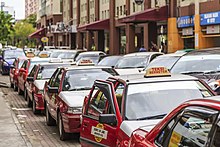
Many taxis will refuse to use the meter, even though there is an official rate. Most taxis now have a sticker on the rear door informing tourists that haggling is prohibited. Taxi drivers, sensing that you are a tourist, may drive around and take a very long route to reach your destination.
If you need a taxi late at night, it is best to use the dial-a-taxi service as there have been incidents in which taxis flagged down during those hours have been fake/unregistered. An unregistered taxi driver might rob or assault you with the help of other assailants. You are also more likely to get a metered taxi by flagging one at a street than at a taxi stand.
It is advisable to study maps and compare fares on the internet before visiting the country. Knowing distances between places is helpful when negotiating with taxi drivers. They won't try to fool even a foreigner who demonstrates clearly that he knows the distance from point A to point B is 50 km and not 150 km.
Do not accept the first rates for inter-city travels by car offered by hotels, as these could be as much as double normal prices. In this case, negotiate with a taxi driver directly for a better and fair price (for example, a hotel near Balok Beach, not very far from Kuantan, asked 800 RM for a ride to Johor Bahru, while a negotiated price with a taxi driver who could be found in downtown Kuantan came down to a normal 400 RM). But for all this you need to know the exact distance and if possible even the exact itinerary between your departure and arrival point.
In Kuala Lumpur, the budget taxis are usually coloured Red and White (City taxi – these taxis are not allowed to travel out of the city e.g. to another state) or Yellow. Taxis are usually small saloons such as Proton Wira and run on NGV (Natural Gas). The Blue taxis are larger saloons or MPVs (Multi Purpose Vehicles) and more luxurious. These cost typically 25–30% more than the budget taxis & are normally available at taxi stands all over Kuala Lumpur including the major malls & hotels.
The Red & White taxis can be hailed off the roads and are metered. Ensure that the taxi driver is a Malaysian (all drivers must have a taxi permit & license with their photo on it) before you board, as unscrupulous taxi owners have been known to rent their taxi out to unlicensed stand-ins. All legal taxi drivers must be Malaysian citizens or permanent residents as the Malaysian government does not issue work visas to foreigners to drive taxis.
Additionally, beware of unlicensed taxis (taxi sapu) at the airports. They can literally take you for a ride. There will be touts at the airports offering travellers their taxi service, even pretending to be legitimate. As unbelievable as it may sound, some have been known to rob first time visitors hundreds of ringgit for a single trip into the city, charging 100 times more than the correct fare. At the airports always get your taxi from the authorised operators' booths set up in the airport itself & never from anyone that solicits directly. They will always claim to be legitimate but are rarely licensed and may be unsafe. The taxi operator booths can provide you with receipts. Another tip is to book your taxis in advance. All good hotels' concierge will be able to assist you with this. If travelling in an unlicensed taxi you may not be covered by your travel insurance should that taxi be involved in a mishap.
By ride-hailing [ edit ]
The most popular ride hailing app is Grab , which took over Uber's former Southeast Asian operations. You can pay with your card (via the Grab app) or cash; most drivers have change.

The cheapest way to travel in Malaysia is by bus. All towns of any size have a bus terminal offering connections to other parts of the country. There are many companies of varying degrees of dependability, but two of the largest and more reliable are Transnasional and NICE/Plusliner . 24-seater "luxury" buses are recommended for long-distance travel.
If travelling on holidays or even over the weekend, it is advisable to reserve your seats in advance. Many bus companies allow for you to book online directly through their website. However, some only allow online booking for individuals with Malaysian credit cards, which is not really convenient for international visitors. Luckily, most bus operators have banded together into two booking portals and are particularly handy if you have specific destinations but are not sure which bus company to use. Both allow payment with any credit card and require a nominal fee for their service (usually RM1-2).
- Bus Online Ticket , ☏ +603 2027 4626 , [email protected] . ( updated May 2019 )
- catchthatbus.com ( catchthatbus.com ), ☏ +603 9212 1818 (MY) , [email protected] .
- redbus ( redbus ), ☏ +65-31582888 , [email protected] .
- Easybook ( Easibook ), ☏ +60 4 332 7718 , [email protected] . ( updated Mar 2015 )
Air conditioning on some buses can be extremely cold so don't forget to bring a good sweater, pants and socks, especially for overnight journeys on luxury buses!
See [ edit ]
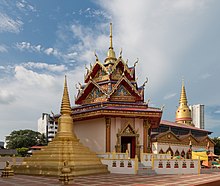
Malaysia is a fascinating country with many faces. It's multi-ethnic and multi-cultural, and its attractions vary from the iconic Petronas Towers in bustling Kuala Lumpur to perfect sandy beaches lined with palm trees and dense jungles with orangutangs and tigers.
There are various impressive national parks . Expeditions range from those where you hardly lose sight of the hotel to those where you are fully immersed in the jungle for weeks, with only the guide and yourself. To spot a tiger or wild elephant in its natural habitat you might have to spend more than a few days in the wild, but you'll have no trouble seeing smaller wildlife. Bako National Park is the oldest national park in Malaysia and one of the best places to see proboscis monkeys. The vast jungles of Taman Negara have become a popular destination for ecotourists , just like the remote but gorgeous Gunung Mulu National Park , a World Heritage Site famous for its limestone karst formations, stone pinnacles and huge caves. To escape from the muggy tropics, do as the English did and head up to the cool tea plantations of the Cameron Highlands , the quaint Tudor-style village on Fraser's Hill or climb Mount Kinabalu in Sabah .
For many people, Malaysia brings pictures of pristine beaches with great diving opportunities to mind - and for good reason. Sipadan off the coast of Sabah, and the beautiful Perhentian Islands are among the best (and most popular) places. Coastlines in the less industrialized parts of the country, in general, are well worth driving through for their natural beauty and relaxing seaside kampung (villages). Follow the crowds to the postcard perfect sands of the Langkawi Islands, where you can have a cocktail on the beach and stay in one of the many resorts.
If you're most interested in taking the pulse of a city, don't miss Kuala Lumpur ' s crazy quilt ultra-modern skyline, including the famous Petronas Twin Towers. George Town , the capital city of Penang , is known for its great food, colonial architecture, and relatively long-standing and institutionalized Chinese, Peranakan and Indian communities, who share the city with ethnic Malays, Thais and Eurasians. Ipoh is a good choice if you enjoy a somewhat slower paced city that features elegant colonial-era buildings from about 100 years ago, and Malacca is for those who want to trace the colonial and imperial history of Malaysia several hundred years further back. For a completely different experience, head to Kota Bharu to discover a unique conservative Islamic regional culture influenced by Thailand , only a few kilometres away, or visit the diverse cities of East Malaysia , like Kuching and Kota Kinabalu . Especially when travelling with children, consider visiting one of the country's excellent zoos, such as Taiping Zoo, Kuala Lumpur 's Zoo Negara, Johor Zoo and Malacca 's Zoo.
Do [ edit ]
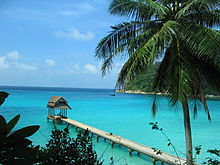
Malaysia has excellent scuba diving . The most popular spots are the islands off the East Coast of peninsular Malaysia ( Perhentian , Redang , Tioman and many more), although the dive season is limited to April to September. However, the most famous dive site — often ranked among the best in the world — is Sipadan , off the easternmost tip of Malaysian Borneo . There are many other less well known sites, like Layang Layang .
Whitewater Rafting [ edit ]
You can find tame Grade I to incredibly difficult and dangerous Grade V rapids in Malaysia's many national parks:
- Jeram Besu - Grade I-III - Pahang
- Telom River - Grade V - Pahang
- Kuala Perahu - Pahang
- Lipis River - Pahang
- Anak Jelai River - Grade I-II - Pahang
- Tembeling River - Grade I-II - Pahang
- Sedim River - Grade III-IV - Kedah
- Sungai Selangor - Grade I-III - Selangor
- Kiulu River - Grade II - Sabah
- Padas River - Grade III-IV - Sabah
- Sungai Itek (Kampar River) - Grade I-III - Perak
- Sungkai River - Grade I-II - Perak
- Singoh River - Grade V - Perak
- Endau River - Johor
- Nenggiri River - Grade I-III Kelantan
- Kuala Kubu Bahru , Selangor
Martial arts [ edit ]
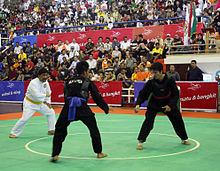
Malaysia is home to a uniquely Malay style of martial arts known as silat . Silat tournaments are held between different schools in the country, and the Southeast Asian Games is the premier international tournament in silat, with competitors from the neighbouring countries as well. There is also an equally traditional stylised dance version of silat called silat gayung , which is quite worth seeing if you have the chance.
In addition, there are also many kung fu masters among the ethnic Chinese community, and Malaysia is consistently one of the top performers in international wushu competitions.
Music [ edit ]
Malaysia is home to a uniquely Malay form of singing called dikir barat . Dikir barat is typically sung by a choir, though there may also be solo parts, and is also either sung a capella , or accompanied only by percussion instruments. Dikir barat competitions are fairly popular among the Malay community, and are frequently broadcast on Malaysian national television.
Buy [ edit ]
Money [ edit ].
The Malaysian currency is the Malaysian ringgit , abbreviated as RM (ISO code: MYR ). It is divided into 100 sen (cents). The ringgit used to be referred to as the dollar and you may see the '$' symbol on older notes. Coins in Malaysia are issued in denominations of RM0.05 (silver), RM0.10 (silver), RM0.20 (silver or gold), and RM0.50 (silver or gold). Banknotes in Malaysia are issued in denominations of RM1 (blue), RM5 (green), RM10 (red), RM20 (orange), RM50 (green/blue) and RM100 (purple). 5 sen coins are mainly given as change in large establishments or supermarkets whereas peddlers and street vendors might be reluctant to accept them. The Singapore and Brunei dollars are also known as ringgit in Malay, so when near border areas you might want to check to be sure which currency they are quoting the price in.
Foreign currencies are not generally accepted, although you might get away with exchanging some US dollars or euros even in more remote areas, but do expect a lot of stares and some persuasion. The major exception is Singapore dollars, which are accepted by KTMB and toll roads, but at a highly unfavorable 1:1 exchange rate (an anomaly dating back to when the ringgit was interchangeable with the Singapore dollar, prior to the 1970s).
Currency exchange counters can easily found in major shopping areas and have a better exchange rate than in banks and airports. Be sure to say the amount you wish to exchange and ask for the 'best quote' as rates displayed on the board are often negotiable, especially for larger amounts. Large foreign banknotes, such as €500, are almost impossible to change for a good rate in some areas, especially in Sabah or Sarawak, where the banks offer a much lower rate comparing to the one you'd get if changing a banknote of smaller amount. Some money exchangers in Kota Kinabalu or Kuching even may refuse your business if you have large foreign banknotes, so the best option is to bring smaller notes unless you are willing to shop around.
Banking [ edit ]
ATMs are widely available in cities, but do stock up on cash if heading out into the smaller islands or the jungle. Credit cards can be used in most shops, restaurants and hotels, although skimming can be a problem in dodgier outlets. For credit card usage, make sure your credit/debit card is chip based as most merchants no longer accept magnetic strips based cards.
Banks in Malaysia do handle international transactions. These ranges from a nominal fee if you are an account holder to a slightly more expensive amount if you are only walking in to use a certain service. International bank HSBC has a presence in Malaysia, with the latter having branches throughout the country. Local banking giants are Maybank, RHB, Hong Leong Bank, Public Bank & CIMB Bank, & they are a very good alternative to the earlier mentioned banks, especially in terms of pricing, local knowledge & presence as well as international services available e.g. money transfers. For any enquiries and transactions, get a number, sit down and wait for your turn to be served. (There is no need to queue while you wait in air-conditioned comfort!)
Banks are open Monday-Friday from 09:30-16:00 and selected banks are open Saturday 09:30–11:30 except on the first and third Saturdays of each month. In the states of Kedah, Kelantan and Terengganu, they are open Sunday to Thursday 09:30–16:00.
Due to fraud risk, many Malaysian ATMs do not allow you to withdraw using foreign debit cards. If your card is rejected, try another ATM. If you call your bank or credit company, they are often not aware of what happened because the transaction is declined by the Malaysia bank. Make sure to bring cash or other forms of money in case your debit card is rejected.
Costs [ edit ]
Most Western visitors will find Malaysia quite cheap, although it is noticeably more expensive than neighbouring Indonesia. You can live in hostel dorms and feast on hawker food for less than RM50 per day, but you'll wish to double this for comfort, particularly if travelling in more expensive East Malaysia. Kuala Lumpur is also generally more expensive than the rest of the country. At the other end of the spectrum, luxury hotels and air fares are also quite affordable, with even the fanciest 5-star hotels costing less than RM400/night.

Tipping [ edit ]
Tipping is not customary in Malaysia. A service charge of 10% is included in total bill in most air conditioned restaurants, but otherwise, you are not expected to pay anything more than what is stated in the bill. Most expensive restaurants, bars and hotels may indicate prices in the form of RM19++ ("plus plus"), meaning that sales tax (6%) and service charge (10%) will be added to the bill. Hotel tax of 5% may also be added to this.
Shopping [ edit ]
Kuala Lumpur is a shopping mecca for clothes, electronics, watches and computer goods, with very competitive prices by any standard. Local Malaysian brands include Royal Selangor, British India and Eilanto. Traditional Malaysian fabrics ( batik ) are a popular souvenir. The cheapest place to easily buy ethnic souvenirs (especially wood-based) is in Kuching , East Malaysia, and the most expensive place is in the major, posh Kuala Lumpur shopping centres.
In general shops are open 10:30–21:30/22:00 in the large cities. They open and close for business earlier in the smaller towns and rural areas. Some shops may also be closed on certain days, such as in Malacca where many shops and restaurants close on Tuesday.
If you buy too much while shopping in Malaysia (which is quite easy to do), surface postage rates are very reasonable. Excess luggage at the airport is still high but not as high as in many other countries. Check first with your airline.
Eat [ edit ]
The crossroads of Malay, Chinese and Indian cuisine , Malaysia is an excellent place to eat ( makan in Malay). Look out for regional specialities and Nyonya (Peranakan) cuisine, the fusion between Malay and Chinese cooking . There is even unique Eurasian cooking to be found in the Portuguese Settlement in Malacca, the heartland of the Portuguese Eurasian community.
Malaysians are very proud of their cooking and most towns or even villages have their own delicious specialities such as Penang char kway teow , Kajang satay, Ipoh bean sprout chicken, Sarawak laksa , Kelantanese nasi dagang and Sabahan hinava . Most eateries rely on word of mouth for advertising and are frequently located in the most inconvenient, out-of-the-way places, so you might want to try asking the locals for their personal recommendations.
If you intend to travel around Malaysia trying out the local food, don't be fooled by the names. Sometimes two entirely different dishes from different parts of the country can be known by the same name. For example, laksa refers to completely different noodle dishes in Penang and Sarawak .
Generally, you can eat pretty much anywhere in Malaysia. Food outlets are comparatively clean – the only thing you should avoid when you frequent the street or hawker stalls is ice for your drinks, since the blocks of ice used there might not be up to your hygienic standards. In actual restaurants this is not a problem. Also you might want to avoid ordering water from hawker stalls or the mamak restaurants as you will usually be served unboiled tap water.
Cheaper places often do not display prices; most will charge tourists honestly, but check prices before ordering to make sure.
Eating habits run the gamut, but most foods are eaten by fork and spoon : push and cut with the fork in the left hand, and eat with the spoon in the right.
As eating is a favourite 'pastime' of Malaysians, the majority are adept at using chopsticks, regardless of background. Noodles and Chinese dishes typically come with these, while Malay and Indian food is traditionally eaten by hand, though a fork and spoon are often used to eat Malay and Indian food in restaurants and can be requested if not provided.
If eating by hand, always use only your right hand to handle the food, as Malays and Indians traditionally use their left hand to handle dirty things. When eating with chopsticks at Chinese restaurants, take note of the usual etiquette and most importantly, do not stick your chopsticks vertically into a bowl of rice. This is reminiscent of incense sticks burning at the temple and has connotations of wishing death on those around you. If eating in a group, serving dishes are always shared, but you'll get your own bowl of rice and soup.
Where to eat [ edit ]
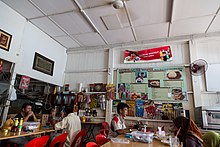
The cheapest places to eat are hawker stalls and coffeeshops , known as kedai kopi in Malay or kopitiam in Hokkien. These shops sell, besides coffee, many other types of food and drinks. Particularly popular and tasty are mamak stalls, run by Indian Muslims and serving up localized Indian fare like roti canai . Most hawker stalls stay open till late and some even operate on shifts so you can find the same stall offering different food at different points throughout the day. You can also do take away from any stall, just ask for bungkus (Malay) or ta pao (Cantonese). A hawker meal will rarely cost you over RM5. Hygiene standards in Malaysia, while not up to that of neighbouring Singapore or Western countries, is still reasonable and much better than say, China or most of the rest of Southeast Asia. Just be observant, and generally speaking, if a stall is patronised by locals, it should be safe to eat there.
One step up on the scale is the kedai makanan or the more Western-style restoran . A type to look out for is the nasi kandar restaurant (also known as nasi campur or nasi padang ), with a vast range of curries and toppings to ladle on top of your rice.
Seafood restaurants ( makanan laut ) are comparatively pricey but still an excellent value by most standards; do check prices before ordering though. Local prawns are gigantic, Chinese-style steamed fish is a treat and crab served with sticky chilli sauce is particularly popular.
Last but not least, some less adventurous options. Food courts in shopping malls are a good way to sample local delicacies in air-conditioned comfort, paying only a small premium over hawker prices. And yes, you can also find McDonald's, KFC, Pizza Hut and the usual suspects plus imitators throughout Malaysia.
Dietary restrictions [ edit ]

Being a Muslim-majority country, finding halal food in Malaysia is easy, but most Chinese stalls and restaurants, as well as those serving some indigenous ethnic groups of East Malaysia such as the Iban and Kadazan, are not halal. Ask if in doubt. Meals at Malay restaurants and Western fast food restaurants like McDonald's, Kentucky Fried Chicken and Pizza Hut are halal. Restaurants at major hotels are not certified 'Halal' as they serve alcohol as well, but with the exception of Chinese restaurants, they generally don't serve pork. Local Muslims will eat at Western, Chinese and Indian eateries if there is a halal sign on the walls. Most of the restaurants tend to display their halal certification or halal sign on their places. Halal certification is awarded and enforced by a government agency, usually JAKIM.
There are no kosher establishments in Malaysia, so Jewish visitors will have to bring their own food with them. Kosher grocery stores and restaurants can be found in neighbouring Singapore , Thailand , the Philippines and Vietnam , so you might want to stop in one of those countries to stock up before entering Malaysia.
Vegetarianism is well-understood by the Chinese and Indian communities (not so by the Muslim Malays and other indigenous minorities) and many restaurants or hawker stalls will be able to come up with something on request (DO state "no meat, no fish, no seafood – ASK for vegetables and/or eggs ONLY"), but don't rely entirely on menu descriptions: innocuous-seeming dishes like "fried vegetables" etc. will often contain pork bits in non-halal Chinese restaurants, shrimp paste ( belacan , commonly used in Malay and spicy Chinese dishes), fish sauce, etc. Indian restaurants usually have very good vegetarian selections – the roti (Indian flat bread – any kind; including roti canai, roti naan, capati, tosai) are good choices, and DO insist on being given dhal (lentil-based curry dip) lest you'll be given a fish curry dip. Purely vegetarian Chinese restaurants (often serving remarkable "mock meat" products made from tofu, gluten etc.) are quite easy to find in big urban areas with a large ethnic Chinese population. Getting vegetarian food in rural areas, especially those near fishing villages or in Muslim/Malay-dominated regions, may be more difficult, but learning some basic Malay vocabulary will go a long way to help you get your message across – see the Malay phrasebook . Upmarket Western restaurants, such as those serving Italian cuisine, will normally have some good vegetarian options.
Veganism is rarely understood in this part of the world and is largely mistaken as a synonym for vegetarianism. The safest bet for a vegan is to patronize a Chinese Buddhist vegetarian restaurant (most Chinese vegetarian restaurants are essentially vegan and operated on Buddhist principles of non-killing and compassion, and thus they abstain from using dairy products, eggs, and the 5 fetid vegetables [onions, garlic, leeks, etc.] discouraged in Mahayana Buddhism). And if you're still feeling uneasy or unsure, do not hesitate to ask.
Drink [ edit ]
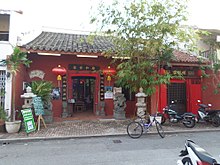
Malaysians like both coffee ( kopi ) and tea ( teh ), especially the national drink teh tarik ("pulled tea"), made by the Mamak (Indian Muslim) community, and named after the theatrical 'pulling' motion used to pour it. By default, both will be served hot, sweet and with a dose of condensed milk; request teh o to skip the milk, teh ais for iced milky tea, or teh o ais for iced milkless tea. Drinking with no sugar at all is considered odd, but asking for kurang manis (less sugar) will ease the pain. However, if you really want no sugar at all, you can try asking for "teh kosong."
Malaysia produces its own tea, but little of it is exported except to neighbouring Singapore due to high domestic demand, so be sure to try some locally-grown tea when you are here. BOH, with its plantations in Cameron Highlands , is Malaysia's largest tea brand.
Another peculiar local favourite is the kopi tongkat ali ginseng, a mixture of coffee, a local aphrodisiacal root, and ginseng served with condensed milk that's touted as an alternative to viagra and red bull combined and is usually advertised with a picture of a bed broken in half.
Other popular nonalcoholic options include the chocolate drink Milo and lime juice ( limau ). Freshly made fruit juices are also widely available, as well as a wide range of canned drinks (some familiar, some less so).
There is also a local drink comprised of white soya milk and black grass jelly ( cincau ) called soya cincau . It can be ordered at most hawker centres and local roadside cafes ( kedai kopi/kopitiam ).
Alcohol [ edit ]
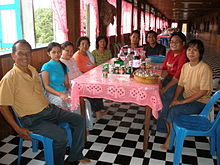
Although Malaysia has a Muslim majority, alcohol is available at licensed outlets for non-Muslims. However, some states (notably Kelantan and Terengganu ) ban the sale of alcohol. With the exception of tax-free islands ( Labuan , Langkawi , Tioman ) and duty free shops (for example in Johor Bahru ), prices are comparatively high, with a can of beer costing RM7.50 or more even in supermarkets or 7-Eleven stores. However, in East Malaysia, smuggled liquors are widely available. The legal drinking age in Malaysia is 21.
In East Malaysia, particularly Sarawak , tuak is a common affair for any celebration or festivals such as Gawai Dayak and Christmas Day. Tuak is made from fermented rice which sometimes sugar, honey or other various condiments are added. It is normally served lukewarm without ice. Visitors can choose from 'strong' flavour of tuak (which is normally being fermented for years), or 'mild' flavour (which is sometimes prepared only a week or even a day before). In Sabah , cheap liquors are very widely available at most supermarkets and mini markets in the state. Other alcoholic drinks such as beer and whisky are also widely available. On the other hand, Tuak in Kelantan also can be considered as a liquor since that it contains a trace amount of fermented nipah or sap juice. The alcohol content in Kelantan tuak can easily reach 50% after 3 days from the time it was extracted.

Tapai consists of cassava (less often, rice) that is fermented and eaten as a food (though the liquid in the bottom can also be drunk). As it is commonly eaten during Hari Raya Puasa, the major Muslim holiday celebrating the end of the fasting month of Ramadan, it is interesting that Islamic legal authorities associated with the Islamist opposition Pan-Malaysian Islamic Party (PAS) have given Muslims a special dispensation from laws against consuming alcohol, in the case of tapai.
Sleep [ edit ]
Malaysia has ample affordable accommodations in all of its cities and towns, with full range from budget until luxury ones. Service charges and taxes are not yet part of the advertised price so be sure to add 16% to the listed price. Hotels and hostels are required to charge a tourism tax on international visitors: RM10 per room per night, which may not be included in the advertised rates.
Budget [ edit ]
Budget hotels and youth hostels are available in most cities and around most tourist destinations. As with most budget accommodations, some are more reliable than others. Be cautious when selecting budget accommodation to avoid places that house illegal vice activities.
Larger cities will have YMCAs that are safe bets. Another noticeable budget hotel chain is Tune Hotels, an affiliate of the budget airline, Air Asia. They are expanding and have hotels at numerous locations throughout the country
Mid-range [ edit ]
Mid-range hotels are readily available just about anywhere. Prices of 3–4 star hotels are upwards from RM100 and are generally reliable in terms of quality.
Splurge [ edit ]
Malaysia is home to some of the most affordable 5-star hotels, service apartments, and resorts in the world. They are found in larger cities like Kuala Lumpur, George Town, Johor Bahru, Kota Kinabalu and Kuching and also in some coastal towns and areas. Also, almost all islands have upscale resorts and spas for the wealthy traveller.
Learn [ edit ]
Malaysia's universities are generally well-regarded and draw exchange students from near and far. Among Malaysia's universities, the undisputed most prestigious one is the University of Malaya (UM), located in Kuala Lumpur. In addition, several foreign universities have established campuses in Malaysia.
Work [ edit ]
Obtaining a working visa takes some effort. The easiest way to work in Malaysia is probably to work for an overseas company and get posted to Malaysia. The Malaysian Immigration Department website has basic advice. In order to obtain a work permit, you need to have an offer from your future employer who will have to do the paperwork for you. It's very expensive and comes with many restrictions if a company wants to hire a foreigner and as such next to impossible. As stated above, a feasible way is to get transferred. Finding a job is otherwise unlikely unless you are married to a local and even then it remains difficult.
Working days in Kelantan , Terengganu , Kedah are from Sunday to Thursday, with Fridays and Saturdays being weekend holidays, similar to most Middle Eastern countries in alignment with Friday prayers of Muslims. The other states observe the normal weekend in the rest of the world. Johor adopts the Friday-Saturday weekend, though businesses may still stick to the normal week cycle to accommodate with Singaporean practices.
Stay safe [ edit ]
Though the crime rate is higher than in neighbouring Singapore, Malaysia is generally a safe country for visitors. Crimes towards tourists are usually restricted to bag-snatching, pickpocketing and petty theft. It is important to keep a close eye on valuable items. Theft is more common in crowded places, such as markets and on public transport. Generally, if you avoid deserted areas, get back to your hotel before midnight and use your common sense, you're unlikely to be assaulted. Homosexuality is a crime and gay bars may be raided by police; gay and lesbian tourists should be self-aware and careful.
Crime [ edit ]
There have been some reports of pickpockets and snatch-and-run thieves in some of the major cities like Kuala Lumpur , Petaling Jaya and Johor Bahru . As a general precaution, never carry your bags on the side facing the road and always walk facing the oncoming traffic. Additionally, walk a few feet deeper away from the roads. Women travellers should take extra precautions at night.
Johor Bahru is known for having a relatively higher crime rate compared to the rest of Malaysia, and armed robberies and snatch thefts could happen at night in run-down areas of the city. Travel documents and valuables are best deposited in a hotel safe.
In Malaysia, some crimes are punished with caning, known locally as whipping. Being convicted of rape, vandalism, illegal entry, bribery, overstaying your visa, and certain other crimes could get you caned. This is no slap on the wrist! Strokes from the thick rattan cane are very painful , will take some time to heal and probably leave you with a permanent scar.
Credit card fraud is a growing problem in this country, especially if you order in an on-line store during your stay. Use credit cards only in reputable shops. If you are not sure about the reputation of a certain shop or service, there are several services available that can help to identify fraud and scams such as Trustedcompany.com [dead link] for any online service they want to use.
Corruption [ edit ]
While not as bad as the likes of Thailand, Vietnam or Indonesia, corruption remains a significant issue in Malaysia. Traffic police have been known to pull over motorists to demand bribes of RM100-200; this tends to happen somewhat more often to those driving Singapore-registered cars (recognisable by the licence plates). Nevertheless, there have been some crackdowns on this, and bribery is punishable by up to 20 years in jail. Anyone who tries to bribe public officials may be arrested on the spot and placed in a lock-up overnight to be charged for the offence in the morning. If this happens on a Friday or on eve of public holidays, you will find yourself spending a few nights in the lock-up as the courts are only open Monday to Friday. Do not let this dissuade you from requesting help — generally Malaysian police are helpful to tourists.
Customs and immigration officers are comparatively cleaner than other Southeast Asian countries, though there have been isolated cases where tourists are demanded bribes from immigration officials, even at major airports and border crossings like Kuala Lumpur International Airport . Do check your passport before driving off when entering by land from the Singapore border though, as immigration officers have been known to "forget" to stamp people in, and you will be subject to fines of several thousand ringgit for illegal entry when you try to leave Malaysia if your passport was not stamped on entry.
The Malaysian Anti-Corruption Commission (MACC, Malay Suruhanjaya Pencegahan Rasuah Malaysia/SPRM ) is responsible for investigating corruption throughout the country. A list of MACC branches can be found here .
Traffic safety [ edit ]
Drunk-driving is a serious offense and breathalyzer tests by the police are common.
When on foot, be careful when crossing the street. Vehicles will often ignore pedestrian (zebra) crossings. However, reports of road bullying during accidents are still common, so if you are involved in an accident be very careful when negotiating or dial 999 for help.
Other [ edit ]
Public demonstrations are uncommon in Malaysia due to police crackdowns. Should one occur it may be dealt with in a heavy-handed manner, so avoid them at all costs .
It is generally not allowed for non-Muslims or non-Sunnis to proselytize. In particular, attempting to persuade Muslims to convert out of their religion is illegal, and if you are caught doing this, you will be expelled from the country or even face criminal responsibilities.
Natural disasters [ edit ]
Peninsular Malaysia is largely free from earthquakes as there are no nearby faultlines, though tremors can occasionally be felt in the upper storeys of tall buildings when a major quake occurs in neighbouring Indonesia. East Malaysia, on the other hand, especially the area around Mount Kinabalu, does experience occasional earthquakes (such as the fatal one occurring in 2015). Typhoons are also exceedingly rare, though one hit the southern part of Johor in 2001. However, the Nov-Jan monsoon season often results in flooding due to torrential rains, and landslides are known to occur, most notably on the East Coast. Tsunamis are a rare occurrence, though Penang and a few islands on the north of the West Coast were hit by the infamous tsunami in 2004.
Stay healthy [ edit ]
Tap water is drinkable straight off the tap, as it is treated, but even locals boil or filter it first just to be on the safe side. When travelling it is best to stick to bottled water, which is very inexpensive.
Ice in drinks might be made from tap water but nowadays, most restaurants and even roadside stalls use the cylindrical variety with a hollow tube down the middle that are mass-produced at ice factories and are safer to consume.
Heat exhaustion is rare, but do consume lots of fluids, use a hat and sunscreen and shower often!
Peninsular Malaysia is largely malaria -free, but there is a significant risk in Borneo especially in inland and rural areas. Dengue fever occurs throughout Malaysia in both urban and rural areas, and can be avoided only by preventing mosquito bites. The mosquito that transmits dengue feeds throughout the daytime, and is most active at dawn and dusk. If you experience a sudden fever with aches and lethargy, seek medical attention immediately. Aspirin and ibuprofen should not be used until dengue fever has been ruled out. Mosquito repellents ( ubat nyamuk ) are widely available. Be careful with mosquito coils, which can easily start fires: set them on a plate or other non-flammable surface and extinguish them before going to sleep.
Haze from burning vegetation in neighbouring Indonesia may come and go without warning from the months of May to August so travellers with respiratory ailments should come prepared.
Most public washrooms charge a small fee (generally between RM0.20-RM2.00, usually depending on the standard of the facilities), so keep some loose change to hand. If the condition of the sitting toilets is questionable, use the squatting toilets instead - both are usually available, and some believe that the latter are more hygienic and (if you can get used to them) are just as easy to use as sitting toilets.
Healthcare [ edit ]
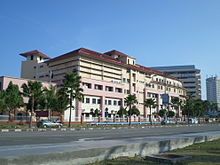
The standard of healthcare in Malaysia is generally high, and Malaysia is rapidly emerging as a popular destination for medical tourism, with treatment costs in general far cheaper than in neighbouring Singapore and Western countries. Almost all Malaysian doctors are able to speak English fluently, while most other medical staff are able to converse in at least basic English.
Malaysia has a public and private health care system. Health services are adequate in large cities, with English-speaking doctors. Some staff have been trained abroad. In the private sector in particular, the medical staff is often made up of well-trained professionals. Outside urban areas, access to health services and the quality of care vary. Government healthcare facilities are cheap but good, though they tend to be understaffed and consequently, waiting times are long. Due to the shorter waiting times and sometimes hotel-like levels of comfort, most expatriates and visitors prefer to seek out private medical care.
Dental services are readily available and prices are often lower than in western countries. However, root canal treatment is considerably more expensive than in western countries, as it is only performed by dental surgeons and not by ordinary dentists.
Mental health services are available at least in the capital. In the rest of the country, they may not be available very much.
Pharmacies can be found in larger shopping centres and painkillers are available in almost every shop. Prescription medicines may not be available from pharmacies at any time, but only when a pharmacist is present. He or she may be there for part of the day, usually on weekdays. When visiting a doctor, medicines are often available directly from the doctor's surgery or from the hospital pharmacy.
When travelling to Malaysia, you should take out comprehensive travel insurance. Doctors and hospitals usually require payment in advance, especially for foreigners. Credit cards are accepted almost everywhere. Keep all receipts and certificates you receive. You can apply for reimbursement afterwards from your insurance company.
Services in the private sector are more expensive than in the public sector. You should check the details on the spot. Be vigilant when using private medical services. Doctors may prescribe expensive treatments, tests and medicines that are unnecessary. This is especially true for tourists. Malaysia's largest private healthcare groups are Parkway Pantai , which operates the well-known Gleaneagles and Pantai hospital chains, and KPJ Healthcare . Private medical costs can be high and having travel insurance is a very good idea.
Public hospitals and most private hospitals offer 24-hour on-call medical services. In some Malaysian tourist resorts, you can ask for a doctor at the hotel reception. Pressure chamber treatment is available in Kuala Lumpur, Penang, Kuantan, Lumut, Ipoh, Sabah and Labuan.
There is limited availability of rental equipment at hospitals. In most cases, assistive devices have to be purchased.
Respect [ edit ]
It is advisable to dress respectfully, particularly in rural areas (wearing trousers or a long skirt, not shorts and covering your shoulders is recommended but not essential). In more cosmopolitan cities such as Kuala Lumpur, George Town, Malacca and Ipoh, as well as East Malaysian states (Sabah and Sarawak) attitudes are more liberal. Women are not legally required to wear the hijab, known locally as the tudung , except when entering mosques, where it is required for both Muslims and non-Muslims.
As in many countries, it is best not to criticise the government or the Malaysian royal families as a visitor. You may hear Malaysians criticise their own government, but you do not need to take sides; just listen and feel free to talk about your feelings about your own government. The bumiputera policy (laws granting ethnic Malays special rights not granted to the other races) is a very polarising and sensitive issue, and best avoided as a conversation topic.
When entering a home or a place of worship, always take off your shoes (this is often required at hostels too). Also, never eat with your left hand or give a gift with your left hand, and never point with your forefinger (you may use a closed fist with the thumb instead). Do not point with your feet or touch a person's head either.
Swastikas are commonly seen in Hindu and Buddhist temples, and are regarded as a religious symbol by these communities. They emphatically do not represent Nazism or anti-Semitism.
As a predominantly Muslim country, Malaysia tends to be conservative about sexuality. Public showing of affection in the more diverse, larger cities is tolerated but might invite unnecessary attention from the public. In more rural areas and in very conservative states like Kelantan and Terengganu on the East Coast of the Peninsula it is frowned upon and is best avoided. Don't kiss your partner in public ; you'll embarrass yourself and inflame local sensibilities.
Big cities like Kuala Lumpur have a fairly active gay scene and gay bashing is rarely heard of. However, same-sex relationships are a taboo subject and "Carnal intercourse against the order of nature" is punished by up to 20 years jail and whipping (men only) under colonial era laws not usually enforced against consenting adult heterosexuals. Different states may also impose consecutive sharia law punishments of up to 3 years and six lashes against Muslims of all genders.
Cope [ edit ]
Electricity [ edit ].
Malaysian sockets are designed for the 3-pin rectangular-pronged British plug. Electricity is delivered at 240 V, 50 Hz.
Newspapers [ edit ]
Malaysia's main Malay newspapers are Berita Harian and Utusan Malaysia . There are also numerous Chinese newspapers, the most popular ones being the China Press (中國報), Nanyang Siang Pau (南洋商報) and Sin Chew Daily (星洲日報), as well as several Tamil newspapers.
Malaysia's English-language paper of record is the New Straits Times , a splinter from the Singaporean Straits Times, which is available at most hotels and newsstands. The Star and Free Malaysia Today , an English-Malay bilingual online newspaper, are also available.
Connect [ edit ]
Internet [ edit ].
Connecting to the internet in Malaysia is easily accessible in most cities and towns. It was one of the first countries in the world to offer 4G connectivity. Broadband Internet is available in most hotels, internet cafes, and some restaurants. Wi-Fi is usually available in hot spots in almost all restaurants and fast-food outlets and shopping malls. Prepaid internet cards are also available to access wireless broadband, in some cafes.
Customers usually pay RM1-5 per hour for internet services in cybercafes (depending on which city you're in). Internet connections offered in restaurants and cafes are usually free, and more and more food outlets are offering this. These include all Starbucks and Coffeebean, some McDonald's and Subway, and an increasing number of smaller places.
SIM cards [ edit ]
There are a lot of providers, which usually offer good coverage. The easiest SIM to get is U-mobile, from 10 RM (Feb 2024), with ok-ish coverage and a package of "unlimited" internet for 35 RM/month (Feb 2024). SIMs are available in every 7-11 and in some other places. If you travel to Singapore or other neighboring countries, you can buy a 14-day "unlimited" package for 35 RM (Feb 2024), which works in all of them including Malaysia. Other providers have better coverage but don't offer worthwhile roaming options.
Telephone numbers [ edit ]
The country code for Malaysia is +60.

To call a Malaysian number from abroad
- from Singapore , dial 02, the code with the "0", and then the phone number (02 03 123 45467).
To domestically call a Malaysian number,
- from a mobile phone or a landline phone outside the local area , dial the area or mobile operator code, including the leading "0", followed by the phone number (03 123 4567),
- from within the local area just dial the phone number without any code; from mobile phones , you can always include the area or operator code, although it is unnecessary between phones with the same operator (where you are is immaterial with mobile phones).
To call a foreign number not in Singapore from Malaysia, use the international dialling prefix 00 (on mobile phones: "+"). For Singapore, instead use the pseudo area code 02 and leave out the international prefix and country code.
On the Maxis network, take advantage of 50% IDD rates on international calls via IDD132. This doesn't require any registration: just dial "132" prior to the "00" (don't use "+").
Malaysia also has four mobile telephone service providers, Maxis , DiGi , Celcom , and U Mobile which utilise codes 012 , 013 , 014 , 016 , 017 , 018 , 019 , used like area codes. Network connection in Malaysia is excellent. Mobile number portability has been implemented, meaning a code like 012 that traditionally belonged to Maxis, can now be a DiGi subscriber. Mobile networks utilize the GSM 900 and 1800 systems. 3G (WCDMA), EDGE and HSPDA networks are available in larger towns. International roaming onto these networks is possible if your operator allows it. Prepaid SIM cards for sale at airports are pretty affordable; a one-week SIM card with a good amount of data might cost about RM20-30 (2019). See also SIM cards above.
Malaysian landline telephone numbers have either seven or eight digits. The country is divided into areas which have been assigned two- or three-digit area codes, which have to be dialled when calling from outside the area (or from a mobile phone). The area codes are:
- 03 — Kuala Lumpur, Putrajaya, Selangor (all are Klang Valley), Pahang (Genting Highlands only)
- 04 — Kedah, Penang, Perlis
- 05 — Perak, Pahang (Cameron Highlands only)
- 06 — Malacca, Johor (Muar district only), Negeri Sembilan
- 07 — Johor (all districts except for Muar)
- 082 — Sarawak (Kuching and Samarahan districts)
- 083 — Sarawak (Sri Aman and Betong districts)
- 084 — Sarawak (Sarikei, Sibu and west Kapit districts)
- 085 — Sarawak (Miri and Limbang districts)
- 086 — Sarawak (Bintulu districts and Belaga)
- 087 — Sabah (Interior Division), Labuan
- 088 — Sabah (West Coast and Kudat Division)
- 089 — Sabah (Sandakan and Tawau Division)
- 09 — Kelantan, Pahang (all districts except Genting Highlands), Terengganu
Postal services [ edit ]

Postage stamps for postcards internationally is just 0,9 RM (as of February 2024)
Many international courier services, such as Fedex, DHL and UPS, are available in towns and cities, but the main postal service provider is Pos Malaysia which reliably provides postal services to most countries in the world.
Postage rates in Malaysia are cheap. Much cheaper than Thailand, Singapore or Vietnam, and surface post is available as well. The mail is reliable and trustworthy. When posting a parcel, do not seal the box. This is to allow for inspection in case illegal items are posted this way (ask for help at the post office if needed).
A local alternative to the international courier companies mentioned above is the Pos Laju, which provides just as reliable a service at a fraction of the cost!
Non-urgent letters and postcards can be dropped in postboxes inside post offices or red postboxes found outside post offices and along main roads. If there are two slots in a postbox use the one that says "lain lain" for international post.
Post offices are open M–Sa 08:00–17:00 except public holidays, although a few in Klang Valley stay open until 22:00. In the states of Kedah, Kelantan, Johor and Terengganu they are closed on Fridays and public holidays.
- Has custom banner
- Has mapframe
- Maps with static images
- Maps with non-default size
- Has map markers
- Has VisaRestriction box
- Has VisaRestriction box with no date
- Articles with dead external links
- Has caution box
- Southeast Asia
- All destination articles
- Usable countries
- Usable articles
- Country articles
- Has Geo parameter
- Articles Geo different to Wikidata
- Pages with maps
Navigation menu
Nomadic Matt's Travel Site
Travel Better, Cheaper, Longer
Kuala Lumpur Travel Guide
Last Updated: September 2, 2023
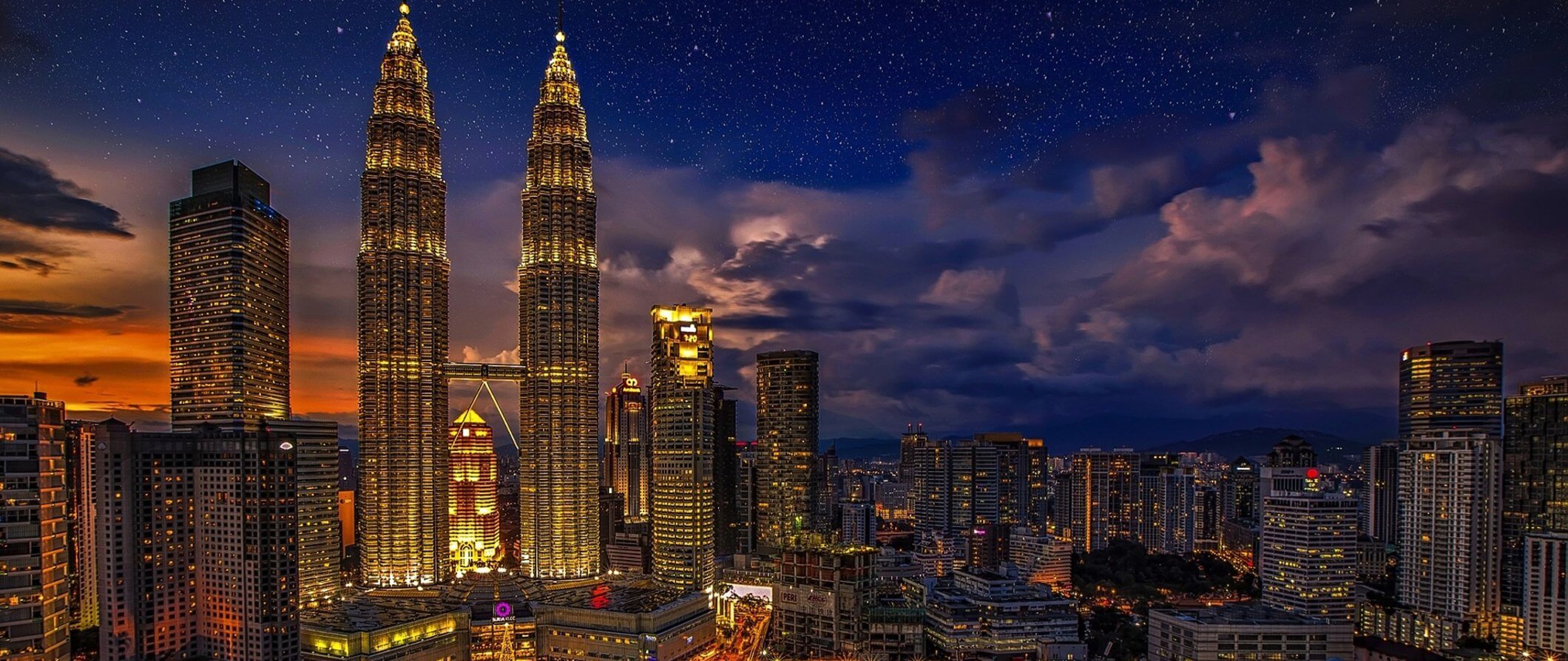
Kuala Lumpur is one of my favorite cities in the world. Although more expensive than other parts of Malaysia , KL’s diverse influences creates a unique blend of food, shopping, culture, and nightlife. The city is a melting pot of Indian, Chinese, Malay, and Western influences, all of which combine to create a city like no other.
Home to some 8 million people, Kuala Lumpur is one of the best cities in the world for delicious Indian food (outside of India that is) as around 7% of the Malaysian population is Malaysian Indian. Foodies will find themselves with plenty of tasty options here, including some amazing street food.
KL is also home to the iconic Petronas Towers, the world’s tallest pair of twin buildings and a symbol of Malaysian progress and development (they were actually the tallest buildings in the world from 1998 to 2004).
This travel guide to Kuala Lumpur can help you plan an affordable and off-the-beaten-path trip to Malaysia’s most populous city!
Table of Contents
- Things to See and Do
- Typical Costs
- Suggested Budget
- Money-Saving Tips
- Where to Stay
- How to Get Around
- How to Stay Safe
- Best Places to Book Your Trip
- Related Blogs on Kuala Lumpur
Top 5 Things to See and Do in Kuala Lumpur
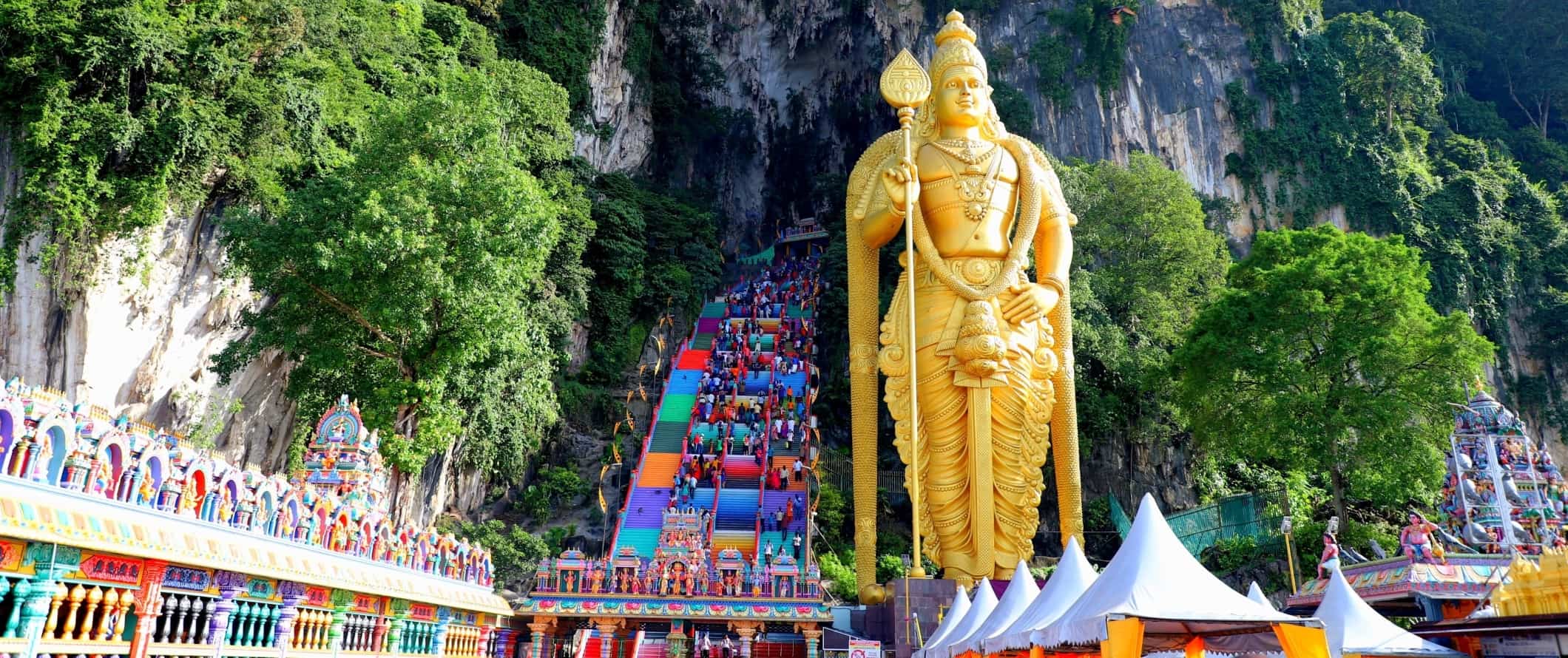
1. See the Petronas Towers
These famous towers, standing over 452 meters (1,483 feet), dominate the Kuala Lumpur skyline. Visitors can take in the view from the deck on the bridge, which joins the towers on levels 41 and 42. There is only a limited number of tickets per day so arrive early. Tickets are 80 MYR.
2. Visit the Butterfly Park
The Butterfly Park is an enormous landscaped garden that’s home to over 5,000 butterflies, plants, ferns, and flowers. It also includes an insect museum that includes massive beetles and camouflaged stick insects. Tickets are 25 MYR and there’s an additional 5 MYR fee to use a video camera (tripods are not allowed).
3. Tour Thean Hou Temple
One of the oldest and largest temples in Southeast Asia , this six-tiered Buddhist temple is also known as the Temple of the Goddess of Heaven. Built in 1894 by Kuala Lumpur’s Hainanese community, Thean Hou Temple sits on a hill with sweeping views of the city. Admission is free.
4. Visit Sri Mahamariaman
Built in 1873, the Sri Mahamariaman Hindu Temple sits just at the edge of Chinatown. This is the country’s oldest and most beautifully decorated temple. The temple’s most impressive feature is the gate tower which is adorned with depictions of Hindu Gods. Admission is free.
5. Wander the Batu Caves
After climbing up 272 steps, you’ll be rewarded with the huge golden Murugan statue and the entrance to the largest of the three caves: Cathedral Cave. Once inside, you’ll be amazed at its 100-meter-high (328 feet) ceiling and ornate Hindu shrines. Admission is free.
Other Things to See and Do in Kuala Lumpur
1. visit the national museum.
The National Museum is a great place to familiarize yourself with Malaysia’s history and culture. There are four indoor galleries that take you on a tour from the early history of Malaysia to today. The highlight is the skeleton of Perak Man, the oldest complete human skeleton found in Malaysia. It’s over 11,000 years old. The outdoor exhibit showcases transportation from over the decades, including a steam locomotive from 1921. Entrance to the museum is 5 MYR.
2. Devour the street food
Indian, Chinese, Malay, and Western foods are all common in KL. The multicultural social mix in Kuala Lumpur creates an extremely varied blend of food. The markets and roadside stalls are great places to pick up hawker food. Jalan Alor is one of the most famous streets for street food and is a great starting point; just be ready to barter. Little India and Chinatown also have lots of inexpensive food stalls serving some of the most delicious food in the city. Try the Little India Market (open daily, 8am-9pm), or Petaling Street Market in Chinatown (open daily, 8am-8pm). Chinatown’s Central Market also has plenty of tasty options too.
3. Go up Menara Kuala Lumpur
Another focal point in Kuala Lumpur’s skyline is the Menara tower. At 421-meters tall (1,380 feet), it dwarfs its surroundings and is the seventh tallest building in the world. Unlike the Petronas Towers, the floor in the Skybox is transparent so you can see through the floor down to the ground. Admission to the observation deck is 48 MYR while admission to the outside Skydeck and Skybox is 120 MYR.
4. Visit Masjid Negara
This is Malaysia’s national mosque (Islam is the country’s official religion). Set within 13 acres of garden, it has the capacity to hold 15,000 people. Its bright blue star-shaped dome represents the 13 states of Malaysia and the five pillars of Islam. Non-Muslims are welcome to visit the National Mosque outside of prayer time. Robes are given to visitors who are inappropriately dressed but try to dress respectfully before you arrive. Admission is free.
5. Wander through Lake Gardens Park
Also called the Tun Abdul Razak Heritage Park, Lake Gardens opened in 1880, making it the oldest public park in Kuala Lumpur. Located near Chinatown and the main train station, this urban park is free to visit, though it also contains various museums and gardens with paid entry. One of them is Kuala Lumpur Bird Park, one of the largest free-flight walk-in aviaries in the world, with more than 3,000 birds from approximately 200 different species. Admission is 63 MYR. Other attractions in the park include the Perdana Botanical Park, the Orchid Garden, and the Islamic Arts Museum.
6. Visit the Royal Malaysia Police Museum
This is another museum located within Lake Gardens Park. It might sound like an odd museum to check out, but it’s surprisingly interesting. The collection here features old uniforms, as well as weapons, vehicles, and items that have been seized from members of Malaysia’s organized crime families. Exhibits go all the way back to when Malaysia was under British colonial rule. It’s free to visit.
7. Celebrate Deepavali
Deepavali is the Hindu festival of lights and is one of the biggest celebrations for the Hindu community in Malaysia. It’s celebrated in October or November for five days. Also known as Diwali, Dipavali, Dewali, Deepawali, or the Festival of Lights, traditionally people host open houses with fireworks displays and serve Indian delicacies. Public celebrations can be found in the Brickfields neighborhood (aka Little India).
8. Explore the Islamic Arts Museum
The Islamic Arts Museum of Malaysia is Southeast Asia’s largest museum of Islamic art. Within this vast space is an extensive library of Islamic texts and art, as well as the world’s largest scale model of the Masjid al-Haram in Mecca (the Great Mosque of Mecca, which every Muslim is supposed to visit at least once). From jewelry and clothing to architecture and armor, spend the day exploring over 7,000 artifacts spread between 12 galleries. Admission is 25 MYR.
9. Take a food tour
If you want someone to help you explore the myriad food markets and teach you about the local food scene, take a food tour with Simply Enak . They have a variety of tours, including a walking tour through the Chow Kit market area, a nightlife tour, and a more generalized street food tour. On the street food tour, you’ll enjoy Malaysia’s most famous street food dishes, drink teh tarik (pulled tea), learn about traditional herbal medicine, and have the chance to try durian puffs — all while learning about food culture and history. Tickets cost 260-300 MYR.
10. Go on a bike tour
Cycling is on the rise in Kuala Lumpur and taking a bike tour is a great way to get a feel for the city. In operation since 2015, Mike’s Bikes is the place to go for bike tours, offering a variety of options to choose from, including the Best of Kuala Lumpur and the Pitstop Foodie Tour as well as evening sunset tours. Mike’s Bikes also gives back to the community with their Cycling School; they donate secondhand bikes to a local school for refugee children and help them upkeep their new bikes with bike maintenance classes. Tours start at 199 MYR for a 4-hour tour.
For more information on other cities in Malaysia, check out these guides:
- Cameron Highlands Travel Guide
- Perhentian Islands Travel Guide
Kuala Lumpur Travel Costs
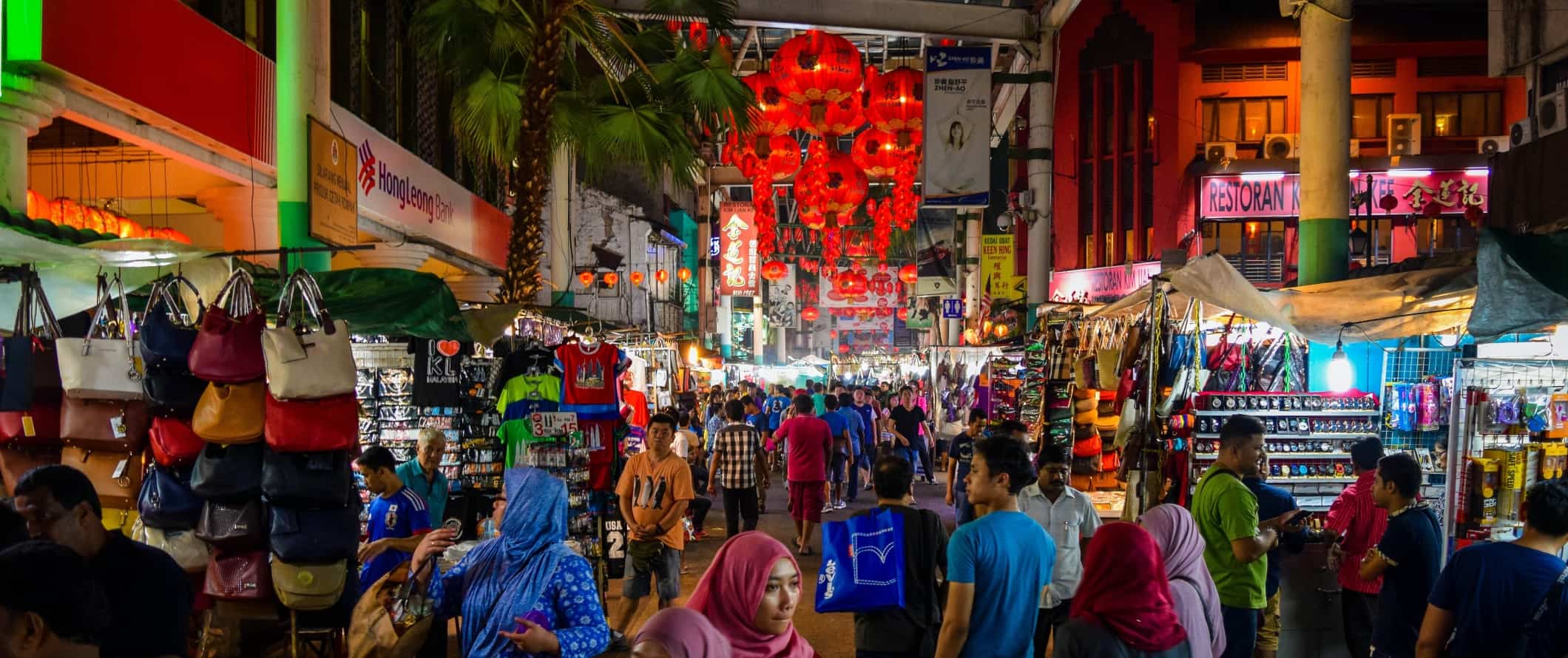
Hostel prices – A bed in a dorm with 4-6 beds costs 35-55 MYR per night, while beds in 8-10-bed dorms cost 20-35 MYR. A private double room costs 85-125 MYR per night. Free breakfast, A/C, and Wi-Fi are all common. Most hostels rarely have kitchens so be sure to double-check if you require a place to cook your own meals. Some hostels have rooftop terraces and cafes, while several even have outdoor swimming pools.
Budget hotel prices – Budget hotels start around 75 MYR per night for a basic double room with a private bathroom, Wi-Fi, breakfast, and A/C. For a hotel with a pool, expect to pay at least 100-150 MYR per night.
Airbnb is available throughout the city, usually in serviced apartments designed specifically for travelers, starting around 95-160 MYR per night.
Food – Malaysian cuisine, like the country itself, is a mix of many cultures, taking influences from neighboring China, India, Indonesia, Thailand, and Singapore. Rice or noodles are the basis of most dishes, and seafood and fish feature prominently. As a Muslim-majority country, chicken and beef are usually halal. Commonly used vegetables include cabbage, bean sprouts, lotus root, sweet potatoes, taro, long beans, and many others.
The unofficial national dish is nasi lemak , fragrant rice cooked in coconut milk, flavored with pandan leaf, and accompanied by different sides, usually served for breakfast. Other popular Malaysian dishes include roti canai (a sweet or savory flatbread), ikan bakar laksa (spicy noodle soup), and many different regional fried noodle and fried rice dishes.
Kuala Lumpur’s street food is legendary in both cost and flavor. You can find street food for under 10 MYR per dish, while Malay dishes in casual sit-down restaurants cost 15-20 MYR per dish. Traditional food like nasi lemak as well as various curries and dim sum are some of the cheapest options.
A fun option on a late night out is trying luk-luk . This is when you cook snacks on a stick by dipping them into boiling water or soup stock. You can cook a variety of vegetables, meat, or tofu. Prices range from 2-8 MYR per skewer.
At a mid-range restaurant with table service, a meal with a drink costs around 45 MYR. Western food is more expensive than local food but even still, a Western fast-food combo only costs around 15 MYR. At a nicer sit-down restaurant, a pizza is 30-50 MYR and a pasta dish is 40-50 MYR.
Beer at the bar shouldn’t be more than 15-17 MYR, a glass of wine starts from 28 MYR, and a cocktail is generally 35-45 MYR. An espresso at a chain like VCR costs around 12 MYR.
There are lots of high-end dining options in Kuala Lumpur if you want to splurge. Bottomless brunches with champagne and five-course tasting menus start from 450 MYR. A starter salad or soup starts at about 78 MYR while an entree like salmon or chicken starts at around 195 MYR.
A week’s worth of groceries costs 65-90 MYR, as long as you stick to local staples and avoid expensive western items (such as beef, wine, or cheese). However, given how cheap street food and local meals are and how few kitchens there are, you’re better off buying snacks and eating out for your meals.
Backpacking Kuala Lumpur Suggested Budgets
If you’re backpacking Kuala Lumpur, my suggested budget is 115 MYR per day. This budget covers staying in a hostel dorm, eating street food, taking public transit to get around, limiting your drinking, and sticking to mostly free activities like walking tours.
A mid-range budget of 295 MYR per day covers a private Airbnb or private hostel, drinking more, taking the occasional taxi to get around, eating street food and the occasional sit-down meal, and doing more paid activities like museum visits and going up the Petronas Towers.
On a “luxury” budget of 520 MYR or more per day, you can stay in a hotel with a pool, eat at restaurants for all your meals, have more drinks, take more taxis, and do whatever tours and activities you want. This is just the ground floor for luxury though. The sky is the limit!
You can use the chart below to get an idea of how much you need to budget daily. Keep in mind these are daily averages – some days you’ll spend more, some days you’ll spend less (you might spend less every day). We just want to give you a general idea of how to make your budget. Prices are in MYR.
Kuala Lumpur Travel Guide: Money-Saving Tips
Kuala Lumpur is cheap if you stick to street food, budget accommodation, and public transportation. You’ll be hard-pressed to break the bank unless you’re specifically traveling in luxury. But, just in case, here are some extra ways to save money in Kuala Lumpur:
- Shop at Lot 10 – This shopping mall sells genuine designer clothes for bargain prices, among the cheapest you are likely to find in Southeast Asia. If you want souvenirs, shop here.
- Stay in Chinatown – Chinatown is one of the cheaper neighborhoods for lodging in the city and it is relatively close to many attractions.
- Explore on foot – Chinatown and Little India are the neighborhoods with the most tourist sites. They are right next to each other and can easily be explored in a day without spending money on transportation.
- Watch out for scams – Be aware how much attractions cost before you arrive. The Batu Caves, for example, are free to enter. However, there are plenty of people outside trying to sell you fake tickets.
- Take a free walking tour – If you want to get a better feel for the city, take a free walking tour. They last a couple of hours and are a great way to engage with the city’s history and learn about the culture. Kuala Lumpur Unscripted offers two different free walks to help you get acquainted with the city. Just be sure to tip your guide at the end! For a self-guided historical tour, check out Kuala Lumpur Heritage Trail.
- Stay with a local – Couchsurfing connects you with a local who can host you for free. You’ll not only get free accommodation but you’ll get to connect with a local who can share their insider tips and advice.
- Save money on rideshares – Grab is the Malaysian version of Uber and is way cheaper than taxis. Grab is the best way to get around the city if you don’t want to wait for a bus or pay for a taxi.
- Pack a water bottle – The tap water here is generally safe (but heavily chlorinated) so bring a water bottle with you to avoid buying single-use plastic. My preferred bottle is LifeStraw , which has built-in filters to ensure your water is always clean and safe.
Where to Stay in Kuala Lumpur
Looking for a budget-friendly place to stay? Here are some of my favorite hostels in Kuala Lumpur:
- Birdnest Collective Cafe & Guesthouse
- The Bed Klcc
How to Get Around Kuala Lumpur
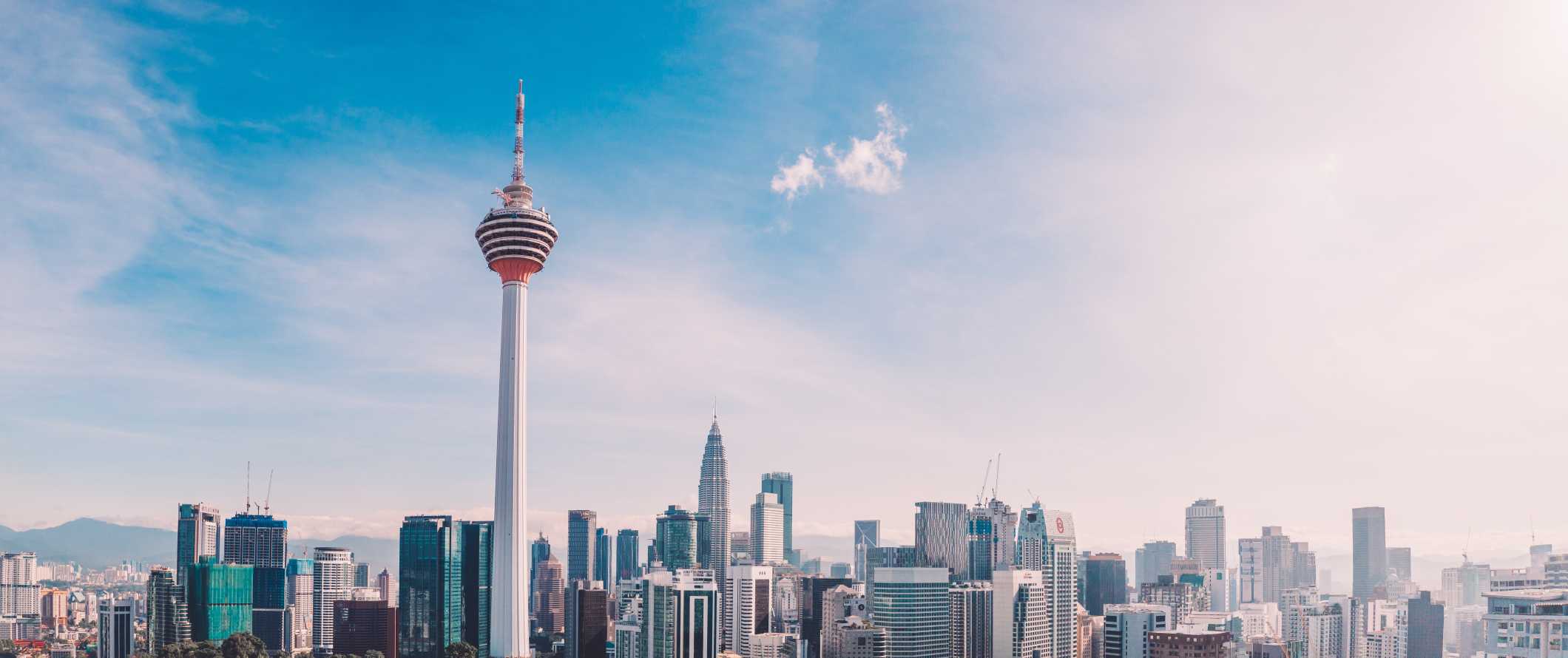
Public Transportation – Kuala Lumpur has a reliable and comprehensive public transit system of buses, light rail commuter trains, and a monorail. Rides cost 2-15 MYR.
Buses in KL are generally faster than trains. RapidKL is the largest single bus network operator in Malaysia, currently running 177 routes around the city. The price depends on distance and destination, ranging between 1-5 MYR.
For 20% off fares, purchase MyRapid Touch ‘n Go, a contactless, rechargeable card that costs 5 MYR. You can load unlimited transit passes onto this card. A one-day transit pass costs 15 MYR the first time, and 5 MYR for each subsequent day pass. A three-day pass costs 25 MYR for the first time and 15 MYR for each subsequent three-day pass purchased.
Go KL City Bus is a free city bus initiative with four routes that loop through the central business district areas of Kuala Lumpur. These pass by many of the main attractions, shopping malls, and sights, running every five minutes during peak hours and every 15 minutes during off-peak hours.
Bicycle – oBike is the dockless bike-sharing system in Kuala Lumpur. It costs just 1 MYR for every 15 minutes. Simply download the app, sign up, and scan a bike’s QR code to ride.
Taxis – Taking a taxi can be tricky in KL. To start, there are two different types: the red and white Budget Taxi and the Blue or Yellow Executive taxi. For budget taxis, the base fee is 3 MYR, going up 1.25 MYR per kilometer. Executive taxis cost double.
If you do want to take a taxi, only get in ones that use a meter, which is required by law. If the driver doesn’t use the meter, get out and find one who will.
Rideshare – Grab is the Uber of Southeast Asia. Just download the app and you’re good to go.
When to Go to Kuala Lumpur
Kuala Lumpur stays hot and humid most months, making it ideal for year-round travel. On average you can expect temperatures around 34°C (93°F) during the day, and 27°C (81°F) at night.
KL is affected by two major monsoon seasons yearly and during this time certain areas face some short rainfall and thunderstorms. It does cool down after heavy rain, but the city is one of the least affected states by monsoon winds coming from the east or west. From October to January and March to April Kuala Lumpur experiences rain, so May to July is the best time to visit.
The busiest time for tourism is June through August. This also happens to be festival season, when Hari Raya Aidil Fitri and Sarawak Gawai Festival take place. Get ready for a crowd if you plan your trip during this time. Prices for hotels and flights often rise at this time of year as well.
How to Stay Safe in Kuala Lumpur
Kuala Lumpur is generally safe, but unfortunately, petty crime and scams are common so you should be always on alert. That means no walking around with your phone out, never keeping anything in your pockets (especially when on public transport), and always keeping hold of your bag.
If you are eating out, keep your backpack on your lap or place your foot or a chair leg through the straps so nobody can snatch it when you’re not paying attention.
Solo female travelers should generally feel safe here, though the standard precautions apply (never leave your drink unattended, never walk home alone at night, etc.).
For more detail on scams you might experience in Kuala Lumpur, you can read about common travel scams to avoid here.
When booking accommodation, look for hotels or hostels with 24-hour security. You always want someone around in case you need assistance. If you don’t feel safe somewhere, don’t hesitate to move on.
Use caution when getting money out by avoiding the ATMs on the street. Instead, go into the bank to use the ATM inside. That way you can put your money away discreetly without being watched.
Travelers should also note that Malaysia is a modest country, so revealing outfits attract more attention. This is especially of concern to women as groping and excessive ogling are common.
The monkeys at Batu Caves can be a bit mischievous. Do not approach monkeys quickly or give them treats. These monkeys grab anything within reach and can become quite aggressive. Protect your belongings, including keys, sunglasses, backpack, or purse. Again, don’t feed the monkeys!
Always trust your gut instinct. Make copies of your personal documents, including your passport and ID. Forward your itinerary along to loved ones so they’ll know where you are.
If you experience an emergency, dial 999 for assistance.
The most important piece of advice I can offer is to purchase good travel insurance. Travel insurance will protect you against illness, injury, theft, and cancellations. It’s comprehensive protection in case anything goes wrong. I never go on a trip without it as I’ve had to use it many times in the past. You can use the widget below to find the policy right for you:
Kuala Lumpur Travel Guide: The Best Booking Resources
These are my favorite companies to use when I travel. They consistently have the best deals, offer world-class customer service and great value, and overall, are better than their competitors. They are the companies I use the most and are always the starting point in my search for travel deals.
- Skyscanner – Skyscanner is my favorite flight search engine. They search small websites and budget airlines that larger search sites tend to miss. They are hands down the number one place to start.
- Hostelworld – This is the best hostel accommodation site out there with the largest inventory, best search interface, and widest availability.
- Agoda – Other than Hostelworld, Agoda is the best hotel accommodation site for Asia.
- Booking.com – The best all around booking site that constantly provides the cheapest and lowest rates. They have the widest selection of budget accommodation. In all my tests, they’ve always had the cheapest rates out of all the booking websites.
- Get Your Guide – Get Your Guide is a huge online marketplace for tours and excursions. They have tons of tour options available in cities all around the world, including everything from cooking classes, walking tours, street art lessons, and more!
- SafetyWing – Safety Wing offers convenient and affordable plans tailored to digital nomads and long-term travelers. They have cheap monthly plans, great customer service, and an easy-to-use claims process that makes it perfect for those on the road.
- LifeStraw – My go-to company for reusable water bottles with built-in filters so you can ensure your drinking water is always clean and safe.
- Unbound Merino – They make lightweight, durable, easy-to-clean travel clothing.
Kuala Lumpur Travel Guide: Related Articles
Want more info? Check out all the articles I’ve written on backpacking/traveling Asia and continue planning your trip:
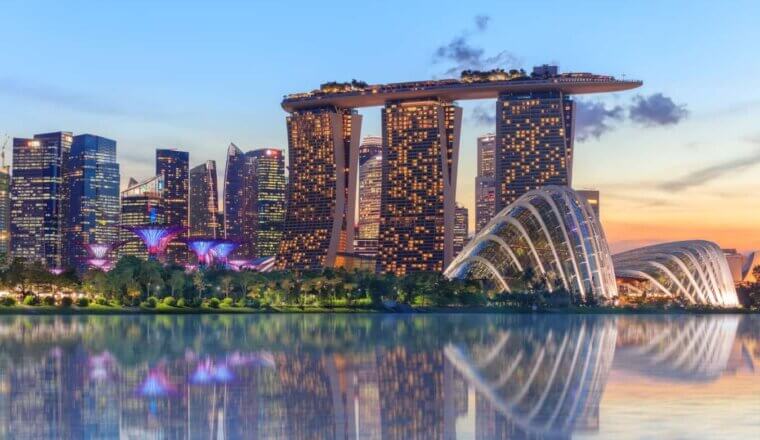
The 5 Best Hotels in Singapore
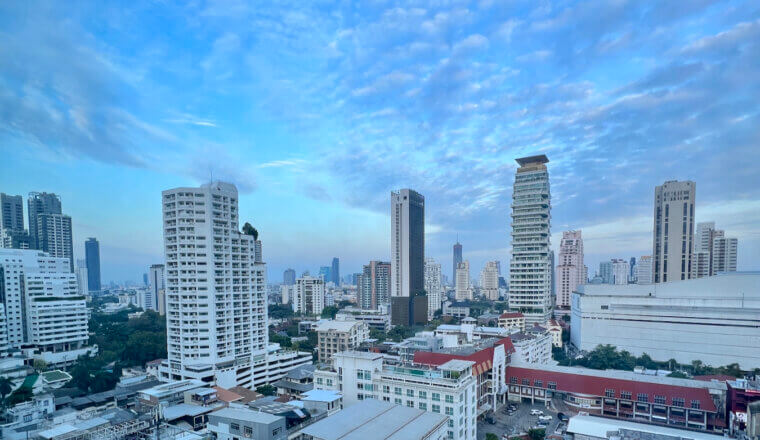
The 7 Best Hotels in Bangkok

The 4 Best Hostels in Singapore
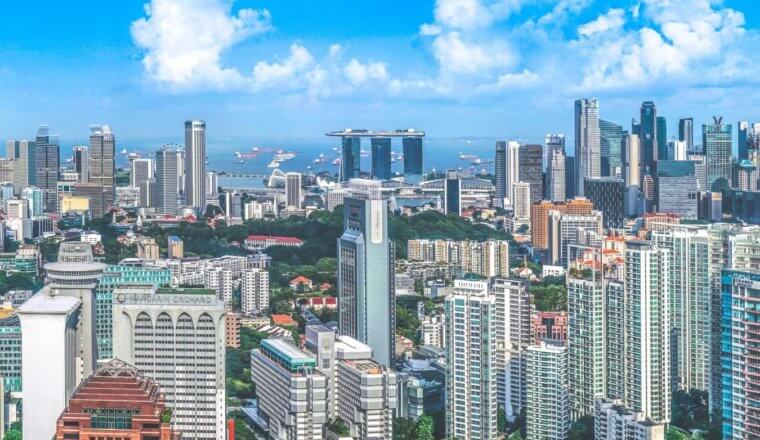
Where to Stay in Singapore: The Best Neighborhoods for Your Visit
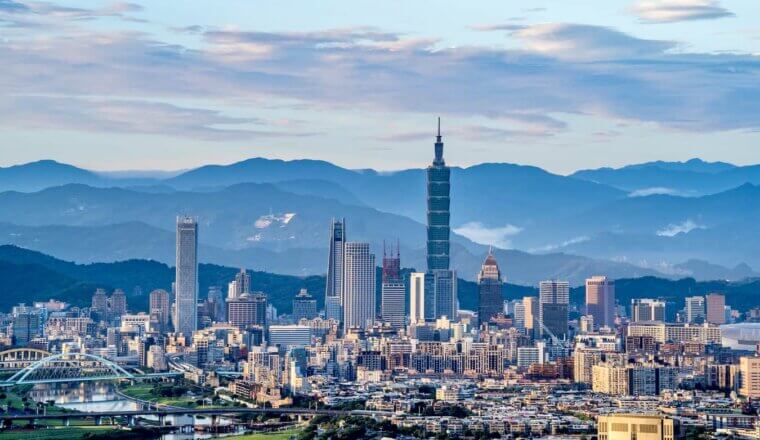
The 13 Best Things to See and Do in Taipei
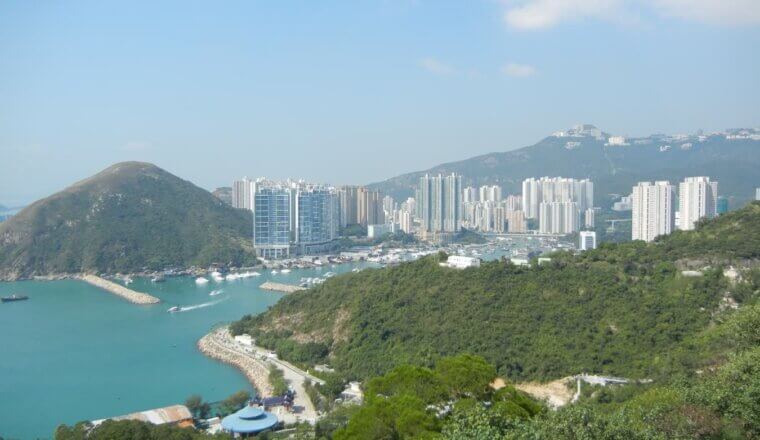
The 23 Best Things to Do in Hong Kong
Get my best stuff sent straight to you, pin it on pinterest.
- Where To Stay
- Transportation
- Booking Resources
- Related Blogs
Three of the most thrilling moments from the Travel Guides' trip to Malaysia
The Travel Guides admitted that at first Malaysia wasn't at the top of their destination bucket list.
But "holiday snobs" Kevin and Janetta , the Frens , siblings Stack and Josh , best mates Kev, Dorian and Teng and Matt and Brett soon changed their tune after diving into some of the country's most thrilling offerings.
Stream new episodes of Travel Guides on 9Now.
From a life-changing orangutan conservation experience to local food markets serving bull's penis, the Guides take on budget-friendly Malaysia.
The Guides spot orangutans in their natural habitat
There was no guarantee that the Guides would sight an orangutan when the visited Semenggoh Wildlife Centre and some of the travellers took that news better than others.

"This is going to be make or break for me, because I'm going to be so disappointed if I don't see them," Mark said.
But much to Mark (and everybody else's) delight the Anwar the orangutan emerged from the forest to make an appearance.
EXCLUSIVE: Stack, Josh and Mel reveal the secret they kept from their mum for more than a decade
There were lots of oohs and ahhs as he climbed across the treetops.
"The thought of seeing an orangutan in the wild is a real privilege," Matt told cameras.
"It was spiritual, you're in their environment and they're allowing you to share their space," Brett added.
Anwar hung around so long that the ranger let some of the Guides get even closer.
"My heart is pounding," Matt admitted sitting just metres away from the orangutan.
Dorian – whose "life long dream" was to visit orangutans in Borneo – said getting so close to one was "so wild and rare".

"It is sad because you think we might be the last generation that might see them in the wild," Brett said.
"I won't ever forget this."
Matt and Brett and The Frens sample bull's penis
READ MORE: Under $50: Gifts Mum will love to open this Mother's Day
The Guides try some bizarre Malaysian foods
It's generally a rule that local food is the best, but sometimes it's also the weirdest.
And the Guides proved exactly that when they tried some local Malaysian delicacies.
Having been through her fair share of markets, Stack saw an opportunity to stitch up her younger brother Josh.
"My approach to finding food for Josh was to get the filthiest thing I could find," she told cameras.
She held her breath as she ordered pig snout to go and an unknowing Josh scoffed it down like a champ.
Josh guessed that he was probably eating pork but was left speechless when he found out exactly which part it was.
READ MORE: 3 of the most eye-opening moments from the Travel Guides' trip to Morocco

But we might even take the pig snout over the next meal the Guides ordered – Sup Torpedo which loosely translates to torpedo meat soup.
"I have no idea what we ordered," Brett said.
Upon asking the waiter, the Guides soon discovered that the meat was bull's penis but that didn't stop them cleaning the plate.
"Look we'd already started we might as well finish off the bowl," Brett laughed.
The Guides are in awe of the Batu Caves
The Guides set their sites on the Batu Caves – a place of pilgrimage for Tamil Hindus and home to the 42.7 metre tall Arulmigu Murugan Statue.
But it was no easy feet to get to there with the Guides having to climb 272 steps and side step an army of monkeys.
It might've been a strenuous effort to get there, but all the Guides agreed the hike was well worth it by the time they got to the top.
The Guides were met with century old Hindu shrines and temples – but that wasn't even the most impressive part.
The shrines and temples lay inside a four million year old limestone cave.
"When you do a climb like that you pretty much just get to the top, look at the view and that's it, this made it so worthwhile seeing how beautiful these caves were," Victoria told cameras.

Travel Guides airs on Wednesdays at 7.30pm on Channel 9 and 9Now.

- Matt And Brett
- Kev Dorian And Teng
- Kevin And Janetta
- Stack And Josh
- Travel Guides 2023
Auto news: The electric ute to be sold in Australia but not to the public.
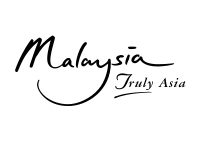
About Malaysia
- Travel Ideas
- Deals & Packages
- Travel Alert
- Events & Happenings

Arriving and Entering Malaysia

Getting Around Malaysia

Travel Guide
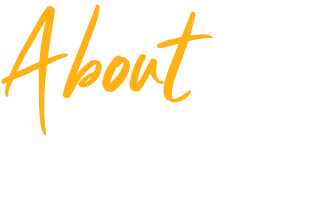
The currency unit of the Malaysian currency is the Malaysian Ringgit, with the code MYR. It is commonly recognized by the symbol RM and is also referred to as Ringgit Malaysia.
Bank notes are available in various denominations, including RM1, RM5, RM10, RM20, RM50, and RM100. Coins, on the other hand, are issued in 5 sen, 10 sen, 20 sen, and 50 sen denominations.
When it comes to payment methods, most hotels, shopping complexes, restaurants, and shops in Malaysia readily accept international credit cards like Visa, MasterCard, American Express, and Diners Club.
In addition, for those who prefer a convenient, cashless experience, MY Tourist App offers a mobile payment solution specifically designed for international travellers visiting Malaysia. Furthermore, the country has embraced digital payment methods such as Touch N Go , GrabPay , and Boost as well as bank transfers which are widely accepted and utilized by locals and tourists alike.
For those who prefer to use travellers' cheques, they can be exchanged at local banks. However, it's worth noting that visitors bringing in significant amounts of foreign currencies are required to make declarations.
Malaysian hospitals and clinics are easily accessible to those who require them. Public and private hospitals and clinics are both located in every city. Malaysia’s healthcare facilities and services are top-notch and provide you with excellent aid and comfort. Government hospitals and clinics are open for 24 hours.
Given the perpetual warmth of the tropical climate in this country, visitors must prioritize their well-being by applying sunscreen, staying hydrated, and wearing appropriate attire to combat the humidity.
Malaysia, by and large, maintains a commendable standard of food hygiene. Additionally, the availability of bottled water and soft beverages is extensive.
Malaysia is 8 hours ahead of GMT (GMT +8:00) and 16 hours ahead of US Pacific Standard Time.
Public Holidays
Religious holidays and festivities typically receive 1 or 2 days of observance. Public holidays, such as Hari Raya Aidilfitri, Chinese New Year, Deepavali, Christmas Day, and Wesak, are among the religious holidays that fall into this category. Additionally, several other public holidays are typically awarded a single day of recognition. Examples of these include National Day (31st of August), Malaysia Day (16th of September), Labour Day (1st of May), Islamic Day (date varies), Agong's Birthday (3rd of June), and numerous others.
Each year, Malaysia will have school holidays during the months of March, May, September, and December. Optimize your travel plan, as expenses tend to rise and popular attractions become more crowded during school holidays. Plan smartly for a smoother and more enjoyable adventure in Malaysia.
Electricity
A standard 3-pin plug and socket is commonly used. The supply voltage in Malaysia is 240V and at a frequency of 50 Hz.
Telephone Calls
The main telecom operators in Malaysia are CelcomDigi, Maxis, Umobile, and Tune Talk. Conveniently, prepaid SIM cards can be easily purchased at airports, malls, and city centers. For short-term visitors to Malaysia, there are traveller SIM card packages available. These packages typically include preloaded credit and a specific amount of minutes for calls and data.
Below are the area codes for domestic calls:
Do's and Don'ts
When travelling to Malaysia, it is important to familiarize yourself with the local laws and customs.
This includes understanding the dress codes, tipping etiquette, and appropriate behaviour at religious sites. Here are some guidelines to follow when visiting Malaysia:
- Respect local traditions and practices.
- Handshakes are generally acceptable, but Muslim women may prefer to acknowledge introductions with a nod and a smile.
- It is customary to remove your shoes before entering a Malaysian house.
- Always use your right hand when eating with your hands, giving or receiving something, or during a handshake.
By being informed and respectful of the local customs, you can have a more enjoyable and culturally immersive experience during your visit to Malaysia.
When entering places of worship, such as mosques and temples, it is important to remove your shoes.
Many of these religious sites also provide robes and scarves for female visitors and men wearing shorts. While it is generally allowed to take photographs at these places, it is always courteous to ask for permission beforehand.
Toasting is not a common practice in Malaysia due to the Muslim population's abstinence from alcohol. Moreover, it is advised to refrain from pointing with the right forefinger. Instead, the right thumb can be used by creating a gentle fist with the hand and placing the thumb above it.
Advice for Tourists
Deal with a travel agent licensed by the Ministry of Tourism, Arts and Culture Malaysia . Know and understand the terms and conditions of the tour packages that they bought. Use tour operators and transportation services licensed by the Ministry of Tourism, Arts and Culture Malaysia. Use a valid licensed tour guide approved by the Ministry of Tourism, Arts and Culture Malaysia. Use only valid licensed transportation services approved by government agencies. Do not deal with any illegal agent or individual. Tourists who deal with unlicensed travel agents or tour operators risk NOT getting good services as stated in the package. NOT being covered by insurance. NOT being covered by the Tourism Industry Act. NOT being paid any compensations or reimbursements.
Emergency Assistance
Malaysia is equipped with a well-established system to provide immediate help during emergencies. The Auxiliary police, stationed in various regions, are crucial in delivering swift assistance. Here are the essential contact details to remember in case of an emergency:
- For ambulance and police services, dial 999.
- In the event of a fire-related emergency, contact 994.
- For any tourism-related inquiries, reach out to Tourism Infoline at 1300 885 776.
In various public places like shopping centers, terminals, and many other locations, one can enjoy the convenience of accessing complimentary WIFI. Nevertheless, certain free WIFI networks may necessitate a sign-in or registration process. Additionally, cafes, eateries, and establishments that serve beverages also offer patrons the perk of complimentary WIFI.
Food & Drinks
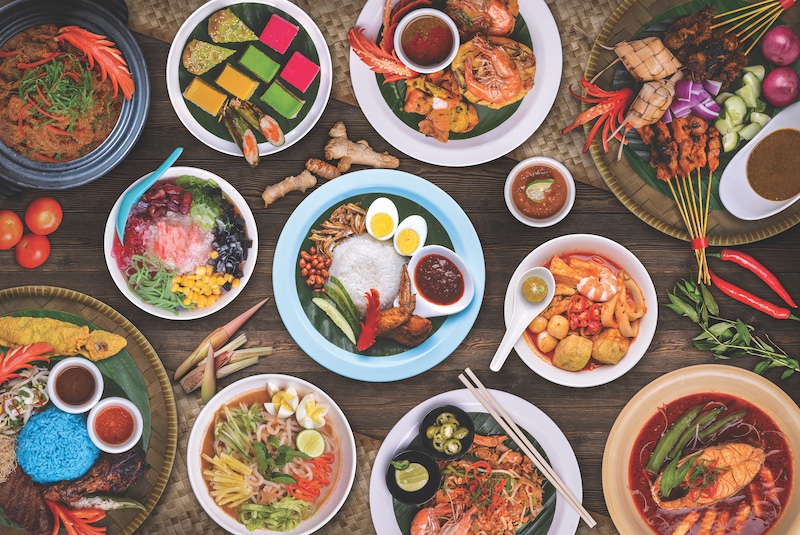
With its perpetual warm climate, Malaysia is famous for its tropical setting. Throughout the day, the sun's rays can be scorching, necessitating the appropriate attire to combat the heat.
Gifts & Souvenirs Ideas
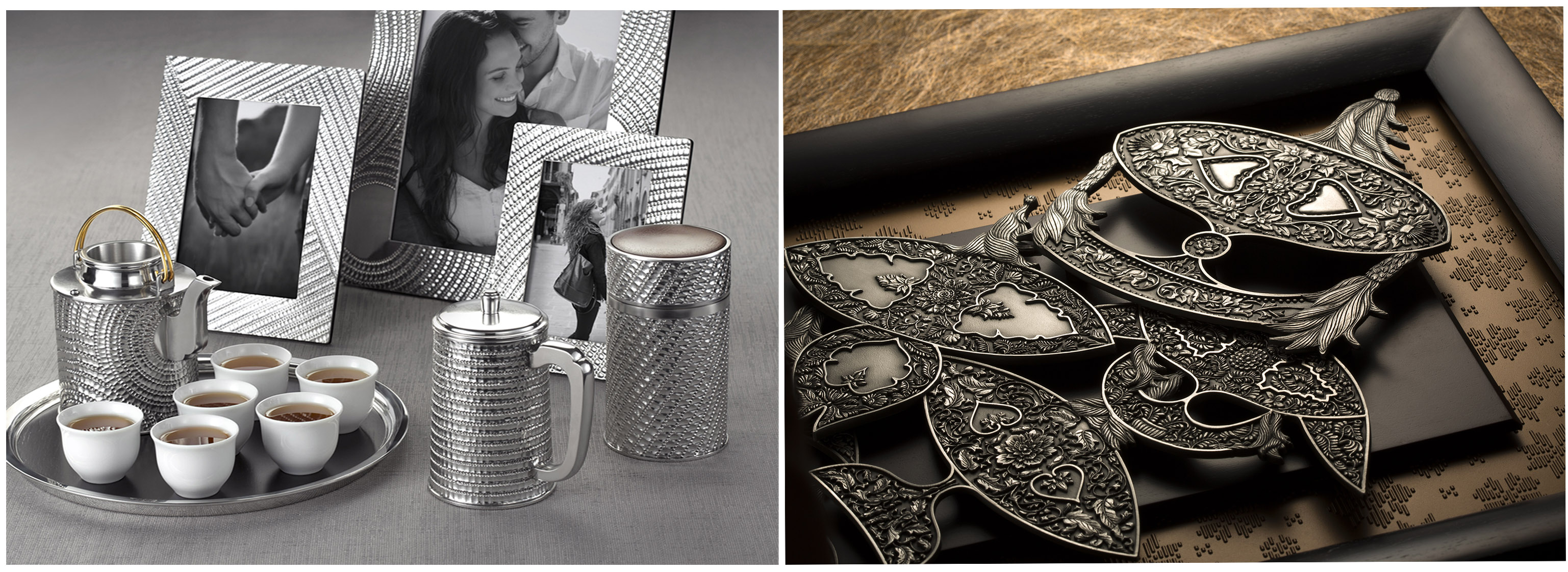
Whether you’re exploring the lively Central Market, marvelling at the iconic KLCC, browsing the Karangkraf online store, or strolling through the charming local shops, you’ll undoubtedly find the perfect keepsake that captures the essence of your Malaysian adventures.

Be informed about Malaysia as a travel destination.


IMAGES
VIDEO
COMMENTS
The Rough Guides to Malaysia and related travel guides. In-depth, easy-to-use travel guides filled with expert advice. Buy US$34.99. Buy US$28.99. Buy US$34.99. Buy US$34.99. Find even more inspiration here. 7 places to get off the tourist trail in Malaysia.
Kuala Lumpur. Lake Gardens, Brickfields & Bangsar. Chinatown, Merdeka Square & Bukit Nanas. Sabah. Sarawak. Penang. Pahang & Tioman Island. Perak. Explore Malaysia holidays and discover the best time and places to visit.
Malaysia Travel Guide: The Best Booking Resources. These are my favorite companies to use when I travel. They consistently have the best deals, offer world-class customer service and great value, and overall, are better than their competitors. They are the companies I use the most and are always the starting point in my search for travel deals.
A Travel Guide to Malaysia with ️ Travel Itineraries, ️ Top places to visit in 2024, ️ Beautiful coastlines and beaches, and more! Malaysia. Travel Guide. A melting pot of faiths, landscapes, and flavors, Malaysia combines skyscrapers with desert-island beaches and fresh highlands.
Costs of Traveling in Malaysia. Travel on a budget in Malaysia, from $180 − $320 USD weekly per person, mid-range $530 − $1650 USD, and high-end from $1650 − $2550 USD. However, costs depend on factors like accommodation, transportation, and activities. We did not include flights. Check flight prices here.
Many adventures begin at Kuala Lumpur international airport. Before you make a break for it, take a few days to soak up the place where it all comes to a head. Take a quick trip to the Batu Caves and a drawn-out hike to Mount Kinabalu. Kick back on the Perhentian Islands, sip tea in the Cameron Highlands, and saunter down the river in Kota ...
Thailand. There are buses, trains and boats between Malaysia and Thailand. The most frequent and often easiest option is by bus. Hat Yai, in southern Thailand, is a common point to get buses into Malaysia (and they leave frequently) although there are many places from which you can travel to Malaysia.
Budget. Malaysia can be a very budget friendly travel destination, with hostels available from 25 Ringgits ($5 USD) and private hotels from 70 Ringgits. Meals are also cheap, costing about 15 to 30 Ringgits depending on location. Transportation in Malaysia is generally by motorbike or car, and these can be rented, but hiring a driver is cheap ...
This Malaysia Travel Guide will go over the best places to visit, several Malaysia itinerary options, budget / backpacking travel tips, + much more. A Malaysia Trip will certainly be an awesome experience filled with tasty food, beautiful scenery, and vibrant culture. Read my guide and decide where to go in Malaysia!
Fast Facts about Malaysia. Malaysia power voltage is 230/240 V 50 Hz; Power sockets G. The Malaysian currency is the Malaysian Ringett (MYR) and is around 4 MYR to 1 USD. Malaysia is a multicultural but predominantly Islamic country. Water is generally safe to drink water straight from the tap. Bottled mineral water, however, is easily ...
TRAVEL GUIDE. Malaysia is a mosaic of cultures and flavors, combining the best of China, India, and Southeast Asia with a smattering of old colonial legacy. Capital city Kuala Lumpur is thoroughly ...
26. Malaysia is a diverse and vibrant country located in Southeast Asia, known for its rich cultural heritage, tropical landscapes, beautiful beaches and delicious cuisine.. This guide will help you plan the perfect trip to Malaysia by showing you the top attractions and things to do, best beaches & places to visit including maps, photos and itinerary.
Humidity is high all year round in Malaysia, and the temperature often hovers around 30°C in the lowlands and 20°C in the highlands. March to April is often considered to be the best time to visit since it is the shoulder season, which will give you the best of both worlds: relatively drier weather than January and February, but fewer ...
Malaysia. With one of Asia's best cities (Kuala Lumpur), one of the world's oldest tropical rainforests (Taman Negara), and the world's third largest island (Borneo), Malaysia should be high on your list. The Top 9 Museums to Visit in Borneo. Your Trip to Malaysia: The Complete Guide. Weather in Malaysia: Climate, Seasons, and Average Monthly ...
Malaysia. Malaysia is not one to be missed, with its vibrant cities, lush rainforests, and delicious cuisine. Climb the Petronas Twin Towers in Kuala Lumpur, explore the ancient rainforest of Taman Negara, or taste the flavors of Penang's street food. Discover what makes Malaysia a gem in the continent with our travel guide.
Food & Drink. Explore the local culinary scene, from breakfast to Michelin-starred restaurants. Sip cocktails, savor desserts, and discover the best local markets. Discover Malaysia's treasures with expert guides. Delve into the heart with locals' insights. Culinary hotspots off-the-beaten-path wonders await...
Overall, the best time to visit Malaysia is from March to early November when it's drier and less humid. To travel Malaysia right after the rainy season is actually a smart idea, as it's still warm, the countryside embraces lush greenery and expansive waterfalls, and most importantly, tourism isn't overly busy.
Itinerary Of 6 Days Trip To Malaysia. Day 1: Arrival at Kuala Lumpur and city sightseeing. Day 2: Transfer to Genting and Genting attractions. Day 3: Arrival at Langkawi and duty-free shopping. Day 4: Island hopping via jet ski tour. Day 5: Ziplining and sunset cruise. Day 6: Arrival at New Delhi.
Currency: Malaysian Ringgit Electricity Socket: 240V AC electricity. Power outlets are three-prong sockets (type G). Be sure to pack a universal travel adaptor so you can still use all your electronic gadgets.. Visa: Traveling to Malaysia is easy; for citizens of most countries you won't need to apply for a visa beforehand. There are a handful of countries in Asia that require a visa for ...
Malaysia is a country in Southeast Asia, on the Malay Peninsula, as well as on northern Borneo.The country is one of Asia's tiger economies, having seen great economic and human development during the last several decades. While the capital Kuala Lumpur is a cosmopolitan city, deep jungles cover vast swaths of the land, and the offshore islands are home to pristine beaches and some of the ...
Kuala Lumpur Travel Costs. Hostel prices - A bed in a dorm with 4-6 beds costs 35-55 MYR per night, while beds in 8-10-bed dorms cost 20-35 MYR. A private double room costs 85-125 MYR per night. Free breakfast, A/C, and Wi-Fi are all common.
Three of the most thrilling moments from the Travel Guides' trip to Malaysia. The Travel Guides admitted that at first Malaysia wasn't at the top of their destination bucket list. But "holiday snobs" Kevin and Janetta, the Frens, siblings Stack and Josh, best mates Kev, Dorian and Teng and Matt and Brett soon changed their tune after ...
The currency unit of the Malaysian currency is the Malaysian Ringgit, with the code MYR. It is commonly recognized by the symbol RM and is also referred to as Ringgit Malaysia. Bank notes are available in various denominations, including RM1, RM5, RM10, RM20, RM50, and RM100. Coins, on the other hand, are issued in 5 sen, 10 sen, 20 sen, and 50 ...